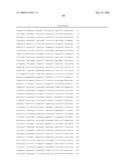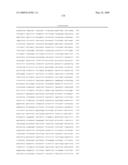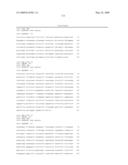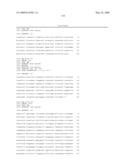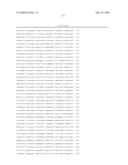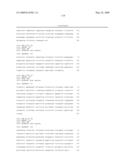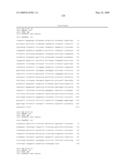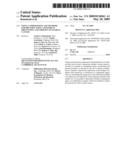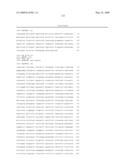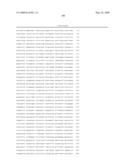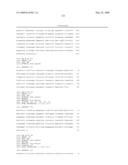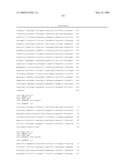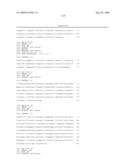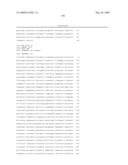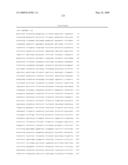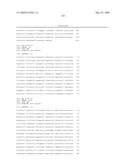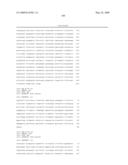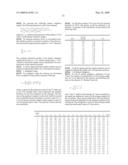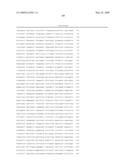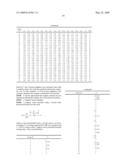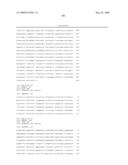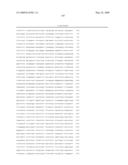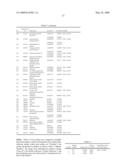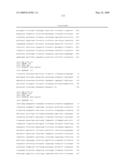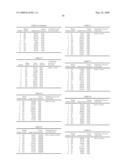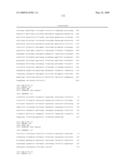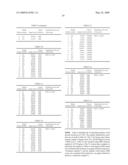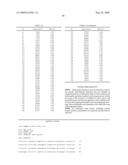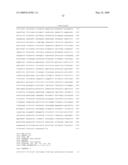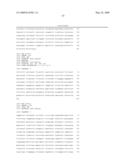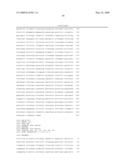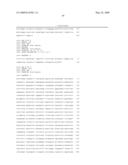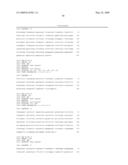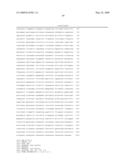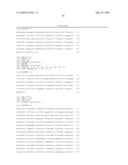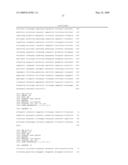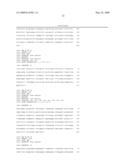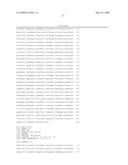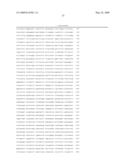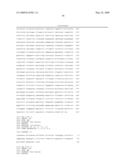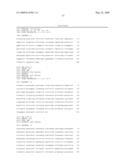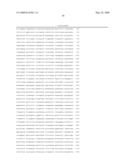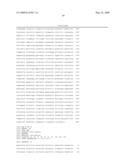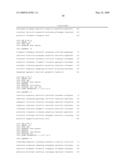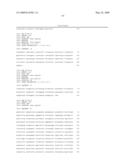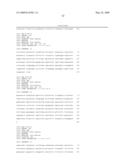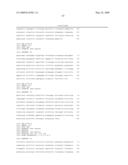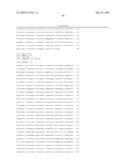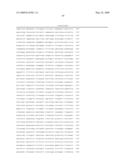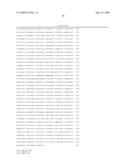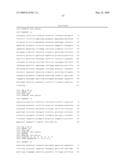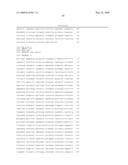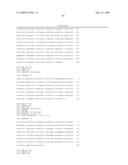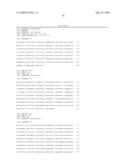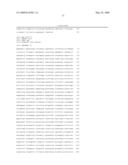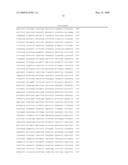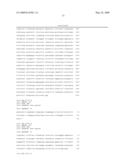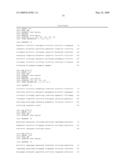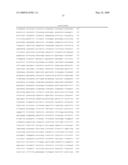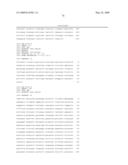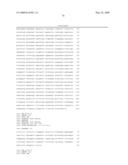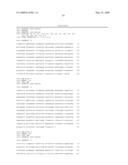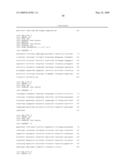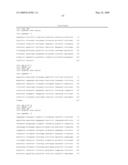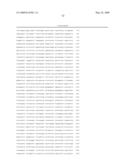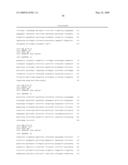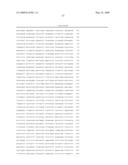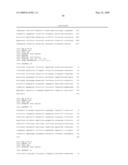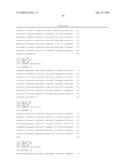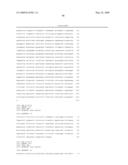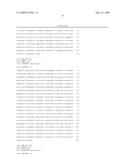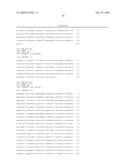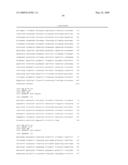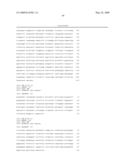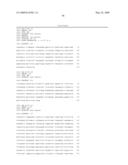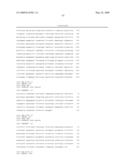Patent application title: Novel compositions and methods for identification, assessment, prevention, and therapy of ovarian cancer
Inventors:
Andrew I. Damokosh (West Hortford, CT, US)
Natalia Lartchouk (Wayland, MA, US)
James J. Stec, Ii (Plymouth, MA, US)
Edwin A. Clark (Ashland, MA, US)
Karen Lu (Houston, TX, US)
Lynn Hartmann (Rochester, NY, US)
Robert C. Bast, Jr. (Houston, TX, US)
Gordon B. Mills (Houston, TX, US)
Gordon B. Mills (Houston, TX, US)
Assignees:
Millennium Pharmaceuticals, Inc.
Board of Regents
MAYO FOUNDATION FOR MEDICAL EDUCATION AND RESEARCH
IPC8 Class: AC12Q168FI
USPC Class:
435 6
Class name: Chemistry: molecular biology and microbiology measuring or testing process involving enzymes or micro-organisms; composition or test strip therefore; processes of forming such composition or test strip involving nucleic acid
Publication date: 2009-05-28
Patent application number: 20090136961
Claims:
1. A method for determining whether an agent can be used to reduce the
growth of ovarian cancer, comprising the steps of:a. Obtaining a sample
of ovarian cancer cells;b. Determining the expression profile of a marker
set, wherein the marker set is selected from those set forth in Tables
2-15; andc. Identifying that the agent is or is not appropriate to reduce
the growth of the ovarian cancer cells based on the expression profile.
2. The method of claim 1, wherein the ovarian cancer cells are selected from the group consisting of ovarian cancer cell lines and ovarian cancer cells obtained from a patient.
3. The method of claim 1, wherein the expression profile of the marker set in the sample is assessed by detecting the presence in the sample of polynucleotides or portions thereof, wherein the polynucleotides comprise the marker set.
4. The method of claim 1, wherein the expression profile of the marker set in the sample is assessed by detecting the presence in the sample of proteins or protein fragments corresponding to the marker set.
5. The method of claim 1, wherein the agent is a chemotherapeutic compound.
6. The method of claim 5, wherein the chemotherapeutic compound is a taxane compound.
7. The method of claim 5, wherein the chemotherapeutic compound is a platinum compound.
8. The method of claim 5, wherein the chemotherapeutic compound is a combination of a taxane compound and a platinum compound.
9. The method of claim 6, wherein the taxane compound is TAXOL or an analog of TAXOL.
10. The method of claim 7, wherein the platinum compound is cisplatin or an analog of cisplatin.
11. A method for determining whether treatment with an anti-cancer agent should be continued in an ovarian cancer patient, comprising the steps of:a. Obtaining two or more samples of ovarian cancer cells from a patient at different times during the course of anti-cancer agent treatment;b. Determining the expression profile of a marker set, in the two or more samples, wherein the marker set is selected from those set forth in Tables 2-15; andc. Continuing or discontinuing the treatment based on the evaluation.
12. The method of claim 11, wherein the ovarian cancer cells are selected from the group consisting of ovarian cancer cell lines and ovarian cancer cells obtained from a patient.
13. The method of claim 11, wherein the expression profile of the marker set in the sample is assessed by detecting the presence in the sample of polynucleotides or portions thereof, wherein the polynucleotides comprise the marker set.
14. The method of claim 11, wherein the expression profile of the marker set in the sample is assessed by detecting the presence in the sample of proteins or protein fragments corresponding to the marker set.
15. The method of claim 11, wherein the agent is a chemotherapeutic compound.
16. The method of claim 15, wherein the chemotherapeutic compound is a taxane compound.
17. The method of claim 15, wherein the chemotherapeutic compound is a platinum compound.
18. The method of claim 15, wherein the chemotherapeutic compound is a combination of a taxane compound and a platinum compound.
19. The method of claim 16, wherein the taxane compound is TAXOL or an analog of TAXOL.
20. The method of claim 17, wherein the platinum compound is cisplatin or an analog of cisplatin.
Description:
RELATED APPLICATIONS
[0001]The present application is a divisional of U.S. patent application Ser. No. 10/361,112, filed Feb. 7, 2003 (pending), which claims the benefit of U.S. Provisional Application Ser. No. 60/384,042, filed May 29, 2002 (abandoned), and US. Provisional Application Ser. No. 60/355,388, filed Feb. 8, 2002 (abandoned). The entire contents of each of the above-referenced patent applications are incorporated herein by this reference.
BACKGROUND OF THE INVENTION
[0002]The increased number of cancer cases reported in the United States, and, indeed, around the world, is a major concern. Currently there are only a handful of detection and treatment methods available for specific types of cancer, and these provide no absolute guarantee of success. In order to be most effective, these treatments require not only an early detection of the malignancy, but also a reliable assessment of the severity of the malignancy.
[0003]Ovarian cancer is responsible for significant morbidity and mortality in populations around the world. Ovarian cancer is classified, on the basis of clinical and pathological features, in three groups, namely epithelial ovarian cancer (EOC; >90% of ovarian cancer in Western countries), germ cell tumors (circa 2-3% of ovarian cancer), and stromal ovarian cancer (circa 5% of ovarian cancer; Ozols et al., 1997, Cancer Principles and Practice of Oncology, 5th ed., DeVita et al., Eds. pp. 1502). Relative to EOC, germ cell tumors and stromal ovarian cancers are more easily detected and treated at an early stage, translating into higher/better survival rates for patients afflicted with these two types of ovarian cancer.
[0004]There are numerous types of ovarian tumors, some of which are benign, and others of which are malignant. Treatment (including non-treatment) options and predictions of patient outcome depend on accurate classification of the ovarian cancer. Ovarian cancers are named according to the type of cells from which the cancer is derived and whether the ovarian cancer is benign or malignant. Recognized histological tumor types include, for example, serous, mucinous, endometrioid, and clear cell tumors. In addition, ovarian cancers are classified according to recognized grade and stage scales.
[0005]In grade I, the tumor tissue is well differentiated from normal ovarian tissue. In grade II, tumor tissue is moderately well differentiated. In grade III, the tumor tissue is poorly differentiated from normal tissue, and this grade correlates with a less favorable prognosis than grades I and II. Stage I is generally confined within the capsule surrounding one (stage IA) or both (stage IB) ovaries, although in some stage I (i.e. stage IC) cancers, malignant cells may be detected in ascites, in peritoneal rinse fluid, or on the surface of the ovaries. Stage II involves extension or metastasis of the tumor from one or both ovaries to other pelvic structures. In stage IIA, the tumor extends or has metastasized to the uterus, the fallopian tubes, or both. Stage IIB involves extension of the tumor to the pelvis. Stage IIC is stage IIA or IIB in which malignant cells may be detected in ascites, in peritoneal rinse fluid, or on the surface of the ovaries. In stage III, the tumor comprises at least one malignant extension to the small bowel or the omentum, has formed extrapelvic peritoneal implants of microscopic (stage IIIA) or macroscopic (<2 centimeter diameter, stage IIIB; >2 centimeter diameter, stage IIIC) size, or has metastasized to a retroperitoneal or inguinal lymph node (an alternate indicator of stage IIIC). In stage IV, distant (i.e. non-peritoneal) metastases of the tumor can be detected.
[0006]The durations of the various stages of ovarian cancer are not presently known, but are believed to be at least about a year each (Richart et al., 1969, Am. J. Obstet. Gynecol. 105:386). Prognosis declines with increasing stage designation. For example, 5-year survival rates for patients diagnosed with stage I, II, III, and IV ovarian cancer are 80%, 57%, 25%, and 8%, respectively.
[0007]Despite being the third most prevalent gynecological cancer, ovarian cancer is the leading cause of death among those afflicted with gynecological cancers. The disproportionate mortality of ovarian cancer is attributable to a substantial absence of symptoms among those afflicted with early-stage ovarian cancer and to difficulty diagnosing ovarian cancer at an early stage. Patients afflicted with ovarian cancer most often present with non-specific complaints, such as abnormal vaginal bleeding, gastrointestinal symptoms, urinary tract symptoms, lower abdominal pain, and generalized abdominal distension. These patients rarely present with paraneoplastic symptoms or with symptoms which clearly indicate their affliction. Presently, less than about 40% of patients afflicted with ovarian cancer present with stage I or stage II. Management of ovarian cancer would be significantly enhanced if the disease could be detected at an earlier stage, when treatments are much more generally efficacious.
[0008]Ovarian cancer may be diagnosed, in part, by collecting a routine medical history from a patient and by performing physical examination, x-ray examination, and chemical and hematological studies on the patient. Hematological tests which may be indicative of ovarian cancer in a patient include analyses of serum levels of proteins designated CA125 and DF3 and plasma levels of lysophosphatidic acid (LPA). Palpation of the ovaries and ultrasound techniques (particularly including endovaginal ultrasound and color Doppler flow ultrasound techniques) can aid detection of ovarian tumors and differentiation of ovarian cancer from benign ovarian cysts. However, a definitive diagnosis of ovarian cancer typically requires performing exploratory laparotomy of the patient.
[0009]Potential tests for the detection of ovarian cancer (e.g., screening, reflex or monitoring) may be characterized by a number of factors. The "sensitivity" of an assay refers to the probability that the test will yield a positive result in an individual afflicted with ovarian cancer. The "specificity" of an assay refers to the probability that the test will yield a negative result in an individual not afflicted with ovarian cancer. The "positive predictive value" (PPV) of an assay is the ratio of true positive results (i.e. positive assay results for patients afflicted with ovarian cancer) to all positive results (i.e. positive assay results for patients afflicted with ovarian cancer+positive assay results for patients not afflicted with ovarian cancer). It has been estimated that in order for an assay to be an appropriate population-wide screening tool for ovarian cancer the assay must have a PPV of at least about 10% (Rosenthal et al., 1998, Sem. Oncol. 25:315-325). It would thus be desirable for a screening assay for detecting ovarian cancer in patients to have a high sensitivity and a high PPV. Monitoring and reflex tests would also require appropriate specifications.
[0010]Owing to the cost, limited sensitivity, and limited specificity of known methods of detecting ovarian cancer, screening is not presently performed for the general population. In addition, the need to perform laparotomy in order to diagnose ovarian cancer in patients who screen positive for indications of ovarian cancer limits the desirability of population-wide screening, such that a PPV even greater than 10% would be desirable.
[0011]Prior use of serum CA 125 level as a diagnostic marker for ovarian cancer indicated that this method exhibited insufficient specificity for use as a general screening method. Use of a refined algorithm for interpreting CA125 levels in serial retrospective samples obtained from patients improved the specificity of the method without shifting detection of ovarian cancer to an earlier stage (Skakes, 1995, Cancer 76:2004). Screening for LPA to detect gynecological cancers including ovarian cancer exhibited a sensitivity of about 96% and a specificity of about 89%. However, CA125-based screening methods and LPA-based screening methods are hampered by the presence of CA125 and LPA, respectively, in the serum of patients afflicted with conditions other than ovarian cancer. For example, serum CA 125 levels are known to be associated with menstruation, pregnancy, gastrointestinal and hepatic conditions such as colitis and cirrhosis, pericarditis, renal disease, and various non-ovarian malignancies. Serum LPA is known, for example, to be affected by the presence of non-ovarian gynecological malignancies. A screening method having a greater specificity for ovarian cancer than the current screening methods for CA125 and LPA could provide a population-wide screening for early stage ovarian cancer.
[0012]Presently greater than about 60% of ovarian cancers diagnosed in patients are stage III or stage IV cancers. Treatment at these stages is largely limited to cytoreductive surgery (when feasible) and chemotherapy, both of which aim to slow the spread and development of metastasized tumor. Substantially all late stage ovarian cancer patients currently undergo combination chemotherapy as primary treatment, usually a combination of a platinum compound and a taxane. Median survival for responding patients is about one year. Combination chemotherapy involving agents such as doxorubicin, cyclophosphamide, cisplatin, hexamethylmelamine, paclitaxel, and methotrexate may improve survival rates in these groups, relative to single-agent therapies. Various recently-developed chemotherapeutic agents and treatment regimens have also demonstrated usefulness for treatment of advanced ovarian cancer. For example, use of the topoisomerase I inhibitor topectan, use of amifostine to minimize chemotherapeutic side effects, and use of intraperitoneal chemotherapy for patients having peritoneally implanted tumors have demonstrated at least limited utility. Presently, however, the 5-year survival rate for patients afflicted with stage III ovarian cancer is 25%, and the survival rate for patients afflicted with stage IV ovarian cancer is 8%.
[0013]It would therefore be beneficial to provide specific methods and reagents for the diagnosis, staging, prognosis, monitoring, and treatment of diseases associated with ovarian cancer, or to indicate a predisposition to such for preventative measures. The present invention is directed towards these needs.
SUMMARY OF THE INVENTION
[0014]The present invention is directed to the identification of markers that can be used to determine the sensitivity or resistance of ovarian cancer to a therapeutic agent. By examining the expression of one or more of the identified markers, whose expression correlates with sensitivity to a therapeutic agent or resistance to a therapeutic agent, in a sample of ovarian cancer cells, it is possible to determine whether a therapeutic agent or combination of agents will be most likely to reduce the growth rate of the ovarian cancer cells and can further be used in selecting appropriate treatment agents. In one embodiment, the invention is further directed to the identification of markers that can be used to determine the sensitivity or resistance of ovarian tumors to a therapeutic agent. By examining the expression of one or more of the identified markers, whose expression correlates with sensitivity to a therapeutic agent or resistance to a therapeutic agent, in a sample of ovarian tumor cells, it is possible to determine whether a therapeutic agent or combination of agents will be most likely to reduce the growth rate of the ovarian tumor cells and can further be used in selecting appropriate treatment agents. The markers of the present invention, whose expression correlates with sensitivity or with resistance to an agent, are identified in Table 1 as n1-n78 and further characterized in Table 16.
[0015]The invention further comprises the use of certain combinations of markers, wherein the expression of one or more markers, correlates with sensitivity or resistance to a therapeutic agent. Preferred combinations of markers referred to herein as "marker sets" are set forth in Tables 2-15. In addition, by examining the expression of the individual markers of the newly-identified marker sets (also referred to as the "expression profile" of the marker set), it is possible to determine whether a therapeutic agent or combination of agents will be most likely to reduce the growth rate of the ovarian cancer cells and can further be used in selecting appropriate treatment agents. Moreover, by examining the expression of individual markers and marker sets, it is also possible to determine whether a patient will most likely experience early or late recurrence of ovarian cancer growth. This information can be used in selecting an appropriate treatment.
[0016]Table 1 lists all of the markers of the invention (and comprises markers listed in Tables 2-16) which are designated with a marker identification number ("No."), the image Clone ID ("Image Clone ID"), the gene corresponding to the marker ("Gene Name"), the Accession Number ("Accession"), the GeneBank number ("GI number"), and the Reference Sequence Nucleic Accession Number ("RefSeq").
[0017]Tables 2-15 list marker sets, comprised of multiple individual markers, which are designated with a marker identification number within each marker set ("Number"), the marker identification numbers set forth in Table 1 ("Marker Number"), the Image clone identification number ("Image Clone Id"), the feature selection ("Feature Selection"), and the classification error rate of the model ("Classification Error Rate of the Model"). Table 2 is a preferred marker set.
[0018]Table 16 identifies the 78 individual markers of the present invention (n1-n78). The marker identification numbers are set forth in Table 16 ("No"), the Image clone identification number ("Image Clone Id"), and the Signal-to-noise ("SNR score"). Table 16 lists markers using SNR statistics applied to 18,539 genes of the 51 ovarian samples. In particular, the markers in Table 16 with negative SNR values are correlated with resistance to an agent (referred to herein as "resistance markers"), and the markers with positive SNR scores are correlated with sensitivity to an agent (referred to herein as "sensitivity markers").
[0019]By examining the expression of one or more of the identified markers or marker sets in ovarian cancer, it is possible to determine which therapeutic agent or combination of agents will be most likely to reduce the growth rate of the ovarian cancer. By examining the expression of one or more of the identified markers or marker sets in ovarian cancer, it is also possible to determine which therapeutic agent or combination of agents will be the least likely to reduce the growth rate of the ovarian cancer. By examining the expression of one or more of the identified markers or marker sets, it is therefore possible to eliminate ineffective or inappropriate therapeutic agents. Moreover, by examining the expression of one or more of the identified markers or marker sets in an ovarian cancer sample taken from a patient during the course of therapeutic treatment, it is possible to determine whether the therapeutic treatment is continuing to be effective or whether the ovarian cancer has become resistant (refractory) to the therapeutic treatment. It is also possible to identify new anti-cancer agents by examining the expression of one or more markers or marker sets when ovarian cancer cells are exposed to a potential anti-cancer agent. Thus, in one embodiment, the ovarian cancer cells used in the methods of the present invention are from an ovarian tumor sample. Importantly, these determinations can be made on a patient by patient basis or on an agent by agent (or combination of agents) basis. Thus, one can determine whether or not a particular therapeutic treatment is likely to benefit a particular patient or group/class of patients, or whether a particular treatment should be continued.
[0020]The invention also relates to various methods, reagents and kits for diagnosing, staging, prognosing, monitoring and treating cancers, particularly ovarian cancer. "Ovarian cancer" as used herein includes ovarian tumors, carcinomas, (e.g., carcinoma in situ, invasive carcinoma, metastatic carcinoma) and pre-malignant conditions. Thus, in one embodiment, the ovarian cancer cells used in the methods of the present invention are from an ovarian tumor sample.
[0021]In one embodiment, the invention provides a diagnostic method of assessing whether a patient has ovarian cancer or has higher than normal risk for developing ovarian cancer, comprising the steps of comparing the level of expression of a marker of the invention in a patient sample and the normal level of expression of the marker in a control, e.g., a sample from a patient without ovarian cancer. A significantly higher level of expression of the marker in the patient sample as compared to the normal level is an indication that the patient is afflicted with ovarian cancer or has higher than normal risk for developing ovarian cancer.
[0022]According to the invention, the markers are selected such that the positive predictive value of the methods of the invention is at least about 10%, preferably about 25%, more preferably about 50% and most preferably about 90%. Also preferred for use in the methods of the invention are markers that are differentially expressed, as compared to normal ovarian cells, by at least two-fold in at least about 20%, more preferably about 50%, and most preferably about 75% of any of the following conditions: stage I ovarian cancer patients, stage II ovarian cancer patients, stage III ovarian cancer patients, stage IV ovarian cancer patients, grade I ovarian cancer patients, grade II ovarian cancer patients, grade III ovarian cancer patients, epithelial ovarian cancer patients, stromal ovarian cancer patients, germ cell ovarian cancer patients, malignant ovarian cancer patients, benign ovarian cancer patients, serous neoplasm ovarian cancer patients, mucinous neoplasm ovarian cancer patients, endometrioid neoplasm ovarian cancer patients and/or clear cell neoplasm ovarian cancer patients.
[0023]The present invention further provides previously unknown or unrecognized targets for the development of anti-cancer agents, such as chemotherapeutic compounds. The markers and marker sets of the present invention can be used as targets in developing treatments (either single agent or multiple agent) for ovarian cancer, which displays resistance to agents and exhibits expression of one or more of the markers identified herein.
[0024]Other features and advantages of the invention will be apparent from the detailed description and from the claims. Although materials and methods similar or equivalent to those described herein can be used in the practice or testing of the invention, the preferred materials and methods are described below.
DETAILED DESCRIPTION OF THE INVENTION
[0025]The present invention is based, in part, on the identification of individual markers and marker sets that can be used to determine whether ovarian cancer is sensitive or resistant to a therapeutic agent. Based on these identifications, the present invention provides, without limitation: 1) methods for determining whether a therapeutic agent (or combination of agents) will or will not be effective in stopping or slowing ovarian cancer; 2) methods for determining the likelihood of recurrence and time of recurrence of ovarian cancer; 3) methods for monitoring the effectiveness of a therapeutic agent (or combination of agents) used for the treatment of ovarian cancer; 4) methods for identifying new therapeutic agents for the treatment of ovarian cancer; 5) methods for identifying combinations of therapeutic agents for use in treating ovarian cancer; 6) methods for identifying specific therapeutic agents and combinations of therapeutic agents that are effective for the treatment of ovarian cancer in specific patients; and 7) methods for identifying therapeutic agents and combinations of therapeutic agents that are effective for treating ovarian cancer that is likely to recur.
Definitions
[0026]Unless otherwise defined, all technical and scientific terms used herein have the same meaning as commonly understood by one of ordinary skill in the art to which this invention belongs. Although methods and materials similar or equivalent to those described herein can be used in the practice or testing of the present invention, the preferred methods and materials are described herein. All publications, patent applications, patents, and other references mentioned herein are incorporated by reference in their entirety. The content of all GenBank and IMAGE Consortium database records cited throughout this application (including the Tables) are also hereby incorporated by reference. In the case of conflict, the present specification, including definitions, will control. In addition, the materials, methods, and examples are illustrative only and are not intended to be limiting.
[0027]The articles "a" and "an" are used herein to refer to one or to more than one (i.e. to at least one) of the grammatical object of the article. By way of example, "an element" means one element or more than one element.
[0028]A "marker" is a naturally-occurring polymer corresponding to at least one of the nucleic acids listed in Table 1. For example, markers include, without limitation, sense and anti-sense strands of genomic DNA (i.e. including any introns occurring therein), RNA generated by transcription of genomic DNA (i.e. prior to splicing), RNA generated by splicing of RNA transcribed from genomic DNA, and proteins generated by translation of spliced RNA (i.e. including proteins both before and after cleavage of normally cleaved regions such as transmembrane signal sequences). As used herein, "marker" may also include a cDNA made by reverse transcription of an RNA generated by transcription of genomic DNA (including spliced RNA).
[0029]A "marker set" is a group of markers. Preferred marker sets of the present invention are identified in Tables 2-15.
[0030]The term "probe" refers to any molecule which is capable of selectively binding to a specifically intended target molecule, for example a marker of the invention. Probes can be either synthesized by one skilled in the art, or derived from appropriate biological preparations. For purposes of detection of the target molecule, probes may be specifically designed to be labeled, as described herein. Examples of molecules that can be utilized as probes include, but are not limited to, RNA, DNA, proteins, antibodies, and organic monomers.
[0031]The "normal" level of expression of a marker is the level of expression of the marker in cells of a patient not afflicted with cancer. A normal level of expression of a marker may also refer to the level of expression of a "control sample", (e.g., sample from a healthy subjects not having the marker associated disease). A control sample may be comprised of a control database.
[0032]"Over-expression" and "under-expression" of a marker refer to expression of the marker of a patient at a greater or lesser level, respectively, than normal level of expression of the marker (e.g. at least two-fold greater or lesser level).
[0033]As used herein, the term "promoter/regulatory sequence" means a nucleic acid sequence which is required for expression of a gene product operably linked to the promoter/regulatory sequence. In some instances, this sequence may be the core promoter sequence and in other instances, this sequence may also include an enhancer sequence and other regulatory elements which are required for expression of the gene product. The promoter/regulatory sequence may, for example, be one which expresses the gene product in a tissue-specific manner.
[0034]A "constitutive" promoter is a nucleotide sequence which, when operably linked with a polynucleotide which encodes or specifies a gene product, causes the gene product to be produced in a living human cell under most or all physiological conditions of the cell.
[0035]An "inducible" promoter is a nucleotide sequence which, when operably linked with a polynucleotide which encodes or specifies a gene product, causes the gene product to be produced in a living human cell substantially only when an inducer which corresponds to the promoter is present in the cell.
[0036]A "tissue-specific" promoter is a nucleotide sequence which, when operably linked with a polynucleotide which encodes or specifies a gene product, causes the gene product to be produced in a living human cell substantially only if the cell is a cell of the tissue type corresponding to the promoter.
[0037]A "transcribed polynucleotide" is a polynucleotide (e.g. an RNA, a cDNA, or an analog of one of an RNA or cDNA) which is complementary to or homologous with all or a portion of a mature RNA made by transcription of a genomic DNA corresponding to a marker of the invention and normal post-transcriptional processing (e.g. splicing), if any, of the transcript.
[0038]"Complementary" refers to the broad concept of sequence complementarity between regions of two nucleic acid strands or between two regions of the same nucleic acid strand. It is known that an adenine residue of a first nucleic acid region is capable of forming specific hydrogen bonds ("base pairing") with a residue of a second nucleic acid region which is antiparallel to the first region if the residue is thymine or uracil. Similarly, it is known that a cytosine residue of a first nucleic acid strand is capable of base pairing with a residue of a second nucleic acid strand which is antiparallel to the first strand if the residue is guanine. A first region of a nucleic acid is complementary to a second region of the same or a different nucleic acid if, when the two regions are arranged in an antiparallel fashion, at least one nucleotide residue of the first region is capable of base pairing with a residue of the second region. Preferably, the first region comprises a first portion and the second region comprises a second portion, whereby, when the first and second portions are arranged in an antiparallel fashion, at least about 50%, and preferably at least about 75%, at least about 90%, or at least about 95% of the nucleotide residues of the first portion are capable of base pairing with nucleotide residues in the second portion. More preferably, all nucleotide residues of the first portion are capable of base pairing with nucleotide residues in the second portion.
[0039]"Homologous" as used herein, refers to nucleotide sequence similarity between two regions of the same nucleic acid strand or between regions of two different nucleic acid strands. When a nucleotide residue position in both regions is occupied by the same nucleotide residue, then the regions are homologous at that position. A first region is homologous to a second region if at least one nucleotide residue position of each region is occupied by the same residue. Homology between two regions is expressed in terms of the proportion of nucleotide residue positions of the two regions that are occupied by the same nucleotide residue. By way of example, a region having the nucleotide sequence 5'-ATTGCC-3' and a region having the nucleotide sequence 5'-TATGGC-3' share 50% homology. Preferably, the first region comprises a first portion and the second region comprises a second portion, whereby, at least about 50%, and preferably at least about 75%, at least about 90%, or at least about 95% of the nucleotide residue positions of each of the portions are occupied by the same nucleotide residue. More preferably, all nucleotide residue positions of each of the portions are occupied by the same nucleotide residue.
[0040]A marker is "fixed" to a substrate if it is covalently or non-covalently associated with the substrate such the substrate can be rinsed with a fluid (e.g. standard saline citrate, pH 7.4) without a substantial fraction of the marker dissociating from the substrate.
[0041]As used herein, a "naturally-occurring" nucleic acid molecule refers to an RNA or DNA molecule having a nucleotide sequence that occurs in nature (e.g. encodes a natural protein).
[0042]Expression of a marker or marker set in a patient is "significantly" higher or lower than the normal level of expression of a marker or marker set if the level of expression of the marker or marker set is greater or less, respectively, than the normal level by an amount greater than the standard error of the assay employed to assess expression, and preferably at least twice, and more preferably three, four, five or ten times that amount. Alternately, expression of the marker or marker set in the patient can be considered "significantly" higher or lower than the normal level of expression if the level of expression is at least about two, and preferably at least about three, four, or five times, higher or lower, respectively, than the normal level of expression of the marker or marker set.
[0043]Cancer is "inhibited" if at least one symptom of the cancer is alleviated, terminated, slowed, or prevented. As used herein, cancer is also "inhibited" if recurrence or metastasis of the cancer is reduced, slowed, delayed, or prevented.
[0044]"Ovarian cancer" as used herein includes ovarian tumors, carcinomas, (e.g., carcinoma in situ, invasive carcinoma, metastatic carcinoma) and pre-malignant conditions. By "ovarian tumor" is meant both benign and malignant tumors, such as ovarian germ cell tumors, e.g. teratomas, dysgerminoma, endodermal sinus tumor and embryonal carcinoma, and ovarian stromal tumors, e.g. granulosa, theca, Sertoli, Leydig, and collagen-producing stromal cells. Ovarian cancers as used herein also includes art recognized histological tumor types, which include, for example, serous, mucinous, endometrioid, and clear cell tumors. The term ovarian cancer as used herein further includes art recognized grade and stage scales: grade I, II and III and stage I (including stage 1A, 1B and 1C), II (including stage IIA, IIB and IIC), III (including stage IIIA, IIIB and IIIC), and IV.
[0045]"Early recurrence" refers to recurrence of ovarian cancer in less than 21 months from removal of an original ovarian tumor.
[0046]"Late recurrence" refers to recurrence of ovarian cancer in greater than 21 months from removal of an original ovarian tumor.
[0047]Ovarian cancer, including an ovarian tumor, is "sensitive" to a therapeutic agent if its rate of growth is inhibited as a result of contact with the therapeutic agent, compared to its growth in the absence of contact with the therapeutic agent. The quality of being sensitive to a therapeutic agent is a variable one, with different ovarian cancers exhibiting different levels of "sensitivity" to a given therapeutic agent, under different conditions. In one embodiment of the invention, ovarian cancers may be predisposed to sensitivity to an agent if one or more of the corresponding sensitivity markers are expressed. In another embodiment of the invention, the predisposition of ovarian cancer to be sensitive to an agent is determined by the methods of the present invention, wherein expression of the individual markers of the marker sets identified in Tables 2-15, is evaluated.
[0048]Ovarian cancer, including an ovarian tumor and ovarian tumor cells, is "resistant" to a therapeutic agent if its rate of growth is not inhibited, or inhibited to a very low degree, as a result of contact with the therapeutic agent when compared to its growth in the absence of contact with the therapeutic agent. The quality of being resistant to a therapeutic agent is a highly variable one, with different ovarian cancers exhibiting different levels of "resistance" to a given therapeutic agent, under different conditions. In another embodiment of the invention, ovarian cancers may be predisposed to resistance to an agent if one or more of the corresponding resistance markers are expressed. In another embodiment of the invention, the predisposition of ovarian cancer to be resistant to an agent is determined by the methods of the present invention, wherein expression of the individual markers of the marker sets identified in Tables 2-15, is evaluated.
[0049]A kit is any manufacture (e.g. a package or container) comprising at least one reagent, e.g. a probe, for specifically detecting a marker or marker set of the invention. The manufacture may be promoted, distributed, or sold as a unit for performing the methods of the present invention. The reagents included in such a kit comprise probes/primers and/or antibodies for use in detecting sensitivity and resistance marker expression. In addition, the kits of the present invention may preferably contain instructions which describe a suitable detection assay. Such kits can be conveniently used, e.g., in clinical settings, to diagnose patients exhibiting symptoms of ovarian cancer, in particular patients exhibiting the possible presence of an ovarian tumor.
SPECIFIC EMBODIMENTS
I. Identification of Sensitivity and Resistance Markers
[0050]The present invention provides markers that are expressed in ovarian cancer that are sensitive to a given therapeutic agent and whose expression correlates with sensitivity to that therapeutic agent. The present invention also provides markers that are expressed in ovarian cancer that are resistant to a given therapeutic agent and whose expression correlates with resistance to that therapeutic agent. Accordingly, one or more of the markers can be used to identify ovarian cancer that can be successfully treated by that agent. In one embodiment, one or more of the markers of the present invention can be used to identify ovarian tumor cells that can be successfully treated by that agent. In addition, the markers of the present invention can be used to identify ovarian cancer that has become or is at risk of becoming refractory to treatment with the agent. The invention also features combinations of marker sets, referred to herein as "marker sets," that can predict patients that are likely to respond or not to respond to an agent.
[0051]Table 1 identifies markers whose expression correlates with sensitivity or resistance to a taxane compound and/or a platinum compound. In particular, Table 1 sets forth 78 markers identified in ovarian tumor samples as sensitive or resistant to the combination therapy of TAXOL and cisplatin. It is preferable to determine the expression of two or more of the identified sensitivity or resistance markers, more preferably, three or more of the identified sensitivity or resistance markers, most preferably, a set of the identified sensitivity and/or resistance markers, such as the sets identified in Tables 2-15. Thus, it is preferable to assess the expression of a set or panel of sensitivity and resistance markers, i.e., the expression profile of a marker set.
[0052]Table 16 identifies the 78 individual markers of the present invention whose expression correlates with sensitivity or resistance to a taxane compound and/or a platinum compound. Table 16 lists markers using SNR statistics applied to 18,539 genes of the 51 ovarian tumor samples. In particular, the markers in Table 16 with negative SNR values are correlated with resistance to an agent (referred to herein as "resistance markers"), and the markers with positive SNR scores are correlated with sensitivity to an agent (referred to herein as "sensitivity markers").
II. Determining Sensitivity or Resistance to an Agent
[0053]The expression level (including protein level) of the identified sensitivity and resistance markers may be used to: 1) determine if ovarian cancer can be treated by an agent or combination of agents; 2) determine if ovarian cancer is responding to treatment with an agent or combination of agents; 3) select an appropriate agent or combination of agents for treating ovarian cancer; 4) monitor the effectiveness of an ongoing treatment; 5) identify new treatments (either single agent or combination of agents); 6) differentiate early versus late recurrence of the ovarian cancer; and 7) select an appropriate agent or combination of agents in treating early and late recurrence of the ovarian cancer. In particular, the identified sensitivity and resistance markers may be utilized to determine appropriate therapy, to monitor clinical therapy and human trials of a drug being tested for efficacy, and to develop new agents and therapeutic combinations.
[0054]The present invention provides methods for determining whether an agent, e.g., a chemotherapeutic agent, can be used to reduce the growth rate of ovarian cancer comprising the steps of: [0055]a) obtaining a sample of ovarian cancer cells; [0056]b) evaluating the expression of the individual markers of a marker set; and [0057]c) identifying that an agent is or is not appropriate to reduce the growth rate of the ovarian cancer cells based on the evaluation.In a preferred embodiment, the marker set is selected from those set forth in Tables 2-15.
[0058]In another embodiment, the invention provides a method for determining whether an agent, e.g., a chemotherapeutic agent, can be used to reduce the growth rate of ovarian cancer comprising the steps of: [0059]a) obtaining a sample of ovarian cancer cells; [0060]b) determining the expression profile of a marker set; and [0061]c) identifying that an agent is or is not appropriate to reduce the growth rate of the ovarian cancer cells based on the expression profile.In a preferred embodiment, the marker set is selected from those set forth in Tables 2-15.
[0062]In another embodiment, the invention provides a method for determining whether an agent can be used to reduce the growth of ovarian cancer, comprising the steps of: [0063]a) obtaining a sample of ovarian cancer cells; [0064]b) exposing some of the ovarian cancer cells to one or more test agents; [0065]c) evaluating the expression of the individual markers of a marker set, both in ovarian cancer cells exposed to the agent and in ovarian cancer cells that have not been exposed to the agent; and [0066]d) identifying that an agent is or is not appropriate to treat the ovarian cancer based on the evaluation.
[0067]In a preferred embodiment, the marker set is selected from those set forth in Tables 2-15.
[0068]In another embodiment, the invention provides a method for determining whether an agent can be used to reduce the growth of ovarian cancer, comprising the steps of: [0069]a) obtaining a sample of ovarian cancer cells; [0070]b) exposing some of the ovarian cancer cells to one or more test agents; [0071]c) determining the expression profile of the marker set, both in ovarian cancer cells exposed to the agent and in ovarian cancer cells that have not been exposed to the agent; and [0072]d) identifying that an agent is appropriate to treat the ovarian cancer when the expression profile of the marker set demonstrates decreased resistance or increased sensitivity in the presence of the agent.
[0073]Alternatively, in step (d), an agent can be identified as not being appropriate to treat the ovarian cancer when the expression profile of the marker set demonstrates decreased sensitivity or increased resistance in the presence of the agent. In a preferred embodiment, the marker set is selected from those set forth in Tables 2-15.
[0074]In another embodiment, the invention provides a method for determining whether treatment with an anti-cancer agent should be continued in an ovarian cancer patient, comprising the steps of: [0075]a) obtaining two or more samples of ovarian cancer cells from a patient at different times during the course of anti-cancer agent treatment; [0076]b) evaluating the expression of the individual markers of a marker set, in the two or more samples; and [0077]c) continuing or discontinuing the treatment based on the evaluation.In a preferred embodiment, the marker set is selected from those set forth in Tables 2-15.
[0078]In another embodiment, the invention provides a method for determining whether treatment with an anti-cancer agent should be continued in an ovarian cancer patient, comprising the steps of: [0079]a) obtaining two or more samples of ovarian cancer cells from a patient at different times during the course of anti-cancer agent treatment; [0080]b) determining the expression profile a marker set, in the two or more samples; and [0081]c) continuing the treatment when the expression profile of the marker set does not demonstrate decreased sensitivity and/or does not demonstrate increased resistance during the course of treatment.
[0082]Alternatively, in step (c), the treatment is discontinued when the expression profile of the marker set demonstrates decreased sensitivity and/or increased resistance during the course of treatment. In a preferred embodiment, the marker set is selected from those set forth in Tables 2-15.
[0083]In a further embodiment, the invention provides a method for determining whether treatment with an anti-cancer agent should be continued in an ovarian cancer patient, comprising the steps of: [0084]a) obtaining two or more samples of ovarian cancer cells from a patient at different times during the course of anti-cancer agent treatment; [0085]b) determining the expression profile of a marker set, in the two or more samples; and [0086]c) continuing the treatment when the expression profile of the marker set demonstrates increased sensitivity and/or decreased resistance during the course of treatment.
[0087]Alternatively, in step (c), the treatment is discontinued when the expression profile of the marker set demonstrates decreased sensitivity and/or increased resistance during the course of treatment. In a preferred embodiment, the marker set is selected from those set forth in Tables 2-15.
[0088]The present invention further provides methods for determining whether an agent, e.g., a chemotherapeutic agent, can be used to reduce the growth rate of ovarian cancer comprising the steps of: [0089]a) obtaining a sample of ovarian cancer cells; [0090]b) determining whether the ovarian cancer cells express one or more markers identified in Table 16; and [0091]c) identifying that an agent is or is not appropriate to treat the ovarian cancer based on the expression of one or more markers identified in Table 16.
[0092]In another embodiment, the invention provides a method for determining whether an agent can be used to reduce the growth of ovarian cancer, comprising the steps of: [0093]a) obtaining a sample of ovarian cancer cells; [0094]b) determining whether the ovarian cancer cells express one or more markers identified in Table 16; and [0095]c) identifying that an agent is appropriate to treat the ovarian cancer when the expression of the sensitivity markers identified in Table 16 is increased and/or the expression of the resistance markers identified in Table 16 is decreased in the presence of the agent.
[0096]Alternatively, in step (c), an agent can be identified as not being appropriate to treat the ovarian cancer when the expression of the sensitivity markers identified in Table 16 is decreased and/or the expression of the resistance markers identified in Table 16 is increased in the presence of the agent.
[0097]In another embodiment, the invention provides a method for determining whether an agent can be used to reduce the growth of ovarian cancer, comprising the steps of: [0098]a) obtaining a sample of ovarian cancer cells; [0099]b) exposing some of the ovarian cancer cells to one or more test agents; [0100]c) determining the level of expression of one or more markers identified in Table 16 both in ovarian cancer cells exposed to the agent and in ovarian cancer cells that have not been exposed to the agent; and [0101]d) identifying that an agent is appropriate to treat the ovarian cancer when the expression of the sensitivity markers identified in Table 16 is increased and/or the expression of the resistance markers identified in Table 16 is decreased in the presence of the agent.
[0102]Alternatively, in step (d), an agent can be identified as not being appropriate to treat the ovarian cancer when the expression of the sensitivity markers identified in Table 16 is decreased and/or the expression of the resistance markers identified in Table 16 is increased in the presence of the agent.
[0103]In another embodiment, the invention provides a method for determining whether treatment with an anti-cancer agent should be continued in an ovarian cancer patient, comprising the steps of: [0104]a) obtaining two or more samples of ovarian cancer cells from a patient at different times during the course of anti-cancer agent treatment; [0105]b) determining the level of expression in the ovarian cancer cells of one or more genes which correspond to markers identified in Table 16 in the two or more samples; and [0106]c) continuing the treatment when the expression level of the sensitivity markers identified in Table 16 does not decrease and/or the expression level of the resistance markers identified in Table 16 does not increase during the course of treatment.
[0107]Alternatively, in step (c), the treatment is discontinued when the expression level of the sensitivity markers identified in Table 16 is decreased and/or the expression level of the resistance markers identified in Table 16 is increased, during the course of treatment.
[0108]The markers and marker sets of the present invention are predictive of chemotherapeutic agents, generally. In one embodiment of the invention, the agent used in methods of the invention is a taxane compound. In another embodiment, the agent is a platinum compound. In yet another embodiment, the agent is a combination of a taxane compound and a platinum compound e.g., TAXOL and cisplatin, respectively.
[0109]In another embodiment of the invention, the expression of markers identified in Tables 1-16 is detected by measuring mRNA which corresponds to the marker. In yet another embodiment of the invention, the expression of markers which correspond to markers or marker sets identified in Tables 1-16 is detected by measuring protein which corresponds to the marker.
[0110]In another embodiment, the invention provides a method of treating a patient with ovarian cancer by administering to the patient a compound which has been identified as being effective against ovarian cancer by the methods of the invention described herein.
[0111]As used herein, the term "agent" is defined broadly as anything that cancer cells, including tumor cells, may be exposed to in a therapeutic protocol. In the context of the present invention, such agents include, but are not limited to, chemotherapeutic agents, such as anti-metabolic agents, e.g., Ara AC, 5-FU and methotrexate, antimitotic agents, e.g., TAXOL, inblastine and vincristine, alkylating agents, e.g., melphanlan, BCNU and nitrogen mustard, Topoisomerase II inhibitors, e.g., VW-26, topotecan and Bleomycin, strand-breaking agents, e.g., doxorubicin and DHAD, cross-linking agents, e.g., cisplatin and CBDCA, radiation and ultraviolet light. In a preferred embodiment, the agent is a taxane compound (e.g., TAXOL) and/or a platinum compound (e.g., cisplatin).
[0112]Further to the above, the language "chemotherapeutic agent" is intended to include chemical reagents which inhibit the growth of proliferating cells or tissues wherein the growth of such cells or tissues is undesirable. Chemotherapeutic agents are well known in the art (see e.g., Gilman A. G., et al., The Pharmacological Basis of Therapeutics, 8th Ed., Sec 12:1202-1263 (1990)), and are typically used to treat neoplastic diseases. The chemotherapeutic agents generally employed in chemotherapy treatments are listed below in Table A.
TABLE-US-00001 TABLE A NONPROPRIETARY NAMES CLASS TYPE OF AGENT (OTHER NAMES) Alkylating Nitrogen Mustards Mechlorethamine (HN2) Cyclophosphamide Ifosfamide Melphalan (L-sarcolysin) Chlorambucil Ethylenimines Hexamethylmelamine And Methylmelamines Thiotepa Alkyl Sulfonates Busulfan Alkylating Nitrosoureas Carmustine (BCNU) Lomustine (CCNU) Semustine (methyl-CCNU) Streptozocin (streptozotocin) Triazenes Decarbazine (DTIC; dimethyltriazenoimi- dazolecarboxamide) Alkylator cis-diamminedichloroplatinum II (CDDP) Antimetabolites Folic Acid Methotrexate Analogs (amethopterin) Pyrimidine Fluorouracil Analogs ('5-fluorouracil; 5-FU) Floxuridine (fluorode-oxyuridine; FUdR) Cytarabine (cytosine arabinoside) Purine Analogs Mercaptopuine and Related (6-mercaptopurine; Inhibitors 6-MP) Thioguanine (6-thioguanine; TG) Pentostatin (2'- deoxycoformycin) Natural Vinca Alkaloids Vinblastin (VLB) Products Vincristine Topoisomerase Etoposide Inhibitors Teniposide Camptothecin Topotecan 9-amino-campotothecin CPT-11 Antibiotics Dactinomycin (actinomycin D) Adriamycin Daunorubicin (daunomycin; rubindomycin) Doxorubicin Bleomycin Plicamycin (mithramycin) Mitomycin (mitomycin C) TAXOL Taxotere Enzymes L-Asparaginase Biological Interfon alfa Response interleukin 2 Modifiers Miscellaneous Platinum cis-diamminedichloroplatinum Agents Coordination II (CDDP) Complexes Carboplatin Anthracendione Mitoxantrone Substituted Urea Hydroxyurea Methyl Hydraxzine Procarbazine Derivative (N-methylhydrazine, (MIH) Adrenocortical Mitotane (o,p'-DDD) Suppressant Aminoglutethimide Hormones and Adrenocorticosteroids Prednisone Antagonists Progestins Hydroxyprogesterone caproate Medroxyprogesterone acetate Megestrol acetate Estrogens Diethylstilbestrol Ethinyl estradiol Antiestrogen Tamoxifen Androgens Testosterone propionate Fluoxymesterone Antiandrogen Flutamide Gonadotropin-releasing Leuprolide Hormone analog
[0113]The agents tested in the present methods can be a single agent or a combination of agents. For example, the present methods can be used to determine whether a single chemotherapeutic agent, such as methotrexate, can be used to treat a cancer or whether a combination of two or more agents can be used. Preferred combinations will include agents that have different mechanisms of action, e.g., the use of an anti-mitotic agent in combination with an alkylating agent.
[0114]As used herein, cancer cells, including tumor cells, refer to cells that divide at an abnormal (increased) rate. Cancer cells include, but are not limited to, carcinomas, such as squamous cell carcinoma, basal cell carcinoma, sweat gland carcinoma, sebaceous gland carcinoma, adenocarcinoma, papillary carcinoma, papillary adenocarcinoma, cystadenocarcinoma, medullary carcinoma, undifferentiated carcinoma, bronchogenic carcinoma, melanoma, renal cell carcinoma, hepatoma-liver cell carcinoma, bile duct carcinoma, cholangiocarcinoma, papillary carcinoma, transitional cell carcinoma, choriocarcinoma, semonoma, embryonal carcinoma, mammary carcinomas, gastrointestinal carcinoma, colonic carcinomas, bladder carcinoma, prostate carcinoma, and squamous cell carcinoma of the neck and head region; sarcomas, such as fibrosarcoma, myxosarcoma, liposarcoma, chondrosarcoma, osteogenic sarcoma, chordosarcoma, angiosarcoma, endotheliosarcoma, lymphangiosarcoma, synoviosarcoma and mesotheliosarcoma; leukemias and lymphomas such as granulocytic leukemia, monocytic leukemia, lymphocytic leukemia, malignant lymphoma, plasmocytoma, reticulum cell sarcoma, or Hodgkins disease; and tumors of the nervous system including glioma, meningoma, medulloblastoma, schwannoma or epidymoma.
[0115]The source of the cancer cells used in the present method will be based on how the method of the present invention is being used. For example, if the method is being used to determine whether a patient's cancer can be treated with an agent, or a combination of agents, then the preferred source of cancer cells will be cancer cells obtained from a cancer biopsy from the patient, e.g., a tumor biopsy. Alternatively, a cancer cell line similar to the type of cancer being treated can be assayed. For example if ovarian cancer is being treated, then an ovarian cancer cell line can be used. If the method is being used to monitor the effectiveness of a therapeutic protocol, then a tissue sample from the patient being treated is the preferred source. If the method is being used to identify new therapeutic agents or combinations, any cancer cells, e.g., cells of a cancer cell line, can be used.
[0116]A skilled artisan can readily select and obtain the appropriate cancer cells that are used in the present method. For cancer cell lines, sources such as The National Cancer Institute, for the NCI-60 cells, are preferred. For cancer cells obtained from a patient, standard biopsy methods, such as a needle biopsy, can be employed.
[0117]Ovarian tumor samples were used to obtain the markers of the present invention. It will thus be appreciated that cells from ovarian tumors are particularly useful in the methods of the present invention.
[0118]In the methods of the present invention, the level or amount of expression of one or more markers selected from the group consisting of the markers identified in Table 1 is determined. As used herein, the level or amount of expression refers to the absolute level of expression of an mRNA encoded by the marker or the absolute level of expression of the protein encoded by the marker (i.e., whether or not expression is or is not occurring in the cancer cells).
[0119]Generally, it is preferable to determine the expression of two or more of the identified sensitivity or resistance markers, more preferably, three or more of the identified sensitivity or resistance markers, most preferably, a set of the identified sensitivity and/or resistance markers, such as the marker sets identified in Tables 2-15. Thus, it is preferable to assess the expression of a panel of sensitivity and resistance markers.
[0120]As an alternative to making determinations based on the absolute expression level of selected markers, determinations may be based on the normalized expression levels. Expression levels are normalized by correcting the absolute expression level of a sensitivity or resistance marker by comparing its expression to the expression of a marker that is not a sensitivity or resistance marker, e.g., a housekeeping gene that is constitutively expressed. Suitable markers for normalization include housekeeping genes, such as the actin gene. This normalization allows one to compare the expression level in one sample, e.g., a tumor sample, to another sample, e.g., a non-tumor sample, or between samples from different sources.
[0121]Alternatively, the expression level can be provided as a relative expression level. To determine a relative expression level of a marker or marker set, the level of expression of the marker or marker set is determined for 10 or more samples, preferably 50 or more samples, prior to the determination of the expression level for the sample in question. The mean expression level of each of the markers or marker sets assayed in the larger number of samples is determined and this is used as a baseline expression level for the markers or marker sets in question. The expression level of the marker or marker set determined for the test sample (absolute level of expression) is then divided by the mean expression value obtained for that marker or marker set. This provides a relative expression level and aids in identifying extreme cases of sensitivity or resistance.
[0122]Preferably, the samples used will be from similar tumors or from non-cancerous cells of the same tissue origin as the tumor in question. The choice of the cell source is dependent on the use of the relative expression level data. For example, using tumors of similar types for obtaining a mean expression score allows for the identification of extreme cases of sensitivity or resistance. Using expression found in normal tissues as a mean expression score aids in validating whether the sensitivity/resistance marker or marker set assayed is tumor specific (versus normal cells). Such a later use is particularly important in identifying whether a sensitivity or resistance marker or marker set can serve as a target marker or marker set. In addition, as more data is accumulated, the mean expression value can be revised, providing improved relative expression values based on accumulated data.
III. Isolated Nucleic Acid Molecules
[0123]One aspect of the invention pertains to isolated nucleic acid molecules that correspond to a marker of the invention, including nucleic acids which encode a polypeptide corresponding to a marker of the invention or a portion of such a polypeptide. Isolated nucleic acids of the invention also include nucleic acid molecules sufficient for use as hybridization probes to identify nucleic acid molecules that correspond to a marker of the invention, including nucleic acids which encode a polypeptide corresponding to a marker of the invention, and fragments of such nucleic acid molecules, e.g., those suitable for use as PCR primers for the amplification or mutation of nucleic acid molecules. As used herein, the term "nucleic acid molecule" is intended to include DNA molecules (e.g., cDNA or genomic DNA) and RNA molecules (e.g., mRNA) and analogs of the DNA or RNA generated using nucleotide analogs. The nucleic acid molecule can be single-stranded or double-stranded, but preferably is double-stranded DNA.
[0124]An "isolated" nucleic acid molecule is one which is separated from other nucleic acid molecules which are present in the natural source of the nucleic acid molecule. Preferably, an "isolated" nucleic acid molecule is free of sequences (preferably protein-encoding sequences) which naturally flank the nucleic acid (i.e., sequences located at the 5' and 3' ends of the nucleic acid) in the genomic DNA of the organism from which the nucleic acid is derived. For example, in various embodiments, the isolated nucleic acid molecule can contain less than about 5 kB, 4 kB, 3 kB, 2 kB, 1 kB, 0.5 kB or 0.1 kB of nucleotide sequences which naturally flank the nucleic acid molecule in genomic DNA of the cell from which the nucleic acid is derived. Moreover, an "isolated" nucleic acid molecule, such as a cDNA molecule, can be substantially free of other cellular material, or culture medium when produced by recombinant techniques, or substantially free of chemical precursors or other chemicals when chemically synthesized.
[0125]A nucleic acid molecule of the present invention, e.g., a nucleic acid encoding a protein corresponding to a marker listed in Tables 1-16, can be isolated using standard molecular biology techniques and the sequence information in the database records described herein. Using all or a portion of such nucleic acid sequences, nucleic acid molecules of the invention can be isolated using standard hybridization and cloning techniques (e.g., as described in Sambrook et al., ed., Molecular Cloning: A Laboratory Manual, 2nd ed., Cold Spring Harbor Laboratory Press, Cold Spring Harbor, N.Y., 1989).
[0126]A nucleic acid molecule of the invention can be amplified using cDNA, mRNA, or genomic DNA as a template and appropriate oligonucleotide primers according to standard PCR amplification techniques. The nucleic acid so amplified can be cloned into an appropriate vector and characterized by DNA sequence analysis. Furthermore, oligonucleotides corresponding to all or a portion of a nucleic acid molecule of the invention can be prepared by standard synthetic techniques, e.g., using an automated DNA synthesizer.
[0127]In another preferred embodiment, an isolated nucleic acid molecule of the invention comprises a nucleic acid molecule which has a nucleotide sequence complementary to the nucleotide sequence of a nucleic acid corresponding to a marker of the invention or to the nucleotide sequence of a nucleic acid encoding a protein which corresponds to a marker of the invention. A nucleic acid molecule which is complementary to a given nucleotide sequence is one which is sufficiently complementary to the given nucleotide sequence that it can hybridize to the given nucleotide sequence thereby forming a stable duplex.
[0128]Moreover, a nucleic acid molecule of the invention can comprise only a portion of a nucleic acid sequence, wherein the full length nucleic acid sequence comprises a marker of the invention or which encodes a polypeptide corresponding to a marker of the invention. Such nucleic acids can be used, for example, as a probe or primer. The probe/primer typically is used as one or more substantially purified oligonucleotides. The oligonucleotide typically comprises a region of nucleotide sequence that hybridizes under stringent conditions to at least about 7, preferably about 15, more preferably about 25, 50, 75, 100, 125, 150, 175, 200, 250, 300, 350, or 400 or more consecutive nucleotides of a nucleic acid of the invention.
[0129]Probes based on the sequence of a nucleic acid molecule of the invention can be used to detect transcripts or genomic sequences corresponding to one or more markers of the invention. The probe comprises a label group attached thereto, e.g., a radioisotope, a fluorescent compound, an enzyme, or an enzyme co-factor. Such probes can be used as part of a diagnostic test kit for identifying cells or tissues which mis-express the protein, such as by measuring levels of a nucleic acid molecule encoding the protein in a sample of cells from a subject, e.g., detecting mRNA levels or determining whether a gene encoding the protein has been mutated or deleted.
[0130]The invention further encompasses nucleic acid molecules that differ, due to degeneracy of the genetic code, from the nucleotide sequence of nucleic acids encoding a protein which corresponds to a marker of the invention, and thus encode the same protein.
[0131]In addition to the nucleotide sequences described in the database records described herein, it will be appreciated by those skilled in the art that DNA sequence polymorphisms that lead to changes in the amino acid sequence can exist within a population (e.g., the human population). Such genetic polymorphisms can exist among individuals within a population due to natural allelic variation. An allele is one of a group of genes which occur alternatively at a given genetic locus. In addition, it will be appreciated that DNA polymorphisms that affect RNA expression levels can also exist that may affect the overall expression level of that gene (e.g., by affecting regulation or degradation).
[0132]As used herein, the phrase "allelic variant" refers to a nucleotide sequence which occurs at a given locus or to a polypeptide encoded by the nucleotide sequence.
[0133]As used herein, the terms "gene" and "recombinant gene" refer to nucleic acid molecules comprising an open reading frame encoding a polypeptide corresponding to a marker of the invention. Such natural allelic variations can typically result in 1-5% variance in the nucleotide sequence of a given gene. Alternative alleles can be identified by sequencing the gene of interest in a number of different individuals. This can be readily carried out by using hybridization probes to identify the same genetic locus in a variety of individuals. Any and all such nucleotide variations and resulting amino acid polymorphisms or variations that are the result of natural allelic variation and that do not alter the functional activity are intended to be within the scope of the invention.
[0134]In another embodiment, an isolated nucleic acid molecule of the invention is at least 7, 15, 20, 25, 30, 40, 60, 80, 100, 150, 200, 250, 300, 350, 400, 450, 550, 650, 700, 800, 900, 1000, 1200, 1400, 1600, 1800, 2000, 2200, 2400, 2600, 2800, 3000, 3500, 4000, 4500, or more nucleotides in length and hybridizes under stringent conditions to a nucleic acid corresponding to a marker of the invention or to a nucleic acid encoding a protein corresponding to a marker of the invention. As used herein, the term "hybridizes under stringent conditions" is intended to describe conditions for hybridization and washing under which nucleotide sequences at least 75% (80%, 85%, preferably 95%) identical to each other typically remain hybridized to each other. Such stringent conditions are known to those skilled in the art and can be found in sections 6.3.1-6.3.6 of Current Protocols in Molecular Biology, John Wiley & Sons, N.Y. (1989). A preferred, non-limiting example of stringent hybridization conditions for annealing two single-stranded DNA each of which is at least about 100 bases in length and/or for annealing a single-stranded DNA and a single-stranded RNA each of which is at least about 100 bases in length, are hybridization in 6× sodium chloride/sodium citrate (SSC) at about 45° C., followed by one or more washes in 0.2×SSC, 0.1% SDS at 50-65° C. Further preferred hybridization conditions are taught in Lockhart, et al., Nature Biotechnology, Volume 14, 1996 August: 1675-1680; Breslauer, et al., Proc. Natl. Acad. Sci. USA, Volume 83, 1986 June: 3746-3750; Van Ness, et al., Nucleic Acids Research, Volume 19, No. 19, 1991 September: 5143-5151; McGraw, et al., BioTechniques, Volume 8, No. 6 1990: 674-678; and Milner, et al., Nature Biotechnology, Volume 15, 1997 June: 537-541, all expressly incorporated by reference.
[0135]In addition to naturally-occurring allelic variants of a nucleic acid molecule of the invention that can exist in the population, the skilled artisan will further appreciate that sequence changes can be introduced by mutation thereby leading to changes in the amino acid sequence of the encoded protein, without altering the biological activity of the protein encoded thereby. For example, one can make nucleotide substitutions leading to amino acid substitutions at "non-essential" amino acid residues. A "non-essential" amino acid residue is a residue that can be altered from the wild-type sequence without altering the biological activity, whereas an "essential" amino acid residue is required for biological activity. For example, amino acid residues that are not conserved or only semi-conserved among homologs of various species may be non-essential for activity and thus would be likely targets for alteration. Alternatively, amino acid residues that are conserved among the homologs of various species (e.g., murine and human) may be essential for activity and thus would not be likely targets for alteration.
[0136]Accordingly, another aspect of the invention pertains to nucleic acid molecules encoding a polypeptide of the invention that contain changes in amino acid residues that are not essential for activity. Such polypeptides differ in amino acid sequence from the naturally-occurring proteins which correspond to the markers of the invention, yet retain biological activity. In one embodiment, such a protein has an amino acid sequence that is at least about 40% identical, 50%, 60%, 70%, 80%, 90%, 95%, or 98% identical to the amino acid sequence of one of the proteins which correspond to the markers of the invention.
[0137]An isolated nucleic acid molecule encoding a variant protein can be created by introducing one or more nucleotide substitutions, additions or deletions into the nucleotide sequence of nucleic acids of the invention, such that one or more amino acid residue substitutions, additions, or deletions are introduced into the encoded protein. Mutations can be introduced by standard techniques, such as site-directed mutagenesis and PCR-mediated mutagenesis. Preferably, conservative amino acid substitutions are made at one or more predicted non-essential amino acid residues. A "conservative amino acid substitution" is one in which the amino acid residue is replaced with an amino acid residue having a similar side chain. Families of amino acid residues having similar side chains have been defined in the art. These families include amino acids with basic side chains (e.g., lysine, arginine, histidine), acidic side chains (e.g., aspartic acid, glutamic acid), uncharged polar side chains (e.g., glycine, asparagine, glutamine, serine, threonine, tyrosine, cysteine), non-polar side chains (e.g., alanine, valine, leucine, isoleucine, proline, phenylalanine, methionine, tryptophan), beta-branched side chains (e.g., threonine, valine, isoleucine) and aromatic side chains (e.g., tyrosine, phenylalanine, tryptophan, histidine). Alternatively, mutations can be introduced randomly along all or part of the coding sequence, such as by saturation mutagenesis, and the resultant mutants can be screened for biological activity to identify mutants that retain activity. Following mutagenesis, the encoded protein can be expressed recombinantly and the activity of the protein can be determined.
[0138]The present invention encompasses antisense nucleic acid molecules, i.e., molecules which are complementary to a sense nucleic acid of the invention, e.g., complementary to the coding strand of a double-stranded cDNA molecule corresponding to a marker of the invention or complementary to an mRNA sequence corresponding to a marker of the invention. Accordingly, an antisense nucleic acid of the invention can hydrogen bond to (i.e. anneal with) a sense nucleic acid of the invention. The antisense nucleic acid can be complementary to an entire coding strand, or to only a portion thereof, e.g., all or part of the protein coding region (or open reading frame). An antisense nucleic acid molecule can also be antisense to all or part of a non-coding region of the coding strand of a nucleotide sequence encoding a polypeptide of the invention. The non-coding regions ("5' and 3' untranslated regions") are the 5' and 3' sequences which flank the coding region and are not translated into amino acids.
[0139]An antisense oligonucleotide can be, for example, about 5, 10, 15, 20, 25, 30, 35, 40, 45, or 50 or more nucleotides in length. An antisense nucleic acid of the invention can be constructed using chemical synthesis and enzymatic ligation reactions using procedures known in the art. For example, an antisense nucleic acid (e.g., an antisense oligonucleotide) can be chemically synthesized using naturally occurring nucleotides or variously modified nucleotides designed to increase the biological stability of the molecules or to increase the physical stability of the duplex formed between the antisense and sense nucleic acids, e.g., phosphorothioate derivatives and acridine substituted nucleotides can be used. Examples of modified nucleotides which can be used to generate the antisense nucleic acid include 5-fluorouracil, 5-bromouracil, 5-chlorouracil, 5-iodouracil, hypoxanthine, xanthine, 4-acetylcytosine, 5-(carboxyhydroxylmethyl) uracil, 5-carboxymethylaminomethyl-2-thiouridine, 5-carboxymethylaminomethyluracil, dihydrouracil, beta-D-galactosylqueosine, inosine, N6-isopentenyladenine, 1-methylguanine, 1-methylinosine, 2,2-dimethylguanine, 2-methyladenine, 2-methylguanine, 3-methylcytosine, 5-methylcytosine, N6-adenine, 7-methylguanine, 5-methylaminomethyluracil, 5-methoxyaminomethyl-2-thiouracil, beta-D-mannosylqueosine, 5'-methoxycarboxymethyluracil, 5-methoxyuracil, 2-methylthio-N6-isopentenyladenine, uracil-5-oxyacetic acid (v), wybutoxosine, pseudouracil, queosine, 2-thiocytosine, 5-methyl-2-thiouracil, 2-thiouracil, 4-thiouracil, 5-methyluracil, uracil-5-oxyacetic acid methylester, uracil-5-oxyacetic acid (v), 5-methyl-2-thiouracil, 3-(3-amino-3-N-2-carboxypropyl) uracil, (acp3)w, and 2,6-diaminopurine. Alternatively, the antisense nucleic acid can be produced biologically using an expression vector into which a nucleic acid has been sub-cloned in an antisense orientation (i.e., RNA transcribed from the inserted nucleic acid will be of an antisense orientation to a target nucleic acid of interest, described further in the following subsection).
[0140]The antisense nucleic acid molecules of the invention are typically administered to a subject or generated in situ such that they hybridize with or bind to cellular mRNA and/or genomic DNA encoding a polypeptide corresponding to a selected marker of the invention to thereby inhibit expression of the marker, e.g., by inhibiting transcription and/or translation. The hybridization can be by conventional nucleotide complementarity to form a stable duplex, or, for example, in the case of an antisense nucleic acid molecule which binds to DNA duplexes, through specific interactions in the major groove of the double helix. Examples of a route of administration of antisense nucleic acid molecules of the invention includes direct injection at a tissue site or infusion of the antisense nucleic acid into an ovary-associated body fluid. Alternatively, antisense nucleic acid molecules can be modified to target selected cells and then administered systemically. For example, for systemic administration, antisense molecules can be modified such that they specifically bind to receptors or antigens expressed on a selected cell surface, e.g., by linking the antisense nucleic acid molecules to peptides or antibodies which bind to cell surface receptors or antigens. The antisense nucleic acid molecules can also be delivered to cells using the vectors described herein. To achieve sufficient intracellular concentrations of the antisense molecules, vector constructs in which the antisense nucleic acid molecule is placed under the control of a strong pol II or pol III promoter are preferred.
[0141]An antisense nucleic acid molecule of the invention can be an α-anomeric nucleic acid molecule. An α-anomeric nucleic acid molecule forms specific double-stranded hybrids with complementary RNA in which, contrary to the usual α-units, the strands run parallel to each other (Gaultier et al., 1987, Nucleic Acids Res. 15:6625-6641). The antisense nucleic acid molecule can also comprise a 2'-o-methylribonucleotide (Inoue et al., 1987, Nucleic Acids Res. 15:6131-6148) or a chimeric RNA-DNA analogue (Inoue et al., 1987, FEBS Lett. 215:327-330).
[0142]The invention also encompasses ribozymes. Ribozymes are catalytic RNA molecules with ribonuclease activity which are capable of cleaving a single-stranded nucleic acid, such as an mRNA, to which they have a complementary region. Thus, ribozymes (e.g., hammerhead ribozymes as described in Haselhoff and Gerlach, 1988, Nature 334:585-591) can be used to catalytically cleave mRNA transcripts to thereby inhibit translation of the protein encoded by the mRNA. A ribozyme having specificity for a nucleic acid molecule encoding a polypeptide corresponding to a marker of the invention can be designed based upon the nucleotide sequence of a cDNA corresponding to the marker. For example, a derivative of a Tetrahymena L-19 IVS RNA can be constructed in which the nucleotide sequence of the active site is complementary to the nucleotide sequence to be cleaved (see Cech et al. U.S. Pat. No. 4,987,071; and Cech et al. U.S. Pat. No. 5,116,742). Alternatively, an mRNA encoding a polypeptide of the invention can be used to select a catalytic RNA having a specific ribonuclease activity from a pool of RNA molecules (see, e.g., Bartel and Szostak, 1993, Science 261:1411-1418).
[0143]The invention also encompasses nucleic acid molecules which form triple helical structures. For example, expression of a polypeptide of the invention can be inhibited by targeting nucleotide sequences complementary to the regulatory region of the gene encoding the polypeptide (e.g., the promoter and/or enhancer) to form triple helical structures that prevent transcription of the gene in target cells. See generally Helene (1991) Anticancer Drug Des. 6(6):569-84; Helene (1992) Ann. N.Y. Acad. Sci. 660:27-36; and Maher (1992) Bioassays 14(12):807-15.
[0144]In various embodiments, the nucleic acid molecules of the invention can be modified at the base moiety, sugar moiety or phosphate backbone to improve, e.g., the stability, hybridization, or solubility of the molecule. For example, the deoxyribose phosphate backbone of the nucleic acids can be modified to generate peptide nucleic acids (see Hyrup et al., 1996, Bioorganic & Medicinal Chemistry 4(1): 5-23). As used herein, the terms "peptide nucleic acids" or "PNAs" refer to nucleic acid mimics, e.g., DNA mimics, in which the deoxyribose phosphate backbone is replaced by a pseudopeptide backbone and only the four natural nucleobases are retained. The neutral backbone of PNAs has been shown to allow for specific hybridization to DNA and RNA under conditions of low ionic strength. The synthesis of PNA oligomers can be performed using standard solid phase peptide synthesis protocols as described in Hyrup et al. (1996), supra; Perry-O'Keefe et al. (1996) Proc. Natl. Acad. Sci. USA 93:14670-675.
[0145]PNAs can be used in therapeutic and diagnostic applications. For example, PNAs can be used as antisense or antigene agents for sequence-specific modulation of gene expression by, e.g., inducing transcription or translation arrest or inhibiting replication. PNAs can also be used, e.g., in the analysis of single base pair mutations in a gene by, e.g., PNA directed PCR clamping; as artificial restriction enzymes when used in combination with other enzymes, e.g., S1 nucleases (Hyrup (1996), supra; or as probes or primers for DNA sequence and hybridization (Hyrup, 1996, supra; Perry-O'Keefe et al., 1996, Proc. Natl. Acad. Sci. USA 93:14670-675).
[0146]In another embodiment, PNAs can be modified, e.g., to enhance their stability or cellular uptake, by attaching lipophilic or other helper groups to PNA, by the formation of PNA-DNA chimeras, or by the use of liposomes or other techniques of drug delivery known in the art. For example, PNA-DNA chimeras can be generated which can combine the advantageous properties of PNA and DNA. Such chimeras allow DNA recognition enzymes, e.g., RNASE H and DNA polymerases, to interact with the DNA portion while the PNA portion would provide high binding affinity and specificity. PNA-DNA chimeras can be linked using linkers of appropriate lengths selected in terms of base stacking, number of bonds between the nucleobases, and orientation (Hyrup, 1996, supra). The synthesis of PNA-DNA chimeras can be performed as described in Hyrup (1996), supra, and Finn et al. (1996) Nucleic Acids Res. 24(17):3357-63. For example, a DNA chain can be synthesized on a solid support using standard phosphoramidite coupling chemistry and modified nucleoside analogs. Compounds such as 5'-(4-methoxytrityl)amino-5'-deoxy-thymidine phosphoramidite can be used as a link between the PNA and the 5' end of DNA (Mag et al., 1989, Nucleic Acids Res. 17:5973-88). PNA monomers are then coupled in a step-wise manner to produce a chimeric molecule with a 5' PNA segment and a 3' DNA segment (Finn et al., 1996, Nucleic Acids Res. 24(17):3357-63). Alternatively, chimeric molecules can be synthesized with a 5' DNA segment and a 3' PNA segment (Peterser et al., 1975, Bioorganic Med. Chem. Lett. 5:1119-11124).
[0147]In other embodiments, the oligonucleotide can include other appended groups such as peptides (e.g., for targeting host cell receptors in vivo), or agents facilitating transport across the cell membrane (see, e.g., Letsinger et al., 1989, Proc. Natl. Acad. Sci. USA 86:6553-6556; Lemaitre et al., 1987, Proc. Natl. Acad. Sci. USA 84:648-652; PCT Publication No. WO 88/09810) or the blood-brain barrier (see, e.g., PCT Publication No. WO 89/10134). In addition, oligonucleotides can be modified with hybridization-triggered cleavage agents (see, e.g., Krol et al., 1988, Bio/Techniques 6:958-976) or intercalating agents (see, e.g., Zon, 1988, Pharm. Res. 5:539-549). To this end, the oligonucleotide can be conjugated to another molecule, e.g., a peptide, hybridization triggered cross-linking agent, transport agent, hybridization-triggered cleavage agent, etc.
[0148]The invention also includes molecular beacon nucleic acids having at least one region which is complementary to a nucleic acid of the invention, such that the molecular beacon is useful for quantitating the presence of the nucleic acid of the invention in a sample. A "molecular beacon" nucleic acid is a nucleic acid comprising a pair of complementary regions and having a fluorophore and a fluorescent quencher associated therewith. The fluorophore and quencher are associated with different portions of the nucleic acid in such an orientation that when the complementary regions are annealed with one another, fluorescence of the fluorophore is quenched by the quencher. When the complementary regions of the nucleic acid are not annealed with one another, fluorescence of the fluorophore is quenched to a lesser degree. Molecular beacon nucleic acids are described, for example, in U.S. Pat. No. 5,876,930.
IV. Isolated Proteins and Antibodies
[0149]One aspect of the invention pertains to isolated proteins which correspond to individual markers of the invention, and biologically active portions thereof, as well as polypeptide fragments suitable for use as immunogens to raise antibodies directed against a polypeptide corresponding to a marker of the invention. In one embodiment, the native polypeptide corresponding to a marker can be isolated from cells or tissue sources by an appropriate purification scheme using standard protein purification techniques. In another embodiment, polypeptides corresponding to a marker of the invention are produced by recombinant DNA techniques. Alternative to recombinant expression, a polypeptide corresponding to a marker of the invention can be synthesized chemically using standard peptide synthesis techniques.
[0150]An "isolated" or "purified" protein or biologically active portion thereof is substantially free of cellular material or other contaminating proteins from the cell or tissue source from which the protein is derived, or substantially free of chemical precursors or other chemicals when chemically synthesized. The language "substantially free of cellular material" includes preparations of protein in which the protein is separated from cellular components of the cells from which it is isolated or recombinantly produced. Thus, protein that is substantially free of cellular material includes preparations of protein having less than about 30%, 20%, 10%, or 5% (by dry weight) of heterologous protein (also referred to herein as a "contaminating protein"). When the protein or biologically active portion thereof is recombinantly produced, it is also preferably substantially free of culture medium, i.e., culture medium represents less than about 20%, 10%, or 5% of the volume of the protein preparation. When the protein is produced by chemical synthesis, it is preferably substantially free of chemical precursors or other chemicals, i.e., it is separated from chemical precursors or other chemicals which are involved in the synthesis of the protein. Accordingly such preparations of the protein have less than about 30%, 20%, 10%, 5% (by dry weight) of chemical precursors or compounds other than the polypeptide of interest.
[0151]Biologically active portions of a polypeptide corresponding to a marker of the invention include polypeptides comprising amino acid sequences sufficiently identical to or derived from the amino acid sequence of the protein corresponding to the marker, which include fewer amino acids than the full length protein, and exhibit at least one activity of the corresponding full-length protein. Typically, biologically active portions comprise a domain or motif with at least one activity of the corresponding protein. A biologically active portion of a protein of the invention can be a polypeptide which is, for example, 10, 25, 50, 100 or more amino acids in length. Moreover, other biologically active portions, in which other regions of the protein are deleted, can be prepared by recombinant techniques and evaluated for one or more of the functional activities of the native form of a polypeptide of the invention.
[0152]Preferred polypeptides have the amino acid sequence listed in the one of the GenBank and NUC database records described herein. Other useful proteins are substantially identical (e.g., at least about 40%, preferably 50%, 60%, 70%, 80%, 90%, 95%, or 99%) to one of these sequences and retain the functional activity of the protein of the corresponding naturally-occurring protein yet differ in amino acid sequence due to natural allelic variation or mutagenesis.
[0153]To determine the percent identity of two amino acid sequences or of two nucleic acids, the sequences are aligned for optimal comparison purposes (e.g., gaps can be introduced in the sequence of a first amino acid or nucleic acid sequence for optimal alignment with a second amino or nucleic acid sequence). The amino acid residues or nucleotides at corresponding amino acid positions or nucleotide positions are then compared. When a position in the first sequence is occupied by the same amino acid residue or nucleotide as the corresponding position in the second sequence, then the molecules are identical at that position. The percent identity between the two sequences is a function of the number of identical positions shared by the sequences (i.e., % identity=# of identical positions/total # of positions (e.g., overlapping positions)×100). In one embodiment the two sequences are the same length.
[0154]The determination of percent identity between two sequences can be accomplished using a mathematical algorithm. A preferred, non-limiting example of a mathematical algorithm utilized for the comparison of two sequences is the algorithm of Karlin and Altschul (1990) Proc. Natl. Acad. Sci. USA 87:2264-2268, modified as in Karlin and Altschul (1993) Proc. Natl. Acad. Sci. USA 90:5873-5877. Such an algorithm is incorporated into the NBLAST and XBLAST programs of Altschul, et al. (1990) J. Mol. Biol. 215:403-410. BLAST nucleotide searches can be performed with the NBLAST program, score=100, wordlength=12 to obtain nucleotide sequences homologous to a nucleic acid molecules of the invention. BLAST protein searches can be performed with the XBLAST program, score=50, wordlength=3 to obtain amino acid sequences homologous to a protein molecules of the invention. To obtain gapped alignments for comparison purposes, Gapped BLAST can be utilized as described in Altschul et al. (1997) Nucleic Acids Res. 25:3389-3402. Alternatively, PSI-Blast can be used to perform an iterated search which detects distant relationships between molecules. When utilizing BLAST, Gapped BLAST, and PSI-Blast programs, the default parameters of the respective programs (e.g., XBLAST and NBLAST) can be used. See http://www.ncbi.nlm.nih.gov. Another preferred, non-limiting example of a mathematical algorithm utilized for the comparison of sequences is the algorithm of Myers and Miller, (1988) CABIOS 4:11-17. Such an algorithm is incorporated into the ALIGN program (version 2.0) which is part of the GCG sequence alignment software package. When utilizing the ALIGN program for comparing amino acid sequences, a PAM120 weight residue table, a gap length penalty of 12, and a gap penalty of 4 can be used. Yet another useful algorithm for identifying regions of local sequence similarity and alignment is the FASTA algorithm as described in Pearson and Lipman (1988) Proc. Natl. Acad. Sci. USA 85:2444-2448. When using the FASTA algorithm for comparing nucleotide or amino acid sequences, a PAM120 weight residue table can, for example, be used with a k-tuple value of 2.
[0155]The percent identity between two sequences can be determined using techniques similar to those described above, with or without allowing gaps. In calculating percent identity, only exact matches are counted.
[0156]The invention also provides chimeric or fusion proteins corresponding to a marker of the invention. As used herein, a "chimeric protein" or "fusion protein" comprises all or part (preferably a biologically active part) of a polypeptide corresponding to a marker of the invention operably linked to a heterologous polypeptide (i.e., a polypeptide other than the polypeptide corresponding to the marker). Within the fusion protein, the term "operably linked" is intended to indicate that the polypeptide of the invention and the heterologous polypeptide are fused in-frame to each other. The heterologous polypeptide can be fused to the amino-terminus or the carboxyl-terminus of the polypeptide of the invention.
[0157]One useful fusion protein is a GST fusion protein in which a polypeptide corresponding to a marker of the invention is fused to the carboxyl terminus of GST sequences. Such fusion proteins can facilitate the purification of a recombinant polypeptide of the invention.
[0158]In another embodiment, the fusion protein contains a heterologous signal sequence at its amino terminus. For example, the native signal sequence of a polypeptide corresponding to a marker of the invention can be removed and replaced with a signal sequence from another protein. For example, the gp67 secretory sequence of the baculovirus envelope protein can be used as a heterologous signal sequence (Ausubel et al., ed., Current Protocols in Molecular Biology, John Wiley & Sons, NY, 1992). Other examples of eukaryotic heterologous signal sequences include the secretory sequences of melittin and human placental alkaline phosphatase (Stratagene; La Jolla, Calif.). In yet another example, useful prokaryotic heterologous signal sequences include the phoA secretory signal (Sambrook et al., supra) and the protein A secretory signal (Pharmacia Biotech; Piscataway, N.J.).
[0159]In yet another embodiment, the fusion protein is an immunoglobulin fusion protein in which all or part of a polypeptide corresponding to a marker of the invention is fused to sequences derived from a member of the immunoglobulin protein family. The immunoglobulin fusion proteins of the invention can be incorporated into pharmaceutical compositions and administered to a subject to inhibit an interaction between a ligand (soluble or membrane-bound) and a protein on the surface of a cell (receptor), to thereby suppress signal transduction in vivo. The immunoglobulin fusion protein can be used to affect the bioavailability of a cognate ligand of a polypeptide of the invention. Inhibition of ligand/receptor interaction can be useful therapeutically, both for treating proliferative and differentiative disorders and for modulating (e.g. promoting or inhibiting) cell survival. Moreover, the immunoglobulin fusion proteins of the invention can be used as immunogens to produce antibodies directed against a polypeptide of the invention in a subject, to purify ligands and in screening assays to identify molecules which inhibit the interaction of receptors with ligands.
[0160]Chimeric and fusion proteins of the invention can be produced by standard recombinant DNA techniques. In another embodiment, the fusion gene can be synthesized by conventional techniques including automated DNA synthesizers. Alternatively, PCR amplification of gene fragments can be carried out using anchor primers which give rise to complementary overhangs between two consecutive gene fragments which can subsequently be annealed and re-amplified to generate a chimeric gene sequence (see, e.g., Ausubel et al., supra). Moreover, many expression vectors are commercially available that already encode a fusion moiety (e.g., a GST polypeptide). A nucleic acid encoding a polypeptide of the invention can be cloned into such an expression vector such that the fusion moiety is linked in-frame to the polypeptide of the invention.
[0161]A signal sequence can be used to facilitate secretion and isolation of the secreted protein or other proteins of interest. Signal sequences are typically characterized by a core of hydrophobic amino acids which are generally cleaved from the mature protein during secretion in one or more cleavage events. Such signal peptides contain processing sites that allow cleavage of the signal sequence from the mature proteins as they pass through the secretory pathway. Thus, the invention pertains to the described polypeptides having a signal sequence, as well as to polypeptides from which the signal sequence has been proteolytically cleaved (i.e., the cleavage products). In one embodiment, a nucleic acid sequence encoding a signal sequence can be operably linked in an expression vector to a protein of interest, such as a protein which is ordinarily not secreted or is otherwise difficult to isolate. The signal sequence directs secretion of the protein, such as from a eukaryotic host into which the expression vector is transformed, and the signal sequence is subsequently or concurrently cleaved. The protein can then be readily purified from the extracellular medium by art recognized methods. Alternatively, the signal sequence can be linked to the protein of interest using a sequence which facilitates purification, such as with a GST domain.
[0162]The present invention also pertains to variants of the polypeptides corresponding to individual markers of the invention. Such variants have an altered amino acid sequence which can function as either agonists (mimetics) or as antagonists. Variants can be generated by mutagenesis, e.g., discrete point mutation or truncation. An agonist can retain substantially the same, or a subset, of the biological activities of the naturally occurring form of the protein. An antagonist of a protein can inhibit one or more of the activities of the naturally occurring form of the protein by, for example, competitively binding to a downstream or upstream member of a cellular signaling cascade which includes the protein of interest. Thus, specific biological effects can be elicited by treatment with a variant of limited function. Treatment of a subject with a variant having a subset of the biological activities of the naturally occurring form of the protein can have fewer side effects in a subject relative to treatment with the naturally occurring form of the protein.
[0163]Variants of a protein of the invention which function as either agonists (mimetics) or as antagonists can be identified by screening combinatorial libraries of mutants, e.g., truncation mutants, of the protein of the invention for agonist or antagonist activity. In one embodiment, a variegated library of variants is generated by combinatorial mutagenesis at the nucleic acid level and is encoded by a variegated gene library. A variegated library of variants can be produced by, for example, enzymatically ligating a mixture of synthetic oligonucleotides into gene sequences such that a degenerate set of potential protein sequences is expressible as individual polypeptides, or alternatively, as a set of larger fusion proteins (e.g., for phage display). There are a variety of methods which can be used to produce libraries of potential variants of the polypeptides of the invention from a degenerate oligonucleotide sequence. Methods for synthesizing degenerate oligonucleotides are known in the art (see, e.g., Narang, 1983, Tetrahedron 39:3; Itakura et al., 1984, Annu. Rev. Biochem. 53:323; Itakura et al., 1984, Science 198:1056; Ike et al., 1983 Nucleic Acid Res. 11:477).
[0164]In addition, libraries of fragments of the coding sequence of a polypeptide corresponding to a marker of the invention can be used to generate a variegated population of polypeptides for screening and subsequent selection of variants. For example, a library of coding sequence fragments can be generated by treating a double stranded PCR fragment of the coding sequence of interest with a nuclease under conditions wherein nicking occurs only about once per molecule, denaturing the double stranded DNA, renaturing the DNA to form double stranded DNA which can include sense/antisense pairs from different nicked products, removing single stranded portions from reformed duplexes by treatment with S1 nuclease, and ligating the resulting fragment library into an expression vector. By this method, an expression library can be derived which encodes amino terminal and internal fragments of various sizes of the protein of interest.
[0165]Several techniques are known in the art for screening gene products of combinatorial libraries made by point mutations or truncation, and for screening cDNA libraries for gene products having a selected property. The most widely used techniques, which are amenable to high through-put analysis, for screening large gene libraries typically include cloning the gene library into replicable expression vectors, transforming appropriate cells with the resulting library of vectors, and expressing the combinatorial genes under conditions in which detection of a desired activity facilitates isolation of the vector encoding the gene whose product was detected. Recursive ensemble mutagenesis (REM), a technique which enhances the frequency of functional mutants in the libraries, can be used in combination with the screening assays to identify variants of a protein of the invention (Arkin and Yourvan, 1992, Proc. Natl. Acad. Sci. USA 89:7811-7815; Delgrave et al., 1993, Protein Engineering 6(3):327-331).
[0166]An isolated polypeptide corresponding to a marker of the invention, or a fragment thereof, can be used as an immunogen to generate antibodies using standard techniques for polyclonal and monoclonal antibody preparation. The full-length polypeptide or protein can be used or, alternatively, the invention provides antigenic peptide fragments for use as immunogens. The antigenic peptide of a protein of the invention comprises at least 8 (preferably 10, 15, 20, or 30 or more) amino acid residues of the amino acid sequence of one of the polypeptides of the invention, and encompasses an epitope of the protein such that an antibody raised against the peptide forms a specific immune complex with a marker of the invention to which the protein corresponds. Preferred epitopes encompassed by the antigenic peptide are regions that are located on the surface of the protein, e.g., hydrophilic regions. Hydrophobicity sequence analysis, hydrophilicity sequence analysis, or similar analyses can be used to identify hydrophilic regions.
[0167]An immunogen typically is used to prepare antibodies by immunizing a suitable (i.e. immunocompetent) subject such as a rabbit, goat, mouse, or other mammal or vertebrate. An appropriate immunogenic preparation can contain, for example, recombinantly-expressed or chemically-synthesized polypeptide. The preparation can further include an adjuvant, such as Freund's complete or incomplete adjuvant, or a similar immunostimulatory agent.
[0168]Accordingly, another aspect of the invention pertains to antibodies directed against a polypeptide of the invention. The terms "antibody" and "antibody substance" as used interchangeably herein refer to immunoglobulin molecules and immunologically active portions of immunoglobulin molecules, i.e., molecules that contain an antigen binding site which specifically binds an antigen, such as a polypeptide of the invention, e.g., an epitope of a polypeptide of the invention. A molecule which specifically binds to a given polypeptide of the invention is a molecule which binds the polypeptide, but does not substantially bind other molecules in a sample, e.g., a biological sample, which naturally contains the polypeptide. Examples of immunologically active portions of immunoglobulin molecules include F(ab) and F(ab')2 fragments which can be generated by treating the antibody with an enzyme such as pepsin. The invention provides polyclonal and monoclonal antibodies. The term "monoclonal antibody" or "monoclonal antibody composition", as used herein, refers to a population of antibody molecules that contain only one species of an antigen binding site capable of immunoreacting with a particular epitope.
[0169]Polyclonal antibodies can be prepared as described above by immunizing a suitable subject with a polypeptide of the invention as an immunogen. Preferred polyclonal antibody compositions are ones that have been selected for antibodies directed against a polypeptide or polypeptides of the invention. Particularly preferred polyclonal antibody preparations are ones that contain only antibodies directed against a polypeptide or polypeptides of the invention. Particularly preferred immunogen compositions are those that contain no other human proteins such as, for example, immunogen compositions made using a non-human host cell for recombinant expression of a polypeptide of the invention. In such a manner, the only human epitope or epitopes recognized by the resulting antibody compositions raised against this immunogen will be present as part of a polypeptide or polypeptides of the invention.
[0170]The antibody titer in the immunized subject can be monitored over time by standard techniques, such as with an enzyme linked immunosorbent assay (ELISA) using immobilized polypeptide. If desired, the antibody molecules can be harvested or isolated from the subject (e.g., from the blood or serum of the subject) and further purified by well-known techniques, such as protein A chromatography to obtain the IgG fraction. Alternatively, antibodies specific for a protein or polypeptide of the invention can be selected or (e.g., partially purified) or purified by, e.g., affinity chromatography. For example, a recombinantly expressed and purified (or partially purified) protein of the invention is produced as described herein, and covalently or non-covalently coupled to a solid support such as, for example, a chromatography column. The column can then be used to affinity purify antibodies specific for the proteins of the invention from a sample containing antibodies directed against a large number of different epitopes, thereby generating a substantially purified antibody composition, i.e., one that is substantially free of contaminating antibodies. By a substantially purified antibody composition is meant, in this context, that the antibody sample contains at most only 30% (by dry weight) of contaminating antibodies directed against epitopes other than those of the desired protein or polypeptide of the invention, and preferably at most 20%, yet more preferably at most 10%, and most preferably at most 5% (by dry weight) of the sample is contaminating antibodies. A purified antibody composition means that at least 99% of the antibodies in the composition are directed against the desired protein or polypeptide of the invention.
[0171]At an appropriate time after immunization, e.g., when the specific antibody titers are highest, antibody-producing cells can be obtained from the subject and used to prepare monoclonal antibodies by standard techniques, such as the hybridoma technique originally described by Kohler and Milstein (1975) Nature 256:495-497, the human B cell hybridoma technique (see Kozbor et al., 1983, Immunol. Today 4:72), the EBV-hybridoma technique (see Cole et al., pp. 77-96 In Monoclonal Antibodies and Cancer Therapy, Alan R. Liss, Inc., 1985) or trioma techniques. The technology for producing hybridomas is well known (see generally Current Protocols in Immunology, Coligan et al. ed., John Wiley & Sons, New York, 1994). Hybridoma cells producing a monoclonal antibody of the invention are detected by screening the hybridoma culture supernatants for antibodies that bind the polypeptide of interest, e.g., using a standard ELISA assay.
[0172]Alternative to preparing monoclonal antibody-secreting hybridomas, a monoclonal antibody directed against a polypeptide of the invention can be identified and isolated by screening a recombinant combinatorial immunoglobulin library (e.g., an antibody phage display library) with the polypeptide of interest. Kits for generating and screening phage display libraries are commercially available (e.g., the Pharmacia Recombinant Phage Antibody System, Catalog No. 27-9400-01; and the Stratagene SurfZAP Phage Display Kit, Catalog No. 240612). Additionally, examples of methods and reagents particularly amenable for use in generating and screening antibody display library can be found in, for example, U.S. Pat. No. 5,223,409; PCT Publication No. WO 92/18619; PCT Publication No. WO 91/17271; PCT Publication No. WO 92/20791; PCT Publication No. WO 92/15679; PCT Publication No. WO 93/01288; PCT Publication No. WO 92/01047; PCT Publication No. WO 92/09690; PCT Publication No. WO 90/02809; Fuchs et al. (1991) Bio/Technology 9:1370-1372; Hay et al. (1992) Hum. Antibod. Hybridomas 3:81-85; Huse et al. (1989) Science 246:1275-1281; Griffiths et al. (1993) EMBO J. 12:725-734.
[0173]Additionally, recombinant antibodies, such as chimeric and humanized monoclonal antibodies, comprising both human and non-human portions, which can be made using standard recombinant DNA techniques, are within the scope of the invention. A chimeric antibody is a molecule in which different portions are derived from different animal species, such as those having a variable region derived from a murine mAb and a human immunoglobulin constant region. (See, e.g., Cabilly et al., U.S. Pat. No. 4,816,567; and Boss et al., U.S. Pat. No. 4,816,397, which are incorporated herein by reference in their entirety.) Humanized antibodies are antibody molecules from non-human species having one or more complementarily determining regions (CDRs) from the non-human species and a framework region from a human immunoglobulin molecule. (See, e.g., Queen, U.S. Pat. No. 5,585,089, which is incorporated herein by reference in its entirety.) Such chimeric and humanized monoclonal antibodies can be produced by recombinant DNA techniques known in the art, for example using methods described in PCT Publication No. WO 87/02671; European Patent Application 184,187; European Patent Application 171,496; European Patent Application 173,494; PCT Publication No. WO 86/01533; U.S. Pat. No. 4,816,567; European Patent Application 125,023; Better et al. (1988) Science 240:1041-1043; Liu et al. (1987) Proc. Natl. Acad. Sci. USA 84:3439-3443; Liu et al. (1987) J. Immunol. 139:3521-3526; Sun et al. (1987) Proc. Natl. Acad. Sci. USA 84:214-218; Nishimura et al. (1987) Cancer Res. 47:999-1005; Wood et al. (1985) Nature 314:446-449; and Shaw et al. (1988) J. Natl. Cancer Inst. 80:1553-1559); Morrison (1985) Science 229:1202-1207; Oi et al. (1986) Bio/Techniques 4:214; U.S. Pat. No. 5,225,539; Jones et al. (1986) Nature 321:552-525; Verhoeyan et al. (1988) Science 239:1534; and Beidler et al. (1988) J. Immunol. 141:4053-4060.
[0174]Antibodies of the invention may be used as therapeutic agents in treating cancers. In a preferred embodiment, completely human antibodies of the invention are used for therapeutic treatment of human cancer patients, particularly those having ovarian cancer. Such antibodies can be produced, for example, using transgenic mice which are incapable of expressing endogenous immunoglobulin heavy and light chains genes, but which can express human heavy and light chain genes. The transgenic mice are immunized in the normal fashion with a selected antigen, e.g., all or a portion of a polypeptide corresponding to a marker of the invention. Monoclonal antibodies directed against the antigen can be obtained using conventional hybridoma technology. The human immunoglobulin transgenes harbored by the transgenic mice rearrange during B cell differentiation, and subsequently undergo class switching and somatic mutation. Thus, using such a technique, it is possible to produce therapeutically useful IgG, IgA and IgE antibodies. For an overview of this technology for producing human antibodies, see Lonberg and Huszar (1995) Int. Rev. Immunol. 13:65-93). For a detailed discussion of this technology for producing human antibodies and human monoclonal antibodies and protocols for producing such antibodies, see, e.g., U.S. Pat. No. 5,625,126; U.S. Pat. No. 5,633,425; U.S. Pat. No. 5,569,825; U.S. Pat. No. 5,661,016; and U.S. Pat. No. 5,545,806. In addition, companies such as Abgenix, Inc. (Freemont, Calif.), can be engaged to provide human antibodies directed against a selected antigen using technology similar to that described above.
[0175]Completely human antibodies which recognize a selected epitope can be generated using a technique referred to as "guided selection." In this approach a selected non-human monoclonal antibody, e.g., a murine antibody, is used to guide the selection of a completely human antibody recognizing the same epitope (Jespers et al., 1994, Bio/technology 12:899-903).
[0176]An antibody directed against a polypeptide corresponding to a marker of the invention (e.g., a monoclonal antibody) can be used to isolate the polypeptide by standard techniques, such as affinity chromatography or immunoprecipitation. Moreover, such an antibody can be used to detect the marker (e.g., in a cellular lysate or cell supernatant) in order to evaluate the level and pattern of expression of the marker. The antibodies can also be used diagnostically to monitor protein levels in tissues or body fluids (e.g. in an ovary-associated body fluid) as part of a clinical testing procedure, e.g., to, for example, determine the efficacy of a given treatment regimen. Detection can be facilitated by coupling the antibody to a detectable substance. Examples of detectable substances include various enzymes, prosthetic groups, fluorescent materials, luminescent materials, bioluminescent materials, and radioactive materials. Examples of suitable enzymes include horseradish peroxidase, alkaline phosphatase, β-galactosidase, or acetylcholinesterase; examples of suitable prosthetic group complexes include streptavidin/biotin and avidin/biotin; examples of suitable fluorescent materials include umbelliferone, fluorescein, fluorescein isothiocyanate, rhodamine, dichlorotriazinylamine fluorescein, dansyl chloride or phycoerythrin; an example of a luminescent material includes luminol; examples of bioluminescent materials include luciferase, luciferin, and aequorin, and examples of suitable radioactive material include 125I, 131I, 35S or 3H.
[0177]Further, an antibody (or fragment thereof) can be conjugated to a therapeutic moiety such as a cytotoxin, a therapeutic agent or a radioactive metal ion. A cytotoxin or cytotoxic agent includes any agent that is detrimental to cells. Examples include taxol, cytochalasin B, gramicidin D, ethidium bromide, emetine, mitomycin, etoposide, tenoposide, vincristine, vinblastine, colchicin, doxorubicin, daunorubicin, dihydroxy anthracin dione, mitoxantrone, mithramycin, actinomycin D, 1-dehydrotestosterone, glucocorticoids, procaine, tetracaine, lidocaine, propranolol, and puromycin and analogs or homologs thereof. Therapeutic agents include, but are not limited to, antimetabolites (e.g., methotrexate, 6-mercaptopurine, 6-thioguanine, cytarabine, 5-fluorouracil decarbazine), alkylating agents (e.g., mechlorethamine, thioepa chlorambucil, melphalan, carmustine (BSNU) and lomustine (CCNU), cyclothosphamide, busulfan, dibromomannitol, streptozotocin, mitomycin C, and cis-dichlorodiamine platinum (II) (DDP) cisplatin), anthracyclines (e.g., daunorubicin (formerly daunomycin) and doxorubicin), antibiotics (e.g., dactinomycin (formerly actinomycin), bleomycin, mithramycin, and anthramycin (AMC)), and anti-mitotic agents (e.g., vincristine and vinblastine).
[0178]The conjugates of the invention can be used for modifying a given biological response, the drug moiety is not to be construed as limited to classical chemical therapeutic agents. For example, the drug moiety may be a protein or polypeptide possessing a desired biological activity. Such proteins may include, for example, a toxin such as abrin, ricin A, pseudomonas exotoxin, or diphtheria toxin; a protein such as tumor necrosis factor, α-interferon, β-interferon, nerve growth factor, platelet derived growth factor, tissue plasminogen activator; or, biological response modifiers such as, for example, lymphokines, interleukin-1 ("IL-1"), interleukin-2 ("IL-2"), interleukin-6 ("IL-6"), granulocyte macrophase colony stimulating factor ("GM-CSF"), granulocyte colony stimulating factor ("G-CSF"), or other growth factors.
[0179]Techniques for conjugating such therapeutic moiety to antibodies are well known, see, e.g., Amon et al., "Monoclonal Antibodies For Immunotargeting Of Drugs In Cancer Therapy", in Monoclonal Antibodies And Cancer Therapy, Reisfeld et al. (eds.), pp. 243-56 (Alan R. Liss, Inc. 1985); Hellstrom et al., "Antibodies For Drug Delivery", in Controlled Drug Delivery (2nd Ed.), Robinson et al. (eds.), pp. 623-53 (Marcel Dekker, Inc. 1987); Thorpe, "Antibody Carriers Of Cytotoxic Agents In Cancer Therapy: A Review", in Monoclonal Antibodies '84: Biological And Clinical Applications, Pinchera et al. (eds.), pp. 475-506 (1985); "Analysis, Results, And Future Prospective Of The Therapeutic Use Of Radiolabeled Antibody In Cancer Therapy", in Monoclonal Antibodies For Cancer Detection And Therapy, Baldwin et al. (eds.), pp. 303-16 (Academic Press 1985), and Thorpe et al., "The Preparation And Cytotoxic Properties Of Antibody-Toxin Conjugates", Immunol. Rev., 62:119-58 (1982).
[0180]Alternatively, an antibody can be conjugated to a second antibody to form an antibody heteroconjugate as described by Segal in U.S. Pat. No. 4,676,980.
[0181]Accordingly, in one aspect, the invention provides substantially purified antibodies or fragments thereof, and non-human antibodies or fragments thereof, which antibodies or fragments specifically bind to a polypeptide comprising an amino acid sequence selected from the group consisting of the amino acid sequences of the present invention, an amino acid sequence encoded by the cDNA of the present invention, a fragment of at least 15 amino acid residues of an amino acid sequence of the present invention, an amino acid sequence which is at least 95% identical to the amino acid sequence of the present invention (wherein the percent identity is determined using the ALIGN program of the GCG software package with a PAM120 weight residue table, a gap length penalty of 12, and a gap penalty of 4) and an amino acid sequence which is encoded by a nucleic acid molecule which hybridizes to a nucleic acid molecule consisting of the nucleic acid molecules of the present invention, or a complement thereof, under conditions of hybridization of 6×SSC at 45° C. and washing in 0.2×SSC, 0.1% SDS at 65° C. In various embodiments, the substantially purified antibodies of the invention, or fragments thereof, can be human, non-human, chimeric and/or humanized antibodies.
[0182]In another aspect, the invention provides non-human antibodies or fragments thereof, which antibodies or fragments specifically bind to a polypeptide comprising an amino acid sequence selected from the group consisting of: the amino acid sequence of the present invention, an amino acid sequence encoded by the cDNA of the present invention, a fragment of at least 15 amino acid residues of the amino acid sequence of the present invention, an amino acid sequence which is at least 95% identical to the amino acid sequence of the present invention (wherein the percent identity is determined using the ALIGN program of the GCG software package with a PAM120 weight residue table, a gap length penalty of 12, and a gap penalty of 4) and an amino acid sequence which is encoded by a nucleic acid molecule which hybridizes to a nucleic acid molecule consisting of the nucleic acid molecules of the present invention, or a complement thereof, under conditions of hybridization of 6×SSC at 45° C. and washing in 0.2×SSC, 0.1% SDS at 65° C. Such non-human antibodies can be goat, mouse, sheep, horse, chicken, rabbit, or rat antibodies. Alternatively, the non-human antibodies of the invention can be chimeric and/or humanized antibodies. In addition, the non-human antibodies of the invention can be polyclonal antibodies or monoclonal antibodies.
[0183]In still a further aspect, the invention provides monoclonal antibodies or fragments thereof, which antibodies or fragments specifically bind to a polypeptide comprising an amino acid sequence selected from the group consisting of the amino acid sequences of the present invention, an amino acid sequence encoded by the cDNA of the present invention, a fragment of at least 15 amino acid residues of an amino acid sequence of the present invention, an amino acid sequence which is at least 95% identical to an amino acid sequence of the present invention (wherein the percent identity is determined using the ALIGN program of the GCG software package with a PAM120 weight residue table, a gap length penalty of 12, and a gap penalty of 4) and an amino acid sequence which is encoded by a nucleic acid molecule which hybridizes to a nucleic acid molecule consisting of the nucleic acid molecules of the present invention, or a complement thereof, under conditions of hybridization of 6×SSC at 45° C. and washing in 0.2×SSC, 0.1% SDS at 65° C. The monoclonal antibodies can be human, humanized, chimeric and/or non-human antibodies.
[0184]The substantially purified antibodies or fragments thereof may specifically bind to a signal peptide, a secreted sequence, an extracellular domain, a transmembrane or a cytoplasmic domain or cytoplasmic membrane of a polypeptide of the invention. In a particularly preferred embodiment, the substantially purified antibodies or fragments thereof, the non-human antibodies or fragments thereof, and/or the monoclonal antibodies or fragments thereof, of the invention specifically bind to a secreted sequence or an extracellular domain of the amino acid sequences of the present invention.
[0185]Any of the antibodies of the invention can be conjugated to a therapeutic moiety or to a detectable substance. Non-limiting examples of detectable substances that can be conjugated to the antibodies of the invention are an enzyme, a prosthetic group, a fluorescent material, a luminescent material, a bioluminescent material, and a radioactive material.
[0186]The invention also provides a kit containing an antibody of the invention conjugated to a detectable substance, and instructions for use. Still another aspect of the invention is a pharmaceutical composition comprising an antibody of the invention and a pharmaceutically acceptable carrier. In preferred embodiments, the pharmaceutical composition contains an antibody of the invention, a therapeutic moiety, and a pharmaceutically acceptable carrier.
[0187]Still another aspect of the invention is a method of making an antibody that specifically recognizes a polypeptide of the present invention, the method comprising immunizing a mammal with a polypeptide. The polypeptide used as an immungen comprises an amino acid sequence selected from the group consisting of the amino acid sequence of the present invention, an amino acid sequence encoded by the cDNA of the nucleic acid molecules of the present invention, a fragment of at least 15 amino acid residues of the amino acid sequence of the present invention, an amino acid sequence which is at least 95% identical to the amino acid sequence of the present invention (wherein the percent identity is determined using the ALIGN program of the GCG software package with a PAM120 weight residue table, a gap length penalty of 12, and a gap penalty of 4) and an amino acid sequence which is encoded by a nucleic acid molecule which hybridizes to a nucleic acid molecule consisting of the nucleic acid molecules of the present invention, or a complement thereof, under conditions of hybridization of 6×SSC at 45° C. and washing in 0.2×SSC, 0.1% SDS at 65° C.
[0188]After immunization, a sample is collected from the mammal that contains an antibody that specifically recognizes the polypeptide. Preferably, the polypeptide is recombinantly produced using a non-human host cell. Optionally, the antibodies can be further purified from the sample using techniques well known to those of skill in the art. The method can further comprise producing a monoclonal antibody-producing cell from the cells of the mammal. Optionally, antibodies are collected from the antibody-producing cell.
V. Recombinant Expression Vectors and Host Cells
[0189]Another aspect of the invention pertains to vectors, preferably expression vectors, containing a nucleic acid encoding a polypeptide corresponding to a marker of the invention (or a portion of such a polypeptide). As used herein, the term "vector" refers to a nucleic acid molecule capable of transporting another nucleic acid to which it has been linked. One type of vector is a "plasmid", which refers to a circular double stranded DNA loop into which additional DNA segments can be ligated. Another type of vector is a viral vector, wherein additional DNA segments can be ligated into the viral genome. Certain vectors are capable of autonomous replication in a host cell into which they are introduced (e.g., bacterial vectors having a bacterial origin of replication and episomal mammalian vectors). Other vectors (e.g., non-episomal mammalian vectors) are integrated into the genome of a host cell upon introduction into the host cell, and thereby are replicated along with the host genome. Moreover, certain vectors, namely expression vectors, are capable of directing the expression of genes to which they are operably linked. In general, expression vectors of utility in recombinant DNA techniques are often in the form of plasmids (vectors). However, the invention is intended to include such other forms of expression vectors, such as viral vectors (e.g., replication defective retroviruses, adenoviruses and adeno-associated viruses), which serve equivalent functions.
[0190]The recombinant expression vectors of the invention comprise a nucleic acid of the invention in a form suitable for expression of the nucleic acid in a host cell. This means that the recombinant expression vectors include one or more regulatory sequences, selected on the basis of the host cells to be used for expression, which is operably linked to the nucleic acid sequence to be expressed. Within a recombinant expression vector, "operably linked" is intended to mean that the nucleotide sequence of interest is linked to the regulatory sequence(s) in a manner which allows for expression of the nucleotide sequence (e.g., in an in vitro transcription/translation system or in a host cell when the vector is introduced into the host cell). The term "regulatory sequence" is intended to include promoters, enhancers and other expression control elements (e.g., polyadenylation signals). Such regulatory sequences are described, for example, in Goeddel, Methods in Enzymology: Gene Expression Technology vol. 185, Academic Press, San Diego, Calif. (1991). Regulatory sequences include those which direct constitutive expression of a nucleotide sequence in many types of host cell and those which direct expression of the nucleotide sequence only in certain host cells (e.g., tissue-specific regulatory sequences). It will be appreciated by those skilled in the art that the design of the expression vector can depend on such factors as the choice of the host cell to be transformed, the level of expression of protein desired, and the like. The expression vectors of the invention can be introduced into host cells to thereby produce proteins or peptides, including fusion proteins or peptides, encoded by nucleic acids as described herein.
[0191]The recombinant expression vectors of the invention can be designed for expression of a polypeptide corresponding to a marker of the invention in prokaryotic (e.g., E. coli) or eukaryotic cells (e.g., insect cells {using baculovirus expression vectors}, yeast cells or mammalian cells). Suitable host cells are discussed further in Goeddel, supra. Alternatively, the recombinant expression vector can be transcribed and translated in vitro, for example using T7 promoter regulatory sequences and T7 polymerase.
[0192]Expression of proteins in prokaryotes is most often carried out in E. coli with vectors containing constitutive or inducible promoters directing the expression of either fusion or non-fusion proteins. Fusion vectors add a number of amino acids to a protein encoded therein, usually to the amino terminus of the recombinant protein. Such fusion vectors typically serve three purposes: 1) to increase expression of recombinant protein; 2) to increase the solubility of the recombinant protein; and 3) to aid in the purification of the recombinant protein by acting as a ligand in affinity purification. Often, in fusion expression vectors, a proteolytic cleavage site is introduced at the junction of the fusion moiety and the recombinant protein to enable separation of the recombinant protein from the fusion moiety subsequent to purification of the fusion protein. Such enzymes, and their cognate recognition sequences, include Factor Xa, thrombin and enterokinase. Typical fusion expression vectors include pGEX (Pharmacia Biotech Inc; Smith and Johnson, 1988, Gene 67:31-40), pMAL (New England Biolabs, Beverly, Mass.) and pRIT5 (Pharmacia, Piscataway, N.J.) which fuse glutathione S-transferase (GST), maltose E binding protein, or protein A, respectively, to the target recombinant protein.
[0193]Examples of suitable inducible non-fusion E. coli expression vectors include pTrc (Amann et al., 1988, Gene 69:301-315) and pET 11d (Studier et al., p. 60-89, In Gene Expression Technology: Methods in Enzymology vol. 185, Academic Press, San Diego, Calif., 1991). Target gene expression from the pTrc vector relies on host RNA polymerase transcription from a hybrid trp-lac fusion promoter. Target gene expression from the pET 11d vector relies on transcription from a T7 gn10-lac fusion promoter mediated by a co-expressed viral RNA polymerase (T7 gn1). This viral polymerase is supplied by host strains BL21(DE3) or HMS174(DE3) from a resident prophage harboring a T7 gn1 gene under the transcriptional control of the lacUV 5 promoter.
[0194]One strategy to maximize recombinant protein expression in E. coli is to express the protein in a host bacteria with an impaired capacity to proteolytically cleave the recombinant protein (Gottesman, p. 119-128, In Gene Expression Technology: Methods in Enzymology vol. 185, Academic Press, San Diego, Calif., 1990. Another strategy is to alter the nucleic acid sequence of the nucleic acid to be inserted into an expression vector so that the individual codons for each amino acid are those preferentially utilized in E. coli (Wada et al., 1992, Nucleic Acids Res. 20:2111-2118). Such alteration of nucleic acid sequences of the invention can be carried out by standard DNA synthesis techniques.
[0195]In another embodiment, the expression vector is a yeast expression vector. Examples of vectors for expression in yeast S. cerevisiae include pYepSec1 (Baldari et al., 1987, EMBO J. 6:229-234), pMFa (Kurjan and Herskowitz, 1982, Cell 30:933-943), pJRY88 (Schultz et al., 1987, Gene 54:113-123), pYES2 (Invitrogen Corporation, San Diego, Calif.), and pPicZ (Invitrogen Corp, San Diego, Calif.).
[0196]Alternatively, the expression vector is a baculovirus expression vector. Baculovirus vectors available for expression of proteins in cultured insect cells (e.g., Sf 9 cells) include the pAc series (Smith et al., 1983, Mol. Cell Biol. 3:2156-2165) and the pVL series (Lucklow and Summers, 1989, Virology 170:31-39).
[0197]In yet another embodiment, a nucleic acid of the invention is expressed in mammalian cells using a mammalian expression vector. Examples of mammalian expression vectors include pCDM8 (Seed, 1987, Nature 329:840) and pMT2PC (Kaufman et al., 1987, EMBO J. 6:187-195). When used in mammalian cells, the expression vector's control functions are often provided by viral regulatory elements. For example, commonly used promoters are derived from polyoma, Adenovirus 2, cytomegalovirus and Simian Virus 40. For other suitable expression systems for both prokaryotic and eukaryotic cells see chapters 16 and 17 of Sambrook et al., supra.
[0198]In another embodiment, the recombinant mammalian expression vector is capable of directing expression of the nucleic acid preferentially in a particular cell type (e.g., tissue-specific regulatory elements are used to express the nucleic acid). Tissue-specific regulatory elements are known in the art. Non-limiting examples of suitable tissue-specific promoters include the albumin promoter (liver-specific; Pinkert et al., 1987, Genes Dev. 1:268-277), lymphoid-specific promoters (Calame and Eaton, 1988, Adv. Immunol. 43:235-275), in particular promoters of T cell receptors (Winoto and Baltimore, 1989, EMBO J. 8:729-733) and immunoglobulins (Banerji et al., 1983, Cell 33:729-740; Queen and Baltimore, 1983, Cell 33:741-748), neuron-specific promoters (e.g., the neurofilament promoter; Byrne and Ruddle, 1989, Proc. Natl. Acad. Sci. USA 86:5473-5477), pancreas-specific promoters (Edlund et al., 1985, Science 230:912-916), and mammary gland-specific promoters (e.g., milk whey promoter; U.S. Pat. No. 4,873,316 and European Application Publication No. 264,166). Developmentally-regulated promoters are also encompassed, for example the murine hox promoters (Kessel and Gruss, 1990, Science 249:374-379) and the α-fetoprotein promoter (Camper and Tilghman, 1989, Genes Dev. 3:537-546).
[0199]The invention further provides a recombinant expression vector comprising a DNA molecule of the invention cloned into the expression vector in an antisense orientation. That is, the DNA molecule is operably linked to a regulatory sequence in a manner which allows for expression (by transcription of the DNA molecule) of an RNA molecule which is antisense to the mRNA encoding a polypeptide of the invention. Regulatory sequences operably linked to a nucleic acid cloned in the antisense orientation can be chosen which direct the continuous expression of the antisense RNA molecule in a variety of cell types, for instance viral promoters and/or enhancers, or regulatory sequences can be chosen which direct constitutive, tissue-specific or cell type specific expression of antisense RNA. The antisense expression vector can be in the form of a recombinant plasmid, phagemid, or attenuated virus in which antisense nucleic acids are produced under the control of a high efficiency regulatory region, the activity of which can be determined by the cell type into which the vector is introduced. For a discussion of the regulation of gene expression using antisense genes see Weintraub et al., 1986, Trends in Genetics, Vol. 1(1).
[0200]Another aspect of the invention pertains to host cells into which a recombinant expression vector of the invention has been introduced. The terms "host cell" and "recombinant host cell" are used interchangeably herein. It is understood that such terms refer not only to the particular subject cell but to the progeny or potential progeny of such a cell. Because certain modifications may occur in succeeding generations due to either mutation or environmental influences, such progeny may not, in fact, be identical to the parent cell, but are still included within the scope of the term as used herein.
[0201]A host cell can be any prokaryotic (e.g., E. coli) or eukaryotic cell (e.g., insect cells, yeast or mammalian cells).
[0202]Vector DNA can be introduced into prokaryotic or eukaryotic cells via conventional transformation or transfection techniques. As used herein, the terms "transformation" and "transfection" are intended to refer to a variety of art-recognized techniques for introducing foreign nucleic acid into a host cell, including calcium phosphate or calcium chloride co-precipitation, DEAE-dextran-mediated transfection, lipofection, or electroporation. Suitable methods for transforming or transfecting host cells can be found in Sambrook, et al. (supra), and other laboratory manuals.
[0203]For stable transfection of mammalian cells, it is known that, depending upon the expression vector and transfection technique used, only a small fraction of cells may integrate the foreign DNA into their genome. In order to identify and select these integrants, a gene that encodes a selectable marker (e.g., for resistance to antibiotics) is generally introduced into the host cells along with the gene of interest. Preferred selectable markers include those which confer resistance to drugs, such as G418, hygromycin and methotrexate. Cells stably transfected with the introduced nucleic acid can be identified by drug selection (e.g., cells that have incorporated the selectable marker will survive, while the other cells die).
[0204]A host cell of the invention, such as a prokaryotic or eukaryotic host cell in culture, can be used to produce a polypeptide corresponding to a marker of the invention. Accordingly, the invention further provides methods for producing a polypeptide corresponding to a marker of the invention using the host cells of the invention. In one embodiment, the method comprises culturing the host cell of invention (into which a recombinant expression vector encoding a polypeptide of the invention has been introduced) in a suitable medium such that the marker is produced. In another embodiment, the method further comprises isolating the marker polypeptide from the medium or the host cell.
[0205]The host cells of the invention can also be used to produce nonhuman transgenic animals. For example, in one embodiment, a host cell of the invention is a fertilized oocyte or an embryonic stem cell into which a sequences encoding a polypeptide corresponding to a marker of the invention have been introduced. Such host cells can then be used to create non-human transgenic animals in which exogenous sequences encoding a marker protein of the invention have been introduced into their genome or homologous recombinant animals in which endogenous gene(s) encoding a polypeptide corresponding to a marker of the invention sequences have been altered. Such animals are useful for studying the function and/or activity of the polypeptide corresponding to the marker and for identifying and/or evaluating modulators of polypeptide activity. As used herein, a "transgenic animal" is a non-human animal, preferably a mammal, more preferably a rodent such as a rat or mouse, in which one or more of the cells of the animal includes a transgene. Other examples of transgenic animals include non-human primates, sheep, dogs, cows, goats, chickens, amphibians, etc. A transgene is exogenous DNA which is integrated into the genome of a cell from which a transgenic animal develops and which remains in the genome of the mature animal, thereby directing the expression of an encoded gene product in one or more cell types or tissues of the transgenic animal. As used herein, an "homologous recombinant animal" is a non-human animal, preferably a mammal, more preferably a mouse, in which an endogenous gene has been altered by homologous recombination between the endogenous gene and an exogenous DNA molecule introduced into a cell of the animal, e.g., an embryonic cell of the animal, prior to development of the animal.
[0206]A transgenic animal of the invention can be created by introducing a nucleic acid encoding a polypeptide corresponding to a marker of the invention into the male pronuclei of a fertilized oocyte, e.g., by microinjection, retroviral infection, and allowing the oocyte to develop in a pseudopregnant female foster animal. Intronic sequences and polyadenylation signals can also be included in the transgene to increase the efficiency of expression of the transgene. A tissue-specific regulatory sequence(s) can be operably linked to the transgene to direct expression of the polypeptide of the invention to particular cells. Methods for generating transgenic animals via embryo manipulation and microinjection, particularly animals such as mice, have become conventional in the art and are described, for example, in U.S. Pat. Nos. 4,736,866 and 4,870,009, U.S. Pat. No. 4,873,191 and in Hogan, Manipulating the Mouse Embryo, Cold Spring Harbor Laboratory Press, Cold Spring Harbor, N.Y., 1986. Similar methods are used for production of other transgenic animals. A transgenic founder animal can be identified based upon the presence of the transgene in its genome and/or expression of mRNA encoding the transgene in tissues or cells of the animals. A transgenic founder animal can then be used to breed additional animals carrying the transgene. Moreover, transgenic animals carrying the transgene can further be bred to other transgenic animals carrying other transgenes.
[0207]To create an homologous recombinant animal, a vector is prepared which contains at least a portion of a gene encoding a polypeptide corresponding to a marker of the invention into which a deletion, addition or substitution has been introduced to thereby alter, e.g., functionally disrupt, the gene. In a preferred embodiment, the vector is designed such that, upon homologous recombination, the endogenous gene is functionally disrupted (i.e., no longer encodes a functional protein; also referred to as a "knock out" vector). Alternatively, the vector can be designed such that, upon homologous recombination, the endogenous gene is mutated or otherwise altered but still encodes functional protein (e.g., the upstream regulatory region can be altered to thereby alter the expression of the endogenous protein). In the homologous recombination vector, the altered portion of the gene is flanked at its 5' and 3' ends by additional nucleic acid of the gene to allow for homologous recombination to occur between the exogenous gene carried by the vector and an endogenous gene in an embryonic stem cell. The additional flanking nucleic acid sequences are of sufficient length for successful homologous recombination with the endogenous gene. Typically, several kilobases of flanking DNA (both at the 5' and 3' ends) are included in the vector (see, e.g., Thomas and Capecchi, 1987, Cell 51:503 for a description of homologous recombination vectors). The vector is introduced into an embryonic stem cell line (e.g., by electroporation) and cells in which the introduced gene has homologously recombined with the endogenous gene are selected (see, e.g., Li et al., 1992, Cell 69:915). The selected cells are then injected into a blastocyst of an animal (e.g., a mouse) to form aggregation chimeras (see, e.g., Bradley, Teratocarcinomas and Embryonic Stem Cells: A Practical Approach, Robertson, Ed., IRL, Oxford, 1987, pp. 113-152). A chimeric embryo can then be implanted into a suitable pseudopregnant female foster animal and the embryo brought to term. Progeny harboring the homologously recombined DNA in their germ cells can be used to breed animals in which all cells of the animal contain the homologously recombined DNA by germline transmission of the transgene. Methods for constructing homologous recombination vectors and homologous recombinant animals are described further in Bradley (1991) Current Opinion in Bio/Technology 2:823-829 and in PCT Publication NOS. WO 90/11354, WO 91/01140, WO 92/0968, and WO 93/04169.
[0208]In another embodiment, transgenic non-human animals can be produced which contain selected systems which allow for regulated expression of the transgene. One example of such a system is the cre/loxP recombinase system of bacteriophage P1. For a description of the cre/loxP recombinase system, see, e.g., Lakso et al. (1992) Proc. Natl. Acad. Sci. USA 89:6232-6236. Another example of a recombinase system is the FLP recombinase system of Saccharomyces cerevisiae (O'Gorman et al., 1991, Science 251:1351-1355). If a cre/loxP recombinase system is used to regulate expression of the transgene, animals containing transgenes encoding both the Cre recombinase and a selected protein are required. Such animals can be provided through the construction of "double" transgenic animals, e.g., by mating two transgenic animals, one containing a transgene encoding a selected protein and the other containing a transgene encoding a recombinase.
[0209]Clones of the non-human transgenic animals described herein can also be produced according to the methods described in Wilmut et al. (1997) Nature 385:810-813 and PCT Publication NOS. WO 97/07668 and WO 97/07669.
VI. Pharmaceutical Compositions
[0210]The nucleic acid molecules, polypeptides, and antibodies (also referred to herein as "active compounds") corresponding to a marker of the invention can be incorporated into pharmaceutical compositions suitable for administration. Such compositions typically comprise the nucleic acid molecule, protein, or antibody and a pharmaceutically acceptable carrier. As used herein the language "pharmaceutically acceptable carrier" is intended to include any and all solvents, dispersion media, coatings, antibacterial and antifungal agents, isotonic and absorption delaying agents, and the like, compatible with pharmaceutical administration. The use of such media and agents for pharmaceutically active substances is well known in the art. Except insofar as any conventional media or agent is incompatible with the active compound, use thereof in the compositions is contemplated. Supplementary active compounds can also be incorporated into the compositions.
[0211]The invention includes methods for preparing pharmaceutical compositions for modulating the expression or activity of a polypeptide or nucleic acid corresponding to a marker of the invention. Such methods comprise formulating a pharmaceutically acceptable carrier with an agent which modulates expression or activity of a polypeptide or nucleic acid corresponding to a marker of the invention. Such compositions can further include additional active agents. Thus, the invention further includes methods for preparing a pharmaceutical composition by formulating a pharmaceutically acceptable carrier with an agent which modulates expression or activity of a polypeptide or nucleic acid corresponding to a marker of the invention and one or more additional active compounds.
[0212]The invention also provides methods (also referred to herein as "screening assays") for identifying modulators, i.e., candidate or test compounds or agents (e.g., peptides, peptidomimetics, peptoids, small molecules or other drugs) which (a) bind to the marker, or (b) have a modulatory (e.g., stimulatory or inhibitory) effect on the activity of the marker or, more specifically, (c) have a modulatory effect on the interactions of the marker with one or more of its natural substrates (e.g., peptide, protein, hormone, co-factor, or nucleic acid), or (d) have a modulatory effect on the expression of the marker. Such assays typically comprise a reaction between the marker and one or more assay components. The other components may be either the test compound itself, or a combination of test compound and a natural binding partner of the marker.
[0213]The test compounds of the present invention may be obtained from any available source, including systematic libraries of natural and/or synthetic compounds. Test compounds may also be obtained by any of the numerous approaches in combinatorial library methods known in the art, including: biological libraries; peptoid libraries (libraries of molecules having the functionalities of peptides, but with a novel, non-peptide backbone which are resistant to enzymatic degradation but which nevertheless remain bioactive; see, e.g., Zuckermann et al., 1994, J. Med. Chem. 37:2678-85); spatially addressable parallel solid phase or solution phase libraries; synthetic library methods requiring deconvolution; the `one-bead one-compound` library method; and synthetic library methods using affinity chromatography selection. The biological library and peptoid library approaches are limited to peptide libraries, while the other four approaches are applicable to peptide, non-peptide oligomer or small molecule libraries of compounds (Lam, 1997, Anticancer Drug Des. 12:145).
[0214]Examples of methods for the synthesis of molecular libraries can be found in the art, for example in: DeWitt et al. (1993) Proc. Natl. Acad. Sci. U.S.A. 90:6909; Erb et al. (1994) Proc. Natl. Acad. Sci. USA 91:11422; Zuckermann et al. (1994). J. Med. Chem. 37:2678; Cho et al. (1993) Science 261:1303; Carrell et al. (1994) Angew. Chem. Int. Ed. Engl. 33:2059; Carell et al. (1994) Angew. Chem. Int. Ed. Engl. 33:2061; and in Gallop et al. (1994) J. Med. Chem. 37:1233.
[0215]Libraries of compounds may be presented in solution (e.g., Houghten, 1992, Biotechniques 13:412-421), or on beads (Lam, 1991, Nature 354:82-84), chips (Fodor, 1993, Nature 364:555-556), bacteria and/or spores, (Ladner, U.S. Pat. No. 5,223,409), plasmids (Cull et al, 1992, Proc Natl Acad Sci USA 89:1865-1869) or on phage (Scott and Smith, 1990, Science 249:386-390; Devlin, 1990, Science 249:404-406; Cwirla et al, 1990, Proc. Natl. Acad. Sci. 87:6378-6382; Felici, 1991, J. Mol. Biol. 222:301-310; Ladner, supra.).
[0216]In one embodiment, the invention provides assays for screening candidate or test compounds which are substrates of a marker or biologically active portion thereof. In another embodiment, the invention provides assays for screening candidate or test compounds which bind to a marker or biologically active portion thereof. Determining the ability of the test compound to directly bind to a marker can be accomplished, for example, by coupling the compound with a radioisotope or enzymatic label such that binding of the compound to the marker can be determined by detecting the labeled marker compound in a complex. For example, compounds (e.g., marker substrates) can be labeled with 125I, 35S, 14C, or 3H, either directly or indirectly, and the radioisotope detected by direct counting of radioemission or by scintillation counting. Alternatively, assay components can be enzymatically labeled with, for example, horseradish peroxidase, alkaline phosphatase, or luciferase, and the enzymatic label detected by determination of conversion of an appropriate substrate to product.
[0217]In another embodiment, the invention provides assays for screening candidate or test compounds which modulate the activity of a marker or a biologically active portion thereof. In all likelihood, the marker can, in vivo, interact with one or more molecules, such as but not limited to, peptides, proteins, hormones, cofactors and nucleic acids. For the purposes of this discussion, such cellular and extracellular molecules are referred to herein as "binding partners" or marker "substrate".
[0218]One necessary embodiment of the invention in order to facilitate such screening is the use of the marker to identify its natural in vivo binding partners. There are many ways to accomplish this which are known to one skilled in the art. One example is the use of the marker protein as "bait protein" in a two-hybrid assay or three-hybrid assay (see, e.g., U.S. Pat. No. 5,283,317; Zervos et al, 1993, Cell 72:223-232; Madura et al, 1993, J. Biol. Chem. 268:12046-12054; Bartel et al, 1993, Biotechniques 14:920-924; Iwabuchi et al, 1993 Oncogene 8:1693-1696; Brent WO94/10300) in order to identify other proteins which bind to or interact with the marker (binding partners) and, therefore, are possibly involved in the natural function of the marker. Such marker binding partners are also likely to be involved in the propagation of signals by the marker or downstream elements of a marker-mediated signaling pathway. Alternatively, such marker binding partners may also be found to be inhibitors of the marker.
[0219]The two-hybrid system is based on the modular nature of most transcription factors, which consist of separable DNA-binding and activation domains. Briefly, the assay utilizes two different DNA constructs. In one construct, the gene that encodes a marker protein fused to a gene encoding the DNA binding domain of a known transcription factor (e.g., GAL-4). In the other construct, a DNA sequence, from a library of DNA sequences, that encodes an unidentified protein ("prey" or "sample") is fused to a gene that codes for the activation domain of the known transcription factor. If the "bait" and the "prey" proteins are able to interact, in vivo, forming a marker-dependent complex, the DNA-binding and activation domains of the transcription factor are brought into close proximity. This proximity allows transcription of a reporter gene (e.g., LacZ) which is operably linked to a transcriptional regulatory site responsive to the transcription factor. Expression of the reporter gene can be readily detected and cell colonies containing the functional transcription factor can be isolated and used to obtain the cloned gene which encodes the protein which interacts with the marker protein.
[0220]In a further embodiment, assays may be devised through the use of the invention for the purpose of identifying compounds which modulate (e.g., affect either positively or negatively) interactions between a marker and its substrates and/or binding partners. Such compounds can include, but are not limited to, molecules such as antibodies, peptides, hormones, oligonucleotides, nucleic acids, and analogs thereof. Such compounds may also be obtained from any available source, including systematic libraries of natural and/or synthetic compounds. The preferred assay components for use in this embodiment is an ovarian cancer marker identified herein, the known binding partner and/or substrate of same, and the test compound. Test compounds can be supplied from any source.
[0221]The basic principle of the assay systems used to identify compounds that interfere with the interaction between the marker and its binding partner involves preparing a reaction mixture containing the marker and its binding partner under conditions and for a time sufficient to allow the two products to interact and bind, thus forming a complex. In order to test an agent for inhibitory activity, the reaction mixture is prepared in the presence and absence of the test compound. The test compound can be initially included in the reaction mixture, or can be added at a time subsequent to the addition of the marker and its binding partner. Control reaction mixtures are incubated without the test compound or with a placebo. The formation of any complexes between the marker and its binding partner is then detected. The formation of a complex in the control reaction, but less or no such formation in the reaction mixture containing the test compound, indicates that the compound interferes with the interaction of the marker and its binding partner. Conversely, the formation of more complex in the presence of compound than in the control reaction indicates that the compound may enhance interaction of the marker and its binding partner.
[0222]The assay for compounds that interfere with the interaction of the marker with its binding partner may be conducted in a heterogeneous or homogeneous format. Heterogeneous assays involve anchoring either the marker or its binding partner onto a solid phase and detecting complexes anchored to the solid phase at the end of the reaction. In homogeneous assays, the entire reaction is carried out in a liquid phase. In either approach, the order of addition of reactants can be varied to obtain different information about the compounds being tested. For example, test compounds that interfere with the interaction between the markers and the binding partners (e.g., by competition) can be identified by conducting the reaction in the presence of the test substance, i.e., by adding the test substance to the reaction mixture prior to or simultaneously with the marker and its interactive binding partner. Alternatively, test compounds that disrupt preformed complexes, e.g., compounds with higher binding constants that displace one of the components from the complex, can be tested by adding the test compound to the reaction mixture after complexes have been formed. The various formats are briefly described below.
[0223]In a heterogeneous assay system, either the marker or its binding partner is anchored onto a solid surface or matrix, while the other corresponding non-anchored component may be labeled, either directly or indirectly. In practice, microtitre plates are often utilized for this approach. The anchored species can be immobilized by a number of methods, either non-covalent or covalent, that are typically well known to one who practices the art. Non-covalent attachment can often be accomplished simply by coating the solid surface with a solution of the marker or its binding partner and drying. Alternatively, an immobilized antibody specific for the assay component to be anchored can be used for this purpose. Such surfaces can often be prepared in advance and stored.
[0224]In related embodiments, a fusion protein can be provided which adds a domain that allows one or both of the assay components to be anchored to a matrix. For example, glutathione-S-transferase/marker fusion proteins or glutathione-S-transferase/binding partner can be adsorbed onto glutathione sepharose beads (Sigma Chemical, St. Louis, Mo.) or glutathione derivatized microtiter plates, which are then combined with the test compound or the test compound and either the non-adsorbed marker or its binding partner, and the mixture incubated under conditions conducive to complex formation (e.g., physiological conditions). Following incubation, the beads or microtiter plate wells are washed to remove any unbound assay components, the immobilized complex assessed either directly or indirectly, for example, as described above. Alternatively, the complexes can be dissociated from the matrix, and the level of marker binding or activity determined using standard techniques.
[0225]Other techniques for immobilizing proteins on matrices can also be used in the screening assays of the invention. For example, either a marker or a marker binding partner can be immobilized utilizing conjugation of biotin and streptavidin. Biotinylated marker protein or target molecules can be prepared from biotin-NHS (N-hydroxy-succinimide) using techniques known in the art (e.g., biotinylation kit, Pierce Chemicals, Rockford, Ill.), and immobilized in the wells of streptavidin-coated 96 well plates (Pierce Chemical). In certain embodiments, the protein-immobilized surfaces can be prepared in advance and stored.
[0226]In order to conduct the assay, the corresponding partner of the immobilized assay component is exposed to the coated surface with or without the test compound. After the reaction is complete, unreacted assay components are removed (e.g., by washing) and any complexes formed will remain immobilized on the solid surface. The detection of complexes anchored on the solid surface can be accomplished in a number of ways. Where the non-immobilized component is pre-labeled, the detection of label immobilized on the surface indicates that complexes were formed. Where the non-immobilized component is not pre-labeled, an indirect label can be used to detect complexes anchored on the surface; e.g., using a labeled antibody specific for the initially non-immobilized species (the antibody, in turn, can be directly labeled or indirectly labeled with, e.g., a labeled anti-Ig antibody). Depending upon the order of addition of reaction components, test compounds which modulate (inhibit or enhance) complex formation or which disrupt preformed complexes can be detected.
[0227]In an alternate embodiment of the invention, a homogeneous assay may be used. This is typically a reaction, analogous to those mentioned above, which is conducted in a liquid phase in the presence or absence of the test compound. The formed complexes are then separated from unreacted components, and the amount of complex formed is determined. As mentioned for heterogeneous assay systems, the order of addition of reactants to the liquid phase can yield information about which test compounds modulate (inhibit or enhance) complex formation and which disrupt preformed complexes.
[0228]In such a homogeneous assay, the reaction products may be separated from unreacted assay components by any of a number of standard techniques, including but not limited to: differential centrifugation, chromatography, electrophoresis and immunoprecipitation. In differential centrifugation, complexes of molecules may be separated from uncomplexed molecules through a series of centrifugal steps, due to the different sedimentation equilibria of complexes based on their different sizes and densities (see, for example, Rivas, G., and Minton, A. P., Trends Biochem Sci 1993 August; 18(8):284-7). Standard chromatographic techniques may also be utilized to separate complexed molecules from uncomplexed ones. For example, gel filtration chromatography separates molecules based on size, and through the utilization of an appropriate gel filtration resin in a column format, for example, the relatively larger complex may be separated from the relatively smaller uncomplexed components. Similarly, the relatively different charge properties of the complex as compared to the uncomplexed molecules may be exploited to differentially separate the complex from the remaining individual reactants, for example through the use of ion-exchange chromatography resins. Such resins and chromatographic techniques are well known to one skilled in the art (see, e.g., Heegaard, 1998, J Mol. Recognit. 11: 141-148; Hage and Tweed, 1997, J. Chromatogr. B. Biomed. Sci. Appl., 699:499-525). Gel electrophoresis may also be employed to separate complexed molecules from unbound species (see, e.g., Ausubel et al (eds.), In: Current Protocols in Molecular Biology, J. Wiley & Sons, New York. 1999). In this technique, protein or nucleic acid complexes are separated based on size or charge, for example. In order to maintain the binding interaction during the electrophoretic process, nondenaturing gels in the absence of reducing agent are typically preferred, but conditions appropriate to the particular interactants will be well known to one skilled in the art. Immunoprecipitation is another common technique utilized for the isolation of a protein-protein complex from solution (see, e.g., Ausubel et al (eds.), In: Current Protocols in Molecular Biology, J. Wiley & Sons, New York. 1999). In this technique, all proteins binding to an antibody specific to one of the binding molecules are precipitated from solution by conjugating the antibody to a polymer bead that may be readily collected by centrifugation. The bound assay components are released from the beads (through a specific proteolysis event or other technique well known in the art which will not disturb the protein-protein interaction in the complex), and a second immunoprecipitation step is performed, this time utilizing antibodies specific for the correspondingly different interacting assay component. In this manner, only formed complexes should remain attached to the beads. Variations in complex formation in both the presence and the absence of a test compound can be compared, thus offering information about the ability of the compound to modulate interactions between the marker and its binding partner.
[0229]Also within the scope of the present invention are methods for direct detection of interactions between the marker and its natural binding partner and/or a test compound in a homogeneous or heterogeneous assay system without further sample manipulation. For example, the technique of fluorescence energy transfer may be utilized (see, e.g., Lakowicz et al, U.S. Pat. No. 5,631,169; Stavrianopoulos et al, U.S. Pat. No. 4,868,103). Generally, this technique involves the addition of a fluorophore label on a first `donor` molecule (e.g., marker or test compound) such that its emitted fluorescent energy will be absorbed by a fluorescent label on a second, `acceptor` molecule (e.g., marker or test compound), which in turn is able to fluoresce due to the absorbed energy. Alternately, the `donor` protein molecule may simply utilize the natural fluorescent energy of tryptophan residues. Labels are chosen that emit different wavelengths of light, such that the `acceptor` molecule label may be differentiated from that of the `donor`. Since the efficiency of energy transfer between the labels is related to the distance separating the molecules, spatial relationships between the molecules can be assessed. In a situation in which binding occurs between the molecules, the fluorescent emission of the `acceptor` molecule label in the assay should be maximal. An FET binding event can be conveniently measured through standard fluorometric detection means well known in the art (e.g., using a fluorimeter). A test substance which either enhances or hinders participation of one of the species in the preformed complex will result in the generation of a signal variant to that of background. In this way, test substances that modulate interactions between a marker and its binding partner can be identified in controlled assays.
[0230]In another embodiment, modulators of marker expression are identified in a method wherein a cell is contacted with a candidate compound and the expression of mRNA or protein, corresponding to a marker in the cell, is determined. The level of expression of mRNA or protein in the presence of the candidate compound is compared to the level of expression of mRNA or protein in the absence of the candidate compound. The candidate compound can then be identified as a modulator of marker expression based on this comparison. For example, when expression of marker mRNA or protein is greater (statistically significantly greater) in the presence of the candidate compound than in its absence, the candidate compound is identified as a stimulator of marker mRNA or protein expression. Conversely, when expression of marker mRNA or protein is less (statistically significantly less) in the presence of the candidate compound than in its absence, the candidate compound is identified as an inhibitor of marker mRNA or protein expression. The level of marker mRNA or protein expression in the cells can be determined by methods described herein for detecting marker mRNA or protein.
[0231]In another aspect, the invention pertains to a combination of two or more of the assays described herein. For example, a modulating agent can be identified using a cell-based or a cell free assay, and the ability of the agent to modulate the activity of a marker protein can be further confirmed in vivo, e.g., in a whole animal model for cellular transformation and/or tumorigenesis.
[0232]This invention further pertains to novel agents identified by the above-described screening assays. Accordingly, it is within the scope of this invention to further use an agent identified as described herein in an appropriate animal model. For example, an agent identified as described herein (e.g., an marker modulating agent, an antisense marker nucleic acid molecule, an marker-specific antibody, or an marker-binding partner) can be used in an animal model to determine the efficacy, toxicity, or side effects of treatment with such an agent. Alternatively, an agent identified as described herein can be used in an animal model to determine the mechanism of action of such an agent. Furthermore, this invention pertains to uses of novel agents identified by the above-described screening assays for treatments as described herein.
[0233]It is understood that appropriate doses of small molecule agents and protein or polypeptide agents depends upon a number of factors within the knowledge of the ordinarily skilled physician, veterinarian, or researcher. The dose(s) of these agents will vary, for example, depending upon the identity, size, and condition of the subject or sample being treated, further depending upon the route by which the composition is to be administered, if applicable, and the effect which the practitioner desires the agent to have upon the nucleic acid or polypeptide of the invention. Exemplary doses of a small molecule include milligram or microgram amounts per kilogram of subject or sample weight (e.g. about 1 microgram per kilogram to about 500 milligrams per kilogram, about 100 micrograms per kilogram to about 5 milligrams per kilogram, or about 1 microgram per kilogram to about 50 micrograms per kilogram). Exemplary doses of a protein or polypeptide include gram, milligram or microgram amounts per kilogram of subject or sample weight (e.g. about 1 microgram per kilogram to about 5 grams per kilogram, about 100 micrograms per kilogram to about 500 milligrams per kilogram, or about 1 milligram per kilogram to about 50 milligrams per kilogram). It is furthermore understood that appropriate doses of one of these agents depend upon the potency of the agent with respect to the expression or activity to be modulated. Such appropriate doses can be determined using the assays described herein. When one or more of these agents is to be administered to an animal (e.g. a human) in order to modulate expression or activity of a polypeptide or nucleic acid of the invention, a physician, veterinarian, or researcher can, for example, prescribe a relatively low dose at first, subsequently increasing the dose until an appropriate response is obtained. In addition, it is understood that the specific dose level for any particular animal subject will depend upon a variety of factors including the activity of the specific agent employed, the age, body weight, general health, gender, and diet of the subject, the time of administration, the route of administration, the rate of excretion, any drug combination, and the degree of expression or activity to be modulated.
[0234]A pharmaceutical composition of the invention is formulated to be compatible with its intended route of administration. Examples of routes of administration include parenteral, e.g., intravenous, intradermal, subcutaneous, oral (e.g., inhalation), transdermal (topical), transmucosal, and rectal administration. Solutions or suspensions used for parenteral, intradermal, or subcutaneous application can include the following components: a sterile diluent such as water for injection, saline solution, fixed oils, polyethylene glycols, glycerine, propylene glycol or other synthetic solvents; antibacterial agents such as benzyl alcohol or methyl parabens; antioxidants such as ascorbic acid or sodium bisulfite; chelating agents such as ethylenediamine-tetraacetic acid; buffers such as acetates, citrates or phosphates and agents for the adjustment of tonicity such as sodium chloride or dextrose. pH can be adjusted with acids or bases, such as hydrochloric acid or sodium hydroxide. The parenteral preparation can be enclosed in ampules, disposable syringes or multiple dose vials made of glass or plastic.
[0235]Pharmaceutical compositions suitable for injectable use include sterile aqueous solutions (where water soluble) or dispersions and sterile powders for the extemporaneous preparation of sterile injectable solutions or dispersions. For intravenous administration, suitable carriers include physiological saline, bacteriostatic water, Cremophor EL (BASF; Parsippany, N.J.) or phosphate buffered saline (PBS). In all cases, the composition must be sterile and should be fluid to the extent that easy syringability exists. It must be stable under the conditions of manufacture and storage and must be preserved against the contaminating action of microorganisms such as bacteria and fungi. The carrier can be a solvent or dispersion medium containing, for example, water, ethanol, polyol (for example, glycerol, propylene glycol, and liquid polyethylene glycol, and the like), and suitable mixtures thereof. The proper fluidity can be maintained, for example, by the use of a coating such as lecithin, by the maintenance of the required particle size in the case of dispersion and by the use of surfactants. Prevention of the action of microorganisms can be achieved by various antibacterial and antifungal agents, for example, parabens, chlorobutanol, phenol, ascorbic acid, thimerosal, and the like. In many cases, it will be preferable to include isotonic agents, for example, sugars, polyalcohols such as mannitol, sorbitol, or sodium chloride in the composition. Prolonged absorption of the injectable compositions can be brought about by including in the composition an agent which delays absorption, for example, aluminum monostearate and gelatin.
[0236]Sterile injectable solutions can be prepared by incorporating the active compound (e.g., a polypeptide or antibody) in the required amount in an appropriate solvent with one or a combination of ingredients enumerated above, as required, followed by filtered sterilization. Generally, dispersions are prepared by incorporating the active compound into a sterile vehicle which contains a basic dispersion medium, and then incorporating the required other ingredients from those enumerated above. In the case of sterile powders for the preparation of sterile injectable solutions, the preferred methods of preparation are vacuum drying and freeze-drying which yields a powder of the active ingredient plus any additional desired ingredient from a previously sterile-filtered solution thereof.
[0237]Oral compositions generally include an inert diluent or an edible carrier. They can be enclosed in gelatin capsules or compressed into tablets. For the purpose of oral therapeutic administration, the active compound can be incorporated with excipients and used in the form of tablets, troches, or capsules. Oral compositions can also be prepared using a fluid carrier for use as a mouthwash, wherein the compound in the fluid carrier is applied orally and swished and expectorated or swallowed.
[0238]Pharmaceutically compatible binding agents, and/or adjuvant materials can be included as part of the composition. The tablets, pills, capsules, troches, and the like can contain any of the following ingredients, or compounds of a similar nature: a binder such as microcrystalline cellulose, gum tragacanth or gelatin; an excipient such as starch or lactose, a disintegrating agent such as alginic acid, Primogel, or corn starch; a lubricant such as magnesium stearate or Sterotes; a glidant such as colloidal silicon dioxide; a sweetening agent such as sucrose or saccharin; or a flavoring agent such as peppermint, methyl salicylate, or orange flavoring.
[0239]For administration by inhalation, the compounds are delivered in the form of an aerosol spray from a pressurized container or dispenser which contains a suitable propellant, e.g., a gas such as carbon dioxide, or a nebulizer.
[0240]Systemic administration can also be by transmucosal or transdermal means. For transmucosal or transdermal administration, penetrants appropriate to the barrier to be permeated are used in the formulation. Such penetrants are generally known in the art, and include, for example, for transmucosal administration, detergents, bile salts, and fusidic acid derivatives. Transmucosal administration can be accomplished through the use of nasal sprays or suppositories. For transdermal administration, the active compounds are formulated into ointments, salves, gels, or creams as generally known in the art.
[0241]The compounds can also be prepared in the form of suppositories (e.g., with conventional suppository bases such as cocoa butter and other glycerides) or retention enemas for rectal delivery.
[0242]In one embodiment, the active compounds are prepared with carriers that will protect the compound against rapid elimination from the body, such as a controlled release formulation, including implants and microencapsulated delivery systems. Biodegradable, biocompatible polymers can be used, such as ethylene vinyl acetate, polyanhydrides, polyglycolic acid, collagen, polyorthoesters, and polylactic acid. Methods for preparation of such formulations will be apparent to those skilled in the art. The materials can also be obtained commercially from Alza Corporation and Nova Pharmaceuticals, Inc. Liposomal suspensions (including liposomes having monoclonal antibodies incorporated therein or thereon) can also be used as pharmaceutically acceptable carriers. These can be prepared according to methods known to those skilled in the art, for example, as described in U.S. Pat. No. 4,522,811.
[0243]It is especially advantageous to formulate oral or parenteral compositions in dosage unit form for ease of administration and uniformity of dosage. Dosage unit form as used herein refers to physically discrete units suited as unitary dosages for the subject to be treated; each unit containing a predetermined quantity of active compound calculated to produce the desired therapeutic effect in association with the required pharmaceutical carrier. The specification for the dosage unit forms of the invention are dictated by and directly dependent on the unique characteristics of the active compound and the particular therapeutic effect to be achieved, and the limitations inherent in the art of compounding such an active compound for the treatment of individuals.
[0244]For antibodies, the preferred dosage is 0.1 mg/kg to 100 mg/kg of body weight (generally 10 mg/kg to 20 mg/kg). If the antibody is to act in the brain, a dosage of 50 mg/kg to 100 mg/kg is usually appropriate. Generally, partially human antibodies and fully human antibodies have a longer half-life within the human body than other antibodies. Accordingly, lower dosages and less frequent administration is often possible. Modifications such as lipidation can be used to stabilize antibodies and to enhance uptake and tissue penetration (e.g., into the ovarian epithelium). A method for lipidation of antibodies is described by Cruikshank et al. (1997) J. Acquired Immune Deficiency Syndromes and Human Retrovirology 14:193.
[0245]The nucleic acid molecules corresponding to a marker of the invention can be inserted into vectors and used as gene therapy vectors. Gene therapy vectors can be delivered to a subject by, for example, intravenous injection, local administration (U.S. Pat. No. 5,328,470), or by stereotactic injection (see, e.g., Chen et al., 1994, Proc. Natl. Acad. Sci. USA 91:3054-3057). The pharmaceutical preparation of the gene therapy vector can include the gene therapy vector in an acceptable diluent, or can comprise a slow release matrix in which the gene delivery vehicle is imbedded. Alternatively, where the complete gene delivery vector can be produced intact from recombinant cells, e.g. retroviral vectors, the pharmaceutical preparation can include one or more cells which produce the gene delivery system.
[0246]The pharmaceutical compositions can be included in a container, pack, or dispenser together with instructions for administration.
VII. Monitoring the Effectiveness of an Anti-Cancer Agent
[0247]As discussed above, the identified sensitivity and resistance markers can also be used as markers to assess whether the ovarian cancer has become refractory to an ongoing treatment (e.g., a chemotherapeutic treatment). When the ovarian cancer is no longer responding to a treatment the expression profile of the ovarian cancer cells will change: the level of expression of one or more of the sensitivity markers will be reduced and/or the level of expression of one or more of the resistance markers will increase.
[0248]In such a use, the invention provides methods for determining whether an anti-cancer treatment should be continued in a cancer patient, comprising the steps of: [0249]a) obtaining two or more samples of ovarian cancer cells from a patient undergoing anti-cancer therapy; [0250]b) determining the expression of the individual markers of a marker set, wherein the marker set is selected from those set forth in Tables 2-15 in the sample exposed to the agent and in a sample of ovarian cancer cells that is not exposed to the agent; and [0251]c) discontinuing or altering treatment when the expression profile of the marker sets identified in Tables 2-15 demonstrates increased resistance or decreased sensitivity to the agent being used.
[0252]As used herein, a patient refers to any subject undergoing treatment for ovarian cancer. In one embodiment, the subject will be a human patient undergoing chemotherapy treatment. This embodiment of the present invention relies on comparing two or more samples obtained from a patient undergoing anti-cancer treatment. In general, it is preferable to obtain a first sample from the patient prior to beginning therapy and one or more samples during treatment. In such a use, a baseline of expression prior to therapy is determined and then changes in the baseline state of expression is monitored during the course of therapy. Alternatively, two or more successive samples obtained during treatment can be used without the need of a pre-treatment baseline sample. In such a use, the first sample obtained from the subject is used as a baseline for determining whether the expression of a particular marker or marker set is increasing or decreasing.
[0253]In general, when monitoring the effectiveness of a therapeutic treatment, two or more samples from the patient are examined. Preferably, three or more successively obtained samples are used, including at least one pretreatment sample.
VIII. Detection Assays
[0254]An exemplary method for detecting the presence or absence of a polypeptide or nucleic acid corresponding to a marker of the invention in a biological sample involves obtaining a biological sample (e.g. an ovarian tumor sample) from a test subject and contacting the biological sample with a compound or an agent capable of detecting the polypeptide or nucleic acid (e.g., mRNA, genomic DNA, or cDNA). The detection methods of the invention can thus be used to detect mRNA, protein, cDNA, or genomic DNA, for example, in a biological sample in vitro as well as in vivo. For example, in vitro techniques for detection of mRNA include Northern hybridizations and in situ hybridizations. In vitro techniques for detection of a polypeptide corresponding to a marker of the invention include enzyme linked immunosorbent assays (ELISAs), Western blots, immunoprecipitations and immunofluorescence. In vitro techniques for detection of genomic DNA include Southern hybridizations. Furthermore, in vivo techniques for detection of a polypeptide corresponding to a marker of the invention include introducing into a subject a labeled antibody directed against the polypeptide. For example, the antibody can be labeled with a radioactive marker whose presence and location in a subject can be detected by standard imaging techniques.
[0255]A general principle of such diagnostic and prognostic assays involves preparing a sample or reaction mixture that may contain a marker, and a probe, under appropriate conditions and for a time sufficient to allow the marker and probe to interact and bind, thus forming a complex that can be removed and/or detected in the reaction mixture. These assays can be conducted in a variety of ways.
[0256]For example, one method to conduct such an assay would involve anchoring the marker or probe onto a solid phase support, also referred to as a substrate, and detecting target marker/probe complexes anchored on the solid phase at the end of the reaction. In one embodiment of such a method, a sample from a subject, which is to be assayed for presence and/or concentration of marker, can be anchored onto a carrier or solid phase support. In another embodiment, the reverse situation is possible, in which the probe can be anchored to a solid phase and a sample from a subject can be allowed to react as an unanchored component of the assay.
[0257]There are many established methods for anchoring assay components to a solid phase. These include, without limitation, marker or probe molecules which are immobilized through conjugation of biotin and streptavidin. Such biotinylated assay components can be prepared from biotin-NHS (N-hydroxy-succinimide) using techniques known in the art (e.g., biotinylation kit, Pierce Chemicals, Rockford, Ill.), and immobilized in the wells of streptavidin-coated 96 well plates (Pierce Chemical). In certain embodiments, the surfaces with immobilized assay components can be prepared in advance and stored.
[0258]Other suitable carriers or solid phase supports for such assays include any material capable of binding the class of molecule to which the marker or probe belongs. Well-known supports or carriers include, but are not limited to, glass, polystyrene, nylon, polypropylene, nylon, polyethylene, dextran, amylases, natural and modified celluloses, polyacrylamides, gabbros, and magnetite.
[0259]In order to conduct assays with the above mentioned approaches, the non-immobilized component is added to the solid phase upon which the second component is anchored. After the reaction is complete, uncomplexed components may be removed (e.g., by washing) under conditions such that any complexes formed will remain immobilized upon the solid phase. The detection of marker/probe complexes anchored to the solid phase can be accomplished in a number of methods outlined herein.
[0260]In a preferred embodiment, the probe, when it is the unanchored assay component, can be labeled for the purpose of detection and readout of the assay, either directly or indirectly, with detectable labels discussed herein and which are well-known to one skilled in the art.
[0261]It is also possible to directly detect marker/probe complex formation without further manipulation or labeling of either component (marker or probe), for example by utilizing the technique of fluorescence energy transfer (see, for example, Lakowicz et al., U.S. Pat. No. 5,631,169; Stavrianopoulos, et al., U.S. Pat. No. 4,868,103). A fluorophore label on the first, `donor` molecule is selected such that, upon excitation with incident light of appropriate wavelength, its emitted fluorescent energy will be absorbed by a fluorescent label on a second `acceptor` molecule, which in turn is able to fluoresce due to the absorbed energy. Alternately, the `donor` protein molecule may simply utilize the natural fluorescent energy of tryptophan residues. Labels are chosen that emit different wavelengths of light, such that the `acceptor` molecule label may be differentiated from that of the `donor`. Since the efficiency of energy transfer between the labels is related to the distance separating the molecules, spatial relationships between the molecules can be assessed. In a situation in which binding occurs between the molecules, the fluorescent emission of the `acceptor` molecule label in the assay should be maximal. An FET binding event can be conveniently measured through standard fluorometric detection means well known in the art (e.g., using a fluorimeter).
[0262]In another embodiment, determination of the ability of a probe to recognize a marker can be accomplished without labeling either assay component (probe or marker) by utilizing a technology such as real-time Biomolecular Interaction Analysis (BIA) (see, e.g., Sjolander, S, and Urbaniczky, C., 1991, Anal. Chem. 63:2338-2345 and Szabo et al., 1995, Curr. Opin. Struct. Biol. 5:699-705). As used herein, "BIA" or "surface plasmon resonance" is a technology for studying biospecific interactions in real time, without labeling any of the interactants (e.g., BIAcore). Changes in the mass at the binding surface (indicative of a binding event) result in alterations of the refractive index of light near the surface (the optical phenomenon of surface plasmon resonance (SPR)), resulting in a detectable signal which can be used as an indication of real-time reactions between biological molecules.
[0263]Alternatively, in another embodiment, analogous diagnostic and prognostic assays can be conducted with marker and probe as solutes in a liquid phase. In such an assay, the complexed marker and probe are separated from uncomplexed components by any of a number of standard techniques, including but not limited to: differential centrifugation, chromatography, electrophoresis and immunoprecipitation. In differential centrifugation, marker/probe complexes may be separated from uncomplexed assay components through a series of centrifugal steps, due to the different sedimentation equilibria of complexes based on their different sizes and densities (see, for example, Rivas, G., and Minton, A. P., 1993, Trends Biochem Sci. 18(8):284-7). Standard chromatographic techniques may also be utilized to separate complexed molecules from uncomplexed ones. For example, gel filtration chromatography separates molecules based on size, and through the utilization of an appropriate gel filtration resin in a column format, for example, the relatively larger complex may be separated from the relatively smaller uncomplexed components. Similarly, the relatively different charge properties of the marker/probe complex as compared to the uncomplexed components may be exploited to differentiate the complex from uncomplexed components, for example through the utilization of ion-exchange chromatography resins. Such resins and chromatographic techniques are well known to one skilled in the art (see, e.g., Heegaard, N. H., 1998, J. Mol. Recognit. Winter 11(1-6):141-8; Hage, D. S., and Tweed, S. A. J Chromatogr B Biomed Sci Appl 1997 Oct. 10; 699(1-2):499-525). Gel electrophoresis may also be employed to separate complexed assay components from unbound components (see, e.g., Ausubel et al., ed., Current Protocols in Molecular Biology, John Wiley & Sons, New York, 1987-1999). In this technique, protein or nucleic acid complexes are separated based on size or charge, for example. In order to maintain the binding interaction during the electrophoretic process, non-denaturing gel matrix materials and conditions in the absence of reducing agent are typically preferred. Appropriate conditions to the particular assay and components thereof will be well known to one skilled in the art.
[0264]In a particular embodiment, the level of mRNA corresponding to the marker can be determined both by in situ and by in vitro formats in a biological sample using methods known in the art. The term "biological sample" is intended to include tissues, cells, biological fluids and isolates thereof, isolated from a subject, as well as tissues, cells and fluids present within a subject. Many expression detection methods use isolated RNA. For in vitro methods, any RNA isolation technique that does not select against the isolation of mRNA can be utilized for the purification of RNA from ovarian cells (see, e.g., Ausubel et al., ed., Current Protocols in Molecular Biology, John Wiley & Sons, New York 1987-1999). Additionally, large numbers of tissue samples can readily be processed using techniques well known to those of skill in the art, such as, for example, the single-step RNA isolation process of Chomczynski (1989, U.S. Pat. No. 4,843,155).
[0265]The isolated mRNA can be used in hybridization or amplification assays that include, but are not limited to, Southern or Northern analyses, polymerase chain reaction analyses and probe arrays. One preferred diagnostic method for the detection of mRNA levels involves contacting the isolated mRNA with a nucleic acid molecule (probe) that can hybridize to the mRNA encoded by the gene being detected. The nucleic acid probe can be, for example, a full-length cDNA, or a portion thereof, such as an oligonucleotide of at least 7, 15, 30, 50, 100, 250 or 500 nucleotides in length and sufficient to specifically hybridize under stringent conditions to a mRNA or genomic DNA encoding a marker of the present invention. Other suitable probes for use in the diagnostic assays of the invention are described herein. Hybridization of an mRNA with the probe indicates that the marker in question is being expressed.
[0266]In one format, the mRNA is immobilized on a solid surface and contacted with a probe, for example by running the isolated mRNA on an agarose gel and transferring the mRNA from the gel to a membrane, such as nitrocellulose. In an alternative format, the probe(s) are immobilized on a solid surface and the mRNA is contacted with the probe(s), for example, in an Affymetrix gene chip array. A skilled artisan can readily adapt known mRNA detection methods for use in detecting the level of mRNA encoded by the markers of the present invention.
[0267]An alternative method for determining the level of mRNA corresponding to a marker of the present invention in a sample involves the process of nucleic acid amplification, e.g., by rtPCR (the experimental embodiment set forth in Mullis, 1987, U.S. Pat. No. 4,683,202), ligase chain reaction (Barany, 1991, Proc. Natl. Acad. Sci. USA, 88:189-193), self sustained sequence replication (Guatelli et al., 1990, Proc. Natl. Acad. Sci. USA 87:1874-1878), transcriptional amplification system (Kwoh et al., 1989, Proc. Natl. Acad. Sci. USA 86:1173-1177), Q-Beta Replicase (Lizardi et al., 1988, Bio/Technology 6:1197), rolling circle replication (Lizardi et al., U.S. Pat. No. 5,854,033) or any other nucleic acid amplification method, followed by the detection of the amplified molecules using techniques well known to those of skill in the art. These detection schemes are especially useful for the detection of nucleic acid molecules if such molecules are present in very low numbers. As used herein, amplification primers are defined as being a pair of nucleic acid molecules that can anneal to 5' or 3' regions of a gene (plus and minus strands, respectively, or vice-versa) and contain a short region in between. In general, amplification primers are from about 10 to 30 nucleotides in length and flank a region from about 50 to 200 nucleotides in length. Under appropriate conditions and with appropriate reagents, such primers permit the amplification of a nucleic acid molecule comprising the nucleotide sequence flanked by the primers.
[0268]For in situ methods, mRNA does not need to be isolated from the ovarian cells prior to detection. In such methods, a cell or tissue sample is prepared/processed using known histological methods. The sample is then immobilized on a support, typically a glass slide, and then contacted with a probe that can hybridize to mRNA that encodes the marker.
[0269]As an alternative to making determinations based on the absolute expression level of the marker, determinations may be based on the normalized expression level of the marker. Expression levels are normalized by correcting the absolute expression level of a marker by comparing its expression to the expression of a gene that is not a marker, e.g., a housekeeping gene that is constitutively expressed. Suitable genes for normalization include housekeeping genes such as the actin gene, or epithelial cell-specific genes. This normalization allows the comparison of the expression level in one sample, e.g., a patient sample, to another sample, e.g., a non-ovarian cancer sample, or between samples from different sources.
[0270]Alternatively, the expression level can be provided as a relative expression level. To determine a relative expression level of a marker, the level of expression of the marker is determined for 10 or more samples of normal versus cancer cell isolates, preferably 50 or more samples, prior to the determination of the expression level for the sample in question. The mean expression level of each of the markers and marker sets assayed in the larger number of samples is determined and this is used as a baseline expression level for the marker. The expression level of the marker determined for the test sample (absolute level of expression) is then divided by the mean expression value obtained for that marker. This provides a relative expression level.
[0271]In another embodiment of the present invention, a polypeptide corresponding to a marker is detected. A preferred agent for detecting a polypeptide of the invention is an antibody capable of binding to a polypeptide corresponding to a marker of the invention, preferably an antibody with a detectable label. Antibodies can be polyclonal, or more preferably, monoclonal. An intact antibody, or a fragment thereof (e.g., Fab or F(ab')2) can be used. The term "labeled", with regard to the probe or antibody, is intended to encompass direct labeling of the probe or antibody by coupling (i.e., physically linking) a detectable substance to the probe or antibody, as well as indirect labeling of the probe or antibody by reactivity with another reagent that is directly labeled. Examples of indirect labeling include detection of a primary antibody using a fluorescently labeled secondary antibody and end-labeling of a DNA probe with biotin such that it can be detected with fluorescently labeled streptavidin.
[0272]A variety of formats can be employed to determine whether a sample contains a protein that binds to a given antibody. Examples of such formats include, but are not limited to, enzyme immunoassay (EIA), radioimmunoassay (RIA), Western blot analysis and enzyme linked immunoabsorbant assay (ELISA). A skilled artisan can readily adapt known protein/antibody detection methods for use in determining whether ovarian cells express a marker of the present invention.
[0273]In one format, antibodies, or antibody fragments, can be used in methods such as Western blots or immunofluorescence techniques to detect the expressed proteins. In such uses, it is generally preferable to immobilize either the antibody or proteins on a solid support. Suitable solid phase supports or carriers include any support capable of binding an antigen or an antibody. Well-known supports or carriers include glass, polystyrene, polypropylene, polyethylene, dextran, nylon, amylases, natural and modified celluloses, polyacrylamides, gabbros, and magnetite.
[0274]One skilled in the art will know many other suitable carriers for binding antibody or antigen, and will be able to adapt such support for use with the present invention. For example, protein isolated from ovarian cells can be run on a polyacrylamide gel electrophoresis and immobilized onto a solid phase support such as nitrocellulose. The support can then be washed with suitable buffers followed by treatment with the detectably labeled antibody. The solid phase support can then be washed with the buffer a second time to remove unbound antibody. The amount of bound label on the solid support can then be detected by conventional means.
[0275]The invention also encompasses kits for detecting the presence of a polypeptide or nucleic acid corresponding to a marker of the invention in a biological sample (e.g. an ovary-associated body fluid such as a urine sample). Such kits can be used to determine if a subject is suffering from or is at increased risk of developing ovarian cancer. For example, the kit can comprise a labeled compound or agent capable of detecting a polypeptide or an mRNA encoding a polypeptide corresponding to a marker of the invention in a biological sample and means for determining the amount of the polypeptide or mRNA in the sample (e.g., an antibody which binds the polypeptide or an oligonucleotide probe which binds to DNA or mRNA encoding the polypeptide). Kits can also include instructions for interpreting the results obtained using the kit.
[0276]For antibody-based kits, the kit can comprise, for example: (1) a first antibody (e.g., attached to a solid support) which binds to a polypeptide corresponding to a marker of the invention; and, optionally, (2) a second, different antibody which binds to either the polypeptide or the first antibody and is conjugated to a detectable label.
[0277]For oligonucleotide-based kits, the kit can comprise, for example: (1) an oligonucleotide, e.g., a detectably labeled oligonucleotide, which hybridizes to a nucleic acid sequence encoding a polypeptide corresponding to a marker of the invention or (2) a pair of primers useful for amplifying a nucleic acid molecule corresponding to a marker of the invention. The kit can also comprise, e.g., a buffering agent, a preservative, or a protein stabilizing agent. The kit can further comprise components necessary for detecting the detectable label (e.g., an enzyme or a substrate). The kit can also contain a control sample or a series of control samples which can be assayed and compared to the test sample. Each component of the kit can be enclosed within an individual container and all of the various containers can be within a single package, along with instructions for interpreting the results of the assays performed using the kit.
IX. Electronic Apparatus Readable Media and Arrays
[0278]Electronic apparatus readable media comprising a marker of the present invention is also provided. As used herein, "electronic apparatus readable media" refers to any suitable medium for storing, holding or containing data or information that can be read and accessed directly by an electronic apparatus. Such media can include, but are not limited to: magnetic storage media, such as floppy discs, hard disc storage medium, and magnetic tape; optical storage media such as compact disc; electronic storage media such as RAM, ROM, EPROM, EEPROM and the like; general hard disks and hybrids of these categories such as magnetic/optical storage media. The medium is adapted or configured for having recorded thereon a marker of the present invention.
[0279]As used herein, the term "electronic apparatus" is intended to include any suitable computing or processing apparatus or other device configured or adapted for storing data or information. Examples of electronic apparatus suitable for use with the present invention include stand-alone computing apparatus; networks, including a local area network (LAN), a wide area network (WAN) Internet, Intranet, and Extranet; electronic appliances such as a personal digital assistants (PDAs), cellular phone, pager and the like; and local and distributed processing systems.
[0280]As used herein, "recorded" refers to a process for storing or encoding information on the electronic apparatus readable medium. Those skilled in the art can readily adopt any of the presently known methods for recording information on known media to generate manufactures comprising the markers of the present invention.
[0281]A variety of software programs and formats can be used to store the marker information of the present invention on the electronic apparatus readable medium. For example, the nucleic acid sequence corresponding to the markers or marker sets can be represented in a word processing text file, formatted in commercially-available software such as WordPerfect and MicroSoft Word, or represented in the form of an ASCII file, stored in a database application, such as DB2, Sybase, Oracle, or the like, as well as in other forms. Any number of dataprocessor structuring formats (e.g., text file or database) may be employed in order to obtain or create a medium having recorded thereon the markers and marker sets of the present invention.
[0282]By providing the markers and marker sets of the invention in readable form, one can routinely access the marker sequence information for a variety of purposes. For example, one skilled in the art can use the nucleotide or amino acid sequences of the present invention in readable form to compare a target sequence or target structural motif with the sequence information stored within the data storage means. Search means are used to identify fragments or regions of the sequences of the invention which match a particular target sequence or target motif.
[0283]The invention also includes an array comprising a marker or marker set of the present invention. The array can be used to assay expression of one or more markers or marker sets in the array. In one embodiment, the array can be used to assay marker or marker set expression in a tissue to ascertain tissue specificity of markers in the array. In this manner, up to about 36,000 markers can be simultaneously assayed for expression. This allows a profile to be developed showing a battery of markers specifically expressed in one or more tissues.
[0284]In addition to such qualitative determination, the invention allows the quantitation of marker expression. Thus, not only tissue specificity, but also the level of expression of a battery of markers in the tissue is ascertainable. Thus, markers can be grouped on the basis of their tissue expression per se and level of expression in that tissue. This is useful, for example, in ascertaining the relationship of marker expression between or among tissues. Thus, one tissue can be perturbed and the effect on marker expression in a second tissue can be determined. In this context, the effect of one cell type on another cell type in response to a biological stimulus can be determined. Such a determination is useful, for example, to know the effect of cell-cell interaction at the level of marker expression. If an agent is administered therapeutically to treat one cell type but has an undesirable effect on another cell type, the invention provides an assay to determine the molecular basis of the undesirable effect and thus provides the opportunity to co-administer a counteracting agent or otherwise treat the undesired effect. Similarly, even within a single cell type, undesirable biological effects can be determined at the molecular level. Thus, the effects of an agent on expression of other than the target marker can be ascertained and counteracted.
[0285]In another embodiment, the array can be used to monitor the time course of expression of one or more markers in the array.
[0286]The array is also useful for ascertaining the effect of the expression of a marker on the expression of other markers in the same cell or in different cells. This provides, for example, for a selection of alternate molecular targets for therapeutic intervention if the ultimate or downstream target cannot be regulated.
[0287]The array is also useful for ascertaining differential expression patterns of one or more markers in normal and abnormal cells. This provides a battery of markers that could serve as a molecular target for diagnosis or therapeutic intervention.
SPECIFIC EXAMPLES
A. Therapeutic Agents
[0288]The markers of the present invention are shown to be sensitive or resistant to TAXOL. TAXOL is a chemical compound within a family of taxane compounds which are art-recognized as being a family of related compounds. The language "taxane compound" is intended to include TAXOL, compounds which are structurally similar to TAXOL and/or analogs of TAXOL. The language "taxane compound" can also include "mimics". "Mimics" is intended to include compounds which may not be structurally similar to TAXOL but mimic the therapeutic activity of TAXOL or structurally similar taxane compounds in vivo. The taxane compounds of this invention are those compounds which are useful for inhibiting ovarian cancer growth, including ovarian tumor growth in subjects (patients). The term taxane compound also is intended to include pharmaceutically acceptable salts of the compounds. Taxane compounds have previously been described in U.S. Pat. Nos. 5,641,803, 5,665,671, 5,380,751, 5,728,687, 5,415,869, 5,407,683, 5,399,363, 5,424,073, 5,157,049, 5,773,464, 5,821,263, 5,840,929, 4,814,470, 5,438,072, 5,403,858, 4,960,790, 5,433,364, 4,942,184, 5,362,831, 5,705,503, and 5,278,324, all of which are expressly incorporated by reference.
[0289]The structure of TAXOL, shown below, offers many groups capable of being synthetically functionalized to alter the physical or pharmaceutical properties of TAXOL.
##STR00001##
[0290]For example, a well known semi-synthetic analog of TAXOL, named Taxotere (docetaxel), has also been found to have good anti-tumor activity in animal models. Taxotere has t-butoxy amide at the 3' position and a hydroxyl group at the C10 position (U.S. Pat. No. 5,840,929).
[0291]Other examples of TAXOL derivatives include those mentioned in U.S. Pat. No. 5,840,929 which are directed to derivatives of TAXOL having the formula:
##STR00002##
[0292]wherein R1 is hydroxy, --OC(O)Rx, or --OC(O)ORx; R2 is hydrogen, hydroxy, --OC(O)Rx, or --OC(O)ORx; R2' is hydrogen, hydroxy, or fluoro; R6' is hydrogen or hydroxy or R2' and R6' can together form an oxirane ring; R3 is hydrogen, C1-6 alkyloxy, hydroxy, --OC(O)Rx, --OC(O)ORx, --OCONR7R11; R8 is methyl or R8 and R2 together can form a cyclopropane ring; R6 is hydrogen or R6 and R2 can together form a bond; R9 is hydroxy or --OC(O)Rx; R7 and R11 are independently C1-6 alkyl, hydrogen, aryl, or substituted aryl; R4 and R5 are independently C1-6 alkyl, C2-6 alkenyl, C2-6 alkynyl, or -Z-R10; Z is a direct bond, C1-6 alkyl, or C2-6 alkenyl; R10 is aryl, substituted aryl, C3-6 cycloalkyl, C2-6 alkenyl, C1-6 alkyl, all can be optionally substituted with one to six same or different halogen atoms or hydroxy; Rx is a radical of the formula:
##STR00003##
wherein D is a bond or C1-6 alkyl; and Ra, Rb and Rc are independently hydrogen, amino, C1-6 alkyl or C1-6 alkoxy.Further examples of Rx include methyl, hydroxymethyl, ethyl, n-propyl, isopropyl, n-butyl, isobutyl, chloromethyl, 2,2,2-trichloroethyl, cyclopropyl, cyclobutyl, cyclopentyl, cyclohexyl, ethenyl, 2-propenyl, phenyl, benzyl, bromophenyl, 4-aminophenyl, 4-methylaminophenyl, 4-methylphenyl, 4-methoxyphenyl and the like. Examples of R4 and R5 include 2-propenyl, isobutenyl, 3-furanyl (3-furyl), 3-thienyl, phenyl, naphthyl, 4-hydroxyphenyl, 4-methoxyphenyl, 4-fluorophenyl, 4-trifluoromethylphenyl, methyl, ethyl, n-propyl, isopropyl, n-butyl, isobutyl, t-butyl, ethenyl, 2-propenyl, 2-propynyl, benzyl, phenethyl, phenylethenyl, 3,4-dimethoxyphenyl, 2-furanyl (2-furyl), 2-thienyl, 2-(2-furanyl)ethenyl, 2-methylpropyl, cyclopropyl, cyclobutyl, cyclopentyl, cyclohexyl, cyclohexylmethyl, cyclohexylethyl and the like.
[0293]TAXOL derivatives can be readily made by following the well established paclitaxel chemistry. For example, C2, C6, C7, C10, and/or C8 position can be derivatized by essentially following the published procedure, into a compound in which R3, R1, R2, R2', R9, R6' and R6 have the meanings defined earlier. Subsequently, C4-acetyloxy group can be converted to the methoxy group by a sequence of steps. For example, for converting C2-benzoyloxy to other groups see, S. H. Chen et al, Bioorganic and Medicinal Chemistry Letters, Vol. 4, No. 3, pp 479-482 (1994); for modifying C10-acetyloxy see, J. Kant et al, Tetrahedron Letters, Vol. 35, No. 31, pp 5543-5546 (1994) and U.S. Pat. No. 5,294,637 issued Mar. 15, 1994; for making C10 and/or C7 unsubstituted (deoxy) derivatives see, European Patent Application 590 267A2 published Apr. 6, 1994 and PCT application WO 93/06093 published Apr. 1, 1993; for making 7β,8β-methano, 6,7-α,α-dihydroxy and 6,7-olefinic groups see, R. A. Johnson, Tetrahedron Letters, Vol. 35, No 43, pp 7893-7896 (1994), U.S. Pat. No. 5,254,580, issued Oct. 19, 1993, and European Patent Application 600 517A1 published Jun. 8, 1994; for making C7/C6 oxirane see, U.S. Pat. No. 5,395,850 issued Mar. 7, 1995; for making C7-epi-fluoro see, G. Roth et al, Tetrahedron Letters, Vol 36, pp 1609-1612 (1993); for forming C7 esters and carbonates see, U.S. Pat. No. 5,272,171 issued Dec. 21, 1993 and S. H. Chen et al., Tetrahedron, 49, No. 14, pp 2805-2828 (1993).
[0294]In U.S. Pat. No. 5,773,464, TAXOL derivatives containing epoxides at the C10 position are disclosed as antitumor agents. Other C-10 taxane analogs have also appeared in the literature. Taxanes with alkyl substituents at C-10 have been reported in a published PCT patent application WO 9533740. The synthesis of C-10 epi hydroxy or acyloxy compounds is disclosed in PCT application WO 96/03394. Additional C-10 analogs have been reported in Tetrahedron Letters 1995, 36(12), 1985-1988; J. Org. Chem. 1994, 59, 4015-4018 and references therein; K. V. Rao et. al. Journal of Medicinal Chemistry 1995, 38 (17), 3411-3414; J. Kant et. al. Tetrahedron Lett. 1994, 35(31), 5543-5546; WO 9533736; WO 93/02067; U.S. Pat. No. 5,248,796; WO 9415929; and WO 94/15599.
[0295]Other relevant TAXOL derivatives include the sulfenamide taxane derivatives described in U.S. Pat. No. 5,821,263. These compounds are characterized by the C3' nitrogen bearing one or two sulfur substituents. These compounds have been useful in the treatment of cancers such as ovarian, breast, lung, gastric, colon, head, neck, melanoma, and leukemia.
[0296]U.S. Pat. No. 4,814,470 discusses TAXOL derivatives with hydroxyl or acetyl group at the C10 position and hydroxy or t-butylcarbonyl at C2' and C3' positions.
[0297]U.S. Pat. No. 5,438,072 discusses TAXOL derivatives with hydroxyl or acetate groups at the C10 position and a C2' substitutent of either t-butylcarbonyl or benzoylamino.
[0298]U.S. Pat. No. 4,960,790 discusses derivatives of TAXOL which have, at the C2' and/or C7 position a hydrogen, or the residue of an amino acid selected from the group consisting of alanine, leucine, isoleucine, saline, phenylalanine, proline, lysine, and arginine, or a group of the formula:
##STR00004##
[0299]wherein n is an integer of 1 to 3 and R2 and R3 are each hydrogen on an alkyl radical having one to three carbon atoms or wherein R2 and R3 together with the nitrogen atom to which they are attached form a saturated heterocyclic ring having four to five carbon atoms, with the proviso that at least one of the substituents are not hydrogen.
[0300]Other similar water soluble TAXOL derivatives are discussed in U.S. Pat. No. 4,942,184, U.S. Pat. No. 5,433,364, and in U.S. Pat. No. 5,278,324.
[0301]Many TAXOL derivatives may also include protecting groups such as, for example, hydroxy protecting groups. "Hydroxy protecting groups" include, but are not limited to, ethers such as methyl, t-butyl, benzyl, p-methoxybenzyl, p-nitrobenzyl, allyl, trityl, methoxymethyl, methoxyethoxymethyl, ethoxyethyl, tetrahydropyranyl, tetrahydrothiopyranyl, dialkylsilylethers, such as dimethylsilyl ether, and trialkylsilyl ethers such as trimethylsilyl ether, triethylsilyl ether, and t-butyldimethylsilyl ether; esters such as benzoyl, acetyl, phenylacetyl, formyl, mono-, di-, and trihaloacetyl such as chloroacetyl, dichloroacetyl, trichloroacetyl, trifluoroacetyl; and carbonates such as methyl, ethyl, 2,2,2-trichloroethyl, allyl, benzyl, and p-nitrophenyl. Additional examples of hydroxy protecting groups may be found in standard reference works such as Greene and Wuts, Protective Groups in Organic Synthesis, 2d Ed., 1991, John Wiley & Sons, and McOmie; and Protective Groups in Organic Chemistry, 1975, Plenum Press. Methods for introducing and removing protecting groups are also found in such textbooks.
[0302]The markers and marker sets of the present invention are also shown to be sensitive to cis-Diamminedichloroplatinum (II), otherwise known as cisplatin. Cisplatin is a chemical compound within a family of platinum coordination complexes which are art-recognized as being a family of related compounds. Cisplatin was the first platinum compound shown to have anti-malignant properties. The language "platinum compounds" is intended to include cisplatin, compounds which are structurally similar to cisplatin, as well as analogs and derivatives of cisplatin. The language "platinum compounds" can also include "mimics." "Mimics" is intended to include compounds which may not be structurally similar to cisplatin but mimic the therapeutic activity of cisplatin or structurally related compounds in vivo.
[0303]The platinum compounds of this invention are those compounds which are useful for inhibiting ovarian cancer growth in subjects (patients). More than 1000 platinum-containing compounds have been synthesized and tested for therapeutic properties. One of these, carboplatin, has been approved for treatment of ovarian cancer. Both cisplatin and carboplatin are amenable to intravenous delivery. However, compounds of the invention can be formulated for therapeutic delivery by any number of strategies. The term platinum compounds also is intended to include pharmaceutically acceptable salts and related compounds. Platinum compounds have previously been described in U.S. Pat. Nos. 6,001,817, 5,945,122, 5,942,389, 5,922,689, 5,902,610, 5,866,617, 5,849,790, 5,824,346, 5,616,613, and 5,578,571, all of which are expressly incorporated by reference.
[0304]Cisplatin and related compounds are thought to enter cells through diffusion, whereupon the molecule likely undergoes metabolic processing to yield the active metabolite of the drug, which then reacts with nucleic acids and proteins. Cisplatin has biochemical properties similar to that of bifunctional alkylating agents, producing interstrand, intrastrand, and monofunctional adduct cross-linking with DNA.
B. Sensitivity Assays and Identification of Therapeutic and Drug Screening Targets
[0305]A sample of cancerous cells with unknown sensitivity to a given therapeutic agent is obtained from a patient. An expression level is measured in the sample for a marker corresponding to one of the markers identified in Table 1. In a preferred embodiment, the expression level for a set of markers (e.g., the marker sets of Tables 2-15) is determined (also referred to herein as the "expression profile"). An evaluation of the expression level is then made employing the methods described herein. Based on the outcome of this evaluation, it is possible to determine which therapeutic agent, or combination of agents, to use as the appropriate treatment.
[0306]A therapeutic agent may be identified as appropriate to treat the ovarian cancer when the outcome of the evaluation demonstrates decreased resistance or increased sensitivity in the presence of the agent. The invention further comprises identifying that a therapeutic agent may be identified as not being appropriate to treat the ovarian cancer when the outcome of the evaluation demonstrates increased resistance or decreased sensitivity in the presence of the agent.
[0307]By examining the expression of one or more of the identified markers or marker sets in a sample of ovarian cancer cells taken from a patient during the course of therapeutic treatment, it is also possible to determine whether the therapeutic agent is continuing to work or whether the ovarian cancer has become resistant (refractory) to the treatment protocol. For example, an ovarian cancer patient receiving a treatment of TAXOL would have ovarian cancer cells removed and monitored for the expression of a marker or marker set. If the expression profile of one or more marker sets identified in Tables 2-15 demonstrates decreased resistance or increased sensitivity in the presence of the agent, the treatment with TAXOL would continue. However, if the expression profile of one or more marker sets identified in Tables 2-15 demonstrates increased resistance or decreased sensitivity in the presence of the agent, then the ovarian cancer may have become resistant to TAXOL and another chemotherapy protocol should be initiated to treat the patient.
[0308]Importantly, these determinations can be made on a patient by patient basis or on an agent by agent (or combinations of agents). Thus, one can determine whether or not a particular therapeutic treatment is likely to benefit a particular patient or group/class of patients, or whether a particular treatment should be continued.
[0309]The identified markers and marker sets further provide previously unknown or unrecognized targets for the development of anti-cancer agents, such as chemotherapeutic compounds, and can be used as targets in developing single agent treatment as well as combinations of agents for the treatment of ovarian cancer.
C. Identification of Sensitivity and Resistant Markers
[0310]Tumors from 79 ovarian cancer patients were used in this study. In particular, RNA was isolated from ovarian tumors using a Qiagen RNeasy kit according to the manufacturers directions. Probes for transcriptional profiling were generated by reverse transcribing the RNA into cDNA with Superscript II Reverse transcriptase, done in the presence of 33P-dCTP. Transcriptional profiling was then performed using the radio labeled cDNA probe by hybridizing the probe to nylon filter arrays on which were spotted >36,000 target cDNAs. Hybridization of the specific cDNA probes to the target cDNAs was done for 18 hours at 65° C. in the presence of Cot1 and Salmon sperm DNA to block non-specific binding. The filters were then washed once with 4% SDS-- low stringency wash buffer and twice with 1% SDS-- high stringency wash buffer. After drying the filters they were placed on a Fuji phosphoimager screen for 48 hours. The image was then read on a Fuji phosphoimager, the intensity of the cDNA probe bound to target cDNA digitized using Grid Guru and AIMZOO software packages.
[0311]The response of the 79 ovarian cancer patients was determined by analyzing clinical oncologist reports. 21 month outcome was used to define those patients that had no evidence of disease (NED) for the 21 months following disease identification. NED was determined by either a second-look surgery or by increasing levels of the serum marker, CA125 (see, supra).
[0312]Candidate markers that are likely to predict the outcome of ovarian cancer patients to a combined TAXOL/cisplatin therapy were selected by using a combination of predictive algorithms. Statistical algorithms were then used to identify the markers of the present invention.
D. Data Analysis
[0313]A data set was comprised of 51 discovery samples, classified as sensitive (NS=25) or resistant (NR=26), based on the time to recurrence of cancer or a tumor growth off of 21 months, and 28 validation samples (NS=7, NR=21). For each sample, 30,512 transcripts (image clones) were profiled on 5 nylon arrays.
Initial Clone Filtering. For duplicate hybridizations, expression values for all markers on an array were normalized to a median value of I and then averaged. Three filtering steps were applied to the initial 30,512 clones. First, the frequency filter was applied to the clones, wherein none of the 51 samples had an intensity value of greater than one. Second, the clones with annotation suggested the presence of Alu repeats. Third, clones that were not printed on the array were removed from analysis. This process resulted in an analytic set of 18,539 clones.Model Selection. Determining which combination of clone(s) and clinical phenotypes best classify samples into sensitive and resistant groups are referred to as a "model." This section describes the process of how the models of the present invention were identified.
[0314]1. Multiple Random Sampling Method
[0315]A 70% training fraction was obtained from the 51 discovery samples using block randomized sampling with blocking on outcome and several covariates of interest including debulking status, histology, and stage of tumor for the 18,539 clones.
[0316]Using this training fraction, signal-to-noise ratio ("SNR") values [absolute(μS-μR)/(σS+σR), where μ and σ represent the mean and standard deviation of expression for each class S (sensitive) and R (resistant)] were calculated for each clone. Feature selection and classification were carried out using the top 500 SNR clones which resulted in a best model for this training fraction. The random sampling method was repeated 100 times resulting in, possibly, 100 different best models.
[0317]2. Feature Selection
[0318]Feature selection is the process of grouping a combination of individual markers into a marker set. The feature selection process involves determining the best combination of individual markers, that form a marker set, in order to classify patients into sensitive and resistant groups. Four different feature selection methods were considered for determining the best classifier for each of the 100 patient fractions: 1) Stepwise linear discriminant analysis; 2) Signal-to-noise; 3) Fisher score; and 4) Support Vector Feature selection. In preferred embodiments, Support Vector Feature selection was used as the feature selection method.
[0319]3. Classifiers
[0320]Various algorithms are currently available that can be used to classify patient samples into prior defined groups using the models discovered through the feature selection process described above. Therefore, the combination of markers selected through the feature selection process may be used in one of the following classifying algorithms in order to derive a prediction equation as to whether the patient sample is sensitive or resistant. The classifiers used in the present invention were: 1) K-nearest neighbors ("KNN"); 2) Linear Discriminant Analysis ("LDA"); 3) Weighted Voting Scheme ("WTV"); and 4) Support Vector Machines ("SVM"). In preferred embodiments, Support Vector Feature selection was used as the classifier.
[0321]Each classifier can have several user selected parameters. The classifier KNN was performed by averaging the 5 closest gene neighbors using Euclidean distance to define closeness. A Standard linear discriminant analysis was performed using proportional priors and estimating a quadratic discriminant function. A weighted voting scheme was implemented as described by Golub et al., "Molecular Classification of Cancer: Class discovery and class prediction by marker expression monitoring." Science, 286:531-537 (1999), the contents of which are incorporated herein by reference. A support vector machine was also used for classification using a 2nd order polynomial kernal function. A detailed description of the support vector machine classifier may be found in the following references, Hastie et al., "The Elements of Statistical Learning Data Mining, Inference and Prediction." Springer-Verlag, New York, (2001) and Ramaswamy et al., "Multiclass cancer diagnosis using tumor marker expression signatures." PNAS (USA) 98(26):15149-15154 (2001), the contents of which are incorporated herein by reference.
[0322]4. Classification Error
[0323]To determine the ability of a model to predict sensitivity or resistance in an independent group of tumors, all of the models were refit using 51 discovery samples. Classification error rates and the proportion of incorrect predictions were estimated for each model using the 28 validation samples. The best models were defined as those with the fewest classification errors.
Model Performance. To determine if the most highly predictive models could be obtained by chance alone, a permutation test was performed. The labels were permuted on the 51 discovery samples 10 times and performed the entire marker selection procedure resulting in 1,000 random models. The overall error rate for the 1,000 permuted models was 50%, compared to 44% for the observed labels using the SVM models. The best two models generated from the training data lay outside the 99% confidence interval for the best model from the permuted data, suggesting that it is unlikely that those models could be identified by chance alone.
[0324]It will be appreciated that additional marker sets may thus be obtained by employing the methods described herein for identifying models.
E. Specific Application of Class Prediction
[0325]1. Linear Discriminant Analysis
[0326]The Support Vector Machines feature selection and classification were used to select the individual markers of Table 2. The following algorithms were then used to determine the classification error rate and class prediction, i.e., to determine the group, either sensitive or resistant, to which a sample may be classified. Classification error rates and the proportion of incorrect predictions were estimated for each marker set using 28 validation samples. The following example details the process that was used on each of the 28 validation samples.
[0327]The criterion used for predicting the specific group to which a patient is classified, is given by the following formula:
c = 1 2 ( x _ R - x _ S ) S - 1 ' ( x _ R + x _ S ) ##EQU00001##
where XR, XS are the vector of means for the markers in the marker set for each group (resistant and sensitive, respectively) and S is the pooled covariance matrix of predictors.
[0328]Using the 51 discovery samples, the following coefficients were obtained from estimating the linear discriminant analysis model for each of the 14 markers of Table 2:
β=[β1=-3.70, β2=0.90, β3=-0.71 β4=-0.25, β5=0.49, β6=-0.84, β7=0.31, β8=0.76, β9=-0.52, β10=0.40, β11=4.04 β12=0.43 β13=-0.25 β14=-0.14],
wherein β1-β14 represents parameter estimates for markers 1-14 of Table 2, respectively.
[0329]By assessing the following patient validation sample, the following expression values were attained:
Z=[z1=1.57, z2=1.93, z3=0.96, z4=3.32, z5=0.70, z6=3.68, z7=5.10, z8=5.48, z9=1.34, z10=2.33, z11=1.91, z12=4.29, z13=5.33, z14=2.97],
wherein z1-z14 represent the expression of the markers 1-14 of Table 2 in the patient validation sample.
[0330]By using the equation, βz'≧c, it is possible to predict whether a patient is resistant or sensitive. The value for c from the model using the patient samples is -4.33. Therefore,
i = 1 14 β i z i = - 3.21 ##EQU00002##
The resulting expression profile of the patient validation sample shown above is -3.21, which is greater than c=-4.33. Therefore, the patient sample at issue is predicted to be resistant based on the expression profile.
[0331]It will be appreciated that similar methods may be employed utilizing the marker sets of the present invention.
[0332]2. Weighted Voting
[0333]For weighted voting, the criterion was developed from a weighted voting scheme using the following:
V j = ( x _ R - x _ S ) S S + S R [ z j - ( x _ R + x _ S 2 ) j ] ##EQU00003##
where zj represents the expression value for the jth marker for in the LDA example above and S represents the standard deviation for the class indicated by the subscript. The first term in the equation is signal-to-noise ratio while the second term is called the decision boundary. A positive value of Vj is a vote for being a resistant sample, while a negative value is a vote for being sensitive value. The majority vote provides the class prediction.
[0334]For the above patient, 9/14 votes were for resistant therefore by WTV, this patient would be predicted to be resistant. A summary of the calculations are provided in the following table.
TABLE-US-00002 Decision SNR Boundry Vj Vote -0.67 0.86 -0.32 S 0.53 1.03 0.48 R -0.41 1.17 -0.48 S -0.52 1.71 -0.10 S 0.45 1.22 1.39 R 0.28 1.33 1.14 R 0.37 1.35 0.60 R 0.49 0.63 0.16 R -0.47 1.79 0.10 R 0.34 1.40 0.66 R 0.24 0.76 -0.01 S 0.37 1.18 0.92 R 0.30 1.47 1.10 R -0.36 2.23 -1.17 S
[0335]It will be appreciated that similar methods may be employed utilizing the marker sets of the present invention.
[0336]3. K-Nearest Neighbors
[0337]For the K nearest neighbors, prediction of how "close" the sample to be predicted is to its K nearest neighbors. K=5 was selected for the analyses and Euclidean distance as the measure of "distance" given by
d i = j = 1 14 ( x ij - z j ) 2 ##EQU00004##
and i is the ith sample in the training set. Thus for prediction, one needs the expression values for all training samples for the 14 markers. These are provided below after log transformation along with identifiers for the samples contained in the training set, class designation, and di for each training sample using log transformed values of Z from above.
TABLE-US-00003 Sample ID xi1 xi2 xi3 xi4 xi5 xi6 xi7 xi8 xi9 xi10 xi11 xi12 xi13 xi14 di Class 1 1.89 0.93 0.41 0.88 0.70 1.15 1.57 2.31 1.29 0.86 2.36 1.10 1.88 1.67 2.03 S 2 1.61 1.24 0.81 1.80 0.83 1.10 1.94 2.80 1.07 0.75 1.72 1.64 2.02 1.11 1.60 S 3 1.68 1.36 0.54 1.28 0.99 1.29 1.66 2.17 0.58 0.96 1.72 1.34 1.09 1.76 1.56 R 4 1.80 0.88 0.69 1.95 0.94 1.34 1.50 1.90 0.89 1.38 1.34 1.26 1.60 1.66 1.31 R 5 1.65 0.96 0.67 1.25 0.93 1.35 1.25 2.30 0.83 1.02 1.70 1.35 1.50 2.48 1.76 R 6 2.06 1.03 0.72 1.39 0.73 1.00 1.36 1.88 0.88 1.40 1.84 1.20 1.51 1.13 1.67 S 7 1.90 0.42 0.60 1.26 0.75 1.26 1.30 2.54 0.76 1.39 3.09 1.02 0.96 1.38 2.75 S 8 1.55 1.17 0.70 2.08 0.70 1.35 1.99 2.24 0.80 0.71 0.91 1.27 1.48 1.46 1.25 R 9 1.96 0.64 0.54 1.09 0.82 0.84 1.21 3.02 1.01 1.45 2.37 0.96 0.67 0.98 2.73 S 10 1.80 1.08 0.51 1.70 0.76 1.20 1.73 1.86 0.75 1.17 1.37 1.03 1.27 1.30 1.35 R 11 1.69 0.86 0.73 1.79 0.78 0.95 1.51 1.95 0.96 0.92 0.83 0.89 2.19 1.67 1.48 S 12 1.72 1.43 0.54 1.61 0.72 1.41 1.20 2.29 0.65 0.92 0.60 1.28 1.99 1.66 1.40 R 13 1.53 0.64 0.67 1.44 1.12 1.28 1.54 2.13 1.09 0.82 1.52 1.19 1.31 1.77 1.47 S 14 1.98 0.59 0.53 1.46 0.77 0.91 1.42 2.54 1.01 1.04 2.44 1.24 0.76 1.24 2.39 S 15 1.63 2.18 0.89 1.40 0.37 1.04 1.85 2.21 0.63 0.90 1.59 1.11 1.52 1.33 1.72 R 16 1.64 1.45 0.40 0.97 0.70 1.19 1.90 1.92 0.66 1.45 1.10 1.18 1.25 1.66 1.37 R 17 2.38 0.99 0.73 1.30 0.51 1.16 1.41 2.67 1.01 1.27 0.67 1.01 1.18 0.70 2.14 S 18 1.86 0.66 0.57 0.91 0.77 0.91 1.50 2.50 1.08 1.22 1.67 1.42 1.23 0.69 1.90 S 19 2.09 0.82 0.56 1.31 0.50 1.19 1.32 2.11 0.94 0.68 0.85 1.42 0.81 1.36 1.81 S 20 1.96 0.92 0.24 1.26 0.77 0.96 1.39 1.96 0.97 1.13 2.96 0.73 1.02 1.12 2.67 S 21 1.28 1.33 1.22 2.04 0.72 1.58 2.22 2.10 0.77 0.81 1.40 1.81 1.61 2.17 1.43 R 22 1.64 0.94 0.47 1.27 0.79 0.78 1.24 2.48 0.81 1.31 1.51 1.73 0.79 0.92 1.87 R 23 2.26 0.68 0.65 1.95 0.89 1.18 1.38 1.81 0.94 2.15 3.29 1.17 1.11 1.68 3.05 S 24 1.93 0.67 0.50 0.71 0.67 0.67 1.21 2.51 0.92 1.86 1.90 0.77 1.09 1.03 2.43 S 25 1.69 1.07 0.54 1.33 0.68 1.09 1.44 2.35 0.66 1.21 1.93 1.07 1.27 1.09 1.65 S 26 1.38 0.72 0.38 1.24 0.66 1.03 1.19 2.55 0.95 1.35 2.91 1.18 1.27 1.28 2.37 S 27 2.37 0.96 0.56 1.53 0.75 0.90 1.52 2.28 0.98 0.75 2.37 0.80 0.66 1.16 2.63 S 28 1.67 0.99 0.47 1.44 0.67 1.15 1.51 2.21 0.93 0.84 1.61 1.61 1.58 1.28 1.21 R 29 2.14 0.73 0.44 1.26 0.73 1.11 1.11 2.93 1.00 1.72 2.82 0.91 1.20 0.85 2.85 S 30 1.58 0.58 0.60 1.68 0.90 1.39 1.63 2.18 0.72 1.00 1.93 1.22 1.68 1.03 1.46 R 31 1.81 1.17 0.48 1.35 0.74 1.11 0.96 2.60 1.13 1.90 2.28 1.13 0.69 0.99 2.47 S 32 1.57 0.92 1.15 1.21 0.95 0.98 1.07 2.19 0.84 1.13 1.74 1.11 1.54 1.58 1.65 R 33 1.98 1.16 0.93 1.94 1.00 2.12 1.11 2.21 0.82 0.92 0.54 0.98 1.54 1.33 1.86 R 34 1.73 1.31 0.56 1.19 0.72 1.21 1.28 2.10 0.72 1.83 1.32 1.28 1.08 1.27 1.57 R 35 1.81 1.07 0.48 0.77 0.62 1.36 1.25 1.71 0.87 1.60 1.05 1.71 1.23 1.01 1.52 S 36 1.63 0.65 0.73 1.69 0.82 1.20 1.19 1.72 0.86 1.02 1.72 1.16 1.16 1.51 1.59 R 37 1.53 1.18 0.57 1.53 0.94 1.39 1.35 1.73 0.88 1.02 1.28 0.93 1.60 1.13 1.24 R 38 2.23 1.36 0.93 0.97 0.83 1.25 1.55 1.88 1.02 0.73 0.99 1.64 1.48 1.17 1.65 R 39 1.73 1.62 0.84 1.88 0.69 1.39 2.02 2.41 0.83 1.03 0.76 1.70 1.73 1.01 1.33 R 40 1.99 1.15 0.51 1.22 0.71 0.87 1.41 2.15 1.14 1.33 1.88 0.83 1.28 1.60 1.93 S 41 1.42 1.43 0.58 1.16 0.78 1.38 1.76 2.27 0.80 1.28 1.27 1.24 2.18 1.13 1.05 S 42 1.95 0.97 0.50 0.70 0.49 1.03 1.25 1.99 0.87 1.71 1.34 1.08 1.19 1.04 1.86 S 43 1.82 1.05 0.42 1.51 0.55 1.37 1.17 2.18 1.03 1.59 1.68 1.08 1.26 1.42 1.62 S 44 1.69 1.12 0.59 1.12 1.00 1.05 1.08 1.84 0.75 1.13 1.36 1.46 0.95 1.76 1.66 R 45 1.51 1.53 0.77 1.42 1.03 0.83 2.10 1.85 0.68 1.08 1.77 1.67 1.25 1.57 1.52 R 46 1.54 1.42 1.09 1.87 0.87 1.59 1.24 2.01 0.86 0.54 1.02 1.34 2.11 1.87 1.47 R 47 1.61 1.45 0.72 1.68 0.94 1.10 2.00 2.23 0.50 1.19 2.02 1.47 1.81 1.09 1.52 R 48 1.99 0.67 0.40 0.99 0.21 1.02 1.34 2.48 0.90 1.03 1.70 1.21 0.70 1.06 2.14 R 49 1.71 0.90 0.84 1.54 0.85 1.34 2.00 2.53 0.72 0.87 1.82 1.19 1.67 1.89 1.58 R 50 1.76 0.76 0.48 1.08 0.86 1.52 1.46 2.27 0.68 1.30 3.67 0.94 0.81 1.24 3.13 S 51 1.82 0.46 0.36 1.63 0.63 1.01 1.51 2.56 0.72 1.25 1.73 1.17 0.84 1.52 1.97 S
Since K=5, the 5 nearest neighbors are considered, that is the 5 smallest values of di with class prediction based on a majority vote. For this example, 4/5 of the closest neighbors were resistant, therefore this sample is predicted to be resistant.
[0338]It will be appreciated that similar methods may be employed utilizing the marker sets of the present invention.
[0339]4. Support Vector Machine
[0340]A support vector machine using a second order polynomial kernel has the form
d ( Z ) = i = 1 S α i ( 1 + j = 1 14 z j x ij ) 2 C + b ##EQU00005##
where zj (log transformed) and xij are the same as in above examples, C is a scaling constant set to 200, b is a penalty term (=-4.4675), and αi is the ith support vector estimated from the training data. They are listed below.
TABLE-US-00004 Sample ID αi 1 0 2 70.0164 3 0 4 -0.282 5 0 6 32.281 7 0 8 0 9 0 10 -23.3735 11 3.3081 12 -12.8285 13 0 14 0 15 0 16 0 17 0 18 0 19 100 20 0 21 0 22 -42.1717 23 0 24 0 25 100 26 0 27 0 28 -90.7953 29 0 30 -83.4233 31 0 32 -0.7843 33 0 34 -100 35 100 36 0 37 0 38 -42.3951 39 -11.9709 40 0 41 37.9963 42 0 43 0 44 0 45 0 46 0 47 0 48 -100 49 -33.8659 50 15.3422 51 82.9463
Values of d(Z) represent the distance the sample Z is from the decision boundary (often referred to as the margin). Values less than the margin (0.04 for these data) are predicted to be resistant while larger values are sensitive. For this example, d(z) is equal to -3.19 and is therefore predicted to be resistant.
[0341]It will be appreciated that similar methods may be employed utilizing the marker sets of the present invention.
F. Summary of the Data Provided in the Tables
[0342]The following terms are used throughout the Tables:
[0343]"No." or "Number" corresponds to an identification number for the markers.
[0344]"Image Clone Id" corresponds to the cDNA clone number from the IMAGE Consortium. All referenced IMAGE clone sequences are expressly incorporated herein by reference.
[0345]"Accession" corresponds to the GenBank accession number assigned to the particular sequence. All referenced GenBank sequences are expressly incorporated herein by reference.
[0346]"Gene name" corresponds to the name the gene is commonly known by.
[0347]"GI number" corresponds to the GenBank number.
[0348]"RefSeq" corresponds to the Reference Sequence Nucleic Accession Number.
[0349]"Marker Number" corresponds the marker identification numbers set forth in Table 1.
[0350]"Feature Selection" corresponds to the process of determining which individual markers may be used in combination to group or classify a sample, for example, as sensitive or resistant. Four different feature selection methods were utilized for determining the best classifier: 1) Stepwise linear discriminant analysis ("LDA"); 2) Signal-to-noise ("SNR"); 3) Fisher score ("FISHER"); and 4) Support Vector Feature Selection ("SVM").
[0351]"Classification Error Rate of the Model" corresponds to the classification algorithm which uses the model established in the feature selection process to make predictions as to the group, for example, either sensitive or resistant, to which each validation sample may be classified. The error rate is simply the proportion of occurrences in which the algorithm predicted a sample incorrectly, e.g., 1 error in 10 predictions would be a Classification Error Rate of 10% for the model.
[0352]Table 1 lists all of the markers of the invention (and comprises the markers listed in Tables 2-16), which are designated with a marker identification number ("No."), the Image Clone ID ("Image Clone ID"), the gene corresponding to the marker ("Gene Name"), the Accession Number ("Accession"), the GeneBank number ("GI number"), and the Reference Sequence Nucleic Accession Number ("RefSeq").
TABLE-US-00005 TABLE 1 Image Clone No Id Gene name Accession GI number RefSeq n1 31866 splicing factor 3a, R43015 820077 NM_006802 subunit 3 R17811 771421 n2 43936 unnamed H05777 869329 n3 51970 NAG14 protein H23117 891812 NM_022143 n4 52724 hypothetical protein H29399 900309 NM_017721 FLJ20241 H29307 900217 n5 77577 FOS-like antigen 2 T58873 660710 NM_005253 T58932 660769 n6 110812 unnamed T83174 711462 T90647 719160 n7 124575 zinc finger protein 200 R01941 751677 NM_003454 R01991 751727 n8 133872 hypothetical protein R28239 784374 NM_021942 FLJ12716 R27982 784117 n9 149895 unnamed H00660 863593 H00752 863685 n10 182818 pre-mRNA processing H45335 921387 NM_015629 factor 31 homolog H45266 921318 n11 187147 ras association R83224 928101 (RalGDS/AF-6) domain R83223 928100 n12 244055 CCR4-NOT N34048 1154448 NM_014516 transcription complex n13 277403 Homo sapiens mRNA N47672 1188838 cDNA DKFZp586D0918 N57522 1201412 n14 283301 KIAA0914 gene N51424 1192590 NM_014883 product n15 284497 Homo sapiens mRNA N52362 1193528 cDNA DKFZp586E1624 N75133 1237711 n16 289652 none N59881 1203771 N77022 1239600 n17 306921 eukaryotic translation W24209 1301121 NM_004280 elongation factor 1 N91962 1264271 n18 308412 unnamed N93790 1266099 W31338 1312329 n19 342082 Homo sapiens cDNA W60310 1367069 FLJ30816 W60401 1367160 n20 342181 B-cell CLL/lymphoma 2 W61100 1367877 NM_000633NM_000657 W63749 1371329 n21 343174 Homo sapiens cDNA W67536 1376407 FLJ31204 n22 380245 protein kinase C AA047803 1527482 NM_006255 n23 416049 unnamed W85947 1398375 W85843 1398292 n24 428296 unnamed AA004944 1447731 n25 449126 unnamed AA777493 2836972 n26 451706 polymerase (DNA AA707650 2717568 NM_016937 directed), alpha n27 454798 unnamed AA677295 2657817 n28 491184 unnamed AA137072 1698289 AA137144 1698379 n29 509887 non-POU-domain- AA056465 1548805 NM_007363 containing, octamer- binding AA054701 1545625 n30 513200 60S ribosomal protein AA063398 1557267 NM_016304 L30 isolog n31 565235 spermine synthase AA136125 1697335 NM_00459 AA136221 1697431 n32 611532 troponin 1 AA181334 1764986 NM_003282 AA182927 1766096 n33 681910 unnamed AA256174 1891713 AA256233 1891772 n34 682088 unnamed AA256824 1890970 AA256482 1892020 n35 703838 chromosome 8 open AA279100 1920583 NM_004337 reading frame 1 AA278836 1920357 n36 740620 tropomyosin 2 AA479560 2205446 NM_003289 AA477400 2206034 n37 740672 polymerase (RNA) II AA479589 2205475 NM_002696 (DNA directed) polypeptide G AA477428 2206062 n38 745158 Homo sapiens mRNA; AA626716 2539103 cDNA DKFZp434A1635 n39 753587 butyrophilin, subfamily 3 AA478585 2207219 NM_006994 AA479322 2207878 n40 767388 unnamed AA418593 2080394 AA418655 2080474 n41 781109 KIAA1488 protein AA430052 2113226 n42 789369 inhibitor of DNA binding 4 AA464856 2189740 NM_001546 AA453341 2167010 n43 795847 COP9 subunit 5 AA461527 2185391 NM_006837 AA460599 2185719 n44 809828 E2F transcription factor 5 AA464403 2189287 NM_001951 AA455521 2178297 n45 810027 mitochondrial ribosomal AA464995 2189879 NM_030811 protein S26 AA455275 2178051 n46 810237 hypothetical protein AA464708 2189592 NM_032333 MGC4248 n47 810305 Homo sapiens cDNA AA463961 2188845 FLJ30463 AA464098 2188982 n48 810671 hypothetical protein AA464121 2189005 NM_032219 FLJ22269 AA463986 2188870 n49 814595 protein kinase C AA480969 2210521 NM_012408 binding protein 1 AA480906 2210458 n50 815563 DKFZp434J1813 AA456833 2179553 protein n51 825083 mitogen-activated AA489245 2218847 NM_015133 protein kinase 8 AA504316 2240476 n52 837904 ribosomal protein L15 AA434360 2139274 NM_002948 AA434088 2139002 n53 884867 eukaryotic translation AA669443 2630942 NM_001969 initiation factor 5 n54 897656 FERM, RhoGEF AA496796 2230117 NM_005766 (ARHGEF) and pleckstrin domain protein 1 n55 897722 HMBA-inducible AA598983 2432023 NM_006460 n56 1031717 unnamed AA609584 2458012 n57 1240298 low density lipoprotein AA788645 2848765 NM_002335 receptor-related protein 5 n58 1536925 3-phosphoinositide AA973277 3148457 NM_002613 dependent protein kinase-1 n59 1558940 Homo sapiens cDNA AA917744 3057634 FLJ20046 fis n60 1650934 Homo sapiens cDNA AI022993 3238234 FLJ11472 fis n61 1901754 Homo sapiens cDNA AI302412 3961758 FLJ10500 fis n62 1908973 cocaine- and AI300511 3959857 NM_004291 amphetamine-regulated transcript n63 1916700 kallikrein 1, AI347629 4084835 NM_002257 renal/pancreas/salivary n64 269663 unnamed N24785 1138935 n65 278137 none N63520 1211349 n66 289499 unnamed N63996 1211825 n67 384634 none AA708997 2718915 n68 399440 semaphorin sem2 AA732915 2754274 NM_020163 n69 743211 AA400125 2053927 n70 745190 unnamed AA626846 2539233 n71 753794 small inducible cytokine AA406115 2064231 NM_006419 B subfamily AA410383 2069486 n72 1293184 Homo sapiens AA682767 2669450 unknown mRNA n73 1534173 frequenin AA918755 3058645 NM_014286 n74 1583344 Homo sapiens mRNA; AA983933 3162458 cDNA DKFZp434D115 n75 275060 none R85700 944106 n76 381036 unnamed AA054643 1545567 n77 504630 S164 protein AA150143 1721364 AA152212 1721413 n78 897950 ATPase AA598814 2432486 NM_001677
[0353]Tables 2-15 list marker sets, comprised of multiple individual markers, which are designated with a marker identification number within each marker set ("Number"), the marker identification numbers set forth in Table 1 ("Marker Number"), the Image clone identification number ("Image Clone Id"), the feature selection ("Feature Selection"), and the classification error rate of the model ("Classification Error Rate of the Model").
TABLE-US-00006 TABLE 2 Marker Feature Classification error Number number Image clone Id selection rate of the model 1 n35 703838 SVM SVM - 0.14286 2 n4 52724 SVM 3 n39 753587 SVM 4 n42 789369 SVM 5 n48 810671 SVM 6 n54 897656 SVM 7 n55 897722 SVM 8 n7 124575 SVM 9 n1 31866 SVM 10 n10 182818 SVM 11 n19 342082 SVM 12 n22 380245 SVM 13 n28 491184 SVM 14 n30 513200 SVM
TABLE-US-00007 TABLE 3 Classification Marker Image Feature error rate of Number number clone Id selection the model 1 n33 681910 SVM KNN = 0.21429 2 n3 51970 SVM 3 n40 767388 SVM 4 n43 795847 SVM 5 n46 810237 SVM 6 n49 814595 SVM 7 n1 31866 SVM 8 n13 277403 SVM 9 n65 278137 SVM 10 n18 308412 SVM 11 n20 342181 SVM 12 n25 449126 SVM
TABLE-US-00008 TABLE 4 Marker Feature Classification error rate Number number Image clone Id selection of the model 1 n34 682088 SNR SVM = 0.21429 2 n44 809828 SNR 3 n49 814595 SNR 4 n56 1031717 SNR 5 n59 1558940 SNR 6 n62 1908973 SNR 7 n63 1916700 SNR 8 n12 244055 SNR 9 n21 343174 SNR 10 n2 43936 SNR 11 n27 454798 SNR 12 n32 611532 SNR
TABLE-US-00009 TABLE 5 Marker Feature Classification error Number number Image clone Id selection rate of the model 1 n36 740620 FISHER WTV = SVM = 0.21429 2 n37 740672 FISHER 3 n38 745158 FISHER 4 n39 753587 FISHER 5 n45 810027 FISHER 6 n58 1536925 FISHER 7 n61 1901754 FISHER 8 n17 306921 FISHER 9 n26 451706 FISHER 10 n27 454798 FISHER 11 n32 611532 FISHER
TABLE-US-00010 TABLE 6 Marker Feature Classification error rate Number number Image clone Id selection of the model 1 n3 51970 SNR SVM = 0.21429 2 n4 52724 SNR 3 n42 789369 SNR 4 n47 810305 SNR 5 n48 810671 SNR 6 n54 897656 SNR 7 n10 182818 SNR 8 n11 187147 SNR 9 n64 269663 SNR 10 n18 308412 SNR 11 n24 428296 SNR 12 n28 491184 SNR 13 n29 509887 SNR
TABLE-US-00011 TABLE 7 Marker Feature Classification error rate Number number Image clone Id selection of the model 1 n35 703838 SVM SVM = 0.21429 2 n4 52724 SVM 3 n39 753587 SVM 4 n42 789369 SVM 5 n48 810671 SVM 6 n54 897656 SVM 7 n55 897722 SVM 8 n7 124575 SVM 9 n1 31866 SVM 10 n10 182818 SVM 11 n19 342082 SVM 12 n28 491184 SVM 13 n30 513200 SVM
TABLE-US-00012 TABLE 8 Marker Feature Classification error rate Number number Image clone Id selection of the model 1 n37 740620 SVM WTV = 0.21429 2 n39 753587 SVM 3 n42 789369 SVM 4 n52 837904 SVM 5 n53 884867 SVM 6 n60 1650934 SVM 7 n8 133872 SVM 8 n1 31866 SVM 9 n14 283301 SVM 10 n15 284497 SVM 11 n67 384634 SVM 12 n29 509887 SVM
TABLE-US-00013 TABLE 9 Marker Feature Classification error rate Number number Image clone Id selection of the model 1 n34 682088 SNR WTV = 0.21429 2 n38 745158 SNR 3 n41 781109 SNR 4 n49 814595 SNR 5 n5 77577 SNR 6 n56 1031717 SNR 7 n57 1240298 SNR 8 n9 149895 SNR 9 n16 289652 SNR 10 n2 43936 SNR 11 n27 454798 SNR 12 n32 611532 SNR
TABLE-US-00014 TABLE 10 Marker Feature Classification error rate Number number Image clone Id selection of the model 1 n33 681910 SVM KNN = 0.21429 2 n38 745158 SVM 3 n4 52724 SVM 4 n39 753587 SVM 5 n50 815563 SVM 6 n51 825083 SVM 7 n54 897656 SVM 8 n6 110812 SVM 9 n8 133872 SVM 10 n15 284497 SVM 11 n23 416049 SVM 12 n26 451706 SVM 13 n31 565235 SVM 14 n32 611532 SVM
TABLE-US-00015 TABLE 11 Marker Feature Classification error rate Number number Image clone Id selection of the model 1 n3 51970 SNR SVM = 0.21429 2 n4 52724 SNR 3 n42 789369 SNR 4 n47 810305 SNR 5 n48 810671 SNR 6 n54 897656 SNR 7 n10 182818 SNR 8 n11 187147 SNR 9 n64 269663 SNR 10 n66 289499 SNR 11 n18 308412 SNR 12 n24 428296 SNR 13 n28 491184 SNR 14 n29 509887 SNR
TABLE-US-00016 TABLE 12 Marker Feature Classification error rate Number number Image clone Id selection of the model 1 n33 681910 SVM KNN = 0.21429 2 n38 745158 SVM 3 n4 52724 SVM 4 n39 753587 SVM 5 n50 815563 SVM 6 n51 825083 SVM 7 n54 897656 SVM 8 n6 110812 SVM 9 n8 133872 SVM 10 n15 284497 SVM 11 n23 416049 SVM 12 n26 451706 SVM 13 n31 565235 SVM 14 n32 611532 SVM
TABLE-US-00017 TABLE 13 Marker Feature Classification error rate Number number Image clone Id selection of the model 1 n38 745158 FISHER KNN = 0.14286 2 n4 52724 FISHER 3 n71 753794 FISHER 4 n49 814595 FISHER 5 n58 1536925 FISHER 6 n74 1583344 FISHER 7 n62 1908973 FISHER 8 n12 244055 FISHER 9 n75 275060 FISHER 10 n65 278137 FISHER 11 n68 399440 FISHER 12 n32 611532 FISHER
TABLE-US-00018 TABLE 14 Marker Feature Classification error rate Number number Image clone Id selection of the model 1 n35 703838 SNR KNN = 0.14286 2 n69 743211 SNR 3 n38 745158 SNR 4 n70 745190 SNR 5 n78 897950 SNR 6 n72 1293184 SNR 7 n73 1534173 SNR 8 n9 149895 SNR 9 n65 278137 SNR 10 n76 381036 SNR 11 n27 454798 SNR 12 n77 504630 SNR
TABLE-US-00019 TABLE 15 Marker Feature Classification error rate Number number Image clone Id selection of the model 1 n35 703838 FISHER WTV = 0.14286 2 n69 743211 FISHER 3 n70 745190 FISHER 4 n71 753794 FISHER 5 n72 1293184 FISHER 6 n73 1534173 FISHER 7 n62 1908973 FISHER 8 n9 149895 FISHER 9 n13 277403 FISHER 10 n65 278137 FISHER 11 n76 381036 FISHER 12 n27 454789 FISHER
[0354]Table 16 identifies the 78 individual markers of the present invention (n1-n78). The marker identification numbers are set forth in Table 16 ("No"), the Image clone identification number ("Image Clone Id"), and the Signal-to-noise ("SNR score"). Table 16 lists markers using SNR statistics applied to 18,539 genes of the 51 ovarian tumor samples. In particular, the markers in Table 16 with negative SNR values are correlated with resistance to an agent (referred to herein as "resistance markers"), and the markers with positive SNR scores are correlated with sensitivity to an agent (referred to herein as "sensitivity markers").
TABLE-US-00020 TABLE 16 No Image Clone Id SNR score n1 31866 0.520 n2 43936 -0.331 n3 51970 -0.495 n4 52724 -0.454 n5 77577 -0.463 n6 110812 -0.411 n7 124575 -0.486 n8 133872 -0.371 n9 149895 -0.414 n10 182818 -0.349 n11 187147 0.443 n12 244055 -0.453 n13 277403 -0.537 n14 283301 0.364 n15 284497 -0.474 n16 289652 0.329 n17 306921 0.300 n18 308412 -0.347 n19 342082 -0.253 n20 342181 0.345 n21 343174 0.323 n22 380245 -0.387 n23 416049 0.404 n24 428296 -0.365 n25 449126 -0.376 n26 451706 0.581 n27 454798 -0.604 n28 491184 -0.302 n29 509887 0.456 n30 513200 0.370 n31 565235 0.382 n32 611532 0.572 n33 681910 -0.489 n34 682088 0.453 n35 703838 0.565 n36 740620 0.367 n37 740672 0.374 n38 745158 0.573 n39 753587 0.396 n40 767388 -0.473 n41 781109 -0.366 n42 789369 0.489 n43 795847 0.355 n44 809828 0.414 n45 810027 0.474 n46 810237 0.426 n47 810305 -0.432 n48 810671 -0.464 n49 814595 -0.386 n50 815563 0.341 n51 825083 -0.402 n52 837904 0.169 n53 884867 0.301 n54 897656 -0.301 n55 897722 -0.430 n56 1031717 0.506 n57 1240298 0.432 n58 1536925 -0.575 n59 1558940 0.365 n60 1650934 -0.379 n61 1901754 -0.390 n62 1908973 0.149 n63 1916700 -0.482 n64 269663 0.385 n65 278137 0.520 n66 289499 0.348 n67 384634 -0.521 n68 399440 -0.457 n69 743211 -0.398 n70 745190 0.470 n71 753794 0.475 n72 1293184 0.447 n73 1534173 -0.394 n74 1583344 0.475 n75 275060 -0.290 n76 381036 -0.317 n77 504630 -0.286 n78 897950 0.306
OTHER EMBODIMENTS
[0355]The present invention is not to be limited in scope by the specific embodiments described that are intended as single illustrations of individual aspects of the invention and functionally equivalent methods and components are within the scope of the invention, in addition to those shown and described herein will become apparent to those skilled in the art from the foregoing description and accompanying drawings. Such modifications are intended to fall within the scope of the appended claims.
[0356]All references cited herein, including journal articles, patents, and databases are expressly incorporated by reference.
Sequence CWU
1
SEQUENCE LISTING
<160> NUMBER OF SEQ ID NOS: 159
<210> SEQ ID NO 1
<211> LENGTH: 459
<212> TYPE: DNA
<213> ORGANISM: Homo sapiens
<400> SEQUENCE: 1
tttttttttt taatgagaca gggtctcact atgttaccta ggctagtctc aagcaaccct 60
cctgcctcag cctcccaagt agctgggact acaggcacaa gccactgcac ccagctccaa 120
ctcctttctt tatgcaaata caaaaggcaa accttggtgc gacacttagt ccttagtagc 180
aaccctgggc tcatcctcct agtctttccc tagtatttgc atcaatggct aactaagctg 240
atggcagacc tcatcctggg gtaatactca ttcagggaag cagcaacaaa ggagggtggg 300
gaaagaggtc aggtcagatt tacctaacat gatatgtagg cataataggt gcccattaaa 360
tctcagctac tagtaaagtt ggtgaggaag aggtatggag gcattaagac ctgaagcatt 420
gagttggtcc ttaacctggg ttttagaaca aggtttggt 459
<210> SEQ ID NO 2
<211> LENGTH: 487
<212> TYPE: DNA
<213> ORGANISM: Homo sapiens
<220> FEATURE:
<221> NAME/KEY: misc_feature
<222> LOCATION: 383, 397, 408, 459, 467, 476
<223> OTHER INFORMATION: n = A,T,C or G
<400> SEQUENCE: 2
agaaatggga gaatgggacc tttcctggat ggccgaaaga gacaagcagt gccctgaccc 60
atgctggagc ccatcttgac ctctctgcat tctcctcctg ggaggagttg gcttctctgg 120
gtttggacag attgaaatct gctctcttag ctttaggctt gaaatgtggc gggaccctag 180
aagagcgagc ccagagacta ttcagtacca aaggaaagtc cctggagtca cttgatacct 240
ctttgtttgc caaaaatccc aagtcaaagg gcaccaagcg agacactgaa aggaacaaag 300
acattgcttt tctagaagcc cagatctatg gaatatgtag gagattcttc gggggaacag 360
cgacattctt cactcatgga aantgttaca gcgcaanaag gccagggnca gggagaagga 420
gcgaggaagg aaggagggag gaaggggcag ttccagttna ggagttnagg atttanggtt 480
gaaggag 487
<210> SEQ ID NO 3
<211> LENGTH: 2733
<212> TYPE: DNA
<213> ORGANISM: Homo sapiens
<400> SEQUENCE: 3
aagggaagat ggagacaata ctggagcagc agcggcgcta tcatgaggag aaggaacggc 60
tcatggacgt catggctaaa gagatgctca ccaagaagtc cacgctccgg gaccagatca 120
attctgatca ccgcactcgg gccatgcaag ataggtatat ggaggtcagt gggaacctga 180
gggatttgta tgatgataag gatggattac gaaaggagga gctcaatgcc atttcaggac 240
ccaatgagtt tgctgaattc tataatagac tcaagcaaat aaaggaattc caccggaagc 300
acccaaatga gatctgtgtg ccaatgtcag tggaatttga ggaactcctg aaggctcgag 360
agaatccaag tgaagaggca caaaacttgg tggagttcac agatgaggag ggatatggtc 420
gttatctcga tctccatgac tgttacctca agtacattaa cctgaaggca tctgagaagc 480
tggattatat cacatacctg tccatctttg accaattatt tgacattcct aaagaaagga 540
agaatgcaga gtataagaga tacctagaga tgctgcttga gtaccttcag gattacacag 600
atagagtgaa gcctctccaa gatcagaatg aactttttgg gaagattcag gctgagtttg 660
agaagaaatg ggagaatggg acctttcctg gatggccgaa agagacaagc agtgccctga 720
cccatgctgg agcccatctt gacctctctg cattctcctc ctgggaggag ttggcttctc 780
tgggtttgga cagattgaaa tctgctctct tagctttagg cttgaaatgt ggcgggaccc 840
tagaagagcg agcccagaga ctattcagta ccaaaggaaa gtccctggag tcacttgata 900
cctctttgtt tgccaaaaat cccaagtcaa agggcaccaa gcgagacact gaaaggaaca 960
aagacattgc ttttctagaa gcccagatct atgaatatgt agagattctc ggggaacagc 1020
gacatctcac tcatgaaaat gtacagcgca agcaagccag gacaggagaa gagcgagaag 1080
aagaggaaga agagcagatc agtgagagtg agagtgaaga tgaagagaac gagatcattt 1140
acaaccccaa aaacctgcca cttggctggg atggcaaacc tattccctac tggctgtata 1200
agcttcatgg cctaaatatc aactacaact gtgagatttg tggaaactac acctaccgag 1260
ggcccaaagc cttccagcga cactttgctg aatggcgtca tgctcatggc atgaggtgtt 1320
tgggcatccc aaatactgct cactttgcta atgtgacaca gattgaagat gctgtctcct 1380
tgtgggccaa actgaaattg cagaaggctt cagaacgatg gcagcctgac actgaggaag 1440
aatatgaaga ctcaagtggg aatgttgtga ataagaagac atacgaggat ctgaaaagac 1500
aaggactgct ctagtgttga gggatgtagc tcagcttttg ggctagccca ggcttcccta 1560
agatctgctt tttctatttc tcccaaccaa atcctcttaa agaccctttg ctatgtagtc 1620
tcatggtcta gcatgcatct tgtagaaaca aggcatgctg gcagattgca gggttgagat 1680
gtgttttatc tgttttatat tttaaaagat tctgccagaa aataaaacca gaccttgttc 1740
taaagcccag ggttatggac caactcagtg cttcaggtct taatgcctcc atacctcttc 1800
ctcaccaact ttactagtag ctgagattta atgggcacct attatgctac atatcatgtt 1860
aggtaaatct gacctgacct ctttccccac cctcctttgt tgctgcttcc ctgaatgagt 1920
attaccccag gatgaggtct gccatcagct tagttagcca ttgatgcaaa tactagggaa 1980
agactaggag gatgagccag ggttgctact aaggactaag tgtcgcacca aggtttgcct 2040
tttgtatttg cataaagaaa ggagttggag ctgggtgcag tggcttgtgc ctgtagtccc 2100
agctacttgg gaggctgagg caggagggtt gcttgagact agcctaggta acatagtgag 2160
accctgtctc attaaaaaaa aaaaaaaaag gcatggtggc acgcactgta gtcccagcta 2220
ctcaggagac tgaggctaga agatcctttg aacctaggag tttgagacca gcctgggcga 2280
tatagtgagg ccccatctca aaaaaaaaaa aaagcggggg gggggagttg ggctgtgttg 2340
gaatgggcct gcagcccaac aaacaaggga actaggaccg acagtgactt caccagcttg 2400
ctaggtcaga atgagagact ggtgggtctg tctacctgtt tcttctacaa gatccctatt 2460
tgactgtaaa agtagctaat actcacatgt tctccaatcc caggtagcca tggtagagtt 2520
gggtagagtt gagcagccgc cccaggatcc aaatgtggtg tctgaaatgg aaagaactaa 2580
ggcaaccagg aaggcactga tctgccttat aagcacagtc atctgaaagt caggcctgct 2640
gcaggacagg atcccccaga gaccccattt gcctctcaac actcagacct tcaactgttt 2700
tttaataaat ctacttttta aaaaaaaaaa ata 2733
<210> SEQ ID NO 4
<211> LENGTH: 441
<212> TYPE: DNA
<213> ORGANISM: Homo sapiens
<220> FEATURE:
<221> NAME/KEY: misc_feature
<222> LOCATION: 200, 248, 362, 393, 429
<223> OTHER INFORMATION: n = A,T,C or G
<400> SEQUENCE: 4
tttttttttt tttttttatt tatttaaagt tttatttgct agctaataaa taccactgaa 60
actatgcact tttaaacaaa gtataattgt acatgagtgg gggcagagtg gaatgcaaca 120
tagtaattca tttcacatct tgcataccat taaggtgcct tccagtttgc ctgtaattgc 180
atgaaatgag tatctgagcn taacttcttt taccacaaag gccactaaca ctgtagaggg 240
tgccaggnaa aggtccctga ttcccggggc ttaattaacg aaactggaaa ggcaaaatca 300
aacttcaata caaatggaat gtacagatcc atcactttct tacttcattc taggattcta 360
angtcagggc tctcaaaccc ttgggtttat ggncttacct atgtgctgag gacatctttt 420
tttcatacna gtccttttgg a 441
<210> SEQ ID NO 5
<211> LENGTH: 483
<212> TYPE: DNA
<213> ORGANISM: Homo sapiens
<220> FEATURE:
<221> NAME/KEY: misc_feature
<222> LOCATION: 424, 442, 458, 481
<223> OTHER INFORMATION: n = A,T,C or G
<400> SEQUENCE: 5
tttttttttt tgttttgact ttttgtcttt aaattttaat ataatctgtt ttttttaacc 60
agcccataga cttaatatat aagcatatac aagaaaaagt ctctccccac tctgtacaaa 120
agttgctgtc tttgtgtgca ttctattgca ttttataagt ttttgggggg aggggagtca 180
tatttgagtt tcctgtacct tgtccttggt atgggtctga attatataag gttcagagat 240
agtggtgact gtggggtgca gagagttccc cagggctgtt ttctgtccag tgggccccat 300
gtgctggttt gtaggtgttg tagttaatat gggtcatgaa ttgtggggca gcactactgc 360
ccccttcacc tgatacaccg gacgggagct gctgttgctg ctgcggatgt tggctgctgg 420
ggangtcttc gtccacccgg gnttatctca acagtccngg cggctgtgac tgtaactccg 480
ngc 483
<210> SEQ ID NO 6
<211> LENGTH: 2306
<212> TYPE: DNA
<213> ORGANISM: Homo sapiens
<400> SEQUENCE: 6
cggggacacc acgccagtgc tttcctgcct tccttccgag atggaaagag gagctcctag 60
ctcacttaag ccggggtagg gctggttctc ctttccgagc caaaatccca ggcgatggtg 120
aattatgaac gtgccacacc atgaagctct tgtggcaggt aactgtgcac caccacacct 180
ggaatgccat cctgctcccg ttcgtctacc tcacggcgca agtgtggatt ctgtgtgcag 240
ccatcgctgc tgccgcctca gccgggcccc agaactgccc ctccgtctgc tcgtgcagta 300
accagttcag caaggtggtg tgcacgcgcc ggggcctctc cgaggtcccg cagggtattc 360
cctcgaacac ccggtacctc aacctcatgg agaacaacat ccagatgatc caggccgaca 420
ccttccgcca cctccaccac ctggaggtcc tgcagttggg caggaactcc atccggcaga 480
ttgaggtggg ggccttcaac ggcctggcca gcctcaacac cctggagctg ttcgacaact 540
ggctgacagt catccctagc ggggcctttg aatacctgtc caagctgcgg gagctctggc 600
ttcgcaacaa ccccatcgaa agcatcccct cttacgcctt caaccgggtg ccctccctca 660
tgcgcctgga cttgggggag ctcaagaagc tggagtatat ctctgaggga gcttttgagg 720
ggctgttcaa cctcaagtat ctgaacttgg gcatgtgcaa cattaaagac atgcccaatc 780
tcacccccct ggtggggctg gaggagctgg agatgtcagg gaaccacttc cctgagatca 840
ggcctggctc cttccatggc ctgagctccc tcaagaagct ctgggtcatg aactcacagg 900
tcagcctgat tgagcggaat gcttttgacg ggctggcttc acttgtggaa ctcaacttgg 960
cccacaataa cctctcttct ttgccccatg acctctttac cccgctgagg tacctggtgg 1020
agttgcatct acaccacaac ccttggaact gtgattgtga cattctgtgg ctagcctggt 1080
ggcttcgaga gtatataccc accaattcca cctgctgtgg ccgctgtcat gctcccatgc 1140
acatgcgagg ccgctacctc gtggaggtgg accaggcctc cttccagtgc tctgccccct 1200
tcatcatgga cgcacctcga gacctcaaca tttctgaggg tcggatggca gaacttaagt 1260
gtcggactcc ccctatgtcc tccgtgaagt ggttgctgcc caatgggaca gtgctcagcc 1320
acgcctcccg ccacccaagg atctctgtcc tcaacgacgg caccttgaac ttttcccacg 1380
tgctgctttc agacactggg gtgtacacat gcatggtgac caatgttgca ggcaactcca 1440
acgcctcggc ctacctcaat gtgagcacgg ctgagcttaa cacctccaac tacagcttct 1500
tcaccacagt aacagtggag accacggaga tctcgcctga ggacacaacg cgaaagtaca 1560
agcctgttcc taccacgtcc actggttacc agccggcata taccacctct accacggtgc 1620
tcattcagac tacccgtgtg cccaagcagg tggcagtacc cgcgacagac accactgaca 1680
agatgcagac cagcctggat gaagtcatga agaccaccaa gatcatcatt ggctgctttg 1740
tggcagtgac tctgctagct gccgccatgt tgattgtctt ctataaactt cgtaagcggc 1800
accagcagcg gagtacagtc acagccgccc ggactgttga gataatccag gtggacgaag 1860
acatcccagc agcaacatcc gcagcagcaa cagcagctcc gtccggtgta tcaggtgagg 1920
gggcagtagt gctgcccaca attcatgacc atattaacta caacacctac aaaccagcac 1980
atggggccca ctggacagaa aacagcctgg ggaactctct gcaccccaca gtcaccacta 2040
tctctgaacc ttatataatt cagacccata ccaaggacaa ggtacaggaa actcaaatat 2100
gactcccctc ccccaaaaaa cttataaaat gcaatagaat gcacacaaag acagcaactt 2160
ttgtacagag tggggagaga ctttttcttg tatatgctta tatattaagt ctatgggctg 2220
gttaaaaaaa acagattata ttaaaattta aagacaaaaa gtcaaaacaa aaaaaaaaaa 2280
aaaaaaaaat tccgagatgt caggga 2306
<210> SEQ ID NO 7
<211> LENGTH: 438
<212> TYPE: DNA
<213> ORGANISM: Homo sapiens
<220> FEATURE:
<221> NAME/KEY: misc_feature
<222> LOCATION: 206, 334, 366, 408, 425, 431
<223> OTHER INFORMATION: n = A,T,C or G
<400> SEQUENCE: 7
tctccccacg cccaccgccc gctttgagca aaggaccttc agcgtcatca agatcttccc 60
tgacctcagc agcaacgaca tgctcctctt catcgtgaag ggcatcaact tgcccacacc 120
cccaggactg tcccctggcg atctggatgt ctttgttcgg tttgacttcc cctatcccaa 180
cgtggaagaa gctcagaaag acaagnccag tgtgatcaag aacacagact cccctgagtt 240
caaggagcag ttcaaactct gcatcaaccg cagccaccgt ggcttccgaa gggccatcca 300
gaccaagggc atcaagttcg aagtggtttc acangggggg ggctgttcaa gatttaccgg 360
gtgttngggg acagcccagt tgaagttggg ttgcattggg agatagcntt tgaagttccg 420
ggagntcttt naggttct 438
<210> SEQ ID NO 8
<211> LENGTH: 108
<212> TYPE: DNA
<213> ORGANISM: Homo sapiens
<220> FEATURE:
<221> NAME/KEY: misc_feature
<222> LOCATION: 15, 17, 42, 93
<223> OTHER INFORMATION: n = A,T,C or G
<400> SEQUENCE: 8
tttttttttt gagtntngcc ctggctattt tattccatgt gnctggccct ggggacccag 60
ctgggccagg tcgacgcccc tggggagaca gtntggctcg gccagcct 108
<210> SEQ ID NO 9
<211> LENGTH: 2126
<212> TYPE: DNA
<213> ORGANISM: Homo sapiens
<400> SEQUENCE: 9
agctcaaagg caaaggtccc ttgccgatgg aggccattga gaagatggcc agcctgtgca 60
tgagagaccc ggatgaggat gaggaggagg ggacggatga ggacgacttg gaggctgatg 120
atgacctgct ggcggagcta aatgaggtcc ttggagagga gcagaaggct tcagagaccc 180
cacctcctgt ggcccagccg aagcctgagg cccctcatcc ggggctggag accaccttgc 240
aggagaggct ggcgctctat cagacagcaa ttgaaagcgc cagacaagct ggagacagcg 300
ccaagatgcg gcgctacgat cgggggctta aaacactgga aaacctgctc gcctccatcc 360
gtaagggcaa tgccattgac gaagcggaca tcccgccgcc agtggccata ggaaaaggcc 420
cggcgtccac tcaaaccaat tcacccagct gggcaacatc actgaaacca ccaagtttga 480
aaagttggcg gaggactgta agcggagcat ggacattctg aagcaagcct tcgtccgggg 540
tctccccacg cccaccgccc gctttgagca aaggaccttc agcgtcatca agatcttccc 600
tgacctcagc agcaacgaca tgctcctctt catcgtgaag ggcatcaact tgcccacacc 660
cccaggactg tcccctggcg atctggatgt ctttgttcgg tttgacttcc cctatcccaa 720
cgtggaagaa gctcagaaag acaagaccag tgtgatcaag aacgcagact cccctgagtt 780
caaggagcag ttcaaactct gcatcaaccg cagccaccct ggccctctgg cccagttgca 840
gagccgccag cgcgactaca agctggctgc cctccacgcc aagcagcagg gagataccac 900
tgctgccgct agacacttcc gcgtggctaa gagctttgat gctgtcttgg aggccctgag 960
ccggggtgag cccgtggacc tctcctgcct gccccctcca cccgaccagc tgcccccaga 1020
cccaccgtca ccaccgtcgc agcctccgac ccccgctacg gcgccctcca caacagaggt 1080
gcccccaccc ccgaggaccc tgctggaggc gctggagcag cggatggagc ggtaccaggt 1140
ggccgcagcc caggccaaga gcaaggggga ccagcggaaa gctcgaatgc acgagcgcat 1200
cgtcaagcaa taccaagatg ccatccgagc ccacaaggct ggccgagccg tggatgtcgc 1260
tgaattgccc gtgcccccag gcttcccccc aatccagggc ctggaggcca ccaagcccac 1320
ccagcagagt ctggtgggtg tcctggagac tgccatgaag ctggccaacc aggatgaagg 1380
cccagaggat gaagaggatg aggtgcctaa gaagcagaac agccctgtgg cccccacagc 1440
ccagcccaaa gccccaccct caagaactcc ccagtcggga tcagccccaa cagccaaagc 1500
gccccccaaa gccacatcca ccagagccca gcagcagctg gccttcctag agggccgcaa 1560
gaagcagctc ctgcaggccg cactgcgagc caagcagaaa aacgacgtgg agggtgccaa 1620
gatgcacctg cgccaagcca agggactgga gcctatgctg gaggcctcgc gcaatgggct 1680
gcctgtggac atcaccaagg tgccgcctgc ccctgtcaac aaggacgact ttgccctggt 1740
ccagcggcct ggcccgggtc tgtctcagga ggccgcccgg cgctatggtg aactcaccaa 1800
gctcatacgg cagcagcacg agatgtgcct gaaccactca aaccaattca cccagctggg 1860
caacatcact gaaaccatcc tggctaacat ggtgaaaccc tgtttctact aaaatacaaa 1920
aaaattagcc aggcatggtg gcgggcgcct gtagtcccag ctactcggga ggctgaggca 1980
ggagaatggc gtaagtaaac ccaggaggcg gagcttgcag tgagcccaga ttgcaccact 2040
gcactccagc ctggacaaca gagcgagact ctatctcaaa aaaaaaaaaa aaaaaaaaaa 2100
aaaaaaaaaa aaaaaaaaaa aaaaaa 2126
<210> SEQ ID NO 10
<211> LENGTH: 326
<212> TYPE: DNA
<213> ORGANISM: Homo sapiens
<220> FEATURE:
<221> NAME/KEY: misc_feature
<222> LOCATION: 170, 268, 279, 284, 303, 308, 320
<223> OTHER INFORMATION: n = A,T,C or G
<400> SEQUENCE: 10
gatgaaatgt catggcaaat ttgataaaaa ccaagaggga gtgaaactga cgctggggga 60
gggaagggtc aagtcgaggg aaggtgaaac caaaaggcac tgagcatgcg tggtggggca 120
gggaaggaca ccatcactcc agagacagta tggtaacaaa gggacaggan tggtccaggc 180
cagcttcagg ctcttcagaa gccagagaga tgtccaagtc taccaaaccc gagttctcca 240
aggcttttca agaaatgggg tttgcttnca agatgaatna gggnggaggt cccatggctt 300
ctnagggntc caccccagtn ttccca 326
<210> SEQ ID NO 11
<211> LENGTH: 360
<212> TYPE: DNA
<213> ORGANISM: Homo sapiens
<220> FEATURE:
<221> NAME/KEY: misc_feature
<222> LOCATION: 257, 274, 312, 340
<223> OTHER INFORMATION: n = A,T,C or G
<400> SEQUENCE: 11
ctcggtgggc gctgtagtgg tgaaacagga gcccctggaa gaggacagcc cctcgtcctc 60
gtcggcgggg ctggacaagg cccagcgctc tgtcatcaag cccatcagca ttgctggggg 120
cttctacggt gaggagcccc tgcacacccc catcgtggtg acctccacac ctgctgtcac 180
tccgggcacc tcgaacctcg tcttcaccta tcctagcgtc ctgggagcag gagtcacccg 240
catcttccct ccgaatnctt gcttccaagg gttnaccgca gaagcagtta gcagcggggg 300
accaattcat tnagattcct ttgaaattcc cccatttttn ttgggttttt taaacccagt 360
<210> SEQ ID NO 12
<211> LENGTH: 1007
<212> TYPE: DNA
<213> ORGANISM: Homo sapiens
<400> SEQUENCE: 12
atcatgtacc aggattatcc cgggaacttt gacacctcgt cccggggcag cagcggctct 60
cctgcgcacg ccgagtccta ctccagcggc ggcggcggcc agcagaaatt ccgggtagat 120
atgcctggct caggcagtgc attcatcccc accatcaacg ccatcacgac cagccaggac 180
ctgcagtgga tggtgcagcc cacagtgatc acctccatgt ccaacccata ccctcgctcg 240
cacccctaca gccccctgcc gggcctggcc tctgtccctg gacacatggc cctcccaaga 300
cctggcgtga tcaagaccat tggcaccacc gtgggccgca ggaggagaga tgagcagctg 360
tctcctgaag aggaggagaa gcgtcgcatc cggcgggaga ggaacaagct ggctgcagcc 420
aagtgccgga accgacgccg ggagctgaca gagaagctgc aggcggagac agaggagctg 480
gaggaggaga agtcaggcct gcagaaggag attgctgagc tgcagaagga gaaggagaag 540
ctggagttca tgttggtggc tcacggccca gtgtgcaaga ttagccccga ggagcgccga 600
tcgcccccag cccctgggct gcagcccatg cgcagtgggg gtggctcggt gggcgctgta 660
gtggtgaaac aggagcccct ggaagaggac agcccctcgt cctcgtcggc ggggctggac 720
aaggcccagc gctctgtcat caagcccatc agcattgctg ggggcttcta cggtgaggag 780
cccctgcaca cccccatcgt ggtgacctcc acacctgctg tcactccggg cacctcgaac 840
ctcgtcttca cctatcctag cgtcctggag caggagtcac ccgcatctcc ctccgaatcc 900
tgctccaagg ctcaccgcag aagcagtagc agcggggacc aatcatcaga ctccttgaac 960
tcccccactc tgctggctct gtaacccagt gcacctccct ccggagc 1007
<210> SEQ ID NO 13
<211> LENGTH: 373
<212> TYPE: DNA
<213> ORGANISM: Homo sapiens
<220> FEATURE:
<221> NAME/KEY: misc_feature
<222> LOCATION: 140, 367
<223> OTHER INFORMATION: n = A,T,C or G
<400> SEQUENCE: 13
tgatcatagc tcactgcagc ctcagcctcc tgagctcaag taatcctacc acttcagcct 60
cctgagtagc tcggactacg tctggacctc atttatttat ttattttgta gagatagggt 120
cttgtcacgt tgtccagggn tggtcttgaa ctcctgggcc tcaagcaatc ttcccacctc 180
agcctcccaa agtgctgaga ctacaggtgt gagccatgat tgccagtcca cgtcttagtt 240
tttaatctcc cctgcatggc tgaggggcag aggccagcca gggagcatct gaggagaccc 300
aaattttgca tcccaccatg ggccagttag tagttgtgtg acctttggtg atgggcatca 360
cttttgntga ggc 373
<210> SEQ ID NO 14
<211> LENGTH: 457
<212> TYPE: DNA
<213> ORGANISM: Homo sapiens
<220> FEATURE:
<221> NAME/KEY: misc_feature
<222> LOCATION: 372, 437
<223> OTHER INFORMATION: n = A,T,C or G
<400> SEQUENCE: 14
gtcgccgagg ctgaagtgca gaggtacgac catagctcag ttcagaagcc tcgacctccc 60
atgcttaagt tatcctcctg cctcagcctc ccaagtaact gggattatga gattacaggt 120
gcaccaccac acccagctaa tttcttaact ttttgtagag acaagggtct cacactgtgt 180
tgcccgggct ggtctcaaac tcgtggcctc cagtgatact tccacctcaa cctcgcaaag 240
tgctgggatt ttaagtgtga gccaccgcac ctgggccaaa tctttactct gttaagcaac 300
tgcagccagg ggacttttgg ttactgcagc ataacccaac ctgttctgcc caattctggg 360
tacatgagag antgcaagga agaaaaaaag gagggaggca ggagaaagga gggaggagat 420
gagagttgct gggtctntcg gaggcctgct gtgacca 457
<210> SEQ ID NO 15
<211> LENGTH: 222
<212> TYPE: DNA
<213> ORGANISM: Homo sapiens
<220> FEATURE:
<221> NAME/KEY: misc_feature
<222> LOCATION: 21, 157, 168, 176, 199, 205, 215
<223> OTHER INFORMATION: n = A,T,C or G
<400> SEQUENCE: 15
ttttttttct ttgtagatgg ngtcatttta ccaaaagtta acagaactaa accaagaaac 60
tattgaaaat taacaacagt gagatgacta tacaaatata taattaaaaa taactttccc 120
atgtaaaagc aataatcaac tataaaaata taatggnaaa aactacanta acaaanttgt 180
gtaaaacaag tgaagaaant taggnaaatt tttcncaggg gt 222
<210> SEQ ID NO 16
<211> LENGTH: 402
<212> TYPE: DNA
<213> ORGANISM: Homo sapiens
<220> FEATURE:
<221> NAME/KEY: misc_feature
<222> LOCATION: 273, 290
<223> OTHER INFORMATION: n = A,T,C or G
<400> SEQUENCE: 16
ttgaaaggaa ttgtttactt tggaatatag gaaaacagtt gaatgtcaga ctctcatttg 60
tatgtgatct aaatttgcaa tcaatttcaa taatatttac aatttgtgat aaaactgact 120
tttacagatt ccttttcaca acataattta ggtgtctact gttcttattg tattttgttc 180
tgctgttgat ctctccagca gccgtctcat gcttctccct tgctaaaaga agtttggatt 240
actcaggcag ggccatccca gccccaccca ctnagaaaag ctcttcagan tcttgtcccc 300
tctgttgagc cccagatctc catgtgctac ggagggaaac ccccaagacc ccagagaggg 360
aaggggtcaa ccctggggag ggccagggga aaaagtttgg ct 402
<210> SEQ ID NO 17
<211> LENGTH: 2098
<212> TYPE: DNA
<213> ORGANISM: Homo sapiens
<400> SEQUENCE: 17
gcggcgcgaa cgaatagtcg ccggcgacct gtgagggcac tcggaagggc gaggggaggg 60
ctcgaccgct cgcgcctagt ttttctatct ctcccggagc ctgagtctct gagccgtccc 120
cagcaaacgc tcaggggctg cagaggcccc gagagcttgg ctctctggca gatttcctct 180
agtaagaggt ggctctggag gccccgcgaa acgagtgtgg tgtgtggttg caaggcatga 240
tggctgcaaa agtggttcct atgcccccaa agccaaagca gtcctttata ctgagagttc 300
cgccagactc caagctgggc caagacctac ttcgagatgc cactaacggg cccaagacca 360
tccaccagct agtgctggag cacttcctca ccttcttgcc caagccaagc ctggtccagc 420
ccagtcagaa agtcaaggag accttggtta ttatgaaaga tgtgagctca agccttcaga 480
acagagtgca tcctcgtccc ttggtgaagc ttctgcccaa aggagtccaa aaggaacaag 540
agacagtgtc tctgtatttg aaagctaacc ctgaggagct ggtggtcttt gaggatttga 600
atgtatttca ctgccaggaa gaatgtgtga gcttggatcc tactcaacaa ctcacgtcag 660
agaaggaaga tgacagcagt gtcggggaaa tgatgttact ggcagtcaat ggcagtaatc 720
ctgaaggtga agatcctgag agggaacctg tagaaaatga agattataga gaaaagtctt 780
cagatgatga tgaaatggat tcttccttgg tctctcagca gcctcccgat aaccaggaaa 840
aggaacgact aaatacatcc attccacaaa aaaggaaaat gagaaatctg ttagttacca 900
ttgagaatga tactcctcta gaggaactct caaaatatgt agacatcagt attattgccc 960
ttactcgaaa tcggaggaca aggagatggt acacttgtcc actgtgtggg aaacagttta 1020
atgaaagttc ttacctcatt tcccaccaga ggacccacac tggagaaaaa ccctatgact 1080
gtaatcactg tgggaaaagc ttcaatcata aaacaaacct caataaacat gagcgaattc 1140
atacaggaga gaaaccttat tcctgttctc agtgtggaaa aaacttccgt cagaattctc 1200
atcggagtcg tcatgaagga atccatataa gggagaagat atttaagtgt ccagaatgtg 1260
ggaaaacctt cccaaagaat gaggagtttg tgcttcatct gcagagtcat gaggctgaga 1320
gaccatatgg ttgcaaaaaa tgtgggagaa gatttggtcg gctgtcaaac tgtacccggc 1380
atgagaaaac ccactcagcc tgtaagaccc gaaagcagaa gtaatactgg gaaccctttc 1440
tgggtctgat ggtgctgcct caacctgaga gctttcataa gtagttctga attcccaagc 1500
tgcctaaaaa ggtataaatg tgtaaaaatc tcattattgc caaaattgga taaatgccca 1560
tcttagctaa aacctcaaat tgctagaaaa ttcacaggga agaaaacatt tcaagggcta 1620
tacctcagca tctaggcttt ttggactaag gagctttcct ttttgaagtt atatgataat 1680
gtacaggtca cagatcccct ttcccaacac tttgaagatg aatctggagt ctgcttactt 1740
ggaaggcaaa gagtgacttg tgtctattga aagtatatcc gttttccccc cacatgggga 1800
ttcatacttg agaaatagtg caaagatgct tatctggaac tgtgttctgg tgaaagaacc 1860
aaattactgg cttgttagcc aacagcttct gatagcaatt catataaccc tctaagaata 1920
cctgtttaag tcttgagtgt tgaaaggaat tgtttacttt ggaatatagg aaaacagttg 1980
aatgtcagac tctcatttgt atgtgatcta aatttgcaat caatttcaat aatatttaca 2040
atttgtgata aaaaaaaaaa aaaaaaaaaa aaaaaaaaaa aaaaaaaaaa aaaaaaaa 2098
<210> SEQ ID NO 18
<211> LENGTH: 383
<212> TYPE: DNA
<213> ORGANISM: Homo sapiens
<220> FEATURE:
<221> NAME/KEY: misc_feature
<222> LOCATION: 282, 328, 341, 371
<223> OTHER INFORMATION: n = A,T,C or G
<400> SEQUENCE: 18
gttacagaga tgttgggcag agtatgcagg tgtttcattg tgaactctag ctttgatcat 60
ggtaaaaagt taaccttttc tattttttaa tggatgttat accaactatt cagaggaact 120
catacttcaa aaatattagg aaaatctgtc ttatagtttc tctaataaat atctgaaatc 180
tcagtacgac atgaaagaat gtcagaccat tgttattgtt gaaagtcatt tgatgatggg 240
taaattctat ggaaaagtaa gtgatttgca tgtataatat cngggaaaat ttaggcatcc 300
ccagtgtgac tggggccaag gaggagcngg tgcacccgtg ncccgtggcc ctaaggtccc 360
gattcccccc ngtgtcccct ttt 383
<210> SEQ ID NO 19
<211> LENGTH: 311
<212> TYPE: DNA
<213> ORGANISM: Homo sapiens
<220> FEATURE:
<221> NAME/KEY: misc_feature
<222> LOCATION: 8, 39, 101, 120, 175, 231, 289, 295, 306
<223> OTHER INFORMATION: n = A,T,C or G
<400> SEQUENCE: 19
tttttttntt tacttgaaag agaacatgtt tatttacanc actatttcct ttttacaatg 60
cctccacctt ttgaataata aaattttcca gggaatcagg ncattttaaa ttattaaggn 120
attttaacaa atacaatttt caccctatga tttttattta catgagtttt caagngtttt 180
aaataggttc ttttggaaac tgcacaatat aaccaggagg gcctgactcg naccctggca 240
tcttttccaa aaactttcag tctgggggaa ttatggttta taatcaaanc cttgncactt 300
gggggncttt t 311
<210> SEQ ID NO 20
<211> LENGTH: 1951
<212> TYPE: DNA
<213> ORGANISM: Homo sapiens
<400> SEQUENCE: 20
aaaaatttaa ctcagaagac tcacgtgact cttcatggaa cagaactgtg tgatgaatcc 60
tacccggctt tactcactga cattcctgtt ggagacttac atccagggga acagctggaa 120
aaaatgttgt atgttcgctg tggaacagtg ggttccagaa tgtttcttgt atatgtttct 180
tacctgataa atacaaccat tgaagaaaaa gaaattgttt gcaagtgtca caaggatgaa 240
actgtaacaa ttgaaacagt ctttccattt gatgttgcgg ttaaatttgt ttctaccaag 300
tttgagcacc tggaaagggt ttatgctgac atcccctttc tgttgatgac ggacctctta 360
agtgcctcac cctgggccct cactattgtt tccagtgagc tccagcttgc tccatccatg 420
accacagtgg accagctcga gtctcaagtg gacaatgtta tcttacagac tggagagagt 480
gctagtgaat gcttttgtct tcaatgccca tctcttggaa atattgaagg tggagtagca 540
accgggcatt atattatctc ttggaaaagg acctcagcaa tggagaatat ccccatcatc 600
acaactgtca tcactctgcc gcacgtgatt gtggagagta tccctctcca tgtgaatgca 660
gatctgccgt catttgggcg tgtcagagag tcgttacctg tcaagtatca cctacagaat 720
aagaccgact tagttcaaga tgtagaaatt tctgtggagc ccagtgatgc cttcatgttc 780
tcaggtctca aacagattcg attacgtatc ctccctggca cggagcagga aatgctatat 840
aatttctatc ctctgatggc tggataccag cagctgccat ctctcaacat caacttgctt 900
agatttccta acttcacaaa tcagctgctc aggcgtttta tacctaccag tatttttgtc 960
aagccacagg gtcgactcat ggatgatacc tctattgctg ctgcatgatg ttcaagaccg 1020
gcccttggct gttgttacag agatgttggg cagagctatg caggtgtttc attgtgaact 1080
ctagctttga tcatggtaaa aagctaacct tttctatttt ttaatggatg ttataccaac 1140
tattcagagg aactcatact tcaaaaatat taggaaaatc tgtcttatag tttctctaat 1200
aaatatctga aatctcagta cgacatgaaa gaatgtcaga ccattgttat tgttgaaagt 1260
catttgatga atggtaaatt ctatgaaaag taagtgattt gcatgtataa tatcaggaaa 1320
attaagcatc ccaagtgtga ctggacaaag agagcagatg caccagtgcc tgtgccataa 1380
agttccgaat cccccatgtg tctctttcag agctggccag accggaaata aatcattctc 1440
ataaattcag tgtgtactca gaacacatac acaacaacat agtgagttgt atgactgata 1500
cggaaaactt ccagaaagtt ttaatcaaag cagtttaatt aaggtatcaa aaatatcttt 1560
gcttactatc aagaagtgtc aaataggttc agcttgctgc caaaatatgg atcatttatg 1620
aagcaggttc atattttaga ggtgttaata aaatcctcat cggaaaagat ccaaagtgca 1680
aggatttgat tataaacata atttcctaga ctgaaagttt ttggaaaaga tgcagggtct 1740
gagtcaggcc ttctggttat attgtgcagt ttcaaaagaa ctatttaaaa ctcttgaaaa 1800
ctcatgtaaa taaaaatcat agggtgaaaa ttgtatttgt taaaatacct taataattta 1860
aaatgacctg atttcctgga aaattttatt attcaaaagg tggaggcatt gtaaaaagga 1920
aatagtgatg taaataaaca tgttctcttt c 1951
<210> SEQ ID NO 21
<211> LENGTH: 245
<212> TYPE: DNA
<213> ORGANISM: Homo sapiens
<220> FEATURE:
<221> NAME/KEY: misc_feature
<222> LOCATION: 132, 149, 174, 241
<223> OTHER INFORMATION: n = A,T,C or G
<400> SEQUENCE: 21
attaagtata tataatatta cagggtaata tttacaaagt tatgtttttt tttaaataaa 60
aaagtacctt ggcaaagatt gcagatattc aaagctttaa acagtgataa attgatttaa 120
tacatataaa anaaaaaacc tttaacggna acacagctgt aaaacaactt tggncttcaa 180
atcactggca aaaaaatggg ctactgacaa atgggcacac ctttaattgc tatgcaaaaa 240
ngctc 245
<210> SEQ ID NO 22
<211> LENGTH: 424
<212> TYPE: DNA
<213> ORGANISM: Homo sapiens
<220> FEATURE:
<221> NAME/KEY: misc_feature
<222> LOCATION: 345, 395
<223> OTHER INFORMATION: n = A,T,C or G
<400> SEQUENCE: 22
tttactcctc catctcagta ataaaaatta agctgtaatc aaccttctag gtttctcttg 60
tcttaaaatg ggtattcaaa aatggggatc tgtggtgtat gtatggaaac acatactcct 120
taatttacct gttgttggaa actggagaaa tgattgtcgg gcaaccgttt attttttatt 180
gtattttatt tggttgaggg atttttttat aaacagtttt acttgtgtca tattttaaaa 240
ttactaactg ccatcacctg ctggggtcct ttgttaggtc attttcagtg actaataggg 300
gataatccag ggtaactttg gaagaggatg agcagtgagt gaccngggca gtttttctgg 360
cctttaggct tttggacagt ttcttaattt aaggntccat tgaaggaccc agcttttctc 420
atta 424
<210> SEQ ID NO 23
<211> LENGTH: 311
<212> TYPE: DNA
<213> ORGANISM: Homo sapiens
<220> FEATURE:
<221> NAME/KEY: misc_feature
<222> LOCATION: 105, 303
<223> OTHER INFORMATION: n = A,T,C or G
<400> SEQUENCE: 23
ttttcttgac aatgtccttt taattgtact cttttcaaaa aatctccttt ctcagttaaa 60
aaagacaagg catgatgaag acctgctcta gcccatactg ggggntgatc tcggtcctgg 120
gggaggccag gccggactct tccaaggcct cctccctggg cagtcccagc aatggggcca 180
gtggcagggc aggttctccc tgccagaacc cgatcctagc ccttcagaag gactggacct 240
ctgtgtccct tcagtgggaa gccaccttgg gacacacgca gtcattcagg tgggacataa 300
ggncactttt t 311
<210> SEQ ID NO 24
<211> LENGTH: 450
<212> TYPE: DNA
<213> ORGANISM: Homo sapiens
<220> FEATURE:
<221> NAME/KEY: misc_feature
<222> LOCATION: 196, 338, 355, 363, 406, 415, 434, 439
<223> OTHER INFORMATION: n = A,T,C or G
<400> SEQUENCE: 24
tgatccggaa gcaggccaac cgtatgagct tcggagagat cgaggaggac gcctaccagg 60
aggacctggg attcagcctg ggccacctgg gcaagtcggg cagtgggcgt gtgcggcaga 120
cacaggtaaa cgaggccacc aaggccagga tctccaagac gctgcaggta tgggccagac 180
ccaggtgggg ctgggngacc gagggacaca aggtgggggg agcccagatc gcagcctccc 240
tgtcctcccc acagcggacc ctgcagaagc agagcttcgt atatggcggg aagtccacca 300
tccgcgaccg ctccttcggg gcacggcctt ccagcgtngg cctttcaccc cattncaggg 360
gcntgggaga tttttgaaac ccacagggcg gcagagaaga aggttnggtt taggncaacc 420
agaatttttt tttncagant ggtttaattt 450
<210> SEQ ID NO 25
<211> LENGTH: 1834
<212> TYPE: DNA
<213> ORGANISM: Homo sapiens
<400> SEQUENCE: 25
agaaacagtg gtgcgcggag aggagaggcc tcgggatgtc tctggcagat gagctcttag 60
ctgatctcga agaggcagca gaagaggagg aaggaggaag ctatggggag gaagaagagg 120
agccagcgat cgaggatgtg caggaggaga cacagctgga tctttccggg gattcagtca 180
agaccatcgc caagctatgg gatagtaaga tgtttgctga gattatgatg aagattgagg 240
agtatatcag caagcaagcc aaagcttcag aagtgatggg accagtggag gccgcgcctg 300
aataccgcgt catcgtggat gccaacaacc tgaccgtgga gatcgaaaac gagctgaaca 360
tcatccataa gttcatccgg gataagtact caaagagatt ccctgaactg gagtccttgg 420
tccccaatgc actggattac atccgcacgg tcaaggagct gggcaacagc ctggacaagt 480
gcaagaacaa tgagaacctg cagcagatcc tcaccaatgc caccatcatg gtcgtcagcg 540
tcaccgcctc caccacccag gggcagcagc tgtcggagga ggagctggag cggctggagg 600
aggcctgcga catggcgctg gagctgaacg cctccaagca ccgcatctac gagtatgtgg 660
agtcccggat gtccttcatc gcacccaacc tgtccatcat tatcggggca tccacggccg 720
ccaagatcat gggtgtggcc ggcggcctga ccaacctctc caaggtgccc gcctgcaaca 780
tcatgctgct cggggcccag cgcaagacgc tgtcgggctt ctcgtctacc tcagtgctgc 840
cccacaccgg ctacatctac cacagtgaca tcgtgcagtc cctgccaccg gatctgcggc 900
ggaaagcggc ccggctggtg gccgccaagt gcacactggc agcccgtgtg gacagtttcc 960
acgagagcac agaagggaag gtgggctacg aactgaagga tgagatcgag cgcaaattcg 1020
acaagtggca ggagccgccg cctgtgaagc aggtgaagcc gctgcctgcg cccctggatg 1080
gacagcggaa gaagcgaggc ggccgcaggt accgcaagat gaaggagcgg ctggggctga 1140
cggagatccg gaagcaggcc aaccgtatga gcttcggaga gatcgaggag gacgcctacc 1200
aggaggacct gggattcagc ctgggccacc tgggcaagtc gggcagtggg cgtgtgcggc 1260
agacacaggt aaacgaggcc accaaggcca ggatctccaa gacgctgcag cggaccctgc 1320
agaagcagag cgtcgtatat ggcgggaagt ccaccatccg cgaccgctcc tcgggcacgg 1380
cctccagcgt ggccttcacc ccactccagg gcctggagat tgtgaaccca caggcggcag 1440
agaagaaggt ggctgaggcc aaccagaagt atttctccag catggctgag ttcctcaagg 1500
tcaagggcga gaagagtggc cttatgtcca cctgaatgac tgcgtgtgtc caaggtggct 1560
tcccactgaa gggacacaga ggtccagtcc ttctgaaggg ctaggatcgg gttctggcag 1620
ggagaacctg ccctgccact ggccccattg ctgggactgc ccagggagga ggccttggaa 1680
gagtccggcc tggcttcccc caggaccgag atcaccgccc agtatgggct agagcaggtc 1740
ttcatcatgc cttgtctttt ttaactgaga aaggagattt tttgaaaaga gtacaattaa 1800
aaggacattg tcaagaaaaa aaaaaaaaaa aaaa 1834
<210> SEQ ID NO 26
<211> LENGTH: 251
<212> TYPE: DNA
<213> ORGANISM: Homo sapiens
<220> FEATURE:
<221> NAME/KEY: misc_feature
<222> LOCATION: 3, 30, 36, 116, 122, 143, 239
<223> OTHER INFORMATION: n = A,T,C or G
<400> SEQUENCE: 26
aangttaaaa tcacatgcat aattatagan tatttnaaag ttacaaaaat attttaaaac 60
caatcctgac agtttacctg caactgctat aaaaatttct atgaaatata taaaancatg 120
anggctcttt gtaaaaaaaa aanggaaaaa gaaaggaagg aaggcaggga tgaagccatc 180
cacaggagtg agaatcacct gacgcactgc atcgcaagca tctgctgttg aattcaaang 240
aacttgtatc t 251
<210> SEQ ID NO 27
<211> LENGTH: 472
<212> TYPE: DNA
<213> ORGANISM: Homo sapiens
<220> FEATURE:
<221> NAME/KEY: misc_feature
<222> LOCATION: 24, 25, 365, 392, 405, 420, 426, 433, 445, 458, 467
<223> OTHER INFORMATION: n = A,T,C or G
<400> SEQUENCE: 27
ggagaaccac caaccggacc atcnnctctg tggacgactt ccagaattac ctccgagttg 60
catttcagga ggtcaacagt ggttgcacag gaaagaccct ccttgtgaga ccttacatca 120
ccactgagga tgtgtgtcag atctgcgctg agaagttcaa ggtgggggac cctgaggagt 180
acagcctctt tctcttcgtt gacgagacat ggcagcagct ggcagaggac acttaccctc 240
aaaaaatcaa ggcggactgc cacagccgac cacagcccca catcttccac tttgtctaca 300
aacgcatcaa ggaacgatcc ttatgggcat cattttccag gaacggggaa ggaggacctc 360
accanctcct aggaaggaca gggcgggatt tnccagttgg ttgcntccaa agggggagtn 420
gggagncttt gcntttcccg ttttnaacat gtttgagntt gaaaagnagt tc 472
<210> SEQ ID NO 28
<211> LENGTH: 416
<212> TYPE: DNA
<213> ORGANISM: Homo sapiens
<220> FEATURE:
<221> NAME/KEY: misc_feature
<222> LOCATION: 105, 119, 123, 188, 215, 216, 217, 223, 224, 416
<223> OTHER INFORMATION: n = A,T,C or G
<400> SEQUENCE: 28
ttcatataaa actatttatt cataaatatt ttccaaaatg aaaataggtt taccaaaaaa 60
tgtccctcac tggggagggg aggagggggc agccctcgcc cccgngcccc cagggtggna 120
tcnagaggaa aacctcccgg ccccctccct gcttcctggg agagggggat gccccgtcgg 180
cttggggnct ccctccagtc ttccagggca gggcnnnacc tgnncagggg gatcagcatg 240
agggggaagg gggtgggtag agggaggggc cggtgtcact ggaggtcccg gtcctccagg 300
tagcggtact caaaggtgaa gccttccttc ttccgctggc cccacttctc gtagtcaaag 360
tagatgtagg tgccctggcc gggggagaag gcggtcagtg agtggacgag gaggtn 416
<210> SEQ ID NO 29
<211> LENGTH: 4133
<212> TYPE: DNA
<213> ORGANISM: Homo sapiens
<400> SEQUENCE: 29
aaattctccc tgggggtaag gtaccagccc tgtcctttat gggcttcttg ttctaaagca 60
tatccgtccc atatggttgc tgctagtcac atgtggtgat tagtaactag ttaaaaatga 120
aaaattcagt tcctccatta cacttgccac atttcagatg ttcagtggcc aacagatatg 180
cgcaaataga gtgtttccag cattgcaaag ttctgttgga tagcactgtt tgccagatgt 240
tcccttcttt gtgggtgagg actcttttgg tgtgacttcc ctctgtattg aggctcttgt 300
tcctcagtat ggggctgttt ctgtctttac agtaagtgac tactccaggg ttccctgccc 360
tgcacacgta gagtgggagc ggcccgtgga tcccagggaa ctgtgctttt cattgtaggc 420
cccctccctg gaggggaaga gggcaatctc cgctggtatc tcagaagtct tcttctgagg 480
cataagcctc tcttcccagg gctcccctgg tctcgctgtc aggccctaag gtatgtcttc 540
ccttggacta aagctccttg gaactccctt ttgacctcag tcttctctgg gttccaggta 600
acttccttta aaataaagac gctcctctct tgaagttttg ggttcctgcc ctgatggtct 660
atgtctccct gactctaaat taccaatcca cttgctatgg gattcctcca tgagtgcaga 720
ttggctccct cacagctgcg gtacctttgc accctcttat cttagtaaga tttctgtctt 780
ctcccaggtc tctcttgggt actgccttct gcccccaaat ctctaagcct tcttggtatt 840
agcttctttg ggttaggagt gttatttcct tttggtttaa ggatcctgct ctggaataaa 900
tgtcttggtg gtttgagtcc cttctacttg gcattcagcc ctgtctgcat gagcgggttc 960
agctcttcac agctttcggc atctctgctc gccgtcgttt tcccccaccc ccaatctttc 1020
ttctcctacc tacagcttac acacacacac acacacacac acacacacac acgcccttct 1080
ctgtgagctg ccagtttcat ttgtctcctg acttgtctga gggatgacct ctcctagcca 1140
cctctgccca gcccctctga gtaggaagtg tgatttccag ggctaatgcc tccatcccag 1200
tcatcagctg tgtgcagcat gactgtcctg ctctgaaaaa cctttttgag tgtattctgg 1260
gggaaggtac tccatgctct aggaattttc cacttcctga gtcagaggca cacaaaaaag 1320
tatgtaactt ttcttgtttc aacaaactta tggggtcccc tgttggccag acactatgct 1380
gggcagtcaa gcgagcatca ggagaactgg ggctggtctc ttgtcagata gcaaatgctt 1440
cttctcttta ccagtcccac ctacctcact atgctgacta ggtccatgtc tctgggtttt 1500
taccagccag ggaatacgtg ttaattcctc tccaatctct cctagcagcg tccgtctcca 1560
agagagtatg aagagagtgc gtctgtaggg cagggaagat ggcggacaag cgcaaactcc 1620
aaggtgagat tgatcgctgc ctcaagaagg tgtccgaggg cgtggagcag tttgaagata 1680
tttggcagaa gctccacaat gcagccaacg cgaaccagaa agaaaagtat gaggctgacc 1740
taaagaagga gattaagaag ctacaacggc tgagggacca aatcaagaca tgggtagcgt 1800
ccaacgagat caaggacaag aggcagctta tagacaaccg caagctcatt gagacgcaaa 1860
tggaacggtt caaagttgtg gaacgagaga ccaaaaccaa agcttacagc aaagagggcc 1920
tgggcctggc ccagaaggta gatcctgccc agaaggagaa ggaagaggtt ggccagtggc 1980
tcacgaatac catcgacacg ctcaacatgc aggtggacca gtttgagagt gaagtggagt 2040
cactgtcagt gcagacacgc aagaagaagg gcgacaagga taagcaggac cggattgagg 2100
gcttgaagcg gcacatcgag aagcaccgct accacgtgcg catgctagag accatcctgc 2160
gcatgctgga caatgactcc atcctcgttg acgccatccg caagatcaag gacgacgttg 2220
agtactatgt tgactcatcc caggaccccg acttcgagga gaacgagttt ctctacgatg 2280
acctggacct cgaggacatt ccacaggcgc tggtcgccac ctcccccccc agccacagcc 2340
acatggagga tgagatcttc aaccagtcca gcagcacgcc cacctcaacc acctccagct 2400
ctcccatccc gcccagccca gccaactgta ccacggaaaa ctctgaagat gataagaaga 2460
ggggacgttc cacagacagt gaagtcagcc agtctccagc caaaaacggc tccaagcctg 2520
tccacagcaa ccagcaccct cagtccccag ctgtgccgcc cacctacccc tccggccccc 2580
cgcctgctgc ctctgccttg agcaccactc ctggcaacaa tggggtcccc gcccccgcag 2640
cacccccaag tgccctgggc cccaaggcca gtccagctcc cagccacaac tcgggcaccc 2700
ctgctcccta tgcccaggct gtggccccac cagctcccag tgggcccagc acgacccagc 2760
cccggccccc cagcgtccag cctagcggag gcggaggcgg cggcagcgga ggcggaggga 2820
gcagcagcag tagtaacagc agtgccggtg gaggggctgg caagcagaat ggcgccacca 2880
gttacagctc agttgtggca gacagcccgg cagaggtggc tttgagcagc agtgggggca 2940
acaatgccag cagccaggcc ttgggccccc cttccggccc ccacaaccca cctcccagca 3000
cctcgaagga acccagtgcg gcagccccaa cgggggctgg gggcgtggcc ccaggctcag 3060
ggaacaactc agggggaccc agcctcctgg tgccactgcc tgtgaatcct cccagctccc 3120
caacgcccag cttcagtgat gccaaggcag ccggtgccct gctcaatggg cctccacagt 3180
tcagcaccgc cccagaaatc aaggcccctg agcctctgag ctccttgaag tccatggcgg 3240
aacgggcagc catcagctct ggcattgagg accctgtgcc aacgctgcac ctgaccgagc 3300
gagacatcat cctgagcagt acatcagcac ctccggcctc agcccagccg cccctgcagc 3360
tgtcagaggt gaacataccg ctgtcgctgg gtgtctgtcc actgggccct gtgcccctca 3420
ccaaggagca gctctatcag caggccatgg aagaggccgc ctggcaccac atgcctcacc 3480
cctctgactc tgagcgtatt cggcagtacc tcccccggaa cccctgtccg acgcccccct 3540
accaccacca gatgccaccc ccacactcgg acactgtgga attctaccag cgcctgtcga 3600
ccgagacact cttcttcatc ttctactatc tggagggcac taaggcacag tatctggcag 3660
ccaaggccct aaagaagcag tcatggcgat tccacaccaa gtacatgatg tggttccaga 3720
ggcacgagga gcccaagacc atcactgacg agtttgagca gggcacctac atctactttg 3780
actacgagaa gtggggccag cggaagaagg aaggcttcac ctttgagtac cgctacctgg 3840
aggaccggga cctccagtga caccggcccc tccctctacc cacccccttc ccccgcatgc 3900
tgatccccct gcccaggtga gggccctgcc ctggaagact ggagggaggc cccaagccac 3960
ggggcatccc cctctcccag gaagcaggga gggggccggg aggttttcct ctcagcccca 4020
ccctgggggc ccgggggcga gggctgcccc ctcctcccct ccccagtgag ggacattttt 4080
tggtaaacct attttcattt tggaaaatat ttatgaataa atagttttat atg 4133
<210> SEQ ID NO 30
<211> LENGTH: 145
<212> TYPE: DNA
<213> ORGANISM: Homo sapiens
<220> FEATURE:
<221> NAME/KEY: misc_feature
<222> LOCATION: 28, 29, 31, 117, 130
<223> OTHER INFORMATION: n = A,T,C or G
<400> SEQUENCE: 30
tatgagaaat gcccagaaag gctttgcnnc ntccatccgt ctgtggaggc tgcctgcctc 60
cggggtggga tgggtggttt ctcctccaat tcagacccaa gaggtagccc ccgaggnaat 120
gtacctggtn ggaagcagct caagt 145
<210> SEQ ID NO 31
<211> LENGTH: 444
<212> TYPE: DNA
<213> ORGANISM: Homo sapiens
<220> FEATURE:
<221> NAME/KEY: misc_feature
<222> LOCATION: 13, 98, 359, 379, 431
<223> OTHER INFORMATION: n = A,T,C or G
<400> SEQUENCE: 31
attagactag ganatataat ttatttcata aaaattaatt ttgttacaat aggaatgcta 60
aaggttattt ataggttgca gtttacagaa taaacagngg tgggattggg ggccatccct 120
ggggccctgc acccccctct cccgggcata taaccatgtc cacagacctg gcaggggtcc 180
agccctttgc cccaccaaga gctccctgca ccaaagctcc tggtcacctc ccctaaggga 240
cccggctcag ctgcctagga gctggggaat agggaccaga gtgccctgga agggtccagg 300
aaattgagaa ggatcccctg caccctcaag gagaacccct accccttgag ctcttgganc 360
cgggggcact tgttgagang aaggccagaa gggagaggca ccttagaaag atacatttga 420
cttgaaccct ntgggcttca ggga 444
<210> SEQ ID NO 32
<211> LENGTH: 513
<212> TYPE: DNA
<213> ORGANISM: Homo sapiens
<220> FEATURE:
<221> NAME/KEY: misc_feature
<222> LOCATION: 41
<223> OTHER INFORMATION: n = A,T,C or G
<400> SEQUENCE: 32
acatgatctc gaaaatagtg tgatttagat tctgccttgg ntgagctctg agggctacat 60
ttacctgtca gtttggggat tttagtgcag atttttttta aaaaaattaa actctggtaa 120
gtactcagga ggctgagaac acaggcccct tctctccccg atcctctgta tgcaggctga 180
cttaagcccc tttatgtttg gctagtgcca caacaaaaca gccccaaaca gattgccata 240
agcatgctag cctggcttgg tgtttgacga taaaatcaga ctggtaagtg cagtcagtgt 300
tcaggaaaga atctccaggc tcttctccca tgacctggtt ttaaaatcag cattcataca 360
gctgctttac catctctctg tcctctgcag atgacccggt cctaggcagg ggaccaaaat 420
tccttggtca gctgaggaag tcctgaagaa acatcctgaa gatgatgact gcactggcca 480
tcgtggggca gatgcagctt ccatctacct gat 513
<210> SEQ ID NO 33
<211> LENGTH: 4491
<212> TYPE: DNA
<213> ORGANISM: Homo sapiens
<400> SEQUENCE: 33
aaatgtagag aagcagccga taaaatagca ttgcctgaag aagtttggag gctgagagca 60
gcagtagact ggccaactgc agagcaagtt gtttctccag ccgtgcggtg cagcctcatg 120
cccccaaccc agcttagcca ctgtaagaag acgttcactg tacagacgac caaacttgcc 180
gtggaagaga cagttgtgag attcccttgc aaatttacat acgagaatgg cttgtgaaat 240
catgcctctg caaagttcac aggaagatga aagacctctg tcacctttct atttgagtgc 300
tcatgtaccc caagtcagca atgtgtctgc aaccggagaa ctcttagaaa gaaccatccg 360
atcagctgta gaacaacatc tttttgatgt taataactct ggaggtcaaa gttcagagga 420
ctcagaatct ggaacactat cagcatcttc tgccacatct gccagacagc gccgccgcca 480
gtccaaggag caggatgaag ttcgacatgg gagagacaag ggacttatca acaaagaaaa 540
tactccttct gggttcaacc accttgatga ttgtattttg aatactcagg aagtcgaaaa 600
ggtacacaaa aatacttttg gttgtgctgg agaaaggagc aagcctaaac gtcagaaatc 660
cagtactaaa ctttctgagc ttcatgacaa tcaggacggt cttgtgaata tggaaagtct 720
caattccaca cgatctcatg agagaactgg acctgatgat tttgaatgga tgtctgatga 780
aaggaaagga aatgaaaaag atggtggaca cactcagcat tttgagagcc ccacaatgaa 840
gatccaggag catcccagcc tatctgacac caaacagcag agaaatcaag atgccggtga 900
ccaggaggag agctttgtct ccgaagtgcc ccagtcggac ctgactgcat tgtgtgatga 960
aaagaactgg gaagagccta tccctgcttt ctcctcctgg cagcgggaga acagtgactc 1020
tgatgaagcc cacctctcgc cgcaggctgg gcgcctgatc cgtcagctgc tggacgaaga 1080
cagcgacccc atgctctctc ctcggttcta cgcttatggg cagagcaggc aatacctgga 1140
tgacacagaa gtgcctcctt ccccaccaaa ctcccattct ttcatgaggc ggcgaagctc 1200
ctctctgggg tcctatgatg atgagcaaga ggacctgaca cctgcccagc tcacacgaag 1260
gattcagagc cttaaaaaga agatccggaa gtttgaagat agattcgaag aagagaagaa 1320
gtacagacct tcccacagtg acaaagcagc caatccggag gttctgaaat ggacaaatga 1380
ccttgccaaa ttccggagac aacttaaaga atcaaaacta aagatatctg aagaggacct 1440
aactcccagg atgcggcagc gaagcaacac actccccaag agttttggtt cccaacttga 1500
gaaagaagat gagaagaagc aagagctggt ggataaagca ataaagccca gtgttgaagc 1560
cacattggaa tctattcaga ggaagctcca ggagaagcga gcggaaagca gccgccctga 1620
ggacattaag gatatgacca aagaccagat tgctaatgag aaagtggctc tgcagaaagc 1680
tctgttatat tatgaaagca ttcatggacg gccggtaaca aagaacgaac ggcaggtgat 1740
gaagccacta tacgacaggt accggctggt caaacagatc ctctcccgag ctaacaccat 1800
acccatcatt ggttccccct ccagcaagcg gagaagccct ttgctgcagc caattatcga 1860
gggcgaaact gcttccttct tcaaggagat aaaggaagaa gaggaggggt cagaagacga 1920
tagcaatgtg aagccagact tcatggtcac tctgaaaacc gatttcagtg cacgatgctt 1980
tctggaccaa ttcgaagatg acgctgatgg atttatttcc ccaatggatg ataaaatacc 2040
atcaaaatgc agccaggaca cagggctttc aaatctccat gctgcctcaa tacctgaact 2100
cctggaacac ctccaggaaa tgagagaaga aaagaaaagg attcgaaaga aacttcggga 2160
ttttgaagac aactttttca gacagaatgg aagaaatgtc cagaaggaag accgcactcc 2220
tatggctgaa gaatacagtg aatataagca cataaaggcg aaactgaggc tcctggaggt 2280
gctcatcagc aagagagaca ctgattccaa gtccatgtga ggggcatggc caagcacagg 2340
gggctggcag ctgcggtgag agtttactgt ccccagagaa agtgcagctc tggaaggcag 2400
ccttggggct ggccctgcaa agcatgcagc ccttctgcct ctagaccatt tggcatcggc 2460
tcctgtttcc attgcctgcc ttagaaactg gctggaagaa gacaatgtga cctgacttag 2520
gcattttgta attggaaagt caagactgca gtatgtgcac atgcgcacgc gcatgcacgc 2580
acacacacac acagtagtgg agctttccta acactagcag agattaatca ctacattaga 2640
caacactcat ctacagagaa tatacactgt tcttccctgg ataactgaga aacaagagac 2700
cattctctgt ctaactgtga taaaaacaag ctcaggactt tattctatag agcaaacttg 2760
ctgtggaggg ccatgctctc cttggaccca gttaactgca aacgtgcatt ggagccctat 2820
ttgctgccgc tgccattcta gtgacctttc cacagagctg cgccttcctc acgtgtgtga 2880
aaggttttcc ccttcagccc tcaggtagat ggaagctgca tctgcccacg atggcagtgc 2940
agtcatcatc ttcaggatgt ttcttcagga cttcctcagc tgacaaggaa ttttggtccc 3000
tgcctaggac cgggtcatct gcagaggaca gagagatggt aagcagctgt atgaatgctg 3060
attttaaaac caggtcatgg gagaagagcc tggagattct ttcctgaaca ctgactgcac 3120
ttaccagtct gattttatcg tcaaacacca agccaggcta gcatgctcat ggcaatctgt 3180
ttggggctgt tttgttgtgg cactagccaa acataaaggg gcttaagtca gcctgcatac 3240
agaggatcgg ggagagaagg ggcctgtgtt ctcagcctcc tgagtactta ccagagttta 3300
atttttttaa aaaaaatctg cactaaaatc cccaaactga caggtaaatg tagccctcag 3360
agctcagccc aaggcagaat ctaaatcaca ctattttcga gatcatgtat aaaaagaaaa 3420
aaaagaagtc atgctgtgtg gccaattata atttttttca aagactttgt cacaaaactg 3480
tctatattag acattttgga gggaccagga aatgtaagac accaaatcct ccatctcttc 3540
agtgtgcctg atgtcacctc atgatttgct gttacttttt taactcctgc gccaaggaca 3600
gtgggttctg tgtccacctt tgtgctttgc gaggccgagc ccaggcatct gctcgcctgc 3660
cacggctgac cagagaaggt gcttcaggag ctctgcctta gacgacgtgt tacagtatga 3720
acacacagca gaggcaccct cgtatgtttt gaaagttgcc ttctgaaagg gcacagtttt 3780
aaggaaaaga aaaagaatgt aaaactatac tgacccgttt tcagttttaa agggtcgtga 3840
gaaactggct ggtccaatgg gatttacagc aacattttcc attgctgaag tgaggtagca 3900
gctctcttct gtcagctgaa tgttaaggat ggggaaaaag aatgccttta agtttgctct 3960
taatcgtatg gaagcttgag ctatgtgttg gaagtgccct ggttaatcca tacacaaaga 4020
cggtacataa tcctacaggt ttaaatgtac ataaaaatat agtttggaat tctttgctct 4080
actgtttaca ttgcagattg ctataatttc aaggagtgag attataaata aaatgatgca 4140
ctttaggatg tttcctattt ttgaaatctg aacatgaatc attcacatga ccaaaaattg 4200
tgttttttta aaaatacatg tctagtctgt cctttaatag ctctcttaaa taagctatga 4260
tattaatcag atcattacca gttagctttt aaagcacatt tgtttaagac tatgtttttg 4320
gaaaaatacg ctacagaatt tttttttaag ctacaaataa atgagatgct actaattgtt 4380
ttggaatctg ttgtttctgc caaaggtaaa ttaactaaag atttattcag gaatccccat 4440
ttgaatttgt atgattcaat aaaagaaaac accaagtaag ttatataaaa t 4491
<210> SEQ ID NO 34
<211> LENGTH: 335
<212> TYPE: DNA
<213> ORGANISM: Homo sapiens
<220> FEATURE:
<221> NAME/KEY: misc_feature
<222> LOCATION: 42, 43, 53, 89, 90, 91, 97, 128, 182, 324
<223> OTHER INFORMATION: n = A,T,C or G
<400> SEQUENCE: 34
gagaatttaa gcttttatta ataaatcatg attttctatt gnntacataa tanagtacaa 60
ttaacaataa cataacatta caacattann nattaanact ttcagaatca ccttgatcaa 120
tatataangc tttagttcct tatttcaaca gtgttcttct catatgcaaa acagcttccc 180
anaataagag attcgtgaat gaaattttat aaagcttcct gtgtaccaaa gagattgact 240
ccacatcaac tgtcccctac tgaaaatcca aaccatacag gcttgaagga ccagaactga 300
gccacattct attaaagtta tcanagataa aatct 335
<210> SEQ ID NO 35
<211> LENGTH: 410
<212> TYPE: DNA
<213> ORGANISM: Homo sapiens
<400> SEQUENCE: 35
ttcagaaaac taagaagtaa gtgtaacttt taaagtaagt atatatcagt gagagtaggc 60
ttgttttaca actatttcta gccagtgagt tgtgttttca tgtctcatca aaagacaata 120
ccacattgca tcattttaca aaatatgttg tcattttcat ttcagttgta acataggaaa 180
atagatattt cctagatgat ttctgagttt cttactgcaa agaacagtta taaattggta 240
tacatgtgtc tctgtaatag ggataatatt gatatatctg ttgctacata tttaagaatc 300
attctatctt atggttgtct tgaggccaag atttaccacc gtttgcccag tgtattgaat 360
tggtggtaga aggtagttcc atgttccatt ggtagatcct taagatttta 410
<210> SEQ ID NO 36
<211> LENGTH: 455
<212> TYPE: DNA
<213> ORGANISM: Homo sapiens
<220> FEATURE:
<221> NAME/KEY: misc_feature
<222> LOCATION: 423, 429, 453
<223> OTHER INFORMATION: n = A,T,C or G
<400> SEQUENCE: 36
ccaactctgc gtatgtattt gaactttcta caaccattaa taacagaaat aattgaatgc 60
tagactaata ctgtgtaaag gagcaatggt caatcttaat ctgattacaa aagtttgaaa 120
aaagaagcct cactcttctg attgccatta taataagtga tggctatact attgaatttg 180
taaagttatc ctaatcaaat actacttttc taatttatat atatttttat atacatgact 240
ccaaataaga ctgtttataa aatgggttcc atccagtaca agtttttaaa ctattgttgt 300
aacacataaa tttgtgctgc ctccaacagc aatgattcaa ctgttagtct ggattacatc 360
attcacatta tcaccaagta tatcccccta aaagtggtcc aattatcccc tttaataaag 420
gcncattcnc aaaggttttg gcattcatca ccnct 455
<210> SEQ ID NO 37
<211> LENGTH: 279
<212> TYPE: DNA
<213> ORGANISM: Homo sapiens
<220> FEATURE:
<221> NAME/KEY: misc_feature
<222> LOCATION: 276
<223> OTHER INFORMATION: n = A,T,C or G
<400> SEQUENCE: 37
ctaaataagg atggaacatt tattgaatga aaaatgcact tttgtttttc cattttttta 60
aataataaaa atcagacaaa caggaactgg gtagtggtga tgaatgcaaa actttgtgaa 120
tgtgctttat aaaagtgata attagacact ttagaggata tacttggtga taatgtgaat 180
gatgtaatca gactaacagt tgaatcattg ctgttggagg cagcacaaat ttatgtgtta 240
caacaatagt ttaaaaactt gtactggatg ggcccnccc 279
<210> SEQ ID NO 38
<211> LENGTH: 247
<212> TYPE: DNA
<213> ORGANISM: Homo sapiens
<220> FEATURE:
<221> NAME/KEY: misc_feature
<222> LOCATION: 3, 5, 239
<223> OTHER INFORMATION: n = A,T,C or G
<400> SEQUENCE: 38
tananagatt aagcccgatt tgcaacattt attgaaataa atgtcatcta ctaaaaacaa 60
ggttaattta taactggatc tcaacttgtt taatagcaat tgaattttga cataaaaatt 120
gcaaaacttc agctaaagaa caaataaaac attcagacac aagtttacac ttcaaaaatt 180
ctatcaactt caacaaataa tgaatgactg tatattaatt tacattagtc ctgtggtcna 240
gaggtca 247
<210> SEQ ID NO 39
<211> LENGTH: 164
<212> TYPE: DNA
<213> ORGANISM: Homo sapiens
<220> FEATURE:
<221> NAME/KEY: misc_feature
<222> LOCATION: 95
<223> OTHER INFORMATION: n = A,T,C or G
<400> SEQUENCE: 39
tcagacaaac aatggtccaa gtctaacagg attgactact atagcagctc atctagtcaa 60
gcaagccaac aaagaatatt tgctggggag tactngcaga agaaaaagca atcgttcagc 120
agtggttaga atacagggtc actcaagtag atgggcactc cagt 164
<210> SEQ ID NO 40
<211> LENGTH: 840
<212> TYPE: DNA
<213> ORGANISM: Homo sapiens
<400> SEQUENCE: 40
ggcgtctgcc aggagctacg gccggaagat ggcggcggcc gcagagttgt cgctactgga 60
gaagtccctg ggactgagta aggggaataa atacagtgct cagggcgagc gacagattcc 120
agttcttcag acaaacaatg gtccaagtct aacaggattg actactatag cagctcatct 180
agtcaagcaa gccaacaaag aatatttgct ggggagtact gcagaagaaa aagcaatcgt 240
tcagcagtgg ttagaataca gggtcactca agtagatggg cactccagta aaaatgacat 300
ccacacactg ttgaaggatc ttaattcata tcttgaagat aaagtctacc ttacagggta 360
taactttaca ttagcagata tactattgta ctatggactt catcgcttta tagttgacct 420
gacagttcaa gaaaaggaga aatatcttaa tgtgtctcgc tggttttgtc acattcagca 480
ttatccaggc atcaggcaac atctgtctag tgttgtcttc atcaagaaca gactatatac 540
taattcccac tagaagctgt ccatgccata cagaagatct attaaaaatg ttttaaatgg 600
aaaatgtact ctagaccaca ggactaatgt aaattaatat acagtcattc attatttgtt 660
gaagttgata gaatttttga agtgtaaact tgtgtctgaa tgttttattt gttctttagc 720
tgaagttttg caatttttat gtcaaaattc aattgctatt aaacaagttg agatccagtt 780
ataaattaac cttgttttta gtagatgaca tttatttcaa taaaagttgc aaatcgggaa 840
<210> SEQ ID NO 41
<211> LENGTH: 375
<212> TYPE: DNA
<213> ORGANISM: Homo sapiens
<220> FEATURE:
<221> NAME/KEY: misc_feature
<222> LOCATION: 299, 329, 351, 367
<223> OTHER INFORMATION: n = A,T,C or G
<400> SEQUENCE: 41
ctcttcataa aaaaatattt attagtttga acatcgattt aaaaaaaaat cagtcacata 60
aaaaaaaccc ttcatgacat gtcttttccc tccacgcctc ctgagatgga cgtgctcacc 120
tgggcctcgg aaatcccaca ctcttcagtc ggcaaactcg cgaacaagaa caggaaatct 180
gccacgcagc aaacacttgg ggaggtcagt gggacactgt tggttttagg gaagaaaatg 240
cccctgtagc tccggcgggg aaccccaaaa cggtcagcaa aggcaggcca cacggagtng 300
ccgggcaaaa ttgagcagga catccttant tttgaagggg aagcggggcc nggtccttgg 360
caaggtngcc tctag 375
<210> SEQ ID NO 42
<211> LENGTH: 481
<212> TYPE: DNA
<213> ORGANISM: Homo sapiens
<220> FEATURE:
<221> NAME/KEY: misc_feature
<222> LOCATION: 424, 443, 478
<223> OTHER INFORMATION: n = A,T,C or G
<400> SEQUENCE: 42
ggcaagccca tgtgtgttga gagcttctca gactatccac ctttgggtcg ctttgctgtt 60
cgtgatatga gacagacagt tgcggtgggt gtcatcaaag cagtggacaa gaaggctgct 120
ggagctggca aggtcaccaa gtctgcccag aaagctcaga aggctaaatg aatattatcc 180
ctaatacctg ccaccccact cttaatcagt ggtggaagaa cggtctcaga actgtttgtt 240
tcaattggcc atttaagttt agtagtaaaa gactggttaa tgataacaat gcatcgtaaa 300
accttcagaa ggaaaggaga atgttttgtg gaccactttg gttttccttt ttttgccgtg 360
tggcagtttt aaagttaatt aagtttttaa aaatcagtac cttttttatt ggaacaactt 420
tggnccaaaa atttgtcccc agnatttttg agaccccttt aaaaagttta aatggggnaa 480
a 481
<210> SEQ ID NO 43
<211> LENGTH: 409
<212> TYPE: DNA
<213> ORGANISM: Homo sapiens
<220> FEATURE:
<221> NAME/KEY: misc_feature
<222> LOCATION: 409
<223> OTHER INFORMATION: n = A,T,C or G
<400> SEQUENCE: 43
tggacacgtt acgaagaaat atcacatagg taagagtaag aaaactgaac agcctgccac 60
attaaaatga tggagaacaa agaaaatctg gcccagtttt tctagaaatc tcctccttaa 120
ggtgtgagat gagagcccct agtggaatta agtcctattt ctctctacat ccttgctgca 180
atgaagttta cagcaggttc ccttatagag agcccactct cctaagcaga tggagttaca 240
aatgaaaacc catagccaca cacacacaca cacacacaca aaaggagaaa taagagcagc 300
aagatcatcc aagaatacta catgtgctgc cagaataatt cctttaaaag tcaaatccag 360
gaagcacaga tcaacatctc acaaaaaact ttagcagtgg gaggccccn 409
<210> SEQ ID NO 44
<211> LENGTH: 474
<212> TYPE: DNA
<213> ORGANISM: Homo sapiens
<400> SEQUENCE: 44
gagccaaggt atgtagggtg tgtggctggc catcagtgga gcacgaagag agaatgggat 60
accattgtgg gaagagaaga aaagttcctc aggggcctcc cactgctaaa gttttttgtg 120
agatgttgat ctgtgcttcc tggatttgac ttttaaagga attattctgg cagcacatgt 180
agtattcttg gatgatcttg ctgctcttat ttctcctttt gtgtgtgtgt gtgtgtgtgt 240
gtggctatgg gttttcattt gtaactccat ctgcttagga gagtgggctc tctataaggg 300
aacctgctgt aaacttcatt gcagcaagga tgtagagaga aataggactt aattccacta 360
ggggctctca tctcacacct taaggaggag atttctagaa aaactgggcc agattttctt 420
tgttctccat cattttaatg tggcaggctg ttcagttttc ttactcttac ctat 474
<210> SEQ ID NO 45
<211> LENGTH: 465
<212> TYPE: DNA
<213> ORGANISM: Homo sapiens
<400> SEQUENCE: 45
ggtatttaaa caataaatgt gcagttttaa ctaacaggat atttaatgac aaccttctgg 60
ttggtaggga catctgtttc taaatgttta ttatgtacaa tacagaaaaa aattttataa 120
aattaagcaa tgtgaaactg aattggagag tgataataca agtcctttag tcttacccag 180
tgaatcattc tgttccatgt ctttggacaa ccatgacctt ggacaatcat gaaatatgca 240
tctcactgga tgcaaagaaa atcagatgga gcatgaatgg tactgtaccg gttcatctgg 300
actgccccag aaaaataact tcaagcaaac atcctatcaa caacaaggtt gttctgcata 360
ccaagctgag cacagaagat gggaacactg gtggaggatg gaaaggctcg ctcaatcaag 420
aaaattctga gactattaat aaataagact gtagtgtaga tactg 465
<210> SEQ ID NO 46
<211> LENGTH: 646
<212> TYPE: DNA
<213> ORGANISM: Homo sapiens
<220> FEATURE:
<221> NAME/KEY: misc_feature
<222> LOCATION: 539, 567, 619, 628
<223> OTHER INFORMATION: n = A,T,C or G
<400> SEQUENCE: 46
tatctcacac tgtactttat ttttcttcac aatattaact agacagacaa ggaaagttta 60
atggcaatgt gactttttcc aacaacacaa acaaagtgcc attatagcta atggtggcca 120
actggagact tactttacct taaccatgta aagtatcctt accgtatttt ttatgtgtac 180
agtgttgcag aatatcagcc acctcttaaa agtatcaatc ttaaaaagag ccatggaagg 240
taaaagtatg aaaatcttga taacaaaagc tttcaataca aaaacactta ttgtacactt 300
atttttattt aaaacaaaaa taaccccagt aactcaaaac aaaagcaaac cttggttgaa 360
aacttaagaa ggtataataa acaaaaccac caaaagaaag cttccccaaa agaaatgcaa 420
tccactgtca ctcttgcaaa ttctaccttg gagggaaaaa cttaatgaaa tgagctatct 480
ggagggccca cggagatttt ccaaaaggtt taggtgcatg gatttactca gtatctacnt 540
acagtcttat ttattaatag ctcaganttc ctgattgagc gagcctttcc atctccacca 600
gtgtccccac ttctgtgcnc acttgggntg cagacaccct gtgttg 646
<210> SEQ ID NO 47
<211> LENGTH: 6030
<212> TYPE: DNA
<213> ORGANISM: Homo sapiens
<400> SEQUENCE: 47
gttggccccc gttacttttc ctctgggaaa tatggcgcac gctgggagaa cagggtacga 60
taaccgggag atagtgatga agtacatcca ttataagctg tcgcagaggg gctacgagtg 120
ggatgcggga gatgtgggcg ccgcgccccc gggggccgcc cccgcgccgg gcatcttctc 180
ctcgcagccc gggcacacgc cccatacagc cgcatcccgg gacccggtcg ccaggacctc 240
gccgctgcag accccggctg cccccggcgc cgccgcgggg cctgcgctca gcccggtgcc 300
acctgtggtc cacctgaccc tccgccaggc cggcgacgac ttctcccgcc gctaccgccg 360
cgacttcgcc gagatgtcca ggcagctgca cctgacgccc ttcaccgcgc ggggacgctt 420
tgccacggtg gtggaggagc tcttcaggga cggggtgaac tgggggagga ttgtggcctt 480
ctttgagttc ggtggggtca tgtgtgtgga gagcgtcaac cgggagatgt cgcccctggt 540
ggacaacatc gccctgtgga tgactgagta cctgaaccgg cacctgcaca cctggatcca 600
ggataacgga ggctgggatg cctttgtgga actgtacggc cccagcatgc ggcctctgtt 660
tgatttctcc tggctgtctc tgaagactct gctcagtttg gccctggtgg gagcttgcat 720
caccctgggt gcctatctgg gccacaagtg aagtcaacat gcctgcccca aacaaatatg 780
caaaaggttc actaaagcag tagaaataat atgcattgtc agtgatgttc catgaaacaa 840
agctgcaggc tgtttaagaa aaaataacac acatataaac atcacacaca cagacagaca 900
cacacacaca caacaattaa cagtcttcag gcaaaacgtc gaatcagcta tttactgcca 960
aagggaaata tcatttattt tttacattat taagaaaaaa agatttattt atttaagaca 1020
gtcccatcaa aactcctgtc tttggaaatc cgaccactaa ttgccaagca ccgcttcgtg 1080
tggctccacc tggatgttct gtgcctgtaa acatagattc gctttccatg ttgttggccg 1140
gatcaccatc tgaagagcag acggatggaa aaaggacctg atcattgggg aagctggctt 1200
tctggctgct ggaggctggg gagaaggtgt tcattcactt gcatttcttt gccctggggg 1260
ctgtgatatt aacagaggga gggttcctgt ggggggaagt ccatgcctcc ctggcctgaa 1320
gaagagactc tttgcatatg actcacatga tgcatacctg gtgggaggaa aagagttggg 1380
aacttcagat ggacctagta cccactgaga tttccacgcc gaaggacagc gatgggaaaa 1440
atgcccttaa atcataggaa agtatttttt taagctacca attgtgccga gaaaagcatt 1500
ttagcaattt atacaatatc atccagtacc ttaagccctg attgtgtata ttcatatatt 1560
ttggatacgc accccccaac tcccaatact ggctctgtct gagtaagaaa cagaatcctc 1620
tggaacttga ggaagtgaac atttcggtga cttccgcatc aggaaggcta gagttaccca 1680
gagcatcagg ccgccacaag tgcctgcttt taggagaccg aagtccgcag aacctgcctg 1740
tgtcccagct tggaggcctg gtcctggaac tgagccgggg ccctcactgg cctcctccag 1800
ggatgatcaa cagggcagtg tggtctccga atgtctggaa gctgatggag ctcagaattc 1860
cactgtcaag aaagagcagt agaggggtgt ggctgggcct gtcaccctgg ggccctccag 1920
gtaggcccgt tttcacgtgg agcatgggag ccacgaccct tcttaagaca tgtatcactg 1980
tagagggaag gaacagaggc cctgggccct tcctatcaga aggacatggt gaaggctggg 2040
aacgtgagga gaggcaatgg ccacggccca ttttggctgt agcacatggc acgttggctg 2100
tgtggccttg gcccacctgt gagtttaaag caaggcttta aatgactttg gagagggtca 2160
caaatcctaa aagaagcatt gaagtgaggt gtcatggatt aattgacccc tgtctatgga 2220
attacatgta aaacattatc ttgtcactgt agtttggttt tatttgaaaa cctgacaaaa 2280
aaaaagttcc aggtgtggaa tatgggggtt atctgtacat cctggggcat taaaaaaaaa 2340
atcaatggtg gggaactata aagaagtaac aaaagaagtg acatcttcag caaataaact 2400
aggaaatttt tttttcttcc agtttagaat cagccttgaa acattgatgg aataactctg 2460
tggcattatt gcattatata ccatttatct gtattaactt tggaatgtac tctgttcaat 2520
gtttaatgct gtggttgata tttcgaaagc tgctttaaaa aaatacatgc atctcagcgt 2580
ttttttgttt ttaattgtat ttagttatgg cctatacact atttgtgagc aaaggtgatc 2640
gttttctgtt tgagattttt atctcttgat tcttcaaaag cattctgaga aggtgagata 2700
agccctgagt ctcagctacc taagaaaaac ctggatgtca ctggccactg aggagctttg 2760
tttcaaccaa gtcatgtgca tttccacgtc aacagaattg tttattgtga cagttatatc 2820
tgttgtccct ttgaccttgt ttcttgaagg tttcctcgtc cctgggcaat tccgcattta 2880
attcatggta ttcaggatta catgcatgtt tggttaaacc catgagattc attcagttaa 2940
aaatccagat ggcaaatgac cagcagattc aaatctatgg tggtttgacc tttagagagt 3000
tgctttacgt ggcctgtttc aacacagacc cacccagagc cctcctgccc tccttccgcg 3060
ggggctttct catggctgtc cttcagggtc ttcctgaaat gcagtggtgc ttacgctcca 3120
ccaagaaagc aggaaacctg tggtatgaag ccagacctcc ccggcgggcc tcagggaaca 3180
gaatgatcag acctttgaat gattctaatt tttaagcaaa atattatttt atgaaaggtt 3240
tacattgtca aagtgatgaa tatggaatat ccaatcctgt gctgctatcc tgccaaaatc 3300
attttaatgg agtcagtttg cagtatgctc cacgtggtaa gatcctccaa gctgctttag 3360
aagtaacaat gaagaacgtg gacgctttta atataaagcc tgttttgtct tctgttgttg 3420
ttcaaacggg attcacagag tatttgaaaa atgtatatat attaagaggt cacgggggct 3480
aattgctggc tggctgcctt ttgctgtggg gttttgttac ctggttttaa taacagtaaa 3540
tgtgcccagc ctcttggccc cagaactgta cagtattgtg gctgcacttg ctctaagagt 3600
agttgatgtt gcattttcct tattgttaaa aacatgttag aagcaatgaa tgtatataaa 3660
agcctcaact agtcattttt ttctcctctt cttttttttc attatatcta attattttgc 3720
agttgggcaa cagagaacca tccctatttt gtattgaaga gggattcaca tctgcatctt 3780
aactgctctt tatgaatgaa aaaacagtcc tctgtatgta ctcctcttta cactggccag 3840
ggtcagagtt aaatagagta tatgcacttt ccaaattggg gacaagggct ctaaaaaaag 3900
ccccaaaagg agaagaacat ctgagaacct cctcggccct cccagtccct cgctgcacaa 3960
atactccgca agagaggcca gaatgacagc tgacagggtc tatggccatc gggtcgtctc 4020
cgaagatttg gcaggggcag aaaactctgg caggcttaag atttggaata aagtcacaga 4080
atcaaggaag cacctcaatt tagttcaaac aagacgccaa cattctctcc acagctcact 4140
tacctctctg tgttcagatg tggccttcca tttatatgtg atctttgttt tattagtaaa 4200
tgcttatcat ctaaagatgt agctctggcc cagtgggaaa aattaggaag tgattataaa 4260
tcgagaggag ttataataat caagattaaa tgtaaataat cagggcaatc ccaacacatg 4320
tctagctttc acctccagga tctattgagt gaacagaatt gcaaatagtc tctatttgta 4380
attgaactta tcctaaaaca aatagtttat aaatgtgaac ttaaactcta attaattcca 4440
actgtacttt taaggcagtg gctgttttta gactttctta tcacttatag ttagtaatgt 4500
acacctactc tatcagagaa aaacaggaaa ggctcgaaat acaagccatt ctaaggaaat 4560
tagggagtca gttgaaattc tattctgatc ttattctgtg gtgtcttttg cagcccagac 4620
aaatgtggtt acacactttt taagaaatac aattctacat tgtcaagctt atgaaggttc 4680
caatcagatc tttattgtta ttcaatttgg atctttcagg gatttttttt ttaaattatt 4740
atgggacaaa ggacatttgt tggaggggtg ggagggagga acaattttta aatataaaac 4800
attcccaagt ttggatcagg gagttggaag ttttcagaat aaccagaact aagggtatga 4860
aggacctgta ttggggtcga tgtgatgcct ctgcgaagaa ccttgtgtga caaatgagaa 4920
acattttgaa gtttgtggta cgacctttag attccagaga catcagcatg gctcaaagtg 4980
cagctccgtt tggcagtgca atggtataaa tttcaagctg gatatgtcta atgggtattt 5040
aaacaataaa tgtgcagttt taactaacag gatatttaat gacaaccttc tggttggtag 5100
ggacatctgt ttctaaatgt ttattatgta caatacagaa aaaaatttta taaaattaag 5160
caatgtgaaa ctgaattgga gagtgataat acaagtcctt tagtcttacc cagtgaatca 5220
ttctgttcca tgtctttgga caaccatgac cttggacaat catgaaatat gcatctcact 5280
ggatgcaaag aaaatcagat ggagcatgaa tggtactgta ccggttcatc tggactgccc 5340
cagaaaaata acttcaagca aacatcctat caacaacaag gttgttctgc ataccaagct 5400
gagcacagaa gatgggaaca ctggtggagg atggaaaggc tcgctcaatc aagaaaattc 5460
tgagactatt aataaataag actgtagtgt agatactgag taaatccatg cacctaaacc 5520
ttttggaaaa tctgccgtgg gccctccaga tagctcattt cattaagttt ttccctccaa 5580
ggtagaattt gcaagagtga cagtggattg catttctttt ggggaagctt tcttttggtg 5640
gttttgttta ttataccttc ttaagttttc aaccaaggtt tgcttttgtt ttgagttact 5700
ggggttattt ttgttttaaa taaaaataag tgtacaataa gtgtttttgt attgaaagct 5760
tttgttatca agattttcat acttttacct tccatggctc tttttaagat tgatactttt 5820
aagaggtggc tgatattctg caacactgta cacataaaaa atacggtaag gatactttac 5880
atggttaagg taaagtaagt ctccagttgg ccaccattag ctataatggc actttgtttg 5940
tgttgttgga aaaagtcaca ttgccattaa actttccttg tctgtctagt taatattgtg 6000
aagaaaaata aagtacagtg tgagatactg 6030
<210> SEQ ID NO 48
<211> LENGTH: 911
<212> TYPE: DNA
<213> ORGANISM: Homo sapiens
<400> SEQUENCE: 48
tgattgaaga caccccctcg tccaagaatg caaagcacat ccaataaaat agctggatta 60
taactcctct tctttctctg ggggccgtgg ggtgggagct ggggcgagag gtgccgttgg 120
cccccgttgc ttttcctctg ggaaggatgg cgcacgctgg gagaacgggg tacgacaacc 180
gggagatagt gatgaagtac atccattata agctgtcgca gaggggctac gagtgggatg 240
cgggagatgt gggcgccgcg cccccggggg ccgcccccgc accgggcatc ttctcctccc 300
agcccgggca cacgccccat ccagccgcat cccgcgaccc ggtcgccagg acctcgccgc 360
tgcagacccc ggctgccccc ggcgccgccg cggggcctgc gctcagcccg gtgccacctg 420
tggtccacct ggccctccgc caagccggcg acgacttctc ccgccgctac cgcggcgact 480
tcgccgagat gtccagccag ctgcacctga cgcccttcac cgcgcgggga cgctttgcca 540
cggtggtgga ggagctcttc agggacgggg tgaactgggg gaggattgtg gccttctttg 600
agttcggtgg ggtcatgtgt gtggagagcg tcaaccggga gatgtcgccc ctggtggaca 660
acatcgccct gtggatgact gagtacctga accggcacct gcacacctgg atccaggata 720
acggaggctg ggtaggtgca tctggtgatg tgagtctggg ctgaggccac aggtccgaga 780
tcgggggttg gagtgcgggt gggctcctgg gcaatgggag gctgtggagc cggcgaaata 840
aaatcagagt tgttgcttcc cggcgtgtcc ctacctcctc ctctggacaa agcgttcact 900
cccaacctga c 911
<210> SEQ ID NO 49
<211> LENGTH: 402
<212> TYPE: DNA
<213> ORGANISM: Homo sapiens
<400> SEQUENCE: 49
cagcatttag gaaactttat tgcacttatc catttacatg tcctaatttt ccagtaacat 60
aaaagcaaga agcaaatatt accattttag taagaccaac agttagagaa ggaaataaaa 120
gtagaaagaa taactaaatg agtcaataaa ttccccagtt cgtttctctg cttgtctgct 180
ggtgcttggt ttcacccaat taatagaaac accaccacac gaacacaaac acacacacac 240
attaaccttg cagaaggtcc tcctaaaact ttcctggaca gacccagccc ccaaaagttt 300
tctccaagta ctgggccaca gccagggtca gatgatcatt aaagggtcca gccacaacct 360
gggatgccta aagggagtcc tttggcattc agtcccagtg gg 402
<210> SEQ ID NO 50
<211> LENGTH: 463
<212> TYPE: DNA
<213> ORGANISM: Homo sapiens
<220> FEATURE:
<221> NAME/KEY: misc_feature
<222> LOCATION: 14, 30, 32, 55, 60, 79, 91
<223> OTHER INFORMATION: n = A,T,C or G
<400> SEQUENCE: 50
gcgaccgcgc ggtngaccga cgccggcatn gnaccgagtg ggggccccgc gcggngcctn 60
ccctctccgc gccgccaanc cggggactgc ncgcgggtcg ggtttcccgc cagctcaggt 120
ggatctcgag ccagagggga aagtatttgt ggtaataacc cttaccggga gtttcactga 180
agctactctc cagagagacc ggatcttcaa acattttacc aggaagcgcc aaagggctat 240
gcgaaggcga gtccaccaga tcaatggaca caagttcatg gccacgtatc tgaggcagcc 300
cacctactgc tctcactgca gggaagttta tctggggagt gtttgggaaa cagggttatc 360
agtgccaagt tgtgcacctg tgtccgtcca taaacgctgc catcatctaa tttgttacag 420
cctgtacttg ccaaaacaat attaacaaag tggattcaaa gat 463
<210> SEQ ID NO 51
<211> LENGTH: 2389
<212> TYPE: DNA
<213> ORGANISM: Homo sapiens
<400> SEQUENCE: 51
gaattcggac ggaggaggca gaatggccag tcgaggggcg cttaggcgtg gcctttcccc 60
agggctgcct cgactcctgc acctgtcccg agggctggcc tgagacggga ctcccggttc 120
tcccgctgcg aagcaggccc cccggggccg gggcagcggc gccggcatgt cgtctggcac 180
catgaagttc aatggctatt tgagggtccg catcggtgag gcagtggggc tgcagcccac 240
ccgctggtcc ctgcgccact cgctcttcaa gaagggccac cagctgctgg acccctatct 300
gacggtgagc gtggaccagg tgcgcgtggg ccagaccagc accaagcaga agaccaacaa 360
acccacgtac aacgaggagt tttgcgctaa cgtcaccgac ggcggccacc tcgagttggc 420
cgtcttccac gagacccccc tgggctacga cttcgtggcc aactgcaccc tgcagttcca 480
ggagctcgtc ggcacgaccg gcgcctcgga caccttcgag ggttgggtgg atctcgagcc 540
agaggggaaa gtatttgtgg taataaccct taccgggagt ttcactgaag ctactctcca 600
gagagaccgg atcttcaaac attttaccag gaagcgccaa agggctatgc gaaggcgagt 660
ccaccagatc aatggacaca agttcatggc cacgtatctg aggcagccca cctactgctc 720
tcactgcagg gagtttatct ggggagtgtt tgggaaacag ggttatcagt gccaagtgtg 780
cacctgtgtc gtccataaac gctgccatca tctaattgtt acagcctgta cttgccaaaa 840
caatattaac aaagtggatt caaagattgc agaacagagg ttcgggatca acatcccaca 900
caagttcagc atccacaact acaaagtgcc aacattctgc gatcactgtg gctcactgct 960
ctggggaata atgcgacaag gacttcagtg taaaatatgt aaaatgaatg tgcatattcg 1020
atgtcaagcg aacgtggccc ctaactgtgg ggtaaatgcg gtggaacttg ccaagaccct 1080
ggcagggatg ggtctccaac ccggaaatat ttctccaacc tcgaaactcg tttccagatc 1140
gaccctaaga cgacagggaa aggagagcag caaagaagga aatgggattg gggttaattc 1200
ttccaaccga cttggtatcg acaactttga gttcatccga gtgttgggga aggggagttt 1260
tgggaaggtg atgcttgcaa gagtaaaaga aacaggagac ctctatgctg tgaaggtgct 1320
gaagaaggac gtgattctgc tggatgatga tgtggaatgc accatgaccg agaaaaggat 1380
cctgtctctg gcccgcaatc accccttcct cactcagttg ttctgctgct ttcagacccc 1440
cgatcgtctg ttttttgtga tggagtttgt gaatgggggt gacttgatgt tccacattca 1500
gaagtctcgt cgttttgatg aagcacgagc tcgcttctat gctgcagaaa tcatttcggc 1560
tctcatgttc ctccatgata aaggaatcat ctatagagat ctgaaactgg acaatgtcct 1620
gttggaccac gagggtcact gtaaactggc agacttcgga atgtgcaagg aggggatttg 1680
caatggtgtc accacggcca cattctgtgg cacgccagac tatatcgctc cagagatcct 1740
ccaggaaatg ctgtacgggc ctgcagtaga ctggtgggca atgggcgtgt tgctctatga 1800
gatgctctgt ggtcacgcgc cttttgaggc agagaatgaa gatgacctct ttgaggccat 1860
actgaatgat gaggtggtct accctacctg gctccatgaa gatgccacag ggatcctaaa 1920
atctttcatg accaagaacc ccaccatgcg cttgggcagc ctgactcagg gaggcgagca 1980
cgccatcttg agacatcctt tttttaagga aatcgactgg gcccagctga accatcgcca 2040
aatagaaccg cctttcagac ccagaatcaa atcccgagaa gatgtcagta attttgaccc 2100
tgacttcata aaggaagagc cagttttaac tccaattgat gagggacatc ttccaatgat 2160
taaccaggat gagtttagaa acttttccta tgtgtctcca gaattgcaac catagcctta 2220
tggggagtga gagagagggc acgagaaccc aaaggaatag agattctcca ggaatttcct 2280
ctatcggacc ttcccagcat cagccttaga acaagaacct taccttcaag gagcaagtga 2340
agaactctgt cgaaggatgg aactttcaga tatcaactat ttagagtcc 2389
<210> SEQ ID NO 52
<211> LENGTH: 412
<212> TYPE: DNA
<213> ORGANISM: Homo sapiens
<400> SEQUENCE: 52
aggtgtccaa ggatgatcga agtgatattg agtctagctc agatgaggag gactcagaac 60
ctccgggaaa gaatccccac actgcgacaa ccaccaatgg gaccagtggt accaacgggt 120
atctcctgac tggctcctgc tccatggatg attaattact caaaactaca agtcccaagc 180
aaagtgaact atttgttcct ggaagtattt aataagttgc aaatgcagtt cctttcataa 240
tatctcagca ccagaaacaa aaattaagat tatcaaacgc attttgaata cgtgcactgc 300
catgtgtcct gtctgtgaat gaagaagaat taccattctc tctttgtagg catgctgtat 360
gtaatttgac acaagggaac agtatttgca tttgtactgt cttagaatat ta 412
<210> SEQ ID NO 53
<211> LENGTH: 449
<212> TYPE: DNA
<213> ORGANISM: Homo sapiens
<220> FEATURE:
<221> NAME/KEY: misc_feature
<222> LOCATION: 42, 355, 449
<223> OTHER INFORMATION: n = A,T,C or G
<400> SEQUENCE: 53
tttaatttga actgctaatt gaacatgaag agtgaaaatt anacacctag ttcgtccggt 60
ttaaatggtc actaagactg tataggcaat ttcaaaatgg gcactgtaac taaaagaaag 120
caaacctatt tagagctgaa cgagactctt gcactgggtt ttgcttgctc taagtgacaa 180
agtaagctga tgctcatagc acattggact acagcaagag aaagggggag aagcagatgg 240
agcatctcct tcactgtcat gagcccagtg agtaaaagga gtgaggaaac cctcttttgt 300
ccacagattt acaaatacaa aaaaataaat aatattctaa gacagtacaa atgcnaatac 360
tgttcccttg tgtcaattac atacagcatg cctacaaaga gagaatggta attcttcttc 420
attcacagac aggacacatg gcagtgcan 449
<210> SEQ ID NO 54
<211> LENGTH: 449
<212> TYPE: DNA
<213> ORGANISM: Homo sapiens
<220> FEATURE:
<221> NAME/KEY: misc_feature
<222> LOCATION: 299, 423, 431, 442
<223> OTHER INFORMATION: n = A,T,C or G
<400> SEQUENCE: 54
aaaattggtc tgcaattaga acatgtaaga ggagattagg aattaaaatg gattctgaga 60
ggcaatttct aactactgaa cttttataac aggagtatct ttgattaaat aaggagctag 120
tctaaactaa aagcaaaact gtaccataat aacccaactt aattatcttt gcagaataca 180
tttataaatg attggctcat ttctaccttt acttgactaa gtaaatatgc ctcttaaatt 240
ctcaaacatt gaaaattctg attctcacag ttgcacagac ttatctaaat caaaacttnc 300
aaaaagttac aatataatta ctgactccca ttggctaaga tgccagtaca agttccaagt 360
aaggaagttt aagctctggt aacttccact cctcaaccta gaacctccaa ggtcacttgt 420
tcnggttaaa ngggtggggc gnttttatt 449
<210> SEQ ID NO 55
<211> LENGTH: 521
<212> TYPE: DNA
<213> ORGANISM: Homo sapiens
<400> SEQUENCE: 55
caaatcataa ggaagttttt attgggtcct gtacagaaga gaaatgctcc gttgtcaaaa 60
aactacaaag ggatccctgg ctctgggtgt gctatgaaga caactccctc cccagtgagc 120
ccagggaaca ggctggatgc tggacaaagt tagggaggga gctccaggcc cagggtcctc 180
cacttggggt ctccccttta tgtttgtaaa aaccgcagac ttggagtatt tagaggactc 240
tgtccccctg caagtattgc cgttggatat gaaacacaca gagcaaaacc ccaaggtgac 300
aaatgagtga aaacctaagg tgacaagtgg acagacgccc cccagatgga ggagacactg 360
gctagctggc gacctctgcc cctacgtaac ttgtcagtcc ttgaaggcac agcagcattg 420
gccagagatg gcccctcccg cggccagggc tggattgcag ttccctgcct tgctcacctg 480
tggccacagc tcataccccc agttacccca cagccaggga c 521
<210> SEQ ID NO 56
<211> LENGTH: 639
<212> TYPE: DNA
<213> ORGANISM: Homo sapiens
<400> SEQUENCE: 56
acatactttt tcttttataa aaacacacag gtcaatgttt tttaaaaaca cagcataatt 60
gtacaagggg aaacattttg ttagtataat cttaccaata atgtaagaga ggaaagactg 120
ccatactgaa atacattttg ctgctgccaa agacggtcct attgtgaaga aatgagaaag 180
aaatagcaag cgccagggcc aattaagcat ccctctcccc gtttttctga atacaacaca 240
gtgatcctca ccgtaacccc tacacatgtt aatggattgt tagagtatca aattattttc 300
aatgtgcttt cttgttgtat aaaccttaac ctgcactttc tatttagggg gcaaaaaggg 360
aatgtgagtg taaaaaccct gctcagtgtg tgtgtgttgg actttggagc aattcaacaa 420
acaagcctgc tctctttaaa ctaattatgg agtggaaggc ttacaaaatt ctcccctcag 480
ctcctatata aaagaccatg actggaagga cagccacctc tgggtgtgct ggagaaactt 540
tgagatttaa acgggttttg attgcatgag agaaagcaaa cggttagtct ctcgtcagtc 600
ctcaagaact tacttaattg tggtggtgac taagcataa 639
<210> SEQ ID NO 57
<211> LENGTH: 5433
<212> TYPE: DNA
<213> ORGANISM: Homo sapiens
<400> SEQUENCE: 57
ggggagattc gggaccatgg cacctgtgca cggcgacgac tctctgtcag attcagggag 60
ttttgtatct tctcgagccc ggcgagaaaa aaaatcaaag aaggggcgcc aagaagccct 120
agaaagactg aaaaaggcta aagctggtga gaagtataaa tatgaagtcg aggacttcac 180
aggtgtttat gaagaagttg atgaagaaca gtattcgaag ctggttcagg cacgccagga 240
tgatgactgg attgtggatg atgatggtat tggctatgtg gaagatggcc gagagatttt 300
tgatgatgac cttgaagatg atgcccttga tgctgatgag aaaggaaaag atggtaaagc 360
acgcaataaa gacaagagga atgtaaagaa gctcgcagtg acaaaaccga acaacattaa 420
gtcaatgttc attgcttgtg ctggaaagaa aactgcagat aaagctgtag acttgtccaa 480
ggatggtctg ctaggtgaca ttctacagga tcttaacact gagacacctc aaataactcc 540
accacctgta atgatactga agaagaaaag atccattgga gcttcaccga atcctttctc 600
tgtgcacacc gccacggcag ttccttcagg aaaaattgct tcccctgtct ccagaaagga 660
gcctccatta actcctgttc ctcttaaacg tgctgaattt gctggcgatg atgtacaggt 720
cgagagtaca gaagaagagc aggagtcagg ggcaatggag tttgaagatg gtgactttga 780
tgagcccatg gaagttgaag aggtggacct ggagcctatg gctgccaagg cttgggacaa 840
agagagtgag ccagcagagg aagtgaaaca agaggcggat tctgggaaag ggaccgtgtc 900
ctacttagga agttttctcc cggatgtctc ttgttgggac attgatcaag aaggtgatag 960
cagtttctca gtgcaagaag ttcaagtgga ttccagtcac ctcccattgg taaaaggggc 1020
agatgaggaa caagtattcc acttttattg gttggatgct tatgaggatc agtacaacca 1080
accaggtgtg gtatttctgt ttgggaaagt ttggattgaa tcagccgaga cccatgtgag 1140
ctgttgtgtc atggtgaaaa atatcgagcg aacgctttac ttccttcccc gtgaaatgaa 1200
aattgatcta aatacgggga aagaaacagg aactccaatt tcaatgaagg atgtttatga 1260
ggaatttgat gagaaaatag caacaaaata taaaattatg aagttcaagt ctaagccagt 1320
ggaaaagaac tatgcttttg agatacctga tgttccagaa aaatctgagt acttggaagt 1380
taaatactcg gctgaaatgc cacagcttcc tcaagatttg aaaggagaaa ctttttctca 1440
tgtatttggg accaacacat ctagcctgga actgttcttg atgaacagaa agatcaaagg 1500
accttgttgg cttgaagtaa aaaagtccac agctcttaat cagccagtca gttggtgtaa 1560
agttgaggca atggctttga aaccagacct ggtgaatgta attaaggatg tcagtccacc 1620
accgcttgtc gtgatggctt tcagcatgaa gacaatgcag aatgcaaaga accatcaaaa 1680
tgagattatt gctatggcag ctttggtcca tcacagtttt gcattggata aagcagcccc 1740
aaagcctccc tttcagtcac acttctgtgt tgtgtctaaa ccaaaggact gtatttttcc 1800
atatgctttc aaagaagtca ttgagaaaaa gaatgtgaag gttgaggttg ctgcaacaga 1860
aagaacactg ctaggttttt tccttgcaaa agttcacaaa attgatcctg atatcattgt 1920
gggtcataat atttatgggt ttgaactgga agtactactg cagagaatta atgtgtgcaa 1980
agctcctcac tggtccaaga taggtcgact gaagcgatcc aacatgccaa agcttggggg 2040
ccggagtgga tttggtgaaa gaaatgctac ctgtggtcga atgatctgtg atgtggaaat 2100
ttcagcaaag gaattgattc gttgtaaaag ctaccatctg tctgaacttg ttcagcagat 2160
tctaaaaact gaaagggttg taatcccaat ggaaaatata caaaatatgt acagtgaatc 2220
ttctcaactg ttatacctgt tggaacacac ctggaaagat gccaagttca ttttgcagat 2280
catgtgtgag ctaaatgttc ttccattagc attgcagatc actaacatcg ctgggaacat 2340
tatgtccagg acgctgatgg gtggacgatc cgagcgtaac gagttcttgt tgcttcatgc 2400
attttacgaa aacaactata ttgtgcctga caagcagatt ttcagaaagc ctcagcaaaa 2460
actgggagat gaagatgaag aaattgatgg agataccaat aaatacaaga aaggacgtaa 2520
gaaaggagct tatgctggag gcttggtttt ggaccccaaa gttggttttt atgataagtt 2580
cattttgctt ctggacttca acagtctata tccttccatc attcaggaat ttaacatttg 2640
ttttacaaca gtacaaagag ttgcttcaga ggcacagaaa gttacagagg atggagaaca 2700
agaacagatc cctgagttgc cagatccaag cttagaaatg ggcattttgc ccagagagat 2760
ccggaaactg gtagaacgga gaaaacaagt caaacagcta atgaaacagc aagacttaaa 2820
tccagacctt attcttcagt atgacattcg acagaaggct ttgaagctca cagcgaacag 2880
tatgtatggt tgcctgggat tttcctatag cagattttac gccaaaccac tggctgcctt 2940
ggtgacatac aaaggaaggg agattttgat gcatacgaaa gagatggtac aaaagatgaa 3000
tcttgaagtt atttatggag atacagattc aattatgata aacaccaata gcaccaatct 3060
ggaagaagta tttaagttgg gaaacaaggt aaaaagtgaa gtgaataagt tgtacaaact 3120
gcttgaaata gacattgatg gggttttcaa gtctctgcta ctgctgaaaa aaaagaagta 3180
cgctgctctg gttgttgagc caacgtcgga tgggaattat gtcaccaaac aggagctcaa 3240
aggattagat atagttagaa gagattggtg tgatcttgct aaagacactg gaaactttgt 3300
gattggccag attctttctg atcaaagccg ggacactata gtggaaaaca ttcagaagag 3360
gctgatagaa attggagaaa atgtgctaaa tggcagtgtc ccagtgagcc agtttgaaat 3420
taacaaggca ttgacaaagg atccccagga ttaccctgat aaaaaaagcc tacctcatgt 3480
acatgttgcc ctctggataa attctcaagg aggcagaaag gtgaaagctg gagatactgt 3540
gtcatatgtc atctgtcagg atggatcaaa cctcactgca agtcagaggg cctatgcgcc 3600
tgagcagctg cagaaacagg ataatctaac cattgacacc cagtactacc tggcccagca 3660
gatccaccca gtcgtggctc ggatctgtga accaatagac ggaattgatg ctgtcctcat 3720
tgcaacgtgg ttgggacttg accccaccca atttagagtt catcattatc ataaagatga 3780
agagaatgat gctctacttg gtggcccagc acagctcact gatgaagaga aatacaggga 3840
ctgtgaaaga ttcaaatgtc catgccctac atgtggaact gagaatattt atgataatgt 3900
ctttgatggt tcgggaacag atatggagcc cagcttgtat cgttgcagta acatcgattg 3960
taaggcttca cctctgacct ttacagtaca actgagcaac aaattgatca tggacattag 4020
acgtttcatt aaaaagtact atgatggctg gttgatatgt gaagagccaa cctgtcgcaa 4080
tcgaactcgt caccttcccc ttcaattctc ccgaactggg cctctttgcc cagcctgcat 4140
gaaagctaca cttcaaccag agtattctga caagtccctg tacacccagc tgtgctttta 4200
ccggtacatt tttgatgcgg agtgtgcact ggagaaactt actaccgatc atgagaaaga 4260
taaattgaag aagcaatttt ttacccccaa agttctgcag gactacagaa aactcaagaa 4320
cacagcagag caattcttgt cccgaagtgg ctactccgaa gtgaatctga gcaaactctt 4380
cgctggttgt gccgtgaaat cctaagggaa tcccaggagt aaccaaggag ggggtagttg 4440
aaaaatccca gcttcctctg tgcctccact ctggccctaa atgctcctcc agcatctgtt 4500
tctcccttgg gactgtgtct catgtttgtg tgaatgtaga ccaggaaagg gggctgcaaa 4560
aatgttgagt ctaatgttcg taagcatcat agaaattcct gtcttcatat taagatgtac 4620
tgctttaaaa cacaactcca gagcccctcc ccaagctccc ctccccaagc tcctgaagac 4680
ccggtttctg agggagggaa attgctactt ggattgagag tagctggaat gtaagtgacc 4740
ccaggctttg ctcagggcct ttagcctatg tcccccccac ataaagagag cttctcagag 4800
cctgactgaa gagctgacgt tttgcttttt catatgccaa ttaaacccgg tctaaatcca 4860
aatgcttctc cagccatcca ggagtggctg tccttttcag tcttgtcttt tatataggta 4920
gctgaggggg aagatttaga agccttgcac tcactaaata gattaaacag agcaggcttg 4980
tttgttgaat tgctccaaag tccaacagac acacactgag caggtgtttt acactcacat 5040
tccctttttg ccccttaaat agaaagtgca ggtaaaggtt tatacaacaa gaaagcacat 5100
tgaaaataat ttgatactct aacaatccat taacatgtgt aggggttacg gtgaggatca 5160
tgtgttgtat tcgaaaaacg gggagaggga tgcttaattg gccctcgctt gctatttttt 5220
tctcatttct tcacaatagg accgtctttg gcagcagcaa aatgtatttc agtatggcag 5280
tctttcctct cttacattat tggtaagatt atactaacaa aatgtttccc cttgtacaat 5340
tatgctgtgt ttttaaaaaa cattgacctg tgtgttttta taaaagaaaa agtatgttgt 5400
gccttcttct taagaataaa gttttctaaa ggg 5433
<210> SEQ ID NO 58
<211> LENGTH: 126
<212> TYPE: DNA
<213> ORGANISM: Homo sapiens
<400> SEQUENCE: 58
gaaaactgca aaaggtggca aaaggtgaga atgggaggag actcatctgt gactaactcc 60
cccatcagcc tcacgggtgg gtgacttgga gctccccaac ccaatgggac ttccttcttt 120
cgccta 126
<210> SEQ ID NO 59
<211> LENGTH: 294
<212> TYPE: DNA
<213> ORGANISM: Homo sapiens
<400> SEQUENCE: 59
tcagacgatc ttcctttaat acaaagtcga tatatctaca tacacggggg tgggaaaacc 60
accggctgct tccgctggaa taaacagtgt tgaaagtaac cgcagatctg cccttgtaca 120
aagaggaaca actcgcttgc tcagggtagg cgggtagagg ggggcctgtc cttctggttt 180
tgctcccaaa ctgccccata gtcccagggg gaaagggtcc ctgatgtggg gcagaacagc 240
catacagcca ctggtccccg aagaagtagg atcctctctg tctccttggg ggcg 294
<210> SEQ ID NO 60
<211> LENGTH: 397
<212> TYPE: DNA
<213> ORGANISM: Homo sapiens
<220> FEATURE:
<221> NAME/KEY: misc_feature
<222> LOCATION: 1, 2, 202, 206, 305, 375, 387
<223> OTHER INFORMATION: n = A,T,C or G
<400> SEQUENCE: 60
nntgacattt catttttttt aaatagtgta ttttttttcc attttttttt ttaagagaaa 60
caaaagactc gccagtcaat gactttcaaa gagaactaac tttggcttat tcatattctg 120
ttcaaagaca gtctattttt tcactgtaga aagcgtcctt gtgtgatagt tacgttcgca 180
aacgcgcacg ccaggcccat gnctgntacc ttggcttttt tttttttttt tttttttttt 240
aatttttcct accatcagaa agtgtgcttt gctcacagaa gaatgggatg tccttttttc 300
tttcntggct ttttttttcc ccctttttgt ttcattttta taaattaaat tttcagacat 360
atcaaataag gttcngaggg gtaaggncat gggggaa 397
<210> SEQ ID NO 61
<211> LENGTH: 326
<212> TYPE: DNA
<213> ORGANISM: Homo sapiens
<220> FEATURE:
<221> NAME/KEY: misc_feature
<222> LOCATION: 275, 301, 313, 318
<223> OTHER INFORMATION: n = A,T,C or G
<400> SEQUENCE: 61
tttttttttt tttttaccac acagaattga cttgtttaat accacccctc ccttgccctc 60
tgcctccagc atactcccta gagtagtaca ggcagggtag atctaactat tggaaggaat 120
ccctaacact tttccagggt agaattctgg ctagtccaaa aagggtcctt cttttaaggg 180
ttttgagaaa ctagacactg caacttatta gtatcggcga cgtttgtttg gggcaaattc 240
agctccagga gctgcacggg ttgaatgcag gaggnagttc caccaattgc cccaattccc 300
ntccatttgg tangcaancc ttgacc 326
<210> SEQ ID NO 62
<211> LENGTH: 156
<212> TYPE: DNA
<213> ORGANISM: Homo sapiens
<400> SEQUENCE: 62
ggccgtcgta gcgtcgccgt tactccgagg agataccagt cggtagaggg gtgcaaaaat 60
gcagagtaat aaaactttta acttggagaa gcaaaaccat actccaagaa agcatcatca 120
acatcaccac cagcagcagc accaccagca gcaaca 156
<210> SEQ ID NO 63
<211> LENGTH: 2690
<212> TYPE: DNA
<213> ORGANISM: Homo sapiens
<400> SEQUENCE: 63
gctcttttct cgggacggga gaggccgtgt agcgtcgccg ttactccgag gagataccag 60
tcggtagagg agaagtcgag gttagaggga actgggaggc actttgctgt ctgcaatcga 120
agttgagggt gcaaaaatgc agagtaataa aacttttaac ttggagaagc aaaaccatac 180
tccaagaaag catcatcaac atcaccacca gcagcagcac caccagcagc aacagcagca 240
gccgccacca ccgccaatac ctgcaaatgg gcaacaggcc agcagccaaa atgaaggctt 300
gactattgac ctgaagaatt ttagaaaacc aggagagaag accttcaccc aacgaagccg 360
tctttttgtg ggaaatcttc ctcccgacat cactgaggaa gaaatgagga aactatttga 420
gaaatatgga aaggcaggcg aagtcttcat tcataaggat aaaggatttg gctttatccg 480
cttggaaacc cgaaccctag cggagattgc caaagtggag ctggacaata tgccactccg 540
tggaaagcag ctgcgtgtgc gctttgcctg ccatagtgca tcccttacag ttcgaaacct 600
tcctcagtat gtgtccaacg aactgctgga agaagccttt tctgtgtttg gccaggtaga 660
gagggctgta gtcattgtgg atgatcgagg aaggccctca ggaaaaggca ttgttgagtt 720
ctcagggaag ccagctgctc ggaaagctct ggacagatgc agtgaaggct ccttcctgct 780
aaccacattt cctcgtcctg tgactgtgga gcccatggac cagttagatg atgaagaggg 840
acttccagag aagctggtta taaaaaacca gcaatttcac aaggaacgag agcagccacc 900
cagatttgca cagcctggct cctttgagta tgaatatgcc atgcgctgga aggcactcat 960
tgagatggag aagcagcagc aggaccaagt ggaccgcaac atcaaggagg ctcgtgagaa 1020
gctggagatg gagatggaag ctgcacgcca tgagcaccag gtcatgctaa tgagacagga 1080
tttgatgagg cgccaagaag aacttcggag gatggaagag ctgcacaacc aagaggtgca 1140
aaaacgaaag caactggagc tcaggcagga ggaagagcgc aggcgccgtg aagaagagat 1200
gcggcggcac gaagaagaaa tgatgcggcg acacgaggaa ggattcaagg gaaccttccc 1260
tgatgcgaga gagcaggaga ttcggatggg tcagatggct atgggaggtg ctatgggcat 1320
aaacaacaga ggtgccatgc cccctgctcc tgtgccagct ggtaccccag ctcctccagg 1380
acctgccact atgatgccgg atggaacttt gggattgacc ccaccaacaa ctgaacgctt 1440
tggtcaggct gctacaatgg aaggaattgg ggcaattggt ggaactcctc ctgcattcaa 1500
ccgtgcagct cctggagctg aatttgcccc aaacaaacgt cgccgatact aataagttgc 1560
agtgtctagt ttctcaaaac ccttaaaaga aggacccttt ttggactagc cagaattcta 1620
ccctggaaaa gtgttaggga ttccttccaa tagttagatc taccctgcct gtactactct 1680
aagggattcc ttccaatagt tagatctacc ctgcctgtac tactctaggg agtatgctgg 1740
aggcagaggg caagggaggg gtggtattaa acaatgcaat tctgtgtggt atattgttta 1800
atcagttctg tgtggtgcat tcctgaagtc tctaatgtga ctgttgaggg cctggggaaa 1860
ccatggcaaa gtggatccag ttagagccca ttaatcttga tcattccggt tttttttttt 1920
tttgtccatc ttgtttcatt tgcttgcccc gcccccgaga cggagtctta ctctgtcgcc 1980
caggctggag tgtagtggca tgatctcggc tcactgcaat ctctgcctcc cgggttcaag 2040
cttgtccagg ttgatcttga actcctgacc tcgtgatcta cccacctcgg tctcccaaaa 2100
tgctgggatt acaggggtga gccaccgtgc ccaacctcac ttgcttctta tccttacact 2160
cccccagccc cagagaaact gccacataca ccacaaaaac caaacatgcc ccaatgacct 2220
tagccccatt gctccattca ctcccaggtg agaattcagg caaacgtcca caaaggtcac 2280
aggcagcgta catacggttc tgttataccc catatattac cccttcatgt cctaaagaag 2340
acattttctc ttagagattt tcattttagt gtatctttaa aaaaaaaatc ttgtgttaac 2400
ttgcctccat ctttttcttg gggtgaggga caccagggaa tgaccctttt gtgtctatga 2460
tgttgctgtt cacagctttt cttgataggc ctagtacaat cttgggaaca gggttactgt 2520
atactgaagg tctgacagta gctcttagac tcgcctatct taggtagtca tgctgtgcat 2580
tttttttttc attggtgtac tgtgtttgat ttgtctcata tatttggagt ttttctgaaa 2640
aatggagcag taatgcagca tcaacctatt aaaatacttt taagcctttt 2690
<210> SEQ ID NO 64
<211> LENGTH: 367
<212> TYPE: DNA
<213> ORGANISM: Homo sapiens
<220> FEATURE:
<221> NAME/KEY: misc_feature
<222> LOCATION: 41, 71, 341, 367
<223> OTHER INFORMATION: n = A,T,C or G
<400> SEQUENCE: 64
attttagtat ttcctgtttt ggtttatttg catcttagaa nagcataatg acattgtttg 60
atgaagccta nttatgctgg actgttttga cctggtttaa cccttctgat aggtagttgt 120
ggatgctggg gatgagaact gaataatctt tgcctggagt gacactacac tctagaattt 180
ccactttgga gaatactcag ttccaacttg tgattcctga tagaacagac tttacttttc 240
tagcccagca ttgatctaga agcagaggaa tcccagcgcc ttttaaaagt tgttatgtgg 300
gttttctttt aaaaagctcc tgtttttgga aagtagaatt natgggtaca acgtatgttc 360
attattn 367
<210> SEQ ID NO 65
<211> LENGTH: 1487
<212> TYPE: DNA
<213> ORGANISM: Homo sapiens
<400> SEQUENCE: 65
ctggtctaac agacccgcga gaacgaagga cgcttgcctt tttccggtcg gggaaggggg 60
aagaaggtaa cttccggtga cggggttgca tcacttcctc tcaagcttgg cgtttgtttg 120
gtggggttac acgcgggttc aacatgcgta tcgaaaagtg ttatttctgt tcggggccca 180
tctatcctgg acacggcatg atgttcgtcc gcaacgattg caaggtgttc agattttgca 240
aatctaaatg tcataaaaac tttaaaaaga agcgcaatcc tcgcaaagtt aggtggacca 300
aagcattccg gaaagcagct ggtaaagagc ttacagtgga taattcattt gaatttgaaa 360
aacgtagaaa tgaacctatc aaataccagc gagagctatg gaataaaact attgatgcga 420
tgaagagagt tgaagaaatc aaacagaagc gccaagctaa atttataatg aacagattga 480
agaaaaataa agagctacag aaagttcagg atatcaaaga agtcaagcaa aacatccatc 540
ttatccgagc ccctcttgca ggcaaaggga aacagttgga agagaaaatg gtacagcagt 600
tacaagagga tgtggacatg gaagatgctc cttaaaaatc tctgtaacca tttcttttat 660
gtacatttga aaatgccctt tggatacttg gaactgctaa attattttat tttttacata 720
aggtcactta aatgaaaagc gattaaaaga catctttcct gcattgccat ctacataata 780
tcagatatta cggatgttag attgcatctc agtgttaaat ctttactgat agatgtactt 840
aagtaaatca tgaaaattct acttgtaact atagaagtga attgtggacg taaaatggtt 900
gtgctatttg gataatggca ctaggcagca tttgtatagt aactaatggc aaaaattcat 960
ggctagtgat gtataaaata aaatattctt tgcagtaaaa tattcccttt gttaatgtta 1020
tagaaggggg gatacaaaaa ggaactaaca atttgtatgg cagtgtcaga tatttttatt 1080
ttagtatttc ctgttttggt ttatttgcat cttagaagag cataatgaca ttgtttgatg 1140
aagcctaatt atgctggact gttttgacct ggtttaaccc ttctgatagg tagttgtgga 1200
tgctggggat gagaactgaa taatctttgc ctggagtgac actacactct agaatttcca 1260
ctttggagaa tactcagttc caacttgtga ttcctgatag aacagacttt acttttctag 1320
cccagcattg atctagaagc agaggaatcc cagcgccttt taaaagttgt tatgtggttt 1380
tcttttaaaa agctcctgtt tttggaaagt agaatttatg ggtacaacgt atgttcatta 1440
tttgtacata aaataaaacc atttaaaaag taaaaaaaaa aaaaaaa 1487
<210> SEQ ID NO 66
<211> LENGTH: 366
<212> TYPE: DNA
<213> ORGANISM: Homo sapiens
<400> SEQUENCE: 66
ccgcctccag caaaacaacg atgttcactc ctccaaatat ccaaattgaa gatctaccaa 60
aacaaaaaca aaaacaaaag cccacagaga aataaaaagg aacaaaaatc acattctaat 120
ggggggggtc agtgcattta gcagtcttcg ctgtgctgtc taaccatcct tcagctgact 180
ttcaaaaaaa aaaacaccct aagctcatca aaatatacat tttccatttg cttttttaaa 240
ttaaaaataa ttattaaaaa aaggaaaact ttaaggaatt cacaatcaat tgcctgactc 300
attttgatgt catgtacagc atatggaggt caggaaggct atttgcagca catgtgatta 360
ggggct 366
<210> SEQ ID NO 67
<211> LENGTH: 410
<212> TYPE: DNA
<213> ORGANISM: Homo sapiens
<220> FEATURE:
<221> NAME/KEY: misc_feature
<222> LOCATION: 389
<223> OTHER INFORMATION: n = A,T,C or G
<400> SEQUENCE: 67
aaagatgtac tcattctggg aggtggagac ggaggcatat tgtgtgaaat agtcaaacta 60
aaaccaaaga tggtcactat ggtagagatt gaccaaatgg tgattgatgg gtgtaagaaa 120
tacatgcgaa aaacgtgtgg cgatgtctta gacaatctta aaggagactg ctatcaggtt 180
ctaatagaag actgtatccc ggtacctgaa gaggtacgcc aaagaaggga gagaatttga 240
ttatgtgatt aatgatttga cagctgttcc aatctccacc gtctccagaa gaagattcca 300
catgggagtt tctcagactg attcttgacc tctcaatgaa agtgttgaaa caggatgggg 360
aaatatttta cacaggggga actgtgtcna tctgacagaa gcactgtcgc 410
<210> SEQ ID NO 68
<211> LENGTH: 1612
<212> TYPE: DNA
<213> ORGANISM: Homo sapiens
<400> SEQUENCE: 68
tagtgaggcg aggccctgtg ccatgcctgg ggcagcagca cggcacagca cgctcgactt 60
catgctcggc gccaaagctg atggtgagac cattctaaaa ggcctccagt ccattttcca 120
ggagcagggg atggcggagt cggtgcacac ctggcaggac catggctatt tagcaaccta 180
cacaaacaag aacggcagct ttgccaattt gagaatttac ccacatggat tggtgttgct 240
ggaccttcag agttatgatg gtgatgcgca aggcaaagaa gagatcgaca gtattttgaa 300
caaagtagag gaaagaatga aagaattgag tcaggacagt actgggcggg tgaaacgatt 360
accacccata gtgcgaggag gagccatcga cagatactgg cccaccgccg acgggcgcct 420
ggttgaatat gacatagatg aagtggtata tgacgaagat tcaccttatc aaaatataaa 480
aattctacac tcgaagcagt ttggaaatat tctcatcctt agtggggatg ttaatttggc 540
agagagtgat ttggcatata cccgggccat catgggcagt ggcaaagaag attacactgg 600
caaagatgta ctcattctgg gaggtggaga cggaggcata ttgtgtgaaa tagtcaaact 660
aaaaccaaag atggtcacta tggtagagat tgaccaaatg gtgattgatg ggtgtaagaa 720
atacatgcga aaaacgtgtg gcgatgtctt agacaatctt aaaggagact gctatcaggt 780
tctaatagaa gactgtatcc cggtactgaa gaggtacgcc aaagaaggga gagaatttga 840
ttatgtgatt aatgatttga cagctgttcc aatctccacg tctccagaag aagattccac 900
atgggagttt ctcagactga ttcttgacct ctcaatgaaa gtgttgaaac aggatgggaa 960
atattttaca caggggaact gtgtcaatct gacagaagca ctgtcgctct atgaagaaca 1020
gctggggcgc ctgtattgtc ctgtggaatt ttcaaaggag atcgtctgtg tcccttcata 1080
cttggaattg tgggtatttt acactgtttg gaagaaagct aaaccctgaa gatcagtagc 1140
ccctaatcac atgtgctgca aatagccttc ctgacctcca tatgctgtac atgacatcaa 1200
aatgagtcag gcaattgatt gtgaattcct taaagttttc ctttttttaa taattatttt 1260
taatttaaaa aagcaaatgg aaaatgtata ttttgatgag cttagggtgt tttttttttg 1320
aaagtcagct gaaggatggt tagacagcac agcgaagact gctaaatgca ctgacccccc 1380
ccattagaat gtgatttttg ttccttttta tttctctgtg ggcttttgtt tttgtttttg 1440
ttttggtaga tcttcaattt ggatatttgg aggagtgaac atcgttgttt tgctggaggg 1500
aagatcttga tggtgtttct ttccccaaaa attgacttag atattaaaat ttggtgctta 1560
taagagagag ttaaaaaaaa ataggattgc ttcaattaaa attacaaaag ag 1612
<210> SEQ ID NO 69
<211> LENGTH: 267
<212> TYPE: DNA
<213> ORGANISM: Homo sapiens
<220> FEATURE:
<221> NAME/KEY: misc_feature
<222> LOCATION: 239, 243, 244
<223> OTHER INFORMATION: n = A,T,C or G
<400> SEQUENCE: 69
tttttttttt tttttttttt tttggggatt caaatccttt attgacggtg gtggtgaggc 60
cagccctccc tggcaggctc tgggtgcatc tccctagtat gttctgctgg gagccgggca 120
ccggggcagg cgtaggggca gcgagtggcc taggactcgg actcaaacat cttcttccgg 180
ccctccatgc cagacttctc ctcgatgttc ttcctccagt cacccacgtc tcgcaggtnc 240
cgnnccttct ctgtggtcct ccttctt 267
<210> SEQ ID NO 70
<211> LENGTH: 596
<212> TYPE: DNA
<213> ORGANISM: Homo sapiens
<220> FEATURE:
<221> NAME/KEY: misc_feature
<222> LOCATION: 54, 56, 127, 130, 151, 154, 164, 421, 449, 474, 487,
516, 530, 540, 546, 562, 573
<223> OTHER INFORMATION: n = A,T,C or G
<400> SEQUENCE: 70
tcaggacctc aggatgggag atgaggagaa gcggaacagg gccatcacgg cgcnanggca 60
gcacctgaag agtgtgatgc tgcagatagc ggccacggag ctggagaagg aggagagccg 120
ccgtgangan gaagcagaac tacctggcgg nacntgcccg cgcntgcata tcccgggctc 180
catgtctgaa gtgcaggagc tctcaaacag ctgcacgcca agatcgatgc ggctgaagag 240
gagaagtacg acatggaggt gagggtgcag aagaccagca aggagctgga ggacatgaac 300
cagaagctat ttgatctgcg gggcaagttc aagcggcccc cactgcggag ggtgcgcatg 360
tcgaccgatg ccatgctcaa ggccctgctg cttcgaagca caaggtgttc atggacctga 420
nggcaacctg aagcaggttc aagaaggang acacagagaa ggagccggga cctncgagac 480
gttggtnact tgaagaagaa catcgaggga gaagtntggc atgaaggccn gaagaagatn 540
ttttanttcg agtctagcca tngctgccct aanctgcccg ttccggttcc agcaga 596
<210> SEQ ID NO 71
<211> LENGTH: 701
<212> TYPE: DNA
<213> ORGANISM: Homo sapiens
<400> SEQUENCE: 71
ctaggctcca agctcaggac ctcaggatgg gagatgagga gaagcggaac agggccatca 60
cggcccgcag gcagcacctg aagagcgtga tgctgcagat agcggccacg gagctggaga 120
aggaggagag ccgccgtgag gcagagaagc agaactacct ggcggagcac tgcccgccgc 180
tgcatatccc gggctccatg tctgaagtgc aggagctctg caaacagctg cacgccaaga 240
tcgatgcggc tgaagaggag aagtacgaca tggaggtgag ggtgcagaag accagcaagg 300
agctggagga catgaaccag aagctatttg atctgcgggg caagttcaag cggcccccac 360
tgcggagggt gcgcatgtcg gccgatgcca tgctcaaggc cctgctgggc tcgaagcaca 420
aggtgtgcat ggacctgagg gccaacctga agcaggtcaa gaaggaggac acagagaagg 480
agcgggacct gcgagacgtg ggtgactgga ggaagaacat cgaggagaag tctggcatgg 540
agggccggaa gaagatgttt gagtccgagt cctaggccac tcgctgcccc tacgcctgcc 600
ccggtgcccg gctcccagca gaacatacta gggagatgca cccagagcct gccagggagg 660
gctggcctca ccaccaccgt caataaagga tttgaatccc c 701
<210> SEQ ID NO 72
<211> LENGTH: 282
<212> TYPE: DNA
<213> ORGANISM: Homo sapiens
<400> SEQUENCE: 72
tttttttttt tttggatttc acgaactcac atttattcac agacagacaa agggacaagg 60
acagaccttt gctcactggg gacccccagg gtctggcagt tccaaagagg tgatggtgtc 120
cagtgtgtga aacgggggac agggaggcgg gggcgtccca ccagtctcca tccctctggc 180
caactgtccg ccgccttttt ttccaagtcg tcctgcctta agacacatgt tggggtgagc 240
ggttcctaac cagcatcagg ggttctgggg gcgggcgatg gg 282
<210> SEQ ID NO 73
<211> LENGTH: 443
<212> TYPE: DNA
<213> ORGANISM: Homo sapiens
<220> FEATURE:
<221> NAME/KEY: misc_feature
<222> LOCATION: 419
<223> OTHER INFORMATION: n = A,T,C or G
<400> SEQUENCE: 73
agacagcaaa ctcacctgcg cgggctgggg ggcctggctc ctgaccttcg ccgccctgcc 60
ctccgccgct ccgcctgagc tccccggttt gcagaatgga ggagggaagt tgaaggagcc 120
acctcctctg tctacccacc cgtccccttc acgcccttga cactaaggag tggggggccc 180
tggactgccc cttcctcccc catcgcccgc ccccagaacc cctgatgctg gttaggaacc 240
gctcacccca acatgtgtct taaggcagga cgacttggaa aaaaaggcgg cggacagttg 300
gccagaggga tggagactgg tggggacgcc ccgcctccct gtcccccgtt tcacacactg 360
gacaccatca cctctttgga actgccagac cctgggggtc ccagtgagca aaggtctgnt 420
ccttgtcctt tgtctgtctg tga 443
<210> SEQ ID NO 74
<211> LENGTH: 310
<212> TYPE: DNA
<213> ORGANISM: Homo sapiens
<400> SEQUENCE: 74
ctaacgtgga ctagagaaac ttggcctgct gtgagtgggc cttctgttca acttaccctc 60
caccgctgac cctgtgtgaa gagagatggt gcgttactgc catctaatgg gaaaagagaa 120
aactgcagtt gggaaaagca gctgtcattt aagggtaggg ctttctgaag gatttctgat 180
acagtccaga aaagggaaaa tgatgacaca gcagttgcca tcttgaaaaa tgccctttcc 240
tgcggaaagg gtgttttgaa gtctaataca actatcatca caaggtccct ggactaaggc 300
tggatcgtgt 310
<210> SEQ ID NO 75
<211> LENGTH: 408
<212> TYPE: DNA
<213> ORGANISM: Homo sapiens
<400> SEQUENCE: 75
ggaataatgt ttatttaaag ttacatttca gaggaaacta tcttcaggag ggcatgaagc 60
ctatattggc tactgcaaaa caaccagaag ttttataaaa tatttctgat ttaaattact 120
aaggcactat agataggcac ctatattaca tacaatcttc aaacattttt aaaagttgaa 180
actatgtatt agttgatatc taaaatatta aagcccctga caaactgaac ggctaagaac 240
ttgacaaaat gagatgcctg tttcaatgat tcttgttgcc atgcatatta atttaaaatt 300
acaattttgg aggatttcta aattacacga tcccagcctt taagttccag ggggaccctt 360
gtgattggat aggtttggaa ttaggacttt tcaaaaacac cccccttt 408
<210> SEQ ID NO 76
<211> LENGTH: 439
<212> TYPE: DNA
<213> ORGANISM: Homo sapiens
<400> SEQUENCE: 76
aaagacgtac atttatattc ttcagccatg acaaaatcac aaatattttg aaatttttcc 60
acattctctt tttcaacgta caccaaagaa ttttaataca gttcaatctt taccttcgtt 120
tacttgatac ccagtcctta aatttaagtc caggtagttc catccaactt ccaaagctga 180
ttgtcaacat ggagccttcc atattatgcc aagccccacc aggtggacct ttaccaagaa 240
ctacgtgagg gatataatga tgttgctcta atttccaatg caaaacggat ggataatcat 300
acccaaagtc agcatctgga tgaagaagtg tatcgaaaag tactgcaact ggattggatg 360
atcggccctc aaggcgctca gacaagtatt ctaagtcctg atcaacaatg gaaagatgtc 420
ttgcttcttc taatttact 439
<210> SEQ ID NO 77
<211> LENGTH: 427
<212> TYPE: DNA
<213> ORGANISM: Homo sapiens
<400> SEQUENCE: 77
agaaactata gtgacactga aactgaagga gagattttta attccttagt gcaatacttt 60
ggtgacaact tggggcgaaa agttaaagcg atgccattag ttgaagaaac ttctttactg 120
gaagattcgt cagtgacttt tcctgtggta ataataggaa atggaccctc aggaatatgc 180
ctttcttata tgttatcagg ctacagaccg tatttatcat cagaagcaat acacccaaat 240
acaatcttaa atagtaaatt agaagaagca agacatcttt ccattgttga tcaggactta 300
gaatacttgt ctgagggcct tgagggccga tcatccaatc cagttgcagt acttttcgat 360
acacttcttc atccagatgc tgactttggg tatgattatc catccgtttt gcattggaaa 420
ttagagc 427
<210> SEQ ID NO 78
<211> LENGTH: 4199
<212> TYPE: DNA
<213> ORGANISM: Homo sapiens
<400> SEQUENCE: 78
tggggcgggc tgatgagcac ctggattttc acccggcgtg ctggtaattc ctacacttgt 60
gggtgtttga gagacatgaa gaggggagga tgacctcttc ccggaagcgg gacttccata 120
aaagaagcgt ggtgggcggg tcccgggcac ctgtggtttg gtgagtcctc caggtaactg 180
tgatgcgggg gtcagcggga gaggcacccg gaagctcccg gcgtctgcac cccggcagcg 240
cgaggaaatg cccaaagaaa ctatagtgac actgaaactg aaggagagat ttttaattcc 300
ttagtgcaat actttggtga caacttgggg cgaaaagtta aagcgatgcc attagttgaa 360
gaaacttctt tattggaaga ttcgtcagtg acttttcctg tggtaataat aggaaatgga 420
ccctcaggaa tatgcctttc ttatatgtta tcaggctaca gaccgtattt atcatcagaa 480
gcaatacacc caaatacaat cttaaatagt aaattagaag aagcaagaca tctttccatt 540
gttgatcagg acttagaata cttgtctgag ggccttgagg gccgatcatc caatccagtt 600
gcagtacttt tcgatacact tcttcatcca gatgctgact ttgggtatga ttatccatcc 660
gttttgcatt ggaaattaga gcaacatcat tatatccctc acgtagttct tggtaaaggt 720
ccacctggtg gggcttggca taatatggaa ggctccatgt tgacaatcag ctttggaagt 780
tggatggaac tacctggact taaatttaag gactgggtat caagtaaacg aaggagccta 840
aaaggggatc gagttatgcc agaggaaata gctcgctact ataaacatta tgtaaaagtc 900
atgggtcttc agaagaattt cagagagaat acttacataa cttccgtatc aagactctac 960
agagatcaag atgatgatga tattcaagac agagatattt caacaaagca tttacagata 1020
gagaagtcaa actttatcaa gagaaactgg gaaattaggg gttatcagcg aatagctgat 1080
ggttctcatg ttcccttctg cctctttgct gagaatgtag cgctggcaac tggaacgctg 1140
gattctcctg cccatctgga aattgaaggg gaagattttc cttttgtgtt tcattcaatg 1200
cctgaatttg gagctgctat aaacaaagga aagttgcgtg gcaaagtgga tccagtgtta 1260
attgtaggtt ctgggcttac tgccgctgac gcagtactgt gtgcttacaa cagtaatatc 1320
cctgtgattc atgtgtttcg cagacgagta actgatccaa gcttaatttt caaacagctt 1380
cccaaaaagc tgtatcctga atatcataaa gtctatcata tgatgtgtac tcagtcatat 1440
tctgtagact caaatctttt atctgattat accagctttc ccgagcaccg tgtgctttcc 1500
tttaagtcgg acatgaaatg tgttctccaa agcgtttctg gattgaagaa aatatttaag 1560
ctgtctgcag cagtagtatt gataggttct catcctaatc tgtcttttct gaaggatcaa 1620
gggtgttacc taggccataa gtcaagccag ccaatcacat gtaagggtaa tcctgtggaa 1680
atagatacat atacctatga gtgtattaaa gaagccaacc tttttgcatt gggtcctttg 1740
gttggagaca attttgttcg atttttaaag ggaggggcgc tgggtgttac acgctgttta 1800
gctacaagac agaagaaaaa gcatttgttt gttgaaagag gaggaggaga tgggatagct 1860
taaagcaagt ttacaagtaa ttaaaatgga cagtttgcca ttaaagattt ttaatagtgg 1920
ttttgcagtg tactggcttg aattttctgg acttgagtta actgaaggag agcctcaaac 1980
tatagtaact tcatttttaa aagttactag aatttggtat cctgatttat attgcagtgt 2040
ttcaaaggtg tcactgtcag acaaatagaa acactgccaa cttggtgtaa cttaagcttt 2100
catttaacta aaacattctt ttcttgcaaa acttattttt catgatcatt tttggttatt 2160
tattatactt gattccaaaa tagtacagcc ttgaatctat aaaactgtgc agtcattatg 2220
ccagaaatta tcttaaatat ataatgggtc accttgctgt tcaaagggtg gtgcaaggtc 2280
ctgcagcatc ttacatctgt agcttgttag aaatgtaaac tctcaggccc cacaacttac 2340
ttcctgcatt ttaacaagat ccccaaggga tatgtatgct cataaaaatt tgagacactg 2400
gtttaaatga aaatggatat aaggtatgta taactggggg tggggtgagg gtaggaggca 2460
tttacaactc agattttatt tattttgaaa ttatcaattg tataaatcta atttattacc 2520
aaatagggtc ttttaaaaaa tatttttatc gttgaaacct tgacaggtac ttcatattct 2580
tctaataatt taaacagtcc aataatgtgg tatacacttt gacatccaag aactcaccaa 2640
gatgtttttc agagatttat tctcgattta actatcatag catttaatga atctgatttg 2700
tagttcaata aattgtgggt tgaactactt atccctgtgt gaacattgaa ttactttctg 2760
tcactgaaac tgaggtattt gggtgtggta agtacttcga aaattgtaat actgtttggg 2820
cattgtctaa attattaaag gttaaaatag aaaataaagt cagaattttt cttttccatt 2880
ccaaaggtgt acttagagat ctctattagt attcattcga gatgacatag cagctcatat 2940
catggttgtt tattggattt atctgttcta attatataag tgtgtttact gtctgtgttt 3000
tcacacaaac tgctagaatt tttaatgtta agacgaaaac atctgaagtt ctccatggca 3060
aattgaattt ttcagtcatt ttcttttctt tttttggtac aattacttca tctggaatgt 3120
cttcattgaa ctcgttattc tatttttctt agaattaaaa gtggattaat gtgggttttt 3180
ctgttcattt tattgcagta ttaaatgctt aagcttatta ggaccataat tcactttaaa 3240
tataattgta tagaatatat ttgcgtcgat caaataattg cttcagatga attcttagac 3300
tcttgataat atcacaccta atttaacttg attttacaag ctgtacaatc cagttttagt 3360
tttctattgt gataataact tttttcaaac cagtttcaca tcttaatgaa ataacattct 3420
ctgactgcac ttgcttcagt actctcttgc ctgcctgttt ttgacctctg catgagttgg 3480
attagatgtt tttcttactg tcacttctaa atagaaaatg acagtgttat aaaaaaggga 3540
aggataaaac ctttgacatc cccttgtgtc tcaaaagtcc acagttattc aaacaatggc 3600
tttttttgtg atgagagtat ttgttaaaaa aaaaaaaaga cttcaagaaa aataaaagtt 3660
cagtggagct gcaaataaat ctggtgaata atttcatctt tggtaatctc ccatttcctg 3720
agttcttcct caatccaagc tgtcctgtgt agtatataac atttgggcat tttctctgat 3780
atactatact ctcatgttct ataaatttct gtcccgtaat tctaacactt tacatttttt 3840
ctttgctatc agctatagct attcatggaa gggaagaatc actaaatact tgtctagtta 3900
tagcatgatg tgagcatctc ctccttatcc ctcgatgcct ggcttggtgt ctggcaaaca 3960
gtccataatt agcagatgtt gaaagaccgt ttacaaagca gaatttgggg atttaaagtg 4020
caatgataca acaaaaagat ttaattacag cttccagtgt tttgactatg tgaaccatat 4080
ccaactactt ttttgaaaat ctagttctat gtaatatatt tctgtggcat caaattttag 4140
ttgattgtat tagtcaatag gaagtggtgg aaaatttcta aataaattca actattaaa 4199
<210> SEQ ID NO 79
<211> LENGTH: 541
<212> TYPE: DNA
<213> ORGANISM: Homo sapiens
<400> SEQUENCE: 79
ttttgagagg ctagtaacat cagttttatt gggttggggt ggcaacatag cctggctggg 60
ggtggggctg gcctcacagg ttgttgagtt ccagcagggt ctggtccaag gtctggtgaa 120
tctcgacgtt ctcctccttg gcactggcaa ggtctcttct aggtcatcga tggttttctc 180
caactttgcc acagacctct cggcaaactc tgctcgggtc tcagcctcct tcagcttctc 240
ctccaacagt ttgatctcct cttcatattt atcttctttg gtggaatact tgtccgcctg 300
ggcctccagg gatttcaagt tgttggtaac aattttcagc tcctcctcta ggtccccaca 360
tttactcctc ctctgaggcc atcagggact tgagggcctg gtccatggtt cgaagttcct 420
cctccagctg tctggctcgg ctctcggcca cctcagccct ctcctccgag cgctccagct 480
ctccttccag gatcaccagc ttcctggcca cctcttcata tttgcggtct gaatcctcag 540
c 541
<210> SEQ ID NO 80
<211> LENGTH: 368
<212> TYPE: DNA
<213> ORGANISM: Homo sapiens
<400> SEQUENCE: 80
ccgacccccc ggcgcggccg tgcttctgcc cctacaaggt ttgggccgag gtgggggagg 60
gtcctggttg ccggccccgc cgtcacctcc ccgcctttta ggcaccgcgt ggccgggacg 120
tcccagtcgc ctccgtcctc ctcgcctgcc accggtgcac ccagtccgct cacccagccc 180
agtccgtccg gtcctcaccg cctgccggcc ggcccacccc ccaccgcagc catggacgcc 240
atcaagaaga agatgcagat gctgaagctg gacaaggaga acgccatcga ccgcgccgag 300
caggcgaagc cgacaagaag caagctgagg accgctgcaa cagctggagg aggagcagca 360
ggccctcc 368
<210> SEQ ID NO 81
<211> LENGTH: 1044
<212> TYPE: DNA
<213> ORGANISM: Homo sapiens
<400> SEQUENCE: 81
tgctgctctc ctcccgctcc gtcctcctcg cctgccaccg gtgcacccag tccgctcacc 60
cagcccagtc cgtccggtcc tcaccgcctg ccggccggcc caccccccac cgcaggccat 120
ggacgccatc aagaagaaga tgcagatgct gaagctggac aaggagaacg ccatcgaccg 180
cgccgagcag gccgaagccg acaagaagca agctgaggac cgctgcaagc agctggagga 240
ggagcagcag gccctccaga agaagctgaa ggggacagag gatgaggtgg aaaagtattc 300
tgaatccgtg aaggaggccc aggagaaact ggagcaggcc gagaagaagg ccactgatgc 360
tgaggcagat gtggcctccc tgaaccgccg cattcagctg gttgaggagg agctggaccg 420
ggcccaggag cgcctggcta cagccctgca gaagctggag gaggccgaga aggcggctga 480
tgagagcgag agaggaatga aggtcatcga aaaccgggcc atgaaggatg aggagaagat 540
ggaactgcag gagatgcagc tgaaggaggc caagcacatc gctgaggatt cagaccgcaa 600
atatgaagag gtggccagga agctggtgat cctggaagga gagctggagc gctcggagga 660
gagggctgag gtggccgaga gccgagccag acagctggag gaggaacttc gaaccatgga 720
ccaggccctc aagtccctga tggcctcaga ggaggagtat tccaccaaag aagataaata 780
tgaagaggag atcaaactgt tggaggagaa gctgaaggag gctgagaccc gagcagagtt 840
tgccgagagg tctgtggcaa agttggagaa aaccatcgat gacctagaag agaccttggc 900
cagtgccaag gaggagaacg tcgagattca ccagaccttg gaccagaccc tgctggaact 960
caacaacctg tgagggccag ccccaccccc agccaggcta tggttgccac cccaacccaa 1020
taaaactgat gttactagcc tctc 1044
<210> SEQ ID NO 82
<211> LENGTH: 447
<212> TYPE: DNA
<213> ORGANISM: Homo sapiens
<400> SEQUENCE: 82
taggttggac tcttcacaga aattggggcc atgtcctgct tcatccctcg acaatccatc 60
ccttcagaga tggagtttga atctaactcc aacccaccat gttacaagac aatggatgag 120
gatattgtga ttcagcagga cgatgagatc cgcttaaaga ttgtggggac ccgtgtggac 180
aagaatgaca tttttgctat tggctccctg atggacgatt acttggggct tgtaagctga 240
gcctggtggc ctcctaccct tggtcctact ctaggaagtg tgattgtcac acttatcatg 300
ttgtccagag gtccagtctg gctgctgttg tggaggcaag gaaggcaact catcccagaa 360
ggcatctggt gcttcttgta gcttaactac tgcctcctca tttttcagta tgtgttctaa 420
gtataaaaag tccttggttc tcaaaaa 447
<210> SEQ ID NO 83
<211> LENGTH: 433
<212> TYPE: DNA
<213> ORGANISM: Homo sapiens
<400> SEQUENCE: 83
gagaaccaag gactttttat acttagaaca catactgaaa aatgaggagg caggagttaa 60
gccacaagaa gcaccagatg ccctctggga agaggtgccc tcccggcctc cacaacagca 120
gccagactgg acctctggac aacatgataa gtgtgacaat cacacttcct agagtaggac 180
caagggtagg aggccaccag gctcagctta caagccccaa gtaatcgtcc atcagggagc 240
caatagcaaa aatgtcattc ttgtccacac gggtccccac aatctttaag cggatctcat 300
cgtcctgctg aatcacaata tcctcatcca ttgtcttgta acatggtggg ttggagttag 360
gatcaaactc catctctgaa gggatggaat gtcgagagat gtagccagac atgggcccca 420
tttctggtga gag 433
<210> SEQ ID NO 84
<211> LENGTH: 828
<212> TYPE: DNA
<213> ORGANISM: Homo sapiens
<400> SEQUENCE: 84
tagtcgcacc aagcgcggaa ctggggttgc ggcgtctaag tgtttccggt ggattcccag 60
ggactgtcgg aggtgtggac tctgcctgcc tacctggtct gggaagatgt tctaccatat 120
ctccctagag cacgaaatcc tgctgcaccc gcgctacttc ggccccaact tgctcaacac 180
ggtgaagcag aagctcttca ccgaggtgga ggggacctgc acagggaagt atggctttgt 240
aattgctgtc accaccattg acaatattgg tgctggtgtg atccagccag gccgaggctt 300
tgtcctttat ccagttaagt acaaggccat tgttttccgg ccatttaaag gggaggtcgt 360
ggatgctgtt gtcactcagg tcaacaaggt tggactcttc acagaaattg ggcccatgtc 420
ttgcttcatc tctcgacatt ccatcccttc agagatggag tttgatccta actccaaccc 480
accatgttac aagacaatgg atgaggatat tgtgattcag caggacgatg agatccgctt 540
aaagattgtg gggacccgtg tggacaagaa tgacattttt gctattggct ccctgatgga 600
cgattacttg gggcttgtaa gctgagcctg gtggcctcct acccttggtc ctactctagg 660
aagtgtgatt gtcacactta tcatgttgtc cagaggtcca gtctggctgc tgttgtggag 720
gcaaggaagg caactcatcc cagaaggcat ctggtgcttc ttgtagctta actactgcct 780
cctcattttt cagtatgtgt tctaagtata aaaagtcctt tggttctc 828
<210> SEQ ID NO 85
<211> LENGTH: 336
<212> TYPE: DNA
<213> ORGANISM: Homo sapiens
<400> SEQUENCE: 85
tttgacgaat tcaggagtcc tttattagcc ggcagccgag agacagctag cgctcgaaat 60
tctcttggcc ccgaagaagg agctagattt tcttttatac tttggtttag acaggaggag 120
agggggagtc tagttgaaac aatcttacag aagtaaagta ggcaaaaagt taaaaggata 180
aacggttaca ggaaagtaaa cagttccagg tgcagaggct ttaagtctat cctaaggtga 240
tggacgccgg gctttgggcg ttatcaaccg gacacaaacg caggggctct gggtgctatt 300
aaccgggcga attcctggga actgcggata tagctt 336
<210> SEQ ID NO 86
<211> LENGTH: 391
<212> TYPE: DNA
<213> ORGANISM: Homo sapiens
<400> SEQUENCE: 86
gaagagccca catgtagccc tgaggtttcc ttcccaggac agctgcaggg tagagatcat 60
tttaagtgct tgtggagttg acatccctat tgactctttc ccagctgata tcagagactt 120
agacccagca ctccttggat tagctctgca gagtgtcttg gttgagagaa taacctcata 180
gtaccaacat gacatgtgac ttggaaagag actagaggcc acacttgata aatcatgggg 240
cacagatatg ttcccaccca acaaatgtga taagtgattg tgcagccaga gccagccttc 300
cttcaatcaa ggtttccagg cagagcaaat accctagaga ttctctgtga tataggaaat 360
ttggatcaag gaagctaaaa gaattacagg g 391
<210> SEQ ID NO 87
<211> LENGTH: 440
<212> TYPE: DNA
<213> ORGANISM: Homo sapiens
<400> SEQUENCE: 87
gcattattaa cacatttatt gaacaactag aacttgacaa ccacttgcca agtagagggg 60
atacagtggt gagcaataat agtgatgata atgaggagca gttttcccta gcaggcagca 120
gttgaaagga atatgggttt aacatccacc aatgaccagg agtggacaga cctatttcca 180
ggagactgag tccatagtgg gattaaaaac atccctgtaa ttcttttagc ttccttgatc 240
caaatttcct atatcacaga gaatctctag ggtatttgct ctgcctggaa accttgattg 300
aaggaaggct ggctctggct gcacaatcac ttatcacatt tgttgggtgg gaacatatct 360
gtgccccatg atttatcaag tgtggcctct agtctctttc caagtcacat gtcatgttgg 420
tactatgagg ttattctctc 440
<210> SEQ ID NO 88
<211> LENGTH: 2937
<212> TYPE: DNA
<213> ORGANISM: Homo sapiens
<400> SEQUENCE: 88
acgcgtccgc ttcggaatga gagactcaac cataatagaa agaatggaga actattaacc 60
accattcttc agtgggctgt gattttcaga ggggaatact aagaaatggt tttccatact 120
ggaacccaaa ggtaaagaca ctcaaggaca gacatttttg gcagagcata gatgaaaatg 180
gcaagttccc tggctttcct tctgctcaac tttcatgtct ccctcttctt ggtccagctg 240
ctcactcctt gctcagctca gttttctgtg cttggaccct ctgggcccat cctggccatg 300
gtgggtgaag acgctgatct gccctgtcac ctgttcccga ccatgagtgc agagaccatg 360
gagctgaggt gggtgagttc cagcctaagg caggtggtga acgtgtatgc agatggaaag 420
gaagtggaag acaggcagag tgcaccatat cgagggagaa cttcgattct gcgggatggc 480
atcactgcag ggaaggctgc tctccgaata cacaacgtca cagcctctga cagtggaaag 540
tacttgtgtt atttccaaga tggtgacttc tacgaaaaag ccctggtgga gctgaaggtt 600
gcagcattgg gttctgatct tcacattgaa gtgaagggtt atgaggatgg agggatccat 660
ctggagtgca ggtccactgg ctggtacccc caaccccaaa taaagtggag cgacaccaag 720
ggagagaaca tcccggctgt ggaagcacct gtggttgcag atggagtggg cctgtatgca 780
gtagcagcat ctgtgatcat gagaggcagc tctggtgggg gtgtatcctg catcatcaga 840
aattccctcc tcggcctgga aaagacagcc agcatatcca tcgcagaccc cttcttcagg 900
agcgcccagc cctggatcgc ggccctggca gggaccctgc ctatctcgtt gctgcttctc 960
gcaggagcca gttacttctt gtggagacaa cagaaggaaa aaattgctct gtccagggag 1020
acagaaagag agcgagagat gaaagaaatg ggatacgctg caacagagca agaaataagc 1080
ctaagagaga agctccagga ggaactcaag tggaggaaaa tccagtacat ggctcgtgga 1140
gagaagtctt tggcctatca tgaatggaaa atggccctct tcaaacctgc ggatgtgatt 1200
ctggatccag acacggcaaa cgccatcctc cttgtttctg aggaccagag gagtgtgcag 1260
cgtgctgaag agccgcggga tctgccagac aaccctgaga gatttgaatg gcgttactgt 1320
gtccttggct gtgaaaactt cacatcaggg agacattact gggaggtgga agtgggggac 1380
agaaaagagt ggcatattgg ggtatgtagt aagaacgtgg agaggaaaaa aggttgggtc 1440
aaaatgacac cggagaacgg atactggact atgggcctga ctgatgggaa taagtatcgg 1500
gctctcactg agcccagaac caacctgaaa cttcctgagc ctcctaggaa agtggggatc 1560
ttcctggact atgagactgg agagatctcg ttctataatg ccacagatgg atctcatatc 1620
tacacctttc cgcacgcctc tttctctgag cctctatatc ctgttttcag aattttgacc 1680
ttggagccca ctgccctgac catttgccca ataccaaaag aagtagagag ttcccccgat 1740
cctgacctag tgcctgatca ttccctggag acaccactga ccccgggctt agctaatgaa 1800
agtggggagc ctcaggctga agtaacatct ctgcttctcc ctgcccaccc tggagctgag 1860
gtctcccctt ctgcaacaac caatcagaac cataagctac aggcacgcac tgaagcactt 1920
tactgatatt cattccatta ttccatatga cagttgtttt gagtttcgta ccaccttatt 1980
gtccccttat acagataagg aaactggggt gcagaaaggt gaattaactt tacaaagtag 2040
acatgacaag tgaacagcag agctgggatc taaacagcaa taactaacat taacagagaa 2100
tttaaaatgt tcttagtgct gtgttataag ctttggtgga tgtcactcct ttaatcctca 2160
caacaccctg tcgggtagtc atattttgca agtatggaag ctgaggcagg gcaacatgaa 2220
gtaacttaca taattcatac agtaatttgt gcagttggga gatgttcagc cttagtccct 2280
ggctaattgc ctgttctttt ccagcctgat tttttttccc acaggaagag cccacatgta 2340
gccctgaggt ttccttccca ggacagctgc agggtagaga tcattttaag tgcttgtgga 2400
gttgacatcc ctattgactc tttcccagct gatatcagag acttagaccc agcactcctt 2460
ggattagctc tgcagagtgt cttggttgag agaataacct catagtacca acatgacatg 2520
tgacttggaa agagactaga ggccacactt gataaatcat ggggcacaga tatgttccca 2580
cccaacaaat gtgataagtg attgtgcagc cagagccagc cttccttcaa tcaaggtttc 2640
caggcagagc aaatacccta gagattctct gtgatatagg aaatttggat caaggaagct 2700
aaaagaatta cagggatgtt tttaatccca ctatggactc agtctcctgg aaataggtct 2760
gtccactcct ggtcattggt ggatgttaaa cccatattcc tttcaactgc tgcctgctag 2820
ggaaaactgc tcctcattat catcactatt attgctcacc actgtatccc ctctacttgg 2880
caagtggttg tcaagttcta gttgttcaat aaatgtgtta ataatgaaaa aaaaaaa 2937
<210> SEQ ID NO 89
<211> LENGTH: 490
<212> TYPE: DNA
<213> ORGANISM: Homo sapiens
<220> FEATURE:
<221> NAME/KEY: misc_feature
<222> LOCATION: 108, 110, 111, 188
<223> OTHER INFORMATION: n = A,T,C or G
<400> SEQUENCE: 89
tatttttaat tttgttaaat ttttattatt agggtttgaa ataaattcag tgttcacatt 60
tctataaaga agtaacccag tttcaggaaa ccctgcccca gcagcagntn naagcaacac 120
tctccctgcc cacatctagt ttgatttcac gccctgatgc ttcaaggtgc ccagaaaagc 180
ggcacttngt ggaagaggaa atctatgccc ggcccgtgct tggggcccag ggctcagtaa 240
gctttcgaga aagcagaggg gaagactagc ttactgcaaa aaccttttta aaaaatattc 300
atacacttca gtgagcgcct gttgagacgt taggggaaca agagcttgga aacatcccgt 360
ccaggccatt gggaggcagc gtcttcctca caccccgtcc ctggatgtcg ggggtgcagg 420
gggaaggtcc cggctcttcc actggagaaa ggagactcac ctggcttcct agttcatgtt 480
tgactatttc 490
<210> SEQ ID NO 90
<211> LENGTH: 484
<212> TYPE: DNA
<213> ORGANISM: Homo sapiens
<400> SEQUENCE: 90
attgaagccc acccgtggct gaagcattaa ccggtgggcc ccgtgcctcc ccgccccact 60
ttcccttctt caaaggacaa agtgccctca aagggaattg aatttttttt tttacacact 120
taatcttagc ggattacttc agatgttttt aaaaagtata ttaagatgcc ttttcactgt 180
agtatttaaa tatctgttac aggtttccaa ggtggacttg aacagatggc cttatattac 240
caaaactttt atattctagt tgtttttgta ctttttttgc atacaagccg aacgtttgtg 300
cttcccgtgc atgcagtcaa agactcagca caggttttag aggaaatagt caaacatgaa 360
ctaggaagcc aggtgagtct cctttctcca gtggaagagc cgggaccttc cccctgcacc 420
cccgacatcc agggacgggg tgtgaggaag acgctgcctc ccaatggcct ggacgggatg 480
tttc 484
<210> SEQ ID NO 91
<211> LENGTH: 501
<212> TYPE: DNA
<213> ORGANISM: Homo sapiens
<400> SEQUENCE: 91
tttacccaaa tttagtcgaa ttttagcaac tttgggatat aaaccagcac agatgacagc 60
tttaattatc ttctcattat ctgaatttat attagattct ggatctttag gatttctact 120
gcttacaaat ccagctccaa gaagatgctc agcaaactgt cctttcatgt tatgcagcat 180
ctgcagtgtg tttgaagaca gaaaatattc ccagcaatag tccttttcgt atctgaaacc 240
acgtcgccta gcctcttccc agccctcaaa cgcattcaca actgttaagt gatcacttct 300
agtatccttt gccaattcct ttcttcttgc atctgcaatc ttttcttttc ccagtggaat 360
gacaaatgga tctttgaaac tgagactagc agcaatagtg agtactgggt ctaagcagca 420
gaacagtgct ccaaaaagaa tcatttttcc aatatgtggc tcaacgggta atcgtgccaa 480
gtggacttca agaggtgtca a 501
<210> SEQ ID NO 92
<211> LENGTH: 502
<212> TYPE: DNA
<213> ORGANISM: Homo sapiens
<400> SEQUENCE: 92
gagagggagg gggaagagca gaagttagag aaaaaaagcc accggagaag aggaaaaaac 60
atcggccaac ctagaaacgt tttcattcgt cattccaaga gagagagagg aaagaaaaat 120
acaactttca ttctttcttt gcacgttcat aaacattcta catacgtatt ctcttttgtc 180
tcttcattta taactgctgt gaattgtaca tttctgtgtt ttttggaggt gcagttaaac 240
ttttaagctt aagtgtgaca ggactgataa atagaagatc aagagtagat ccgactttag 300
aagcctactt tgtgaccaag gagctcaatt tttgttttga agctttacta atctaccaga 360
gcattgtaga tatttttttt ttacatctat tgtttaaaat agatgattat aacggggcag 420
agaactttct tttctctgca agaatgttac atattgtata gataaatgag tgacatttca 480
taccatgtat atatagagat gt 502
<210> SEQ ID NO 93
<211> LENGTH: 425
<212> TYPE: DNA
<213> ORGANISM: Homo sapiens
<400> SEQUENCE: 93
tacaagacag agaaatctac tttaatattc acatgtaaaa gttacacatc acaagagatt 60
ggacagtagc ttagcgtaac atagctatag tgaaaatcat ttttataaaa aaataatcta 120
gatgcggtca tcagaatttt tggtctgctt aagttaatgt ttgaagatcg acttttatcc 180
ctgcttgaag gatttgccat tatgcctttt tttttctccc actgttgcct attaattctt 240
tggaggaagg aaagcagaaa gtgttcattt ccaagagttt gtcctttggt agcaagcaga 300
gaacattttt ttcatttcca tgatttaaat aatctgtaca gacatgaaac ttagtgacat 360
taagctttag tgtaaaatga agagtaataa gcaatttttt ttcactttga taaaacagca 420
gattc 425
<210> SEQ ID NO 94
<211> LENGTH: 1322
<212> TYPE: DNA
<213> ORGANISM: Homo sapiens
<400> SEQUENCE: 94
ggaattccgg gcgcggttgt gagtagtacc gggagtgggg tgatcccggg ctaggggagc 60
gcggcgcccg atcgggctta gtcggagctc cgaagggagt gactaggaca cccgggtggg 120
ctacttttct tccggtgctt ttgctttttt tttcctttgg gctcgggctg agtgtcgccc 180
actgagcaaa gattccctcg taaaacccag agcgaccctc ccgtcaattg ttgggctcgg 240
gagtgtcgcg gtgccccgag cgcgccgggc gcggaggcaa agggagcgga gccggccgcg 300
gacggggccc ggagcttgcc tgcctccctc gctcgcccca gcgggttcgc tcgcgtagag 360
cgcagggcgc gcgcgatgaa ggcggtgagc ccggtgcgcc cctcgggccg caaggcgccg 420
tcgggctgcg gcggcgggga gctggcgctg cgctgcctgg ccgagcacgg ccacagcctg 480
ggtggctccg cagccgcggc ggcggcggcg gcggcagcgc gctgtaaggc ggccgaggcg 540
gcggccgacg agccggcgct gtgcctgcag tgcgatatga acgactgcta tagccgcctg 600
cggaggctgg tgcccaccat cccgcccaac aagaaagtca gcaaagtgga gatcctgcag 660
cacgttatcg actacatcct ggacctgcag ctggcgctgg agacgcaccc ggccctgctg 720
aggcagccac caccgcccgc gccgccacac cacccggccg ggacctgtcc agccgcgccg 780
ccgcggaccc cgctcactgc gctcaacacc gacccggccg gcgcggtgaa caagcagggc 840
gacagcattc tgtgccgctg agccgcgctg tccaggtgtg cggccgcctg agcccgagcc 900
aggagcacta gagagggagg gggaagagca gaagttagag aaaaaaagcc accggaggaa 960
aggaaaaaac atcggccaac ctagaaacgt tttcattcgt cattccaaga gagagagagg 1020
aaagaaaaat acaactttca ttctttcttt gcacgttcat aaacattcta catacgtatt 1080
ctcttttgtc tcttcattta taactgctgt gaattgtaca tttctgtgtt ttttggaggt 1140
gcagttaaac ttttaagctt aagtgtgaca ggactgataa atagaagatc aagagtagat 1200
ccgactttag aagcctactt tgtgaccaag gagctcaatt tttgttttga agctttacta 1260
atctaccaga gcattgtaga tatttttttt ttacatctat tgtttaaaat agccggaatt 1320
cc 1322
<210> SEQ ID NO 95
<211> LENGTH: 397
<212> TYPE: DNA
<213> ORGANISM: Homo sapiens
<400> SEQUENCE: 95
tttttttttt tttttttttt tttttcattt taaagagctt tattacagga tattaatatt 60
taggacactt cagagcacct tatacttcta atcagatttt gggtaactgg ttttaaagtg 120
ttacttgaat atttttctca tactgtcttt caggtaaagt acttctcaga gactgtttaa 180
gagatgttaa tttgattaaa cagtttatcc ttaataacct gagacatcaa tccatggata 240
gcttctatgg tagttttaca gctgtctctt gtagctttgg caagtttgtc ttctgatttt 300
cggtcatgcg tttctaaacc caacatgaaa ctccctcgtc ccagctgggc ttctgactgc 360
tctaactttt cagacaaatc aaagacctga ccagtgg 397
<210> SEQ ID NO 96
<211> LENGTH: 505
<212> TYPE: DNA
<213> ORGANISM: Homo sapiens
<400> SEQUENCE: 96
atagctgccc gctgctctcg gttcgccagt acgctggccg gggacttggt caactcgttc 60
tcctgctgtg cccaggggct attaaactgt gggggccact tctcaggcta aatctattgc 120
agcctctcca gccgtcccat gcaccagcca gcttaggaac agttcaccat tactttaagt 180
actgcaaaat ctcagcattg gctctgctga agatggtgat gcatgccaga tcgggaggca 240
acttggaagt gatgggtctg atgctaggaa aggtggatgg tgaaccatga tcattatgga 300
cagttttgct ttgcctgtgg agggcactga aacccgagta aatgctcagg ctgctgcata 360
tgaatacatg gctgcataca tagaaaatgc aaaacaggtt ggccgccttg aaaatgcaat 420
cgggtggtat catagccacc ctggctatgg ctgctggctt tctgggattg atgttagtac 480
tcagatgctc aatcagcagt tccag 505
<210> SEQ ID NO 97
<211> LENGTH: 1277
<212> TYPE: DNA
<213> ORGANISM: Homo sapiens
<400> SEQUENCE: 97
caagagtcta ggtaagagtt tgttcccgtg gtgcggaggg tcaaggccca cacccggaaa 60
cctagcgagg taaagttgcg tcttggttgt agagacgaca acttctccgc ttcctcggcg 120
atggcggcgt ccgggagcgg tatggcccag aaaacctggg aactggccaa caacatgcag 180
gaagctcaga gtatcgatga aatctacaaa tacgacaaga aacagcagca agaaatcctg 240
gcggcgaacc ttgggactaa ggatcaccat tactttaagt actgcaaaat ctcagcattg 300
gctcttctga agatggtgat gcatgccaga tcgggaggca atttggaagt gatgggtctg 360
atgctaggaa aggtggatgg tgaaaccatg atcattatgg acagttttgc tttgcctgtg 420
gagggcactg aaacccgagt aaatgctcag gctgctgcat atgaatacat ggctgcatac 480
atagaaaatg caaaacaggt tggccgcctt gaaaatgcaa tcgggtggta tcatagccac 540
cctggctatg gctgctggct ttctgggatt gatgttagta ctcagatgct caatcagcag 600
ttccaggaac catttgtagc agtggtgatt gatccaacaa gaacaatatc cgcagggaaa 660
gtgaatcttg gcgcctttag gacataccca aagggctaca aacctcctga tgaaggacct 720
tctgagtacc agactattcc acttaataaa atagaagatt ttggtgtaca ctgcaaacaa 780
tattatgcct tagaagtctc atatttcaaa tcctctttgg atcgcaaatt gcttgagctg 840
ttgtggaata aatactgggt gaatacgttg agttcttcta gcttgcttac taatgcagac 900
tataccactg gtcaggtctt tgatttgtct gaaaagttag agcagtcaga agcccagctg 960
ggacgaggga gtttcatgtt gggtttagaa acgcatgacc gaaaatcaga agacaaactt 1020
gccaaagcta caagagacag ctgtaaaact accatagaag ctatccatgg attgatgtct 1080
caggttatta aggataaact gtttaatcaa attaacatct cttaaacagt ctctgagaag 1140
tactttacct gaaagacagt atgagaaaaa tattcaagta acactttaaa accagttacc 1200
caaaatctga ttagaagtat aaggtgctct gaagtgtcct aaatattaat atcctgtaat 1260
aaagctcttt aaaatga 1277
<210> SEQ ID NO 98
<211> LENGTH: 247
<212> TYPE: DNA
<213> ORGANISM: Homo sapiens
<400> SEQUENCE: 98
gttctggatc tcaaagcggc tgtgagtact ttggctgtga gcaaaaaagg agaatttatg 60
atatcaccaa tgtcttagag ggaattgact tgattgaaaa aaagtcaaaa aacagtatcc 120
agtggaaagg tgtaggtgct ggctgtaata ctaaagaagt catagataga ttaagatatc 180
ttaaagctga aattgaagat ctagaactga aggaaagaga acttgatcag cagaagttgt 240
ggctaca 247
<210> SEQ ID NO 99
<211> LENGTH: 342
<212> TYPE: DNA
<213> ORGANISM: Homo sapiens
<400> SEQUENCE: 99
tgaatgtttt atacaatttt atttttaaaa atcttgttaa tgtacaggca ttggcacatt 60
ttaaaaacaa actacataaa cagatctttc ctataaccta ggaaagtgga atgtcagaag 120
tcaacaaaat gtgataaact taaagtgcta aaacagaagg cacttcacaa aatctgttca 180
ctgaaacagt tatatatcct cgtttacatc cttcacttta caagtggcag tgaacgtctg 240
tttggataga aggacataca gaaatacagg cagtttagtg gcagtaaaaa tataagacaa 300
gtaatgagtc cttggccaac ttgtttttga tgacctgtag tg 342
<210> SEQ ID NO 100
<211> LENGTH: 1752
<212> TYPE: DNA
<213> ORGANISM: Homo sapiens
<400> SEQUENCE: 100
cgggggggcc cgaccaccgc ggggccggga cgcgatggcg gcggcagagc ccgcgagctc 60
gggccagcag gcgccggcag ggcaggggca gggccagcgg ccgccgccgc agcctccgca 120
ggcgcaagcc ccgcagccgc ccccgccgcc gcagctcggg ggcgcggggg gcggcagcag 180
caggcacgag aagagcctgg ggctgctcac taccaagttc gtgtcgctgc tgcaggaggc 240
caaggacggc gttctggatc tcaaagcggc tgctgatact ttggctgtga ggcaaaaaag 300
gagaatttat gatatcacca atgtcttaga gggaattgac ttgattgaaa aaaagtcaaa 360
aaacagtatc cagtggaaag gtgtaggtgc tggctgtaat actaaagaag tcatagatag 420
attaagatat cttaaagctg aaattgaaga tctagaactg aaggaaagag aacttgatca 480
gcagaagttg ttgctacagc aaagcatcaa aaatgtgatg gacgattcca ttaataatag 540
attttcctat gtaactcatg aagacatctg taattgcttt aatggtgata cacttttggc 600
cattcaggca ccttctggta cacaactgga ggtacccatt ccagaaatgg gtcagaatgg 660
acaaaagaaa taccagatca atctaaagag tcattcagga cctatccatg tgctgcttat 720
aaataaagag tcgagttcat ctaagcccgt ggtttttcct gttcccccac ctgatgacct 780
cacacagcct tcctcccagt ccttgactcc agtgactcca cagaaatcca gcatggcaac 840
tcaaaatctg cctgagcaac atgtctctga aagaagccag gctctgcagc agacatcagc 900
tacagatata tcttcagcag gatctattag tggagatatc attgatgagt taatgtcttc 960
tgacgtgttt cctctcttaa ggctttctcc taccccggca gatgactaca actttaattt 1020
agatgataac gaaggagttt gtgatctgtt tgatgtccag atactaaatt attagattcc 1080
atggaaactt gggactgtta tctacctcta actgtgtaac attttagact tcttaataac 1140
ctaaatattt aaaataatga atgtaacacc ttttttagtt cactgattct gaagtgttct 1200
tccctaatac tttctttact tcacaaaact tcaaccataa aaacaaaggg ctctgattgc 1260
tttaggggat aagtgattta atattcacaa acgtccccac tcccaaaagt aactatattc 1320
tggatttcaa cttttcttct aattgtgaat ccttccgttt tttcttctta aggaggaaag 1380
ttaaaggaca ctacaggtca tcaaaaacaa gttggccaag gactcattac ttgtcttata 1440
tttttactgc cactaaactg cctgtatttc tgtatgtcct tctatccaaa cagacgttca 1500
ctgccacttg taaagtgaag gatgtaaacg aggatatata actgtttcag tgaacagatt 1560
ttgtgaagtg ccttctgttt tagcacttta agtttatcac attttgttga cttctgacat 1620
tccactttcc taggttatag gaaagatctg tttatgtagt ttgtttttaa aatgtgccaa 1680
tgcctgtaca ttaacagatt tttaaaaata aaattgtata aaacattaaa aaaaaaaaaa 1740
aaaaaaaaaa aa 1752
<210> SEQ ID NO 101
<211> LENGTH: 456
<212> TYPE: DNA
<213> ORGANISM: Homo sapiens
<400> SEQUENCE: 101
tgtgttccaa caaaacttta tttacaaaaa caggaagcag gcacgtttgg ccctcagact 60
gtaatcttcc catcactact cttaatgata ctcagatgac ctggctgcct gagggggctg 120
tggccatgtc tgattctctg tgagatggaa accactctag ggtctcctgg tgcgctgagg 180
ctttacacac cggcagaaca gggcactgcg tttggaagtt tctgaccaag tggtgacagc 240
agagggcaaa acgtgaaggc tgtgctggat aaggctgaac cttcctcata agcaacacca 300
actgctttat tccaggtcag ggccaactct tccgccatga tacatacatg gtccctggcg 360
ggcactgtcc ttactgggcc cctaggagtc cctgcgttgt ggcctgacca ccagcccctc 420
tctggtgatg gcccagttgt agttcttccg ggagtc 456
<210> SEQ ID NO 102
<211> LENGTH: 317
<212> TYPE: DNA
<213> ORGANISM: Homo sapiens
<400> SEQUENCE: 102
tgcggccgca agacccgcca cgacccgctg gccaaatcca agatcgagcg agtgaacatg 60
ccgcccgccg tggaccctgc ggagttcttc gtgctgatgg agcgttacca gcactaccgc 120
cagaccgtgc gcgccctcag gatggagttc gtgtccgagg tgcagaggaa ggtgcacgag 180
gcccgagccg gggttctggc ggacggcaag gccctgaagg acgccgccga gcaccgcgag 240
ctgatggcct ggaaccaggc ggagaaccgg cggctgcacg agctgcggat agcgaggctg 300
cggcaggagg agcggga 317
<210> SEQ ID NO 103
<211> LENGTH: 1038
<212> TYPE: DNA
<213> ORGANISM: Homo sapiens
<400> SEQUENCE: 103
ggcacgaggc tcggccatgc tacgcgcgct gagccgcctg ggcgcgggga ccccgtgcag 60
gccccgggcc cctctggtgc tgccagcgcg cggccgcaag acccgccacg acccgctggc 120
caaatccaag atcgagcgag tgaacatgcc gcccgcggtg gaccctgcgg agttcttcgt 180
gctgatggag cgttaccagc actaccgcca gaccgtgcgc gccctcagga tggagttcgt 240
gtccgaggtg cagaggaagg tgcacgaggc ccgagccggg gttctggcgg agcgcaaggc 300
cctgaaggac gccgccgagc accgcgagct gatggcctgg aaccaggcgg agaaccggcg 360
gctgcacgag ctgcggatag cgaggctgcg gcaggaggag cgggagcagg agcagcggca 420
ggcgttggag caggcccgca aggccgaaga ggtgcaggcc tgggcgcagc gcaaggagcg 480
ggaagtgctg cagctgcagg aagaggtgaa aaacttcatc acccgagaga acctggaggc 540
acgggtggaa gcagcattgg actcccggaa gaactacaac tgggccatca ccagagaggg 600
gctggtggtc aggccacaac gcagggactc ctaggggccc agtaaggaca gtgcccgcca 660
gggaccatgt atgtatcatg gcggaagagt tggccctgac ctggaataaa gcagttggtg 720
ttgcttatga ggaaggttca gccttatcca gcacagcctt cacgttttgc cctctgctgt 780
caccacttgg tcagaaactt ccaaacgcag tgccctgttc tgccggtgtg tacagcctca 840
gcgcaccagg agaccctaga gtggtttcca tctcacagag aatcagacag ggccacagcc 900
ccctcaggca gccaggtcat ctgagtatca ttaagagtag tgatgggaag attacagtct 960
gagggccaaa cgtgcctgct tcctgttttt gtaaataaag ttttgttgga acacaaaaaa 1020
aaaaaaaaaa aaaaaaaa 1038
<210> SEQ ID NO 104
<211> LENGTH: 405
<212> TYPE: DNA
<213> ORGANISM: Homo sapiens
<400> SEQUENCE: 104
agtttgattt agaattgttt tatttgtgtt cctcatgcta caacacaacc ttcaaagtca 60
gcgaagttta taacattaat atgcttcctc aaaacatcaa tttaggcaac ccatagccag 120
agcttctaaa cttctacaat gcaacttcaa cattcacaag agcacaatat gcttcaaatc 180
ccatctcaat gcaaatttaa gaaaagcaaa gcaaattgta ttatcagtct accaaaactc 240
agtaagattc tgtaatttaa tatacctact tctcaactct ctaaatttgt ttctcaacac 300
tggggagttt ttaaagatat caatgcctga attctactcc aagccaatta aatcagaaca 360
attaaaatca gaatctctgt ggggcatctt tttttttttt taaag 405
<210> SEQ ID NO 105
<211> LENGTH: 1278
<212> TYPE: DNA
<213> ORGANISM: Homo sapiens
<400> SEQUENCE: 105
ggcacgagga ggtgtggacg ctgtgtatga aatgtctttc ctccaggacc caagtttctt 60
caccatgggg atgtggtcca ttggtgcagg agccctgggg gctgctgcct tggcattgct 120
gcttgccaac acagacgtgt ttctgtccaa gccccagaaa gcggccctgg agtacctgga 180
ggatatagac ctgaaaacac tggagaagga accaaggact ttcaaagcaa aggagctatg 240
ggaaaaaaat ggagctgtga ttatggccgt gcggaggcca ggctgtttcc tctgtcgaga 300
ggaagctgcg gatctgtcct ccctgaaaag catgttggac cagctgggcg tccccctcta 360
tgcagtggta aaggagcaca tcaggactga agtgaaggat ttccagcctt atttcaaagg 420
agaaatcttc ctggatgaaa agaaaaagtt ctatggtcca caaaggcgga agatgatgtt 480
tatgggattt atccgtctgg gagtgtggta caacttcttc cgagcctgga acggaggctt 540
ctctggaaac ctggaaggag aaggcttcat ccttggggga gttttcgtgg tgggatcagg 600
aaagcagggc attcttcttg agcaccgaga aaaagaattt ggagacaaag taaacctact 660
ttctgttctg gaagctgcta agatgatcaa accacagact ttggcctcag agaaaaaatg 720
attgtgtgaa actgcccagc tcagggataa ccagggacat tcacctgtgt tcatgggatg 780
tattgtttcc actcgtgtcc ctaaggagtg agaaacccat ttatactcta ctctcagtat 840
ggattattaa tgtattttaa tattctgttt aggcccacta aggcaaaata gccccaaaac 900
aagactgaca aaaatctgaa aaactaatga ggattattaa gctaaaacct gggaaatagg 960
aggcttaaaa ttgactgcca ggctgggtgc agtggctcac acctgtaatc ccagcacttt 1020
gggaggccaa ggtgagcaag tcacttgagg tcgggagttc gagaccagcc tgagcaacat 1080
ggcgaaaccc cgtctctact aaaaatacaa aaatcacccg ggtgtggtgg caggcacctg 1140
tagtcccagc tacccgggag gctgaggcag gagaatcact tgaacctggg aggtggaggt 1200
tgcggtgagc tgagatcaca ccactgtatt ccagcctggg tgactgagac tctaactaaa 1260
aaaaaaaaaa aaaaaaaa 1278
<210> SEQ ID NO 106
<211> LENGTH: 330
<212> TYPE: DNA
<213> ORGANISM: Homo sapiens
<400> SEQUENCE: 106
gcgtgtggtt ttgatggtgg ttgtagtttt gtttcgtttt gtttttaaga gatgagtctt 60
gaaggcagag ttgtaatggc cctcctctct cccctcccat tcccgaaatt agggtagctt 120
aacagaaagc caccttgacc acatggccag ggactgagat tcaatgggga aagaaagact 180
gtagctggaa tgtgaagaat ttgatttgca gttgattgca ggttgggttt ccggaagggc 240
agacagctca atgtagtgcc atcatagggc ctcagatgcc cacactccac ccccagagct 300
tcacaaaatg gaaggaccct ggagtcaccc 330
<210> SEQ ID NO 107
<211> LENGTH: 390
<212> TYPE: DNA
<213> ORGANISM: Homo sapiens
<400> SEQUENCE: 107
tttcacagcg taggcaacag agtgagaacc tagggctacc ctagctgatg gatgtgaggc 60
tgctgtctac aggagctcat cccagccctg ttaactggca gtggcaagga tactcgtcat 120
cggccattgc actggggaac tccctcaccc catggcttcc caacttgaaa cccagattta 180
cctccaggga gaggtgagaa aaaaattgta aatagacttg ctaaagagca actcagggtt 240
ggggtgtgtt ttaattctcc tgatcacttg aaataatctg taggctgagt gcttatgggg 300
gtgggggaga agggtgactc cagggtcctt ccattttgtg aagctctggg ggtggagtgt 360
gggcatctga ggccctatga tggcactaca 390
<210> SEQ ID NO 108
<211> LENGTH: 380
<212> TYPE: DNA
<213> ORGANISM: Homo sapiens
<220> FEATURE:
<221> NAME/KEY: misc_feature
<222> LOCATION: 48, 58
<223> OTHER INFORMATION: n = A,T,C or G
<400> SEQUENCE: 108
cagcaggcac tccggagtgc acggcgaggg gggcctccta gagaccangc agggcccngg 60
gagcccccac ccagcctgcc accgagcgac tccccgtgcg caaggcccag cagccaccga 120
cgcgccctcc cgccccggca gactcgcagg cagggtccaa gcgtccaggt ttattgaccc 180
ggctgggtct cactcctcct tctcctcccc gtgggtgatc acgtagctga gcgccttgta 240
gtccaggttg cccgccacat cgatggaggc gaactggaac atctggtcca cctgcgggcg 300
ggggcgaaag ggctccttgc gggctccggg agcgaattac aagcgcgcac ctgcaaaaaa 360
aaaaaaaaaa aaaaaacccg 380
<210> SEQ ID NO 109
<211> LENGTH: 325
<212> TYPE: DNA
<213> ORGANISM: Homo sapiens
<400> SEQUENCE: 109
tttgcaggtg cgcgcttgta attcgctccc ggagcccgca aggagccctt tcgcccccgc 60
ccgcaggtgg accagatgtt ccagttcgcc tccatcgatg tggcgggcaa cctggactac 120
aaggcgctca gctacgtgat cacccacggg gaggagaagg aggagtgaga cccagccggg 180
tcaataaacc tggacgcttg gaccctgcct gcgagtctgc cggggcggga gggcgcgtcg 240
gtggctgctg ggccttgcgc acggggagtc gctcggtggc aggctgggtg ggggctcccg 300
ggccctctgg ggtcctctag cgagg 325
<210> SEQ ID NO 110
<211> LENGTH: 1619
<212> TYPE: DNA
<213> ORGANISM: Homo sapiens
<400> SEQUENCE: 110
cagtagtcct tggggcggaa ctggcccccc gtggcccggc ccggctcggc cccacctccg 60
cccgcaggcg gtcccggccc acgcgggaag gtccttaagc ccgggcggcc ggcgggaccg 120
gcggagaccc gtggaggccg ccgacgatgg cggggccgac ggaggccgag acggggttgg 180
ccgagccccg ggccctgtgc gcgcagcggg gccaccgcac ctacgcgcgc cgctgggtgt 240
tcctgctcgc gatcagcctg ctcaactgct ccaacgccac gatcaactgg ctgtcactgg 300
tctacctcgt ggtatccacc ccatttggcg tggcggccat ctggatcctg gactccgtcg 360
ggctccgtgc ggcgctcggt gtctatacca tccctgctgg cgtcgtctgc ctgctgtcca 420
ccatctgcct gtgggagagt gtgcccccca ccccgccctc tgccggggct gccagctcca 480
cctcagagaa gttcctggat gggctcaagc cgcagctcat gtggaacaag gcctatgtca 540
tcctggctgt gtgcttgggg ggaatgatcg ggatctctgc cagcttctca gccctcctgg 600
agcagatcct ctgtgcaagc ggccactcca gtgggttttc cggcctctgt ggcgctctct 660
tcatcacgtt tgggatcctg ggggcactgg ctctcggccc ctatgtggac cggaccaagc 720
acttcactga ggccaccaag attggcctgt gcctgttctc tctggcctgc gtgccctttg 780
ccctggtgtc ccagctgcag ggacagaccc ttgccctggc tgccacctgc tcgctgctcg 840
ggctgtttgg cttctcggtg ggccccgtgg ccatggagtt ggcggtcgag tgttccttcc 900
ccgtggggga gggggctgcc acaggcatga tctttgtgct ggggcaggcc gagggaatac 960
tcatcatgct ggcaatgacg gcactgactg tgcgacgctc ggagctgtcc ttgtccacct 1020
gccagcaggg ggaggatcca cttgactgga cagtgtctct gctgctgatg gccggcctgt 1080
gcaccttctt cagctgcatc ctggcggtct tcttccacac cccataccgg cgcctgcagg 1140
ccgagtctgg ggagcccccc tccacccgta acgccgtggg cggcgcagac tcagggccgg 1200
gtgtggaccg agggggagca ggaagggctg gggtcctggg gcccagcacg gcgactccgg 1260
agtgcacggc gaggggggcc tcgctagagg accccagagg gcccgggagc ccccacccag 1320
cctgccaccg agcgactccc cgtgcgcaag gcccagcagc caccgacgcg ccctcccgcc 1380
ccggcagact cgcaggcagg gtccaagcgt ccaggtttat tgacccggct gggtctcact 1440
cctccttctc ctccccgtgg gtgatcacgt agctgagcgc cttgtagtcc aggttgcccg 1500
ccacatcgat ggaggcgaac tggaacatct ggtccacctg cgggcggggg cgaaagggct 1560
ccttgcgggc tccgggagcg aattacaagc gcgcacctgc aaaaaaaaaa aaaaaaaaa 1619
<210> SEQ ID NO 111
<211> LENGTH: 338
<212> TYPE: DNA
<213> ORGANISM: Homo sapiens
<400> SEQUENCE: 111
accccaacaa caaaaaagaa tgttttggta taggagaagg gatggtcagt tagcctgtct 60
gtcacacgac ggaatggata ctgggcccgg ggaccacttt catactcacg tcctcatcct 120
tggataccca ggggagggcg aaccgttttc gctcgtgtgt ctgtacgcag catgttggga 180
tcgggagttt cggcacagac tatcccatca agccgttggt cctttcagct actacgttac 240
cacgttccta aaacgcaagc tctccggacc agacggacac agggagaagc tagtttcttt 300
catgtgattg aaatgatgac tctactccta aaagggaa 338
<210> SEQ ID NO 112
<211> LENGTH: 413
<212> TYPE: DNA
<213> ORGANISM: Homo sapiens
<400> SEQUENCE: 112
tttttttttt ttttttaagt ttaatacaaa ttttatacaa agaaaatgtg aaaaaatact 60
tccatatgct aaaagcaatt atgcttcaca aataaggcca gctaggctat tttttttttt 120
gacaactgca attcacaaat gttctttctc tcctgttttc ttctaatact ctcttatttc 180
ttctctaata tgggtaacta gctggaaact gtacagttcg catcctctta acaatgaaga 240
gaaagtaaac aagactaaaa tgtacaacaa aacgtactgg aatgatatcg tacaattaat 300
tttctcatat acatacatca ccttttgctt tttcatcaat gctttttgtt ttacacaaca 360
tacaaaatgg ctctacagca tacgtagtgt tacggacagc atgacgggcc ttg 413
<210> SEQ ID NO 113
<211> LENGTH: 1845
<212> TYPE: DNA
<213> ORGANISM: Homo sapiens
<400> SEQUENCE: 113
atggatttga aggagctgag cgagtcggtc cagcaacagt ccacccctgt tcctctcatc 60
tctcccaagc gccagattcg tagcaggttc cagctgaatc ttgacaagac catagagagt 120
tgcaaagcac aattaggcat aaatgaaatc tcggaagatg tctatacggc cgtagagcac 180
agcgattcgg aggattctga gaagtcagat agtagcgata gtgagtatat cagtgatgat 240
gagcagaagt ctaagaacga gccagaagac acagaggaca aagaaggttg tcagatggac 300
aaagagccat ctgctgttaa aaaaaagccc aagcctacaa acccagtgga gattaaagag 360
gagctgaaaa gcacgtcacc agccagcgag aaggcagacc ctggagcagt caaggacaag 420
gccagccctg agcctgagaa ggacttttcc gaaaaggcaa aaccttcacc tcaccccata 480
aaggataaac tgaagggaaa agatgagacg gattccccaa cagtccattt gggcctggac 540
tctgattcag agagcgaact tgtcatagat ttaggagaag accattctgg gcgggagggt 600
cgaaaaaata agaaggaacc caaagaacca tctcccaaac aggatgttgt aggtaaaaca 660
ccaccatcca cgacggtggg cagccattct cccccggaaa caccggtgct cacccgctct 720
tccgcccaaa cttccgcggc tggcgccaca gccaccacca gcacgtcctc cacggtcacc 780
gtcacggccc cggcccccgc cgccacagga agcccagtga aaaagcagag gccgctttta 840
ccgaaggaga ctgccccggc cgtgcagcgg gtcgtgtgga actcatcaag tgtccagcag 900
aaggagatca cacagagccc atccacgtcc accatcaccc tggtgaccag cacacagtca 960
tcgcccctgg tcaccagctc ggggtccatg agcacccttg tgtcctcagt caacgctgac 1020
ctgcccatcg ccactgcctc agctgatgtc gccgctgata ttgccaagta cactagcaaa 1080
atgatggatg caataaaagg aacaatgaca gaaatataca acgatctttc taaaaacact 1140
actggaagca caatagctga gattcgcagg ctgaggatcg agatagagaa gctccagtgg 1200
ctgcaccagc aagagctctc cgaaatgaaa cacaacttag agctgaccat ggcggagatg 1260
cggcagagcc tggagcagga gcgggaccgg ctcatcgccg aggtgaagaa gcagctggag 1320
ttggagaagc agcaggcggt ggatgagacc aagaagaagc agtggtgcgc caactgcaag 1380
aaggaggcca tcttttactg ctgttggaac accagctact gtgactaccc ctgccagcaa 1440
gcccactggc ctgagcacat gaagtcctgc acccagtcag ctactgctcc tcagcaggaa 1500
gcggatgctg aggtgaacac agaaacacta aataagtcct cccaggggag ctcctcgagc 1560
acacaatcag caccttcaga aacggccagc gcctccaaag agaaggagac gtcagctgag 1620
aaaagcaagg agagtggctc gacccttgac ctttctggct ccagagagac gccctcctcc 1680
attctcttag gctccaacca aggctctgac cattcccgga gtaataaatc cagttggagc 1740
agcagtgatg agaagagggg atcgacacgt tccgatcaca acaccagtac cagcacgaag 1800
agcctcctcc cgaaagagtc tcggctggac accttctggg actag 1845
<210> SEQ ID NO 114
<211> LENGTH: 348
<212> TYPE: DNA
<213> ORGANISM: Homo sapiens
<400> SEQUENCE: 114
gaaaaagttg caagcctttt aattcattga cctcttttga ctgattggaa tttttaccat 60
tctgtacact ctgaattata actaaacaac tacatgttac tgacaaattt gtgattcttt 120
gagtctaaac aacacagaaa ctagaagatc cctttcctag atttatatac ttgattttct 180
tataaaaata acttcagtta ttatgtcaat atttatctga aaaaggcagc cctctgacag 240
taaactagta actggaataa ctacagtatc attataagct acagtaaaac aacctgtaaa 300
gtaatttttc ctatttgaat aataaataga ctggacagga gtgaaaaa 348
<210> SEQ ID NO 115
<211> LENGTH: 186
<212> TYPE: DNA
<213> ORGANISM: Homo sapiens
<400> SEQUENCE: 115
tttttttttt tttttttttt ttttttttga cgttaagaca tttattacat acagagcaga 60
tatgtgggtt tgcttgcagg gccaaagcct gaggagaatc gtcacccctc ccccagccgc 120
cccactgctc agcccggagt cacttcgaga tcctggggga acagacgagg gagcggacat 180
tcatca 186
<210> SEQ ID NO 116
<211> LENGTH: 355
<212> TYPE: DNA
<213> ORGANISM: Homo sapiens
<400> SEQUENCE: 116
agttcttacg gaaacacccc aggacacaat tgaattaaac agattgaatt tagaatcttc 60
caattcaaag tactccttga atacagattc ctcagtgtct tatattgatt cagctgtaat 120
ttcacctgat actgtcccac tgggaacagg aacttccata ttatctatac aggttcaaaa 180
taaaccaaaa actggtcgaa gtttattagg aggaccagca gctcttagtc cattaacccc 240
aagttttggg attttgccat tagaaacccc aagtcctgga gatgggtcta tttacgaaac 300
tacactaata cacctcctgt aattggtgtg cctccatcgg ggcccttcag aaaag 355
<210> SEQ ID NO 117
<211> LENGTH: 4029
<212> TYPE: DNA
<213> ORGANISM: Homo sapiens
<400> SEQUENCE: 117
atgatggaga tccagatgga cgagggcggc ggcgtggtgg tgtaccagga cgactactgc 60
tccggctcgg tgatgtcgga gcgggtgtcg ggcctggcgg gctccatcta ccgcgagttc 120
gagcgcctca tccactgcta cgacgaggag gtggtcaagg agctcatgcc gctggtggtg 180
aacgtgctgg agaacctaga ctcggtgctc agcgagaacc aggagcacga ggtggagctg 240
gagctgctgc gcgaggacaa cgagcagctg ctcacccagt acgagcgtga gaaggcgctg 300
cgcaggcagg cggaggagaa attcattgag tttgaagatg ctctggaaca agagaagaaa 360
gagctgcaaa tccaggtgga gcactacgag ttccagacgc gccagctgga gctgaaggcc 420
aagaactatg ccgatcagat ttcccggttg gaggagcggg agtcggagat gaagaaggag 480
tacaatgccc tgcaccagcg gcacacagag atgatacaga cctacgtgga gcacattgag 540
aggtccaaga tgcagcaggt cggaggaaac agccagaccg agagcagcct gccggggcgg 600
agcaggaagg agcgccccac ctccctgaac gtgttccccc tggctgacgg cacggtacgt 660
gcacagatcg ggggcaagct cgtgcctgcg ggggaccact ggcacctgag tgacctcggc 720
cagctgcagt ccagctccag ctaccagtgt ccacaggatg aaatgtccga gtcaggccag 780
tcctcggcgg ccgccacacc cagcaccaca ggcaccaagt ccaacacgcc cacatcctcc 840
gtgccctcgg ccgccgtcac acccctcaac gagagcctgc agcccctggg ggactatggc 900
gtgggctcca agaacagcaa gcgtgcccgg gagaagcgcg acagccgcaa catggaagta 960
caggtcaccc aggagatgcg caacgtcagt ataggcatgg gcagcagtga cgagtggtct 1020
gatgttcaag acattattga ctccacgcca gagctggaca tgtgtccaga gacccgcctg 1080
gaccgcacag gaagcagccc aacccagggc atcgtgaaca aagctttcgg catcaacacc 1140
gactccctgt accatgagct gtcgacggca gggtctgagg tcatcgggga tgtggacgaa 1200
ggggccgacc tcctaggtga aacctccgca ccttctgttt caggaatggg caaagaagtg 1260
gggaatctgc tactggaaaa ctcacagctt ctggaaacca aaaacgcctt gaatgtggtg 1320
aagaatgacc tgattgccaa ggtcgaccag ctgtccgggg agcaggaggt gctgaggggc 1380
gagttggagg ctgctaagca ggccaaagtc aagctggaaa accgtatcaa ggagctggaa 1440
gaggaactga aaagagtgaa gtccgaggcc atcatcgccc gccgtgaacc caaagaagag 1500
gcggaggatg taagcagcta tctctgtaca gaatcggaca aaatccccat ggcccagcgc 1560
cgccgcttca cgcgggtgga gatggcccgt gtgctcatgg agcggaacca gtacaaggag 1620
cggctgatgg agctgcagga ggctgtgcgg tggactgaga tgatcagagc gtcccgagag 1680
cacccatccg tccaggagaa gaagaagtcg accatctggc agttcttcag ccgcctcttc 1740
agctcttcct ccagcccccc tccggccaag cgcccctatc cctcggtgaa catccactac 1800
aagtcaccca ccactgccgg cttcagccag cgccgcaacc atgccatgtg cccgatctcg 1860
gcaggcagcc ggcccctgga attcttccct gacgacgact gcacgtcctc cgcccgtcga 1920
gagcagaagc gcgagcagta ccgccaggtg cgtgagcacg tgcgtaacga cgacggccgt 1980
ctgcaggcct gcggctggag cctgcccgcc aagtacaagc agctgagtcc caacgggggc 2040
caggaggaca cgcggatgaa gaacgtgccg gtgccggtgt actgccgccc tctggtggag 2100
aaggacccca ccatgaagct gtggtgtgcc gcgggcgtca acctgagcgg gtggaggccc 2160
aatgaggacg acgctgggaa tggagtcaag ccagcgccag gccgcgatcc cctgacctgc 2220
gaccgcgaag gagacggcga gcccaagagc gcccacacgt ctcccgagaa gaagaaggcc 2280
aaggagctcc ctgaaatgga cgccacctcc agccgggtgt ggatcctgac cagcaccctg 2340
accaccagca aggtggtgat catcgacgcc aaccagccgg gcacggtggt ggaccagttc 2400
accgtctgca acgcgcacgt gctgtgcatc tccagcatcc ccgcggccag cgacagcgac 2460
taccctcccg gggagatgtt cctggacagc gacgtgaacc cagaggaccc gggcgcagat 2520
ggcgtgctgg ccggtatcac cctggtgggc tgtgccaccc gctgcaacgt gccgcggagc 2580
aactgctcct cccgagggga caccccagtg ctagacaagg ggcaggggga ggtggccacc 2640
atcgccaacg ggaaggtcaa cccgtcccag tccacagagg aggccacaga ggccacggag 2700
gtgccagacc ctgggcccag cgagccagag acagccacat tgcggcccgg gcctctcaca 2760
gagcacgtct tcactgaccc agccccgacc ccgtcctctg gcccccagcc tggcagcgag 2820
aacgggccag agcctgacag cagcagcaca cggccagagc cagagcccag cggggacccc 2880
acgggagcag gcagcagtgc tgcacccacc atgtggctgg gagcccagaa cggctggctc 2940
tatgtgcact cggctgtggc caactggaag aagtgcctgc actccatcaa gctgaaggat 3000
tctgtgctga gcctggtgca tgtcaaaggc cgtgtgctgg tggctctggc ggacgggacc 3060
ctggccatct tccaccgtgg tgaagatggc cagtgggatc tgagcaacta tcacctaatg 3120
gacctgggcc acccgcacca ctccatccgc tgcatggctg ttgtgtacga ccgcgtgtgg 3180
tgtggctaca agaacaaggt gcacgtcatc cagcccaaga ccatgcagat agaggcgacc 3240
atgactccac agaagtcatt tgacgcccac ccgcggcggg agagccaggt gcggcagctg 3300
gcgtggatcg gcgatggcgt atgggtgtcc atccgcctgg actccaccct gaggctctac 3360
catgcacaca cgcaccagca tctacaggac gtggacattg agccctacgt cagcaagatg 3420
ctaggcactg gcaagctggg tttctccttc gtacgcatca cggccctgct tgtcgcgggc 3480
agccggctct gggtgggcac cggcaacgga gtggtcatct ccatccccct gacagagact 3540
gtggtcctgc accgaggcca gctcctgggg ctccgagcca ataagacatc ccccacctct 3600
ggggagggcg cccgtcccgg gggcatcatc cacgtgtatg gcgatgacag cagtgacagg 3660
gcggccagca gcttcatccc ctactgctcc atggcccagg cccagctatg cttccatggg 3720
caccgcgatg ccgtgaagtt ctttgtctcg gtgccaggga acgtgctggc caccctgaat 3780
ggcagtgtgc tggacagccc agccgagggc cctgggccag ctgcccctgc ctcggaggtc 3840
gagggccaga agctgcggaa cgtgctggtg ctgagcggcg gggagggcta catcgacttc 3900
cgcattggag acggagagga cgacgagacg gaggagggcg caggggacat gagccaggtg 3960
aagcccgtgc tgtccaaggc agagcgcagt cacatcatcg tgtggcaggt gtcctacacc 4020
cccgagtga 4029
<210> SEQ ID NO 118
<211> LENGTH: 385
<212> TYPE: DNA
<213> ORGANISM: Homo sapiens
<400> SEQUENCE: 118
actcaaattg accctggaca acagtagtct agtctcctgg aagacatggt gcaaacagaa 60
atgcaatgtg gtggtatact catagtcaaa gtgggtgcac aagtgatggt ccaactttgt 120
ggaatggtaa ggatttttag ggttgtttgg ccagaacaag agaaataact gcagaaaaca 180
catatggttg gaaaccatgc gcttgtgact ttttctgtag cctatgggag tggacagagt 240
gggtaaccca agatgttttt aagactgact ggactaagaa tgacgtactt atagccaact 300
actttccccc taatgtgact gaagggattc ataatgatca caattagcat tacggttaag 360
tattttaggg ttgacgtcta agctc 385
<210> SEQ ID NO 119
<211> LENGTH: 438
<212> TYPE: DNA
<213> ORGANISM: Homo sapiens
<400> SEQUENCE: 119
aggtcctcct tggggacgcc gcctgccgca gccacccgcc cccttggtgc tcagttctgg 60
ttctgttaat tcgccccacc aaaacgtgcc gagcacgctc tgtgctgggg ttgcggaagt 120
gactgaacgc ggctccgtgg gcgcagtggt gggggttggg ctagctgtcc ccggcagttg 180
gtgcagagcc attttcattc ccggcggttt ccttgttttt gttggggaac taagatggac 240
ggatacagtc gtcttattgt acttaaagcg gatgatattt aatacacagt ttgatttcac 300
aggtaagcca agatgggtgc atacaagtac atccaggagc tatggagaaa gaagcagtct 360
gatgtcatgc gctttcttct gagggtccgc tgctggcagt accgccagct ctctgctctc 420
cacagggctc ccgcccca 438
<210> SEQ ID NO 120
<211> LENGTH: 2018
<212> TYPE: DNA
<213> ORGANISM: Homo sapiens
<400> SEQUENCE: 120
cctttccgtc tggcggcagc catcaggtaa gccaagatgg gtgcatacaa gtacatccag 60
gagctatgga gaaagaagca gtctgatgtc atgcgctttc ttctgagggt ccgctgctgg 120
cagtaccgcc agctctctgc tctccacagg gctccccgcc ccacccggcc tgataaagcg 180
cgccgactgg gctacaaggc caagcaaggt tacgttatat ataggattcg tgttcgccgt 240
ggtggccgaa aacgcccagt tcctaagggt gcaacttacg gcaagcctgt ccatcatggt 300
gttaaccagc taaagtttgc tcgaagcctt cagtccgttg cagaggagcg agctggacgc 360
cactgtgggg ctctgagagt cctgaattct tactgggttg gtgaagattc cacatacaaa 420
ttttttgagg ttatcctcat tgatccattc cataaagcta tcagaagaaa tcctgacacc 480
cagtggatca ccaaaccagt ccacaagcac agggagatgc gtgggctgac atctgcaggc 540
cgaaagagcc gtggccttgg aaagggccac aagttccacc acactattgg tggctctcgc 600
cgggcagctt ggagaaggcg caatactctc cagctccacc gttaccgcta atataagtaa 660
agtttgtaaa attcatactt aataaacaat ttaggacagt catgtctgct tacaggtgtt 720
atttgtctgt taaaactagt ctgcagatgt ttcttgaatg ctttgtcaaa ttaagaaagt 780
taaagtgcaa taatgtttga agacaataag tggtggtgta tcttgtttct aataagataa 840
acttttttgt ctttgcttta tcttattagg gagttgtatg tcagtgtata aaacatactg 900
tgtggtataa caggcttaat aaattcttta aaaggagaga actgaaacta gccctgtaga 960
tttgtctggt gcatgtgatg aaacctgcag ctttatcgga gtgatggcaa tgctctgctg 1020
gtttattttc aagtggctgc gtttttttta gtttggcagg tgtagacttt ttaagttggg 1080
ctttagaaaa tctgggttag cctgaagaaa attgcctcag cctccacagt accattttaa 1140
attcacataa aaggtgaaag ctcctggttc agtgccatgg cttcatggca ttcagtgatt 1200
agtggtaatg gtaaacactg gtgtgttttg aagttgaatg tgcgataaaa ttattagcct 1260
taagattggt aagctagcaa tgaatgctag ggtgggaagc tggtgagcca gtggccatta 1320
gataaatacc tttcaagtgt gagcttagac gtcaacccta aaatacttaa ccgtaatgct 1380
aattgtgatc attatgaatc ccttcagtca cattaggggg aaagtagttg gctataagta 1440
cgtcattctt agtccagtca gtcttaaaaa catcttgggt tacccactct gtccactccc 1500
ataggctaca gaaaaagtca caagcgcatg gtttccaacc atatgtgttt tctgcagtta 1560
tttctcttgt tctggccaaa caaccctaaa aatccttacc attccacaaa gttggaccat 1620
cacttgtgca cccactttga ctatgagtat accaccacat tgcatttctg tttgcaccat 1680
gtcttccagg agactagact actgttgtcc agggtcaatt tgagtgtaaa gaaaatgtag 1740
acaaggaatt gcccaatttt aaattctgac tttgctgact taatttaaat gctcgttctg 1800
aaccaatttt ctcctatctt ctctaggggt ttcaaaagac tcagttaatt gatttccagg 1860
aagtactcat agcaagttca taaaagttct tgagacctaa atttcttcac aaaaaaagaa 1920
aagatcttaa gtcatacatt ttaattgtgt agaggttgtt caactgaagg aataaatgtc 1980
tattaaacta aaaaaaaaaa aaaaaaaaaa aaaaaaaa 2018
<210> SEQ ID NO 121
<211> LENGTH: 720
<212> TYPE: DNA
<213> ORGANISM: Homo sapiens
<400> SEQUENCE: 121
tttttttttt tttttttagt gtaaagtgta gcatgatgtt aagccatttt agcttttgca 60
catacatgtt gcacttctgg ctgataatgg aggaaaattt gcagcattat actgttaagc 120
taggttgcat ccatcccttt aaatggcatc aatatcgatg tcgtcatcct tgttgtctga 180
ctttacagtc tcaactttcg gtacactggc agccttcgaa tacaccacct caatgttctc 240
atcttcatct tcttcttcgc caccagaaga ttcttcctct gcctccttca accattttat 300
aaatggttct gctttgacac gaatctcttt ggcaagttct ttggagacat atttcttaga 360
ggccttttcc gaccagctga tgaagaaccc ctcctccaaa aaggtcgaat cgtaaatctc 420
cttcaagaaa tgtggaatct tggagataag ctgagcttga tgcattgcta ccacacactc 480
caaaccatga agaaggtacc gttgggcttt tttgttgttg tgacaaaatc gtaggaaatg 540
gcgcctgtat ttcttaatct gttctctaat cttctcatta aaaagaactt cagttagaac 600
aagagggccc atggctttta catccagtcc ttctgcttca gcaacgattt ccttgtcaga 660
tgaatcaata acaccctctg tcttcctttt cttaacaaaa tcaaagagga tattgagcct 720
<210> SEQ ID NO 122
<211> LENGTH: 1826
<212> TYPE: DNA
<213> ORGANISM: Homo sapiens
<400> SEQUENCE: 122
tacctgaccc cagccatttc ccttctagaa attgttctac agacatatgt aataacatat 60
acaaaaggtt attctttcag cagtgtttgt cagagcgaga acattccaga gagctgttgc 120
gcagccattg gtacctgtat tggggaaaca tagcatacaa tcaagaagct tacagcctca 180
gtggcgaaaa ttttttcatg tcagagaccg agaactcttg cagtcgttta tgtcatccct 240
tcttctccag acagaagata ccaaaaagtt gcaatcaaag atctcttcat cttattgata 300
aagccactaa taagccaaaa tgtctgtcaa tgtcaaccgc agcgtgtcag accagttcta 360
tcgctacaag atgccccgtc tgattgccaa ggttgagggc aaaggcaatg gaatcaagac 420
agttatagtc aacatggttg acgttgcaaa ggcgcttaat cggcctccaa cgtatcccac 480
caaatatttt ggttgtgagc tgggagcaca gacccagttt gatgttaaga atgaccgtta 540
cattgtcaat ggatctcatg aggcgaataa gctgcaagac atgttggatg gattcattaa 600
aaaatttgtt ctctgtcctg aatgtgagaa tcctgaaaca gatttgcatg tcaatccaaa 660
gaagcaaaca ataggtaatt cttgtaaagc ctgtggctat cgaggcatgc ttgacacaca 720
tcataaactc tgcacattca ttctcaaaaa cccacctgag aatagtgaca gtggtacagg 780
aaagaaagaa aaagaaaaga aaaacagaaa gggcaaagac aaggaaaatg gctccgtatc 840
cagcagtgag acaccaccac caccaccacc accaaatgaa attaatcctc ctccacatac 900
aatggaagaa gaggaggatg atgactcggg agaagataca actgaggaag ctcaaaggcg 960
tcgaatggat gaaatcagtg accatgcaaa agttctgaca ctcagtgatg atttggaaag 1020
aacaattgag gagagggtca atatcctctt tgattttgtt aagaaaaaga aagaagaggg 1080
tgttattgat tcatctgaca aagaaatcgt tgctgaagca gaaagactgg atgtaaaagc 1140
catgggccct cttgttctaa ctgaagttct ttttaatgag aagattagag aacagattaa 1200
gaaatacagg cgccatttcc tacgattttg tcacaacaac aaaaaagccc aacggtacct 1260
tcttcatggt ttggagtgtg tggtagcaat gcatcaagct cagcttatct ccaagattcc 1320
acatatcttg aaggagatgt acgatgcaga ccttttagaa gaagaggtca tcatcagctg 1380
gtcggaaaag gcctctaaga aatatgtctc caaagaactt gccaaagaga ttcgtgtcaa 1440
agcagaacca tttataaaat ggttgaagga ggcagaggaa gaatcttctg gtggcgaaga 1500
agaagatgaa gatgagaaca ttgaggtggt gtattcgaag gctgccagtg taccgaaagt 1560
tgagactgta aagtcagaca acaaggatga cgacatcgat attgatgcca tttaaaggga 1620
tggatgcaac ctagcttaac agtataatgc tgcaaatttt cctccattat cagccagaag 1680
tgcaacatgt atgtgcaaaa gctaaaatgg cttaacatca tgctacactt tacactaaaa 1740
atctattact gtgagtgtga aaaactagtg gtggacacat ttggatcaca tttatacagt 1800
tataaaaata aaggtttgat tttggt 1826
<210> SEQ ID NO 123
<211> LENGTH: 486
<212> TYPE: DNA
<213> ORGANISM: Homo sapiens
<400> SEQUENCE: 123
tggttgtttt gccttaaaac atcaatatgc tggattgtgg cgtgaggtat ttttattccc 60
tttgttagta ctggaaaccg tctggtacat cttgtaaggc aaatgattaa cacacggcag 120
gctcttcgtc cgtttgcaag ttgctgtttg tttccaggta caccagtcag agctccacag 180
agagggtgcg ttcctggttc tcaggtgggc aggtgctatg gtgcggggcg ctggaaagaa 240
tggggttgaa ttggccctcg cctccgcttg tttgagactc tcgttagaaa gggcttagga 300
aaaccaaggg aatggcagcc accccatcac catcgagaac aggcagacgt ttcccgagta 360
ggggccaaag cactggaaac cgtgttccct gtgcagtccg actgacacta ccccatgcct 420
ggggggaatg agtataaaaa ggtaaatgtt tttgaagaca ggcacgatat atactactag 480
agaatg 486
<210> SEQ ID NO 124
<211> LENGTH: 3442
<212> TYPE: DNA
<213> ORGANISM: Homo sapiens
<400> SEQUENCE: 124
cgccgcagcc gccggcgctg tggagatatt ctctaagccg ctttcatcat gggagaaata 60
gagcagaggc cgaccccagg atcacgactg ggggccccgg aaaattcggg gatcagtacc 120
ttggaacgtg gacagaagcc gcccccaaca ccttcaggaa aactcgtgtc catcaaaatc 180
cagatgctgg atgacaccca ggaggcattt gaagttccac aaagagctcc tgggaaggtg 240
ctgctggatg cagtttgcaa ccacctcaac ctcgtggaag gtgactattt tggcctcgag 300
tttcctgatc acaaaaagat cacggtgtgg ctggatctcc taaaacccat tgtgaaacag 360
attagaaggc caaagcacgt tgttgttaag tttgtggtga aattctttcc gcctgaccac 420
acacaactcc aagaagaact cacaaggtac ctgttcgcgc tgcaggtgaa gcaggacttg 480
gctcaaggca ggttgacgtg taatgacacc agcgcagctc tcttgatttc acacattgtg 540
caatctgaga ttggggattt tgatgaagcc ttggacagag agcacttagc aaaaaataaa 600
tacatacctc agcaagacgc actagaggac aaaatcgtgg aatttcacca taaccacatt 660
ggacaaacac cagcagaatc agatttccag ctcctagaga ttgcccgtcg gctagagatg 720
tatggaatcc ggttgcaccc ggccaaggac agggaaggca cgaagatcaa tctggccgtt 780
gccaacacgg gaattctagt gtttcagggt ttcactaaga tcaatgcctt caactgggcc 840
aaggtgcgga agctgagctt caagaggaag cgctttctca tcaagctccg gccagatgcc 900
aatagtgcgt accaggatac cttggaattc ctgatggcca gtcgggattt ctgcaagtcc 960
ttctggaaaa tctgtgttga acatcatgcc ttctttagac tttttgaaga gcccaaacca 1020
aagcccaagc ccgtcctctt tagccggggg tcatcatttc ggttcagtgg tcggactcag 1080
aagcaggttc tcgactatgt taaagaagga ggacataaga aggtgcagtt tgaaaggaag 1140
cacagcaaga ttcattctat ccggagcctt gcttcacagc ctacagaact gaattcggaa 1200
gtgctggagc agtctcagca gagcaccagc cttacatttg gagaaggtgc cgaatctcca 1260
gggggccaga gctgccggcg aggaaaggaa ccgaaggttt ccgccgggga gccggggtcg 1320
cacccgagcc ctgcgccgag gagaagcccc gcgggtaaca agcaggcgga cggagccgcc 1380
tcggcgccca cggaggaaga ggaggaggtc gttaaggata ggacccagca gagtaaacct 1440
cagcccccgc agccaagcac aggctccctg actggcagtc ctcacctttc cgagctgtct 1500
gtgaactcgc aggggggagt ggcccctgcc aacgtgacct tgtctcccaa cctgagcccc 1560
gacaccaagc aggcctctcc cttgatcagc ccgctgctga atgaccaggc ctgcccccgg 1620
acggacgatg aggatgaggg ccggaggaag agattcccaa ctgataaagc gtacttcata 1680
gctaaggaag tgtctaccac cgagcgaaca tatctgaagg atctcgaagt tatcacttcg 1740
tggtttcaga gcacagtgag caaagaggac gccatgccgg aagcactgaa aagtctcata 1800
ttcccgaatt ttgaaccttt gcacaaattt catactaatt ttctcaagga aattgagcaa 1860
cgacttgccc tgtgggaagg ccgctcaaat gcccaaatca gagattacca aagaatcggc 1920
gatgtcatgc tgaagaacat tcagggcatg aagcacctgg cggctcacct gtggaagcac 1980
agcgaggcct tggaggccct ggagaatgga atcaagagct cccggcggct ggagaacttc 2040
tgcagagact ttgagctgca gaaggtgtgt tacctaccgc tcaacacctt cctcctgcgg 2100
ccactgcacc ggctcatgca ctacaagcag gtcctggagc ggctgtgcaa acaccacccg 2160
ccgagccacg ccgacttcag ggactgccga gccgctttgg cagagatcac ggagatggtg 2220
gcacagctcc acggtacgat gatcaagatg gagaatttcc agaagctgca cgaactcaag 2280
aaagatttga ttggcattga caatcttgtg gttccgggaa gggagttcat ccgtctgggc 2340
agcctcagca agctctcggg gaaggggctc cagcagcgca tgttcttcct gttcaacgac 2400
gtcctgctat acacgagccg ggggctgacg gcctccaatc agtttaaagt ccacgggcag 2460
ctcccgctct atggcatgac gattgaggag agcgaagacg agtggggggt gccccactgc 2520
ctgaccctcc ggggccagcg gcagtccatc atcgtggccg ccagttctcg gtccgagatg 2580
gagaagtggg ttgaggacat ccagatggcc attgacctgg cggagaagag cagcagcccc 2640
gcccctgagt tcctggccag cagcccccct gacaacaagt cccctgatga agccaccgcg 2700
gctgaccagg agtcagagga tgacctgagc gcctcgcgca catcgctgga gcgccaggcc 2760
ccgcaccgcg gcaacacaat ggtgcacgtg tgctggcacc gcaacaccag cgtctccatg 2820
gtggacttca gcatcgcagt ggagaatcag ttgtctggaa acctgctgag gaaattcaaa 2880
aacagcaacg ggtggcagaa gctgtgggtg gtgttcacaa acttctgcct gttcttctac 2940
aaatcacacc aggacaatca tccccttgcc agcctgcctc tgctcggcta ctcgctcacc 3000
atcccctctg agtccgagaa catccagaaa gactacgtgt tcaagctgca cttcaagtcc 3060
cacgtctact acttcagggc ggaaagcgag tacacgttcg aaaggtggat ggaagtgatc 3120
cgcagtgcca ccagctctgc ctcgcgaccc cacgtgttga gccacaaaga gtctcttgtg 3180
tattgatggc cggacacact cgtttccgca gtggctgctt tcctggaaga cgtttccttt 3240
cttctgtatt aatgaagcct ggtaaaatta acacctgtct gaaaatcaaa aacatggctt 3300
cccagcagct ctcctgtctc cacagccgcg ttttttaacc ccgacctctc agcgtttgaa 3360
tgaacagcgc tcccacctcc agtcctggca tccgctgggg gcgctgttct ttagctagtg 3420
ccagtattaa aacattgtca tt 3442
<210> SEQ ID NO 125
<211> LENGTH: 360
<212> TYPE: DNA
<213> ORGANISM: Homo sapiens
<400> SEQUENCE: 125
tttacattta caaatattaa atttattata actaaaatga atttaattgt tctcagattt 60
ggccacctta tagctccgtt taaggagggg atttgttaaa aacaaaaatg cattataact 120
tggtcaaatt actttcacat taaggaaaaa aacttctaaa aaggaaaaca agaaaagcaa 180
ctcttcagtt tcacataatt aaaagaacag gagaaagcac gcaagctaca tatagctaaa 240
tttacgaaac caaccaaagc cagggggatt tctcttctga ttatgtgtca taaaaaggtc 300
cactgtctta tatacacatg tatataatgt tacattccat cactgtaaaa agtccccttt 360
<210> SEQ ID NO 126
<211> LENGTH: 3624
<212> TYPE: DNA
<213> ORGANISM: Homo sapiens
<400> SEQUENCE: 126
gcaggttggg agggaaagtc gggggaggac gcggaagagg agctgtggga agggggagga 60
gggagggagg aaaagaggag gagacggagg agaactgagc agagcagagc atcgagccaa 120
aggggagatg agtttgtctg tcctctgctg aggctacggc cgggcctagg gaactgggag 180
cttgggtgga agcgacaccc gtggaagtgg gaggaggtgg cgccgggact ttaacccctt 240
gtgggctctg cggcagggga tttaaccctt tgtggatctg gcccctcgga ggcagcgtca 300
tcggtagttt taaccccttc ggggctgggt ttcacgcact ggacttaccc tcatcacctt 360
gctcaccaac tcctttattg gggtgctccg cttggaggtt tgaggcccac ctccgcccat 420
tacgtactgt tcctgccgct gcaccccctt ggacccgcta gctggccgca ctgtgggcgc 480
ttaacccttt actgacttga gctccccaga ttgcagttgg agtttgctga tagaaggact 540
agctaaaggc gtcactgcag gaattacaaa ctgaagagga ctctgttgga ctgttttttt 600
tttctttttc ttttttttaa gaaaaaccca tttttttcct taaggactta ctagccaaaa 660
tttcttaaac ttcgaggact ctactagcca tggccgagcc attcttgtca gaatatcaac 720
accagcctca aactagcaac tgtacaggtg ctgctgctgt ccaggaagag ctgaaccctg 780
agcgcccccc aggcgcggag gagcgggtgc ccgaggagga cagtaggtgg caatcgagag 840
cgttccccca gttgggtggc cgtccggggc cggaggggga agggagcctg gaatcccaac 900
cacctccctt gcagacccag gcctgtccag aatctagctg cctgagagag ggcgagaagg 960
gccagaatgg ggacgactcg tccgctggcg gcgacttccc gccgccggca gaagtggaac 1020
cgacgcccga ggccgagctg ctcgcccagc cttgtcatga ctccgaggcc agtaagttgg 1080
gggctcctgc cgcagggggc gaagaggagt ggggacagca gcagagacag ctggggaaga 1140
aaaaacatag gagacgcccg tccaagaaga agcggcattg gaaaccgtac tacaagctga 1200
cctgggaaga gaagaaaaag ttcgacgaga aacagagcct tcgagcttca aggatccgag 1260
ccgagatgtt cgccaagggc cagccggtcg cgccctataa caccacgcag ttcctcatgg 1320
atgatcacga ccaggaggag ccggatctca aaaccggcct gtactccaag cgggccgccg 1380
ccaaatccga cgacaccagc gatgacgact tcatggaaga agggggtgag gaggatgggg 1440
gcagcgatgg gatgggaggg gacggcagcg agtttctgca gcgggacttc tcggagacgt 1500
acgagcggta ccacacggag agcctgcaga acatgagcaa gcaggagctc atcaaggagt 1560
acctggaact ggagaagtgc ctctcgcgca tggaggacga gaacaaccgg ctgcggctgg 1620
agagcaagcg gctgggtggc gacgacgcgc gtgtgcggga gctggagctg gagctggacc 1680
ggctgcgcgc cgagaacctc cagctgctga ccgagaacga actgcaccgg cagcaggagc 1740
gagcgccgct ttccaagttt ggagactaga ctgaaacttt tttgggggag ggggcaaagg 1800
ggacttttta cagtgatgga atgtaacatt atatacatgt gtatataaga cagtggacct 1860
ttttatgaca cataatcaga agagaaatcc ccctggcttt ggttggtttc gtaaatttag 1920
ctatatgtag cttgcgtgct ttctcctgtt cttttaatta tgtgaaactg aagagttgct 1980
tttcttgttt tcctttttag aagttttttt ccttaatgtg aaagtaattt gaccaagtta 2040
taatgcattt ttgtttttaa caaatcccct ccttaaacgg agctataagg tggccaaatc 2100
tgagaacaat taaattcatt ttagttataa taaatttaat atttgtaaat gtaacatagt 2160
ttcagtgtga tttctagagc taattcaaaa tagtattgat atattttatg tgactgcatt 2220
tttggggagg ggtaccgaaa tcgttaaatt tgtcagtttg caaaaatatc aatctttaat 2280
gggagaattt tcaatttgcc aattttttcc ttgaatgggt ttaagtatgc tacaatatac 2340
agttcaggca aaatttaaga tgtaattatc ttcaatactt aagtgtgctt gctttctagt 2400
gccttggttt tctttcttga tgctggaaaa ataaacaaac cggtattgag tgtttaggcg 2460
agtggaaagt ggctacaatc caaaatttta aatttaactc tgcctcggcc attcaaaagt 2520
ctaataacaa aaaatgtaaa cctaatttgg cagtttgtta ggttagacaa ctgacagcct 2580
catttcattc ctacaagttg gttttcagta atctcttcct tccccccagt aaggctggaa 2640
gaggctcttg gcaaacttct tagcgcaagc aatggttaga ttaatttgtg aggcagctct 2700
ttaagacgtt cagaggtaag aaatactgga tttataaagc aaatggctgt ttgggggatt 2760
ccaaggattt acctaattgt ccaattctac gtgctctcta taccaaaaca aaaaaaaagc 2820
tatccacctt tccatgtggg tcaaactaaa attagaaatg tcccctcact gcagatcaaa 2880
tgtaaagctt ccagttaagg agctaaatga ggtcctcagc tgaatgagga accctgtaca 2940
tccccttgca cagccctatt ctaaatcgct taaactatgc tgatagctgc ttaggttctt 3000
gagtagttct gctcttaaac gtagggaggc cctgagaact aaattttgcc ccaaaataaa 3060
aacagaaatt atgagattgc ctcctgtcat tttggttaac ccagtccttc acctgccctg 3120
tgtcagtgtc ttctgagggc aattgcgttg ctcaaatcac tagcacagag gttccttaat 3180
ttggggcctt agaaaccatt gtgggccttg gggtccatga accccatgaa attatttgta 3240
gacttgtatg tacatttttc tggggagaag gttcaagaga ttcataagat tgtcaaactc 3300
cttgaaggtt cagaacctct gcagggaagg gggaagaaaa ccctcccatt aggaagcatg 3360
cttttgcagt taaatggcga tggtggaggt gatagggact tcaagagtaa aatgcacctt 3420
gtattgcata agaagcatac acaaatcaat aaatcaaggg agattatacc agtaggactg 3480
aatcagggcc ttcaaagctg gactgagttg gtcctgttct ggcacatatg gtccactgga 3540
gacaatgtat gattgagctt ttctttggtc taaaaattat attaaacatt tattttgaaa 3600
aaaaaaaaaa aaaaaaaaaa aaaa 3624
<210> SEQ ID NO 127
<211> LENGTH: 316
<212> TYPE: DNA
<213> ORGANISM: Homo sapiens
<400> SEQUENCE: 127
tagtggtgcc atgaagttta ctaggaagtg attgtgaata agtaatagat ctaacattcg 60
cgtcatagag gaggtgttgg gacaccacag aatcttgttt gaatttatga attgagtcca 120
gttccccagt actttcagtg tctccaatcc tcctgcacac ctgtgtggtt tgtcttagga 180
ctcagtggtc tttgaggatg tggctgtgga cttcaccctg gaggagtggg ctttgctgga 240
ttctgctcag agggacctct acagagatgt gatgctggag accttccgga acctggcctc 300
agtaggtgag gatggc 316
<210> SEQ ID NO 128
<211> LENGTH: 270
<212> TYPE: DNA
<213> ORGANISM: Homo sapiens
<400> SEQUENCE: 128
caaccgcatc gaggtggcca acctcaatgg cacatcccgg aaggtgctct tctggcagga 60
ccttgaccag ccgagggcca tcgccttgga ccccgctcac gggtacatgt actggacaga 120
ctggggtgag acgccccgga ttgagcgggc agggatggat ggcagcaccc ggaagatcat 180
tgtggactcg gacatttact ggcccaatgg actgaccatc gacctggagg agcagaagct 240
ctactgggct gacgcaagct cagcttcatc 270
<210> SEQ ID NO 129
<211> LENGTH: 5100
<212> TYPE: DNA
<213> ORGANISM: Homo sapiens
<400> SEQUENCE: 129
atggagcccg agtgagcgcg gcgcgggccc gtccggccgc cggacaacat ggaggcagcg 60
ccgcccgggc cgccgtggcc gctgctgctg ctgctgctgc tgctgctggc gctgtgcggc 120
tgcccggccc ccgccgcggc ctcgccgctc ctgctatttg ccaaccgccg ggacgtacgg 180
ctggtggacg ccggcggagt caagctggag tccaccatcg tggtcagcgg cctggaggat 240
gcggccgcag tggacttcca gttttccaag ggagccgtgt actggacaga cgtgagcgag 300
gaggccatca agcagaccta cctgaaccag acgggggccg ccgtgcagaa cgtggtcatc 360
tccggcctgg tctctcccga cggcctcgcc tgcgactggg tgggcaagaa gctgtactgg 420
acggactcag agaccaaccg catcgaggtg gccaacctca atggcacatc ccggaaggtg 480
ctcttctggc aggaccttga ccagccgagg gccatcgcct tggaccccgc tcacgggtac 540
atgtactgga cagactgggg tgagacgccc cggattgagc gggcagggat ggatggcagc 600
acccggaaga tcattgtgga ctcggacatt tactggccca atggactgac catcgacctg 660
gaggagcaga agctctactg ggctgacgcc aagctcagct tcatccaccg tgccaacctg 720
gacggctcgt tccggcagaa ggtggtggag ggcagcctga cgcacccctt cgccctgacg 780
ctctccgggg acactctgta ctggacagac tggcagaccc gctccatcca tgcctgcaac 840
aagcgcactg gggggaagag gaaggagatc ctgagtgccc tctactcacc catggacatc 900
caggtgctga gccaggagcg gcagcctttc ttccacactc gctgtgagga ggacaatggc 960
ggctgctccc acctgtgcct gctgtcccca agcgagcctt tctacacatg cgcctgcccc 1020
acgggtgtgc agctgcagga caacggcagg acgtgtaagg caggagccga ggaggtgctg 1080
ctgctggccc ggcggacgga cctacggagg atctcgctgg acacgccgga ctttaccgac 1140
atcgtgctgc aggtggacga catccggcac gccattgcca tcgactacga cccgctagag 1200
ggctatgtct actggacaga tgacgaggtg cgggccatcc gcagggcgta cctggacggg 1260
tctggggcgc agacgctggt caacaccgag atcaacgacc ccgatggcat cgcggtcgac 1320
tgggtggccc gaaacctcta ctggaccgac acgggcacgg accgcatcga ggtgacgcgc 1380
ctcaacggca cctcccgcaa gatcctggtg tcggaggacc tggacgagcc ccgagccatc 1440
gcactgcacc ccgtgatggg cctcatgtac tggacagact ggggagagaa ccctaaaatc 1500
gagtgtgcca acttggatgg gcaggagcgg cgtgtgctgg tcaatgcctc cctcgggtgg 1560
cccaacggcc tggccctgga cctgcaggag gggaagctct actggggaga cgccaagaca 1620
gacaagatcg aggtgatcaa tgttgatggg acgaagaggc ggaccctcct ggaggacaag 1680
ctcccgcaca ttttcgggtt cacgctgctg ggggacttca tctactggac tgactggcag 1740
cgccgcagca tcgagcgggt gcacaaggtc aaggccagcc gggacgtcat cattgaccag 1800
ctgcccgacc tgatggggct caaagctgtg aatgtggcca aggtcgtcgg aaccaacccg 1860
tgtgcggaca ggaacggggg gtgcagccac ctgtgcttct tcacacccca cgcaacccgg 1920
tgtggctgcc ccatcggcct ggagctgctg agtgacatga agacctgcat cgtgcctgag 1980
gccttcttgg tcttcaccag cagagccgcc atccacagga tctccctcga gaccaataac 2040
aacgacgtgg ccatcccgct cacgggcgtc aaggaggcct cagccctgga ctttgatgtg 2100
tccaacaacc acatctactg gacagacgtc agcctgaaga ccatcagccg cgccttcatg 2160
aacgggagct cggtggagca cgtggtggag tttggccttg actaccccga gggcatggcc 2220
gttgactgga tgggcaagaa cctctactgg gccgacactg ggaccaacag aatcgaagtg 2280
gcgcggctgg acgggcagtt ccggcaagtc ctcgtgtgga gggacttgga caacccgagg 2340
tcgctggccc tggatcccac caagggctac atctactgga ccgagtgggg cggcaagccg 2400
aggatcgtgc gggccttcat ggacgggacc aactgcatga cgctggtgga caaggtgggc 2460
cgggccaacg acctcaccat tgactacgct gaccagcgcc tctactggac cgacctggac 2520
accaacatga tcgagtcgtc caacatgctg ggtcaggagc gggtcgtgat tgccgacgat 2580
ctcccgcacc cgttcggtct gacgcagtac agcgattata tctactggac agactggaat 2640
ctgcacagca ttgagcgggc cgacaagact agcggccgga accgcaccct catccagggc 2700
cacctggact tcgtgatgga catcctggtg ttccactcct cccgccagga tggcctcaat 2760
gactgtatgc acaacaacgg gcagtgtggg cagctgtgcc ttgccatccc cggcggccac 2820
cgctgcggct gcgcctcaca ctacaccctg gaccccagca gccgcaactg cagcccgccc 2880
accaccttct tgctgttcag ccagaaatct gccatcagtc ggatgatccc ggacgaccag 2940
cacagcccgg atctcatcct gcccctgcat ggactgagga acgtcaaagc catcgactat 3000
gacccactgg acaagttcat ctactgggtg gatgggcgcc agaacatcaa gcgagccaag 3060
gacgacggga cccagccctt tgttttgacc tctctgagcc aaggccaaaa cccagacagg 3120
cagccccacg acctcagcat cgacatctac agccggacac tgttctggac gtgcgaggcc 3180
accaatacca tcaacgtcca caggctgagc ggggaagcca tgggggtggt gctgcgtggg 3240
gaccgcgaca agcccagggc catcgtcgtc aacgcggagc gagggtacct gtacttcacc 3300
aacatgcagg accgggcagc caagatcgaa cgcgcagccc tggacggcac cgagcgcgag 3360
gtcctcttca ccaccggcct catccgccct gtggccctgg tggtagacaa cacactgggc 3420
aagctgttct gggtggacgc ggacctgaag cgcattgaga gctgtgacct gtcaggggcc 3480
aaccgcctga ccctggagga cgccaacatc gtgcagcctc tgggcctgac catccttggc 3540
aagcatctct actggatcga ccgccagcag cagatgatcg agcgtgtgga gaagaccacc 3600
ggggacaagc ggactcgcat ccagggccgt gtcgcccacc tcactggcat ccatgcagtg 3660
gaggaagtca gcctggagga gttctcagcc cacccatgtg cccgtgacaa tggtggctgc 3720
tcccacatct gtattgccaa gggtgatggg acaccacggt gctcatgccc agtccacctc 3780
gtgctcctgc agaacctgct gacctgtgga gagccgccca cctgctcccc ggaccagttt 3840
gcatgtgcca caggggagat cgactgtatc cccggggcct ggcgctgtga cggctttccc 3900
gagtgcgatg accagagcga cgaggagggc tgccccgtgt gctccgccgc ccagttcccc 3960
tgcgcgcggg gtcagtgtgt ggacctgcgc ctgcgctgcg acggcgaggc agactgtcag 4020
gaccgctcag acgaggcgga ctgtgacgcc atctgcctgc ccaaccagtt ccggtgtgcg 4080
agcggccagt gtgtcctcat caaacagcag tgcgactcct tccccgactg tatcgacggc 4140
tccgacgagc tcatgtgtga aatcaccaag ccgccctcag acgacagccc ggcccacagc 4200
agtgccatcg ggcccgtcat tggcatcatc ctctctctct tcgtcatggg tggtgtctat 4260
tttgtgtgcc agcgcgtggt gtgccagcgc tatgcggggg ccaacgggcc cttcccgcac 4320
gagtatgtca gcgggacccc gcacgtgccc ctcaatttca tagccccggg cggttcccag 4380
catggcccct tcacaggcat cgcatgcgga aagtccatga tgagctccgt gagcctgatg 4440
gggggccggg gcggggtgcc cctctacgac cggaaccacg tcacaggggc ctcgtccagc 4500
agctcgtcca gcacgaaggc cacgctgtac ccgccgatcc tgaacccgcc gccctccccg 4560
gccacggacc cctccctgta caacatggac atgttctact cttcaaacat tccggccact 4620
gtgagaccgt acaggcccta catcattcga ggaatggcgc ccccgacgac gccctgcagc 4680
accgacgtgt gtgacagcga ctacagcgcc agccgctgga aggccagcaa gtactacctg 4740
gatttgaact cggactcaga cccctatcca cccccaccca cgccccacag ccagtacctg 4800
tcggcggagg acagctgccc gccctcgccc gccaccgaga ggagctactt ccatctcttc 4860
ccgccccctc cgtccccctg cacggactca tcctgacctc ggccgggcca ctctggcttc 4920
tctgtgcccc tgtaaatagt tttaaatatg aacaaagaaa aaaatatatt ttatgattta 4980
aaaaataaat ataattggga ttttaaaaac atgagaaatg tgaactgtga tggggtgggc 5040
agggctggga gaactttgta cagtggaaca aatatttata aacttaattt tgtaaaacag 5100
<210> SEQ ID NO 130
<211> LENGTH: 282
<212> TYPE: DNA
<213> ORGANISM: Homo sapiens
<400> SEQUENCE: 130
tttaaataaa aatgctgcaa ggtttccgcc tctgcgttcc ccttgtgatg gctggcaggt 60
ggtctggaag cgtcccggat ggcggccaag cgacaatggg gcaggtgtcc tggcagcgaa 120
gggcagcccg gccgcacgcg atacactgca cagcggcgtc cgggtggctc tggtatcgct 180
gcctccaaac ctcctggatc ttcctgcacc acttgtgtgc gttcccgctg gggtccatca 240
gataatacgt cctgttaggc gtgtggacaa agaaagtttt aa 282
<210> SEQ ID NO 131
<211> LENGTH: 1891
<212> TYPE: DNA
<213> ORGANISM: Homo sapiens
<400> SEQUENCE: 131
ccgcttcggg gaggaggacg ctgaggaggc gccgagccgc gcagcgctgc gggggaggcg 60
cccgcgccga cgcggggccc atggccagga ccaccagcca gctgtatgac gccgtgccca 120
tccagtccag cgtggtgtta tgttcctgcc catccccatc aatggtgagg acccagactg 180
agtccagcac gccccctggc attcctggtg gcagcaggca gggccccgcc atggacggca 240
ctgcagccga gcctcggccc ggcgccggct ccctgcagca tgcccagcct ccgccgcagc 300
ctcggaagaa gcggcctgag gacttcaagt ttgggaaaat ccttggggaa ggctcttttt 360
ccacggttgt cctggctcga gaactggcaa cctccagaga atatgcgatt aaaattctgg 420
agaagcgaca tatcataaaa gagaacaagg tcccctatgt aaccagagag cgggatgtca 480
tgtcgcgcct ggatcacccc ttctttgtta agctttactt cacatttcag gacgacgaga 540
agctgtattt cggccttagt tatgccaaaa atggagaact acttaaatat attcgcaaaa 600
tcggttcatt cgatgagacc tgtacccgat tttacacggc tgagatcgtg tctgctttag 660
agtacttgca cggcaagggc atcattcaca gggaccttaa accggaaaac attttgttaa 720
atgaagatat gcacatccag atcacagatt ttggaacagc aaaagtctta tccccagaga 780
gcaaacaagc cagggccaac tcattcgtgg gaacagcgca gtacgtttct ccagagctgc 840
tcacggagaa gtccgcctgt aagagttcag acctttgggc tcttggatgc ataatatacc 900
agcttgtggc aggactccca ccattccgag ctggaaacga gtatcttata tttcagaaga 960
tcattaagtt ggaatatgac tttccagaaa aattcttccc taaggcaaga gacctcgtgg 1020
agaaactttt ggttttagat gccacaaagc ggttaggctg tgaggaaatg gaaggatacg 1080
gacctcttaa agcacacccg ttcttcgagt ccgtcacgtg ggagaacctg caccagcaga 1140
cgcctccgaa gctcaccgct tacctgccgg ctatgtcgga agacgacgag gactgctatg 1200
gcaattatga caatctcctg agccagtttg gctgcatgca ggtgtcttcg tcctcctcct 1260
cacactccct gtcagcctcc gacacgggcc tgccccagag gtcaggcagc aacatagagc 1320
agtacattca cgatctggac tcgaactcct ttgaactgga cttacagttt tccgaagatg 1380
agaagaggtt gttgttggag aagcaggctg gcggaaaccc ttggcaccag tttgtagaaa 1440
ataatttaat actaaagatg ggcccagtgg ataagcggaa gggtttattt gcaagacgac 1500
gacagctgtt gctcacagaa ggaccacatt tatattatgt ggatcctgtc aacaaagttc 1560
tgaaaggtga aattccttgg tcacaagaac ttcgaccaga ggccaagaat tttaaaactt 1620
tctttgtcca cacgcctaac aggacgtatt atctgatgga ccccagcggg aacgcacaca 1680
agtggtgcag gaagatccag gaggtttgga ggcagcgata ccagagccac ccggacgccg 1740
ctgtgcagtg acgtggcctg cggccgggct gcccttcgct gccaggacac ctgccccagc 1800
gcggcttggc cgccatccgg gacgcttcca gaccacctgc cagccatcac aaggggaacg 1860
cagaggcgga aaccttgcag catttttatt t 1891
<210> SEQ ID NO 132
<211> LENGTH: 410
<212> TYPE: DNA
<213> ORGANISM: Homo sapiens
<400> SEQUENCE: 132
cacaatataa accttaattt taatgacata ttggctagtc aataaacaag tcttatctca 60
tctcatctct tttctgataa caaacacccg atgtgttcaa tttgctttca tatttaagtc 120
tttcctgaat tgctgtcatc attcaacaac agttgcatgt cgccttgcta gctgtcaaag 180
tagacttcat ccccaaatgg atatctgtaa tgaaagaata caaaggtgaa attttattta 240
aaaatttttt aaaagaattt ggttttggat taaaaggcat gcaagcagca ttaattccac 300
tcacagttac agtctatcac ctggggcatt cactactttt cagagtcaga tcacagttca 360
aaagacagct ctcaccttgg gggcatattc cccagtcagt gtgaacatgt 410
<210> SEQ ID NO 133
<211> LENGTH: 278
<212> TYPE: DNA
<213> ORGANISM: Homo sapiens
<400> SEQUENCE: 133
tttttttttt ttatcaaaag tttgttttat tttcaataca agataaatac catgcttgtt 60
actagtgcag tttaaggccg acaatggcca tatatcaaac tgccgaacag tcacctaaat 120
gctaaagaaa ggaaagacaa agtaaacatt aaacacaaaa ttgcaattac aaacatttta 180
ataaaatgga atgagctttt taattgaagc taatatgaag tctaattctc atggacagca 240
aaaaaaaaaa aaaaaaaaag tctattagat caattatc 278
<210> SEQ ID NO 134
<211> LENGTH: 414
<212> TYPE: DNA
<213> ORGANISM: Homo sapiens
<400> SEQUENCE: 134
ttttttttta agaaatttgt tcttttcatt tcattactta ggaattacaa gagactttgc 60
agaagggtaa aaatggtgag aactgaagag taatgccatt gttctaacag tgtcggggag 120
ttcacctggg ccagagaatg actctttttt cactactgcc ccctgtaggg gagcgacatc 180
cctctgatag aaatgagatg caaagaccac gtgagttacc tgcccggtcc cagtaaggta 240
agtcataggt gccttcagtt tttttctttc tgtttctcca gtgccaagca cacactaata 300
tgagaatgag agtagtgagg accatgacca gcacagggac aagaactgca ggcagcgcta 360
catctttggt tacatttgga gttacggtag tatttctgat atcaggactg gcag 414
<210> SEQ ID NO 135
<211> LENGTH: 697
<212> TYPE: DNA
<213> ORGANISM: Homo sapiens
<400> SEQUENCE: 135
aattattaaa aacactttat tatgtataat ttgtacatgc ttcaatttgt gtcacttagg 60
gtgatttatt ttccaggttg taatgacatc taccgagatt agctagatct aattttcatt 120
ctgccatgcc acatacaaaa atacaatttt caaacaaagc ttcccttctt tacacaaagg 180
tacacaagag tttgtcagac aaataaaata agaatacttc acacacgtat caacaccata 240
caaggcatta ttcttcacac agtaacatct aatgtgttct tttatttttg aaacagcagg 300
aaaagagccc tttcccttca gaggaaaata aaaactttat ctgttgctta agccaaactc 360
cagggaggaa ggtgtggtcc tctggggaaa gcagagggat ggggatgtat ggaggagaat 420
ggacgcccct tcataagcac ttcaggagga aggaattgca ggaggttcct cggggacagt 480
cacacagctt cccgatcctt gcccctttcc tcactgcaca ctgctcaccg gcgtcacaca 540
tggggacttg gccatacttc ttctcataga tgggaacacg tttactcttg agcttcttca 600
agacttcttg cagcgcttcg atcagctcct tctcgtggga ggcatcatcc acggcagaat 660
agatgtccag agctcggggc tggagcttcg cgttctc 697
<210> SEQ ID NO 136
<211> LENGTH: 796
<212> TYPE: DNA
<213> ORGANISM: Homo sapiens
<400> SEQUENCE: 136
aacgacgagt ttcagaacga tggagagctc ccgcgtgagg ctgctgcccc tcctgggcgc 60
cgccctgctg ctgatgctac ctctgttggg tacccgtgcc caggaggacg ccgagctcca 120
gccccgagcc ctggacatct actctgccgt ggatgatgcc tcccacgaga aggagctgat 180
cgaagcgctg caagaagtct tgaagaagct caagagtaaa cgtgttccca tctatgagaa 240
gaagtatggc caagtcccca tgtgtgacgc cggtgagcag tgtgcagtga ggaaaggggc 300
aaggatcggg aagctgtgtg actgtccccg aggaacctcc tgcaattcct tcctcctgaa 360
gtgcttatga aggggcgtcc attctcctcc atacatcccc atccctctac tttccccaga 420
ggaccacacc ttcctccctg gagtttggct taagcaacag ataaagtttt tattttcctc 480
tgaagggaaa gggctctttt cctgctgttt caaaaataaa agaacacatt agatgttact 540
gtgtgaagaa taatgcctgt atggtgttga tacgtgtgtg aagtatctat ttattgtctg 600
acaaactctt gtgtaccttt gtgtaaagaa gggaagcttt gtttgaaaat tgtatttttg 660
tatgtggcat ggcagaatga aaattagatc tagctaatct cggtagatgt cattacaacc 720
tggaaaataa atcaccctaa gtgacacaaa ttgaagcatg tacaaattat acataataaa 780
gtgtttttaa taatta 796
<210> SEQ ID NO 137
<211> LENGTH: 333
<212> TYPE: DNA
<213> ORGANISM: Homo sapiens
<400> SEQUENCE: 137
ttttttggat gcacatttga ttttactggg ggtaggggac agggctgggc gttcaggagt 60
tctccgctat ggtgtcctcg atccacttca cataagacag cactctgacg gcgacagaag 120
gcttattggg ggtgccacaa gggacgtagc cccatgatgt gacaccttgg agcacaccat 180
cacacatcag cgggccccct gaatcaccca cacaggtgtc tttgccacct tccaggtgtc 240
cgacacacag catgaagtct gtcaccttct ggacgtggct cgggggtcgc gtaactagtt 300
agcatgccag agtctcgttc gttatcggaa tta 333
<210> SEQ ID NO 138
<211> LENGTH: 871
<212> TYPE: DNA
<213> ORGANISM: Homo sapiens
<400> SEQUENCE: 138
tcctccacct gctggcccct ggacacctct gtcaccatgt ggttcctggt tctgtgcctc 60
gccctgtccc tgggggggac tggtgctgcg cccccgattc agtcccggat tgtgggaggc 120
tgggagtgtg agcagcattc ccagccctgg caggcggctc tgtaccattt cagcactttc 180
cagtgtgggg gcatcctggt gcaccgccag tgggtgctca cagctgctca ttgcatcagc 240
gacaattacc agctctggct gggtcgccac aacttgtttg acgacgaaaa cacagcccag 300
tttgttcatg tcagtgagag cttcccacac cctggcttca acatgagcct cctggagaac 360
cacacccgcc aagcagacga ggactacagc cacgacctca tgctgctccg cctgacagag 420
cctgctgata ccatcacaga tgctgtgaag gtcgtggagt tgcccaccga ggaacccgaa 480
gtggggagca cctgtttggc ttccggctgg ggcagcatcg aaccagagaa tttctcattt 540
ccagatgatc tccagtgtgt ggacctcaaa atcctgccta atgatgagtg caaaaaagcc 600
cacgtccaga aggtgacaga cttcatgctg tgtgtcggac acctggaagg tggcaaagac 660
acctgtgtgg gtgattcagg gggcccgctg atgtgtgatg gtgtgctcca aggtgtcaca 720
tcatggggct acgtcccttg tggcaccccc aataagcctt ctgtcgccgt cagagtgctg 780
tcttatgtga agtggatcga ggacaccata gcggagaact cctgaacgcc cagccctgtc 840
ccctaccccc agtaaaatca aatgtgcatc c 871
<210> SEQ ID NO 139
<211> LENGTH: 395
<212> TYPE: DNA
<213> ORGANISM: Homo sapiens
<400> SEQUENCE: 139
cctacatttt tgttcaacta agagtgctta tttcttcttg aaggttaaca ttatgtttat 60
taagtatcaa aatggaatta tcttttaaaa aagaagacaa gttttccata ctgtcacagt 120
aagctccaaa gaactttgtc tttctcataa agtaatattc tttatttgca tccatttact 180
atgattccgt taatttgttg aattaaatgc ctttataaaa atatttacaa atgttttctt 240
gccttaaaat gtaacatttt ctacttaaat ttaatttcca agagagtgat tatttgcatt 300
acaaaggaat tcttaataat tcctgtaagc ctaggaaata ggaatgccaa agtaacattt 360
aatgtacttc tctataactt ttcataatca gaaat 395
<210> SEQ ID NO 140
<211> LENGTH: 483
<212> TYPE: DNA
<213> ORGANISM: Homo sapiens
<220> FEATURE:
<221> NAME/KEY: misc_feature
<222> LOCATION: 446, 470
<223> OTHER INFORMATION: n = A,T,C or G
<400> SEQUENCE: 140
ttgctaatga catcacttgc tgtttatgtt tattttagac tatggaaatg atgttagaca 60
aaaacaaatc caagcgattt tcttatttga gttcaaaatg ggtcgtaaaa gaagcgcaga 120
caactcacga tataaacaaa gcatttgtct caggaattgc taacgaacat acagtgcatt 180
caagaagttc aagaagtttt gcaaaggaaa agagatcctt gtagatgagg agcatagtgg 240
ccagacatcg gaagtccaca atgaccattt gagagcaatc attgaagctg tttctctaac 300
aaccacatga gaagttgcca aaagaactca aacctttgac gattctacag ccctttaagc 360
attttggaag ccaaatttgg gaaagctggg gaaaatctcc gctaagtggg gtgcctcatg 420
agctgagcga aaatttaaaa aatccncgtt tttgaagtgg tcatccttcn cctaattcta 480
cac 483
<210> SEQ ID NO 141
<211> LENGTH: 452
<212> TYPE: DNA
<213> ORGANISM: Homo sapiens
<220> FEATURE:
<221> NAME/KEY: misc_feature
<222> LOCATION: 64, 68, 418
<223> OTHER INFORMATION: n = A,T,C or G
<400> SEQUENCE: 141
gtctccagtg gttaaaaaga aaaaagaaac aaggaacatg tttaatatct taaaaaacag 60
cacntaancc tgcaaaaatg tgaattattt gataaatact taaaaaacat gttaatcatg 120
tttagatttg aaaatgtggc atcaatgtga agcagtgcat tcaaccctct gtatcaggag 180
acagcggtgc tgcctgccca agactgcaga gagcagagac acagctgcat ctctcagcac 240
tctccccggc ccccaagaag agattccaat cacagcatat tcatttaaaa agcattctaa 300
tatagtaatt agactcatca aatacaaact ttttttcccc tttaaactat actctaaatt 360
tggccaaact aagtacttga tataaaaatc ctggcaaaga gcaggggtcc ctgcgggntt 420
ggtggtgggc aaacccagac attctctcgc cc 452
<210> SEQ ID NO 142
<211> LENGTH: 355
<212> TYPE: DNA
<213> ORGANISM: Homo sapiens
<400> SEQUENCE: 142
tttggctgta caaaagcttt tatggttttg taatcccaca tgtccatttt tgcttttgtg 60
gcctgtgatt ttcatatcca tgaaatcatt accaagacta atgtgatgaa gctttcccct 120
atgttttctt ctgaaagttt tacagtttca gttcttatgt tcaagttttt aatccatttt 180
gaattgattt tttgtgtatg atgtaagatt ggggcccaat tttattcttt tgtatgggga 240
tatccagttt tgctaacact atttgttgaa gagactatcc tttccacttt gcgtattctt 300
ggcactcttg tcaaacatca gttgaccgta tcatgtgtgg atttatttgt gaact 355
<210> SEQ ID NO 143
<211> LENGTH: 412
<212> TYPE: DNA
<213> ORGANISM: Homo sapiens
<220> FEATURE:
<221> NAME/KEY: misc_feature
<222> LOCATION: 392, 393, 394
<223> OTHER INFORMATION: n = A,T,C or G
<400> SEQUENCE: 143
tacacagtaa tgatataatt atgtgatgca aatattaact tcatcccttt ccttgtaaat 60
tcagcttttc tcaccagagc tcaggggcag tcatgacaat aaaaataaca atagtaatta 120
caagaaatgt gctctgagta cagagaaacc acaaggccca tctcaacaca caaatacaaa 180
aacaactcgc atttacgggg cgtttccagg agttaatagc atacagtacc atgggtaggg 240
tgtggttggc agaagctgtc cactttttct aagtgcaggt gttcgttgct gaggatcttg 300
ttgctctcct cccttcgttt tctagagtaa cttcccagag gaccctgcct ggagcctgcc 360
aagccagagt ccagcgtaaa ggcccggagg tnnnttgtgt ctttctggcc ct 412
<210> SEQ ID NO 144
<211> LENGTH: 4700
<212> TYPE: DNA
<213> ORGANISM: Homo sapiens
<400> SEQUENCE: 144
atggccccct cggcctgggc catttgctgg ctgctagggg gcctcctgct ccatgggggt 60
agctctggcc ccagccccgg ccccagtgtg ccccgcctgc ggctctccta ccgagacctc 120
ctgtctgcca accgctctgc catctttctg ggcccccagg gctccctgaa cctccaggcc 180
atgtacctag atgagtaccg agaccgcctc tttctgggtg gcctggacgc cctctactct 240
ctgcggctgg accaggcatg gccagatccc cgggaggtcc tgtggccacc gcagccagga 300
cagagggagg agtgtgttcg aaagggaaga gatcctttga cagagtgcgc caacttcgtg 360
cgggtgctac agcctcacaa ccggacccac ctgctagcct gtggcactgg ggccttccag 420
cccacctgtg ccctcatcac agttggccac cgtggggagc atgtgctcca cctggagcct 480
ggcagtgtgg aaagtggccg ggggcggtgc cctcacgagc ccagccgtcc ctttgccagc 540
accttcatag acggggagct gtacacgggt ctcactgctg acttcctggg gcgagaggcc 600
atgatcttcc gaagtggagg tcctcggcca gctctgcgtt ccgactctga ccagagtctc 660
ttgcacgacc cccggtttgt gatggccgcc cggatccctg agaactctga ccaggacaat 720
gacaaggtgt acttcttctt ctcggagacg gtcccctcgc ccgatggtgg ctcgaaccat 780
gtcactgtca gccgcgtggg ccgcgtctgc gtgaatgatg ctgggggcca gcgggtgctg 840
gtgaacaaat ggagcacttt cctcaaggcc aggctggtct gctcggtgcc cggccctggt 900
ggtgccgaga cccactttga ccagctagag gatgtgttcc tgctgtggcc caaggccggg 960
aagagcctcg aggtgtacgc gctgttcagc accgtcagtg ccgtgttcca gggcttcgcc 1020
gtctgtgtgt accacatggc agacatctgg gaggttttca acgggccctt tgcccaccga 1080
gatgggcctc agcaccagtg ggggccctat gggggcaagg tgcccttccc tcgccctggc 1140
gtgtgcccca gcaagatgac cgcacagcca ggacggcctt ttggcagcac caaggactac 1200
ccagatgagg tgctgcagtt tgcccgagcc caccccctca tgttctggcc tgtgcggcct 1260
cgacatggcc gccctgtcct tgtcaagacc cacctggccc agcagctaca ccagatcgtg 1320
gtggaccgcg tggaggcaga ggatgggacc tacgatgtca ttttcctggg gactgactca 1380
gggtctgtgc tcaaagtcat cgctctccag gcagggggct cagctgaacc tgaggaagtg 1440
gttctggagg agctccaggt gtttaaggtg ccaacaccta tcaccgaaat ggagatctct 1500
gtcaaaaggc aaatgctata cgtgggctct cggctgggtg tggcccagct gcggctgcac 1560
caatgtgaga cttacggcac tgcctgtgca gagtgctgcc tggcccggga cccatactgt 1620
gcctgggatg gtgcctcctg tacccactac cgccccagcc ttggcaagcg ccggttccgc 1680
cggcaggaca tccggcacgg caaccctgcc ctgcagtgcc tgggccagag ccaggaagaa 1740
gaggcagtgg gacttgtggc agccaccatg gtctacggca cggagcacaa tagcaccttc 1800
ctggagtgcc tgcccaagtc tccccaggct gctgtgcgct ggctcttgca gaggccaggg 1860
gatgaggggc ctgaccaggt gaagacggac gagcgagtct tgcacacgga gcgggggctg 1920
ctgttccgca ggcttagccg tttcgatgcg ggcacctaca cctgcaccac tctggagcat 1980
ggcttctccc agactgtggt ccgcctggct ctggtggtga ttgtggcctc acagctggac 2040
aacctgttcc ctccggagcc aaagccagag gagcccccag cccggggagg cctggcttcc 2100
accccaccca aggcctggta caaggacatc ctgcagctca ttggcttcgc caacctgccc 2160
cgggtggatg agtactgtga gcgcgtgtgg tgcaggggca ccacggaatg ctcaggctgc 2220
ttccggagcc ggagccgggg caagcaggcc aggggcaaga gctgggcagg gctggagcta 2280
ggcaagaaga tgaagagccg ggtgcatgcc gagcacaatc ggacgccccg ggaggtggag 2340
gccacgtaga agggggcaga ggaggggtgg tcaggatggg ctggggggcc cactagcagc 2400
ccccagcatc tcccacccac ccagctaggg cagaggggtc aggatgtctg tttgcctctt 2460
agagacaggt gtctctgccc ccacaccgct actggggtct aatggagggg ctgggttctt 2520
gaagcctgtt ccctgccctt ctctgtgctc ttagacccag ctggagccag caccctctgg 2580
ctgctggcag ccccaaggga tctgccattt gttctcagag atggcctggc ttccgcaaca 2640
catttccggg tgtgcccaga ggcaagaggg ttgggtggtt ctttcccagc ctacagaaca 2700
atggccattc tgagtgaccc tcagagtggg tgtgtgggtg cgtctagggg gtatcccggt 2760
agggggcctg cagggagcca gagggtggaa atggcctcta agctagcacc ccgtaagaag 2820
agcctacctg accgacttgg ggagggaaca cagaggtgtt gggaaggtgg agcaacaatg 2880
cacctcccct cctgtcgcgc cgtgatatct tggtggctcc ctgccactgc ccaccgcctc 2940
ttctccatct gagaatcacg gagaggtgta gataatctag aggcatagac tgctagagcc 3000
cccagggatc tggggtggtc agggctcagg cttcactttg taaaccaggt gggggcatct 3060
cacagcctga cttcccttcc ccaggccagg gttgctggga tgcctgcccc tcctgagagg 3120
accccctccc cattgtcagg ctctccatgt ccacgagcgg ggaggggtgg gttctggggc 3180
attgttgtcc cttgtgtctg tggactagag atagggtggg ggagctgggg aagggtgcag 3240
gcgggaagag tgggctgtct ttcccagggt gatgcaagca tgccgcagcc ctggaggctg 3300
ggaatgtgga ggctctgtga gccctgcagc cctcagaatc agggccaggg atgcagaaga 3360
ttgagaggat atggagatgg atagagggca ggagaccctt aggatagatt gtgggaccca 3420
ggcaggaaca ggtgtccaca agaactcagg atggcatcag ttagctcaga agccacctgg 3480
aagacccagt gtttccatct ctggaatctc tgttttatgc taaatggatt taggaagact 3540
gtttttcttt taagggggaa acaaggtaga gaaaaggacg aagaagtgta agtcccgctg 3600
attctcgggg gtaaggctcg gatggcaagg acgcgttctg cctgggcatg taggggaggt 3660
gtttttgcca tcaccagttt ctcaggctgg ggagcacaga ggggaggagg aggactaaat 3720
gaaaagttgt tcccagcctg cacatgaaca cattcatgac acacaaaact ggctggaagg 3780
agataagagc actgggtttg agattccctc cattaaaaca accaagacaa agaaaggagg 3840
ggaaaaaaag ataaaaagca agccagggtt ccctgcccta ttgaaactca aacccagact 3900
gccttgggtt ttatctttcc cttacccctg gcacctccag agaactggga cctgaaatag 3960
tccctccgtt ctcccctttg accatgtaat aaatgaacca gaagcactga gattaaccta 4020
tcaacgccct gagaagcctt ccagcctgcg gtgctgtctg ctgggaggtc agctggtcaa 4080
ggcagaggag gagaggagga aaggatgggg gctgaagagc agaagggagg ggagacagag 4140
gggattaaag aggggaggag agagtgcaga gctccaggaa agggtatcag agctgcagcc 4200
agctctgccc tctaccctag ggaggccaga aagacacaaa cagccctccg ggcctttacg 4260
ctggactctg gcttggcagg ctccaggcag ggtcctctgg gaagttactc tagaaaacga 4320
agggaggagg agcacaagat cctcagcaac gaacacctgc acttagaaaa agtggacagc 4380
ttctgccaac cacaccctac ccatggtact gtatgctatt aactcctgga aacgccccgt 4440
aaatgcgagt tgtttttgta tttgtgtgtt gagatgggcc ttgtggtttc tctgtactca 4500
gagcacattt cttgtaatta ctattgttat ttttattgtc atgactgccc ctgagctctg 4560
gtgagaaaag ctgaatttac aaggaaaggg atgaagttaa tatttgcatc acataattat 4620
atcattactg tgtatctgtg tattgtacta aatggactga tgctgcgcac atgagctgaa 4680
aatgaagagc cctcccatcc 4700
<210> SEQ ID NO 145
<211> LENGTH: 453
<212> TYPE: DNA
<213> ORGANISM: Homo sapiens
<220> FEATURE:
<221> NAME/KEY: misc_feature
<222> LOCATION: 68
<223> OTHER INFORMATION: n = A,T,C or G
<400> SEQUENCE: 145
tttgtttaaa ggcaatctaa cagattggaa ccctgataag atcatgcctg tgcagccctg 60
caccgacnga aggagactgt gatcaagtct gttactcgtt acagtactgt gaacgtcaac 120
aagaagaatt gctgcatgga aaacactgaa tataggcaga acaatctctc gcttacgata 180
ctgtgtgttg caaataatgc ctagaccaga gcaatgcagg cgctatgatt catcacaggc 240
aagatcaaca aaggaattgt taggacaaag aagaggctgc atgcagacct cccctgtcaa 300
aacacctcgc agctcattgg cttcatacag cctgccaaat gcaagggaag cagagagagg 360
gatggtgggt aggaagagaa aacttttttg cctgacaagc aacagccctc ttccccacaa 420
agcaggacag ttccttataa ctaagagtaa gtt 453
<210> SEQ ID NO 146
<211> LENGTH: 290
<212> TYPE: DNA
<213> ORGANISM: Homo sapiens
<400> SEQUENCE: 146
attgattacc catgtagtac aagtgtcgga tttaatgttc acacaccata gagaggcggc 60
agggacagat ggtgccttaa ctcttctttg atagatttta atggtgaaat attgatttct 120
gtctggccaa gacctgctgt taggggccaa agtcatttgt tgggtattgc cggacaccca 180
gttggcccag cgtaatcaat catttttggc aaggcaggtg aaaatccaga gagaagcacc 240
ttggaaccca aactggagcg tgatgtgtct gagtccagcc acctggattg 290
<210> SEQ ID NO 147
<211> LENGTH: 487
<212> TYPE: DNA
<213> ORGANISM: Homo sapiens
<400> SEQUENCE: 147
ttcggcactt gggagaagat gtttgaaaaa actgactctg ctaatgagcc tggactcaga 60
gctcaagtct gaactctacc tccagacaga atgaagttca tctcgacatc tctgcttctc 120
atgctgctgg tcagagcctc tctccagtcc aaggtgttct ggaggtctat tacacaagct 180
tgaggtgtag atgtgtccaa gagagctcag tctttatccc tagacgcttc attgatcgaa 240
ttcaaatctt gcccccgtgg taatggttgt ccaagaaaag aaatcatagt ctggaagaag 300
aacaagtcaa ttgtgtgtgt ggaccctcaa gctgaatgga tacaaagaat gatggaagta 360
ttgagaaaaa gaagttcttc aactctacca gttccagtgt ttaagagaaa gattccctga 420
tgctgatatt tccactaaga acacctgcat tcttccctta tccctgctct ggattttagt 480
tttgtgc 487
<210> SEQ ID NO 148
<211> LENGTH: 415
<212> TYPE: DNA
<213> ORGANISM: Homo sapiens
<400> SEQUENCE: 148
aagtaaaatg tttgctcaac tttattgaat gtcattagat ttataggaat cattaaagaa 60
ttagatacca gagtcccccc ggcccagacc cccacaaaaa aagtcagtga aaaagatgtg 120
agtgaaagaa gtttgtcaag gcaaatgtgt gaaaggatac atgtgtacat caccctttaa 180
atgctttccc tgagtattct atgaagtctg gggatcttcg aatgctatta atcttagaca 240
gtaaatttta taaagaaatt ctttaaaagt aggacttaat tctcctccgt agtgagtttt 300
taagcagagg atatctacta catggattcc tttgcctctt gacaggctca agttccatct 360
gcctcccagg cagctttttg agtctttcat agaagcctgc ttttaatata tgcca 415
<210> SEQ ID NO 149
<211> LENGTH: 1216
<212> TYPE: DNA
<213> ORGANISM: Homo sapiens
<400> SEQUENCE: 149
ttcggcactt gggagaagat gtttgaaaaa actgactctg ctaatgagcc tggactcaga 60
gctcaagtct gaactctacc tccagacaga atgaagttca tctcgacatc tctgcttctc 120
atgctgctgg tcagcagcct ctctccagtc caaggtgttc tggaggtcta ttacacaagc 180
ttgaggtgta gatgtgtcca agagagctca gtctttatcc ctagacgctt cattgatcga 240
attcaaatct tgccccgtgg gaatggttgt ccaagaaaag aaatcatagt ctggaagaag 300
aacaagtcaa ttgtgtgtgt ggaccctcaa gctgaatgga tacaaagaat gatggaagta 360
ttgagaaaaa gaagttcttc aactctacca gttccagtgt ttaagagaaa gattccctga 420
tgctgatatt tccactaaga acacctgcat tcttccctta tccctgctct ggattttagt 480
tttgtgctta gttaaatctt ttccagggag aaagaacttc cccatacaaa taaggcatga 540
ggactatgtg aaaaataacc ttgcaggagc tgatggggca aactcaagct tcttcactca 600
cagcacccta tatacacttg gagtttgcat tcttattcat cagggaggaa agtttctttg 660
aaaatagtta ttcagttata agtaatacag gattattttg attatatact tgttgtttaa 720
tgtttaaaat ttcttagaaa acaatggaat gagaatttaa gcctcaaatt tgaacatgtg 780
gcttgaatta agaagaaaat tatggcatat attaaaagca ggcttctatg aaagactcaa 840
aaagctgcct gggaggcaga tggaacttga gcctgtcaag aggcaaagga atccatgtag 900
tagatatcct ctgcttaaaa actcactacg gaggagaatt aagtcctact tttaaagaat 960
ttctttataa aatttactgt ctaagattaa tagcattcga agatccccag acttcataga 1020
atactcaggg aaagcattta aagggtgatg tacacatgta tcctttcaca catttgcctt 1080
gacaaacttc tttcactcac atctttttca ctgacttttt ttgtgggggc ggggccgggg 1140
ggactctggt atctaattct ttaatgattc ctataaatct aatgacattc aataaagttg 1200
agcaaacatt ttactt 1216
<210> SEQ ID NO 150
<211> LENGTH: 405
<212> TYPE: DNA
<213> ORGANISM: Homo sapiens
<400> SEQUENCE: 150
tttgtgtcaa aggcctttta ttcattaact gaacaatcat tggttgattt cttaaaaaat 60
tgtggtgaac caataaaagc taaagttcct tctaattgtg ggcttaactg aattacagtt 120
ttaaaatgtg gtgtcttcat tgccactcag ttcaatatat tttctaactt ccacttgatt 180
taaaagtcat gtttgatagt gtattgccag tttgtttaag acaggtatga ttaactgcat 240
cttagagaac tcgtctgtcc tggactgact gaagaatttc tgcactttgc catgttccat 300
ttttccatgg aaacagtgct ctgcagtgag cctctctctt caactccacc atgtcactgg 360
tctacctggt ctgggagcca gtagacttag ctgagacggg ctgta 405
<210> SEQ ID NO 151
<211> LENGTH: 343
<212> TYPE: DNA
<213> ORGANISM: Homo sapiens
<400> SEQUENCE: 151
ccgagaagga ggtccagcag tggtacaaag gcttcatcaa ggactgcccc agtggcagct 60
ggatgcggca ggctaccaga agatctacaa gcaattcttc ccgttcggag accccaccaa 120
gtttgccaca tttgttttca acgtctttga tgaaaacaag gacgggcgaa ttgagttctc 180
cgagttcatc caggcgctgt cggtgacctc acggggaacc ctggatgaga agctacggtg 240
ggccttcaag ctctacgact tggacaatga tggctacatc accaggaatg agatgctgga 300
cattgtggat gccatttacc agatggtggg gaataccgtg gag 343
<210> SEQ ID NO 152
<211> LENGTH: 4341
<212> TYPE: DNA
<213> ORGANISM: Homo sapiens
<400> SEQUENCE: 152
ccggcccggc ccgcccggcc cagccgctcc tgctgggcgc cccaaccggg tccggcccgg 60
gggggcgggg gccgcggccg ccgaggatgg ggaaatccaa cagcaagttg aagcccgaag 120
ttgtggagga gctgaccagg aagacctact ttaccgagaa ggaggtccag cagtggtaca 180
aaggcttcat caaggactgc cccagtgggc agctggatgc ggcaggcttc cagaagatct 240
acaagcaatt cttcccgttc ggagacccca ccaagtttgc cacatttgtt ttcaacgtct 300
ttgatgaaaa caaggacggg cgaattgagt tctccgagtt catccaggcg ctgtcggtga 360
cctcacgggg aaccctggat gagaagctac ggtgggcctt caagctctac gacttggaca 420
atgatggcta catcaccagg aatgagatgc tggacattgt ggatgccatt taccagatgg 480
tggggaatac cgtggagctc ccagaggagg agaacactcc tgagaagagg gtggaccgga 540
tctttgccat gatggataag aatgccgacg ggaagctgac cctgcaggag ttccaggagg 600
ggtccaaggc agacccgtcc attgtgcagg cgctgtccct ctacgacggg ctggtatagt 660
cccaggctgg agctggatgc ctgggaacca ctcacctcct tctgtgccat gaggccacct 720
cagccctgac accaaccccg tgcgtccacc cagccttctt ccgcatccac acacagccgg 780
ctgcccttga cccgggaggc cccggctctc ctctcccctg tcctgcaccc atcccccgcc 840
tgaagccacc ggctccaatt gccagcaacc tctgcttgtc cggaaaacga caacacgaaa 900
tggaaaaggc tacagccctc tgcataaacc aaggacttgg ctgcctcgca ggcagcctcc 960
gttcctcccg ctctcttgcg cgtgtgcttt tgttttttat tttgaacaga cgttttaaaa 1020
gaaaaaaaaa caactacctt ctgtcctaga agacacagac tgacagatgg ggtgaaggcc 1080
tggggacctc agagaactct gccttgccct cgtccctcgt ccttcggcag ccggagaggc 1140
tgtgggtggg ccgagggtgt ctaggggttc tgcctagtca acgttatttg tcgtcccatc 1200
ttttggcagc aaaaccacct gcgtggctag gatgattaat tatgaggatg atgatttttt 1260
ttgtgataac agtattgtgc tttttgtggg gaaagtgagg tttttttttt atatacatat 1320
ataattgata tctttaattt attggttgtt aactgttgct gctgcctggt gtgtcctcag 1380
ctcccagggc tgcgggccca ccgtttacat gtgcacgccc tgacccacct gcccacgccg 1440
acttgggagg atggtggcct gcagcggcca agaagccaaa aaaaattttt tttttttcag 1500
atactgtgct tgatttttgg agaggggaga ggtggaaatt cctaaatggc taatgcactg 1560
ttccctccag cccgaatgcc tcctgccaaa ccccttttcc ctgctgcctc tgtccccgca 1620
tccttgttct cccctgggtc cgtaacattt tttccgagga tgaacagggg acatctttag 1680
gtttctcaac tcttgctttg gtgtttgccg cagcatggaa aacagggcgc ctaaggctgg 1740
gagctggaag aaggggcatt gggtacccag gcagagtcag gagaggtggt ctttgaagta 1800
agttagcaga aatcaagggg acccccgcct ccttgggctg gggaggggat ttcaagatag 1860
ttcataactc tctcccgctc tgccttccct ccttcctatc tgctttttcc agtaaactgc 1920
atggtgtcct tccctggcct tctcttggct caaaggctgg gagggaggga aggagagaag 1980
agttccaggc aatcccatca atatagtccc tacacctggg gctgcggccc acatgtcttc 2040
acggaggctt ccagcggtgc ctgccactga ggcaggtgcg gccccaggac catcaccagg 2100
aatgcgaggc caccctggac cagaggtagg agcccaaggt ccggcccttg ctctttgatt 2160
gtgggcagcc tcctgccctc tctgggtctc agttgcccca tctgcagagc gaggaggccc 2220
gggctggttg gtcttgaagg cccttttcca tgccgacatc atgtcactct aggcctgggg 2280
ttcagtttcc tgtggctggt gatgctgtgg ttaagtttgc ttgaccccag cagcccgagg 2340
gactgtctga gtcacagcac agcccctatt gcgtggctgc tggtgtgtgg ggtcagttcc 2400
agcagatgaa tgtgtcatgt ggcacacctt gtcccttccc gcagcatttc ctggttcccc 2460
ccagaccctt gagcgctctt tgggacccag aaggagtcct tgcacaggga aggcttgagg 2520
tgagaagccg cttcccagac tgtcagggcc aggcctgggt ctagaattct tgctgctgct 2580
ttgcagagtc aacagcccat cagcccatgt tttagagggg acactttggt cctcggttcc 2640
caccctcagc aagcaggcct ccagcccgag gaaggcctct gccgtagtga cgttgccgtg 2700
tggggctgcg tggctgttcc ccttggctgg agcattcagc caaccccagc gtcccccctg 2760
aggcgttcat tggcagcccc ctaggactgc acgctggccc cacggtaacc ccccctcccc 2820
caccaacatc ctgcagggat ggggtcagtg gttccacctt cacaggccac tttgaagggt 2880
ggattctttg aggcccctgc cagtcggctc cctgctcagc tgctggcccg ggcgacctgg 2940
gactcagcac caacggctga agtttctcag ctgggctctg acctggggtc tggggcaggg 3000
aacgaacatg gtggctttgg gctgagagga tgagggaggt ctttcccagg tcaaattact 3060
ttcctttggc ctctgcctga ggctcgattt gcctctctgg tccaatggga ctgacactgt 3120
tgtacaacct gacctgtggc tgagggtgtc tgggcttaag catgtggacc ccttcggtgt 3180
gtctggcctt cctccatcgt cctgcccttt ggccttttgg tttgaagcca caggtgtggc 3240
ttctggcctt agcagatggt atgcttgcgg accgcagccc agcatgccgg tgggcccaca 3300
gcccgagcca gcccagagct gccggaaggg ccgcccttcc cggccctggc ggggtgctgg 3360
acactggcca ttttcactag agtttgcctg gcagggaccg atctctgccc cctcctctcc 3420
ccaggcctct ggctgcagtg atgccgcaga atcctgagcc aggtgcctcc tgagcagccc 3480
gtgcgcctct ccacagcggc gtttgccacc caatgcggct cgcttcagat gctctgatgc 3540
agagggcacg cccatagtcc ctctgcagag cctcgcactg gggccagggc aggcaccagc 3600
cccaggcggc cagtcggcca cggcctgtcc tcttcctcgt agcgtctgct cctcactttg 3660
tgttgatggt gacttaggag aatgttccga ttttccatga tctaagcagg ccacgtttaa 3720
aataacatca aggcaagcgt acgtgtcacc ctctgtactg acatctcctc ccctgaaatg 3780
cttttcagtt tgacagcccg tttcctagac aagtgcacct ggggtttcag gaactttgtg 3840
ttttttcgga gggggttggt ggggaggtcg ggatgcctgg gatcccttcc tggagaggca 3900
ggctgtctct ggaaaaagcc tccattgccc acccgccagg cggaaagtca ccctgttccc 3960
agcgcggttt cagcatttaa ttttaaggga gctaaggaag cgcggcgcgc cccctggtgg 4020
tggtaagccg ccaacgcacc tgggggctgc aaccccaccg gacgggtggt ccggagggag 4080
gctggagcgg ggaggcgagg agggggctgt gagtcctcag aggccctggg ccaccacatt 4140
tctggcagcg tttcccagac acccctctgc taggccatcc ctggatagca agtgaattaa 4200
cttaagggca ctgtgatggg aagccttgcc cccctctttt tttttttttt tttaatatct 4260
gcggaataaa cccaatggtt aatttttgaa tgaataaaag gcttttgttg aataaaaaaa 4320
aaaaaaaaaa aaaaaaaaaa a 4341
<210> SEQ ID NO 153
<211> LENGTH: 355
<212> TYPE: DNA
<213> ORGANISM: Homo sapiens
<400> SEQUENCE: 153
gctgacaccc tgctctccta ccgcattcct cttgctgaga cactgaaaat ggtaatcaat 60
aaactgaggg aactcagagg ccggtgcggt gctggtcctc cgtatgctga gtgccggtct 120
cctgggcccg ctgttctttc tctgtacttt gtctccgtgt cttatttctt ttctcagtct 180
ctcatcccac atatgaagaa ttctaatctt caaaaaattt tagaactcag tcagaacttg 240
agaacttctt tcagtaggtg tagtcccagg tagacaaaca acacggcctt cctcagcctc 300
tacccgagtc gtttcagaag agtgtgagcc atgagaaatc agagctgtta ttttc 355
<210> SEQ ID NO 154
<211> LENGTH: 372
<212> TYPE: DNA
<213> ORGANISM: Homo sapiens
<220> FEATURE:
<221> NAME/KEY: misc_feature
<222> LOCATION: 149, 187, 290, 351, 361
<223> OTHER INFORMATION: n = A,T,C or G
<400> SEQUENCE: 154
ggctgctcca ccacagttag aggaggcagc cctgcttaca gactatagca ggtttttata 60
gggccagaac taggtcgggg tgggggagct gagttggggg tgcaggagaa ctgggttggg 120
gtgggggagc tgagtcgagg gtgcaggtnt cttgtctgca tcctggagat gttttttgcc 180
agctttntta tgcgaggtga acagacatgt taaccgcatc ctgtaactgt ctggacagtt 240
actggaggga tcagtgaagg ggggtttgtt ttttgccctg ggggtagctn tgcggagagc 300
aaaaggggac cctattgtaa gtccccttgg gaggggaagg gaaccggtct natcaagggt 360
naaccccaaa ca 372
<210> SEQ ID NO 155
<211> LENGTH: 230
<212> TYPE: DNA
<213> ORGANISM: Homo sapiens
<220> FEATURE:
<221> NAME/KEY: misc_feature
<222> LOCATION: 207
<223> OTHER INFORMATION: n = A,T,C or G
<400> SEQUENCE: 155
acaagtctat ctttatttgt aaaaaataat atacaactaa agctaatttg atttttaaaa 60
tcgaagttca tttagtgata atgtacactt tataataaaa ttgtagtaaa atactgacat 120
ttgatagtta taaacaaagt atcattcatg taaaaatcat gttatagcat gtaaaattta 180
attagaaaat tcatagctca caaaagnaca tatattttgt tgatagctcc 230
<210> SEQ ID NO 156
<211> LENGTH: 177
<212> TYPE: DNA
<213> ORGANISM: Homo sapiens
<220> FEATURE:
<221> NAME/KEY: misc_feature
<222> LOCATION: 153, 161, 168
<223> OTHER INFORMATION: n = A,T,C or G
<400> SEQUENCE: 156
ttgttttaaa gggggttttc acttacactt tttggtatga tgaatttttt gttaaataaa 60
cagatacaat agaattaaac taaggaccaa ttagtgcaaa aatgcattaa atacagctct 120
ccaggatttt taggatatgc ctcatttctg agnaataaaa ntttttangg ggaaaca 177
<210> SEQ ID NO 157
<211> LENGTH: 327
<212> TYPE: DNA
<213> ORGANISM: Homo sapiens
<400> SEQUENCE: 157
ctttagatga tgttgccatg gtacttgatg aagaagcaga agtttttata gtcaaaatgt 60
ggagattatt gatatatgaa acagaagcca agaaaattgg tcttgtgaag taaaactttt 120
tatatttaga gttccatttc agatttcttc tttgccaccc ttttaaggac tttgaatttt 180
tctttgtctt tgaagacatt gtgagatctg taattttttt tttttgtaga aaatgtgaat 240
tttttggtcc tctaatttgt tgttgccctg tgtactccct tggttgtaaa gtcatctgaa 300
tccttggttc tctttatact caccagg 327
<210> SEQ ID NO 158
<211> LENGTH: 512
<212> TYPE: DNA
<213> ORGANISM: Homo sapiens
<400> SEQUENCE: 158
tgtatctttt tttaacttat taaatggcta gtgggaaaga tttgtgcttg tgatcagctc 60
ttaacttcaa tttttacatc aaaacgtccc tgaaaacggt ctttctcact gtacccaatg 120
ttctcaccgt acgccttaca ctctatgcga atttcagtgt ccatggtaag attggtgaac 180
tgtacggcca gcaggggctg caggtatttg ggctgcagga gtttgccata gtacggataa 240
tactgcagag gaaaaccagg ggagttgcac agtccaaaat actccacatt tccaacttta 300
tccttatctt catctcgctt gccagtgcac tgaacgggaa ggacatttgg gttatacttc 360
atcactgggt aagtctccaa ggactcattc aatgggggct taggtttgaa gcctataaat 420
cggttgagcc ttataataat gcaagggttg tcctctttgt agccataagt ttcatcattt 480
aatccgagca atttcccggc catgcaaact tg 512
<210> SEQ ID NO 159
<211> LENGTH: 2208
<212> TYPE: DNA
<213> ORGANISM: Homo sapiens
<400> SEQUENCE: 159
gaattcatgc taaattgctg gaaggctgcg tctctgctgt ggtgtcagtt ccggatgcct 60
catcgccagg ggcgcgccgc agccacccac cctccggacc gcggcagctg ctgacccgcc 120
atcgccatgg cccgcgggaa agccaaggag gagggcagct ggaagaaatt catctggaac 180
tcagagaaga aggagtttct gggcaggacc ggtggcagtt ggtttaagat ccttctattc 240
tacgtaatat tttatggctg cctggctggc atcttcatcg gaaccatcca agtgatgctg 300
ctcaccatca gtgaatttaa gcccacatat caggaccgag tggccccgcc aggattaaca 360
cagattcctc agatccagaa gactgaaatt tcctttcgtc ctaatgatcc caagagctat 420
gaggcatatg tactgaacat agttaggttc ctggaaaagt acaaagattc agcccagagg 480
gatgacatga tttttgaaga ttgtggcgat gtgcccagtg aaccgaaaga acgaggagac 540
tttaatcatg aacgaggaga gcgaaaggtc tgcagattca agcttgaatg gctgggaaat 600
tgctctggat taaatgatga aacttatggc tacaaagagg gcaaaccgtg cattattata 660
aagctcaacc gagttctagg cttcaaacct aagcctccca agaatgagtc cttggagact 720
tacccagtga tgaagtataa cccaaatgtc cttcccgttc agtgcactgg caagcgagat 780
gaagataagg ataaagttgg aaatgtggag tattttggac tgggcaactc ccctggtttt 840
cctctgcagt attatccgta ctatggcaaa ctcctgcagc ccaaatacct gcagcccctg 900
ctggccgtac agttcaccaa tcttaccatg gacactgaaa ttcgcataga gtgtaaggcg 960
tacggtgaga acattgggta cagtgagaaa gaccgttttc agggacgttt tgatgtaaaa 1020
attgaagtta agagctgatc acaagcacaa atctttccca ctagccattt aataagttaa 1080
aaaaagatac aaaaacaaaa acctactagt cttgaacaaa ctgtcatacg tatgggacct 1140
acacttaatc tatatgcttt acactagctt tctgcattta ataggttaga atgtaaatta 1200
aagtgtagca atagcaacaa aatatttatt ctactgtaaa tgacaaaaga aaaagaaaaa 1260
ttgagccttg ggacgtgccc atttttactg taaattatga ttccgtaact gaccttgtag 1320
taagcagtgt ttctggcccc taagtattgc tgccttgtgt attttattta gtgtacagta 1380
ctacaggtgc atactctggt catttttcaa gccatgtttt attgtatctg ttttctactt 1440
tatgtgagca aggtttgctg tccaaggtgt aaatattcaa cgggaataaa actggcatgg 1500
taattttttt tttttgtttg ttttttgttt tttggctctt tcaaaggtaa tggcccatcg 1560
atgagcattt ttaacatact ccatagtctt ttcctgtggt gttaggtctt tatttttatt 1620
tttttcctgg gggctggggt gggggtttgt catgggggaa ctgcccttta aattttaagt 1680
gacactacag aaaaacacaa aaaggtgatg ggttgtgtta tgcttgtatt gaatgctgtc 1740
ttgacatctc ttgccttgtc ctccggtatg ttctaaagct gtgtctgaga tctggatctg 1800
cccatcactt tggcctaggg acagggctaa ttaatttgct ttatacattt tcttttactt 1860
tccttttttc ctttctggag gcatcacatg ctggtgctgt gtctttatga atgttttaac 1920
cattttcatg gtggaagaat tttatattta tgcagttgta caattttatt tttttctgca 1980
agaaaaagtg taatgtatga aataaaccaa agtcacttgt ttgaaaataa atctttattt 2040
tgaactttat aaaagcaatg cagtacccca tagactggtg ttaaatgttg tctacagtgc 2100
aaaatccatg ttctaacata tgtaataatt gccaggagta cagtgctctt gttgatcttg 2160
tattcagtca ggttaaaaca acggacaata aaagaatgaa ccgaattc 2208
User Contributions:
Comment about this patent or add new information about this topic:
| People who visited this patent also read: | |
| Patent application number | Title |
|---|---|
| 20200183685 | PROCESSOR MICRO-ARCHITECTURE FOR COMPUTE, SAVE OR RESTORE MULTIPLE REGISTERS, DEVICES, SYSTEMS, METHODS AND PROCESSES OF MANUFACTURE |
| 20200183684 | ARITHMETIC PROCESSING APPARATUS AND METHOD OF CONTROLLING ARITHMETIC PROCESSING APPARATUS |
| 20200183683 | APPLICATION ARCHITECTURE GENERATION |
| 20200183682 | ELECTRONIC CALCULATOR, METHOD, AND STORAGE MEDIUM |
| 20200183681 | METHOD FOR A SOFTWARE DEVELOPMENT SYSTEM |

